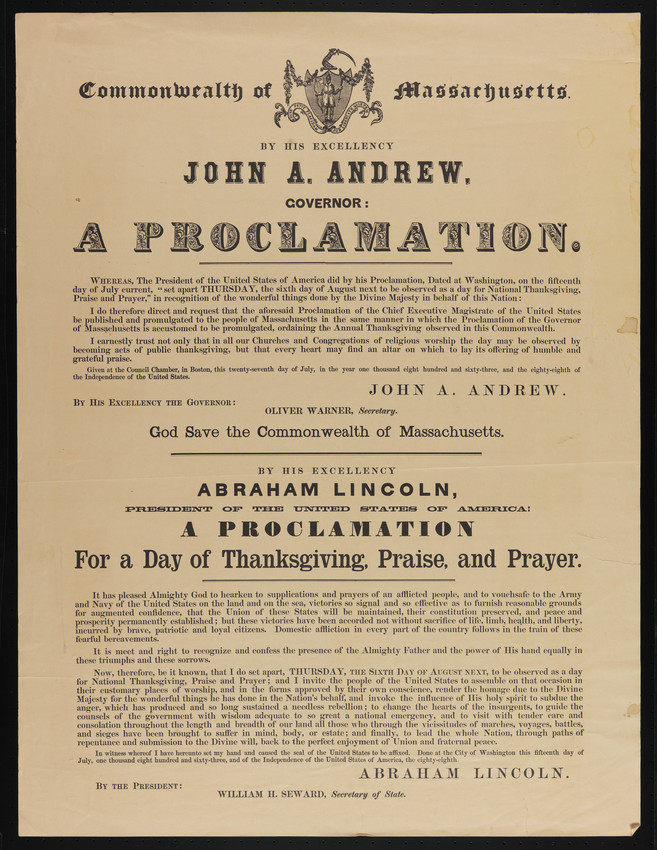
Let’s embark on a cultural journey to explore the vibrant tapestry of India. Join Elizabeth and me as we delve into the enchanting landscapes, culinary delights, traditional attire, and festive celebrations that make India truly unique.
Meet Elizabeth!
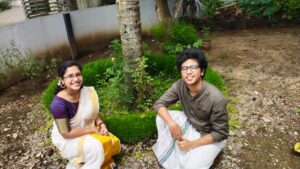
എല്ലാവർക്കും നമസ്ക്കാരം, എന്റെ പേര് എലിസബത്ത് ബേബി. ഞാൻ ഇന്ത്യയിലെ “ദൈവത്തിന്റെ സ്വന്തം നാട്” എന്ന് അറിയപ്പെടുന്ന കേരളത്തിൽ നിന്നും വരുന്നു. യൂണിവേഴ്സിറ്റി ഓഫ് നോർത്തേൺ അയോവയിൽ പോസ്റ്റ് സെക്കിന്ററി എഡ്യൂക്കേഷൻ: സ്റ്റുഡന്റ് ആഫെയിഴ്സിൽ ബിരുദാനന്തര ബിരുദം നേടുന്നു. ഉന്നത വിദ്യാഭ്യാസ മേഖലയിൽ പ്രവർത്തിക്കുന്നതും വിദ്യാർത്ഥികളെ അവരുടെ അകാഡെമിക്, പ്രൊഫഷണൽ തലങ്ങളിൽ കഴിയുന്ന വിധത്തിൽ സഹായിക്കുക എന്നതും എനിക്ക് എന്നും സന്തോഷം നൽകിയിരുന്നു കാര്യമാണ്. എനിക്ക് ഒരുപാട് ഇഷ്ടമുള്ള ഈ മേഖലയെക്കുറിച്ച് പഠിക്കാനും അതിൽ പ്രവർത്തിക്കാനും സാധിച്ചത് വളരെ ഭാഗ്യമായി ഞാൻ കരുതുന്നു.
Hello everyone. My name is Elizabeth Baby and I come from the state of Kerala, India which is also known as “God’s own country”. I am a graduate student pursuing my Masters in Post Secondary Education: Student Affairs. I have always loved working in higher education, helping students navigate their academic and professional life and I consider myself fortunate to be at UNI learning and doing what I love the most.
Elizabeth Mavarayil – Graduate Student
More about Elizabeth…
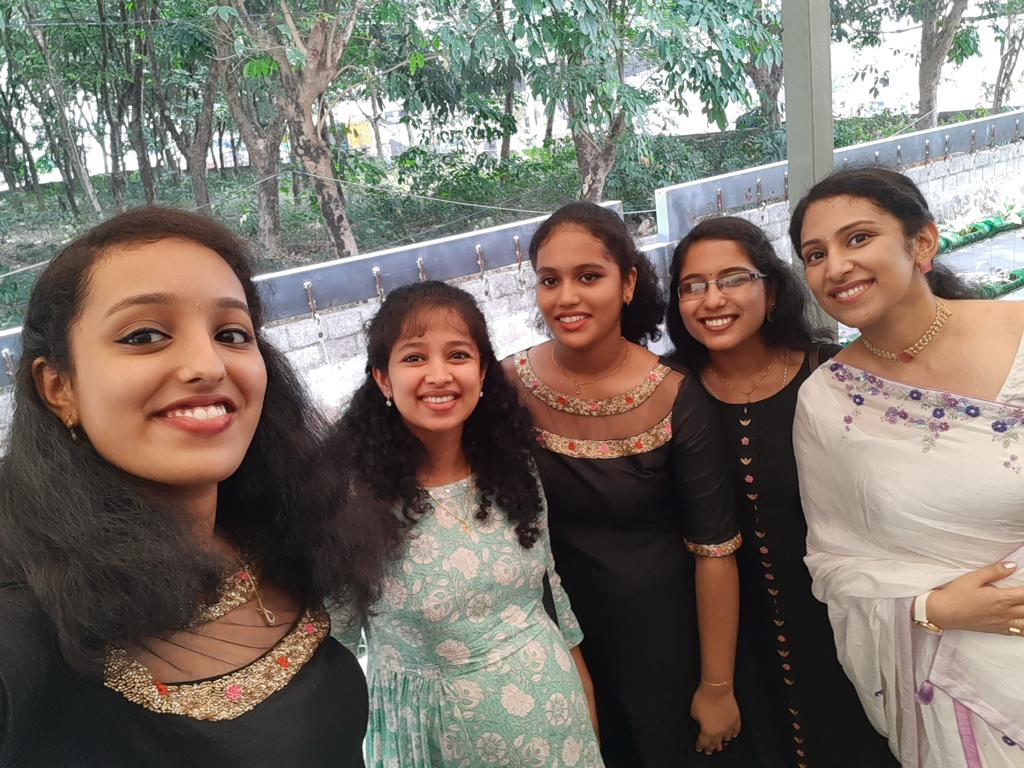
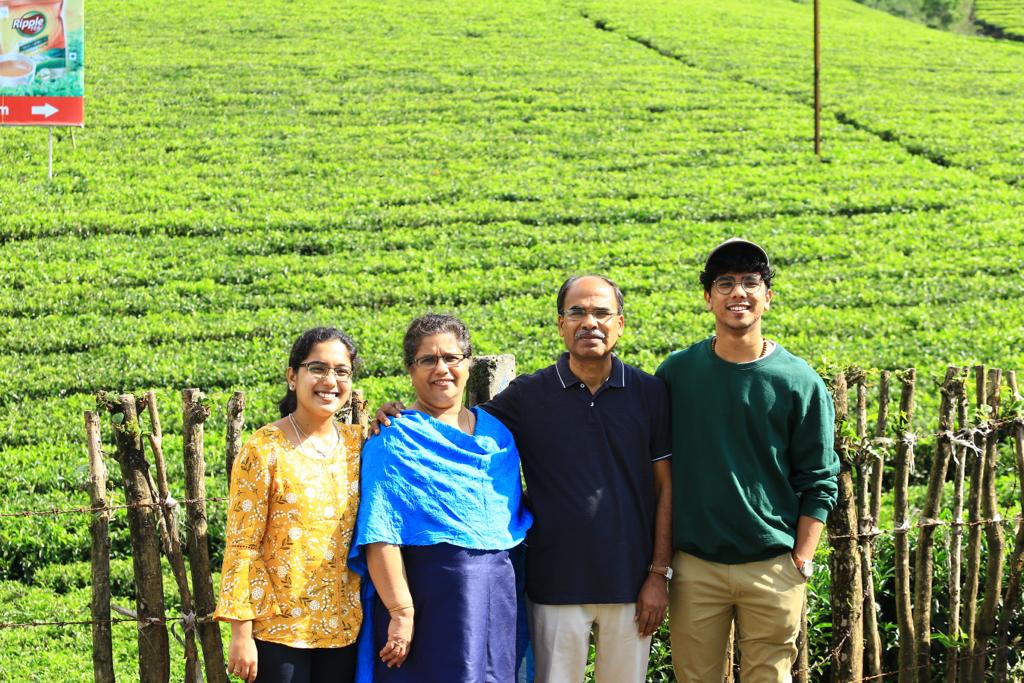
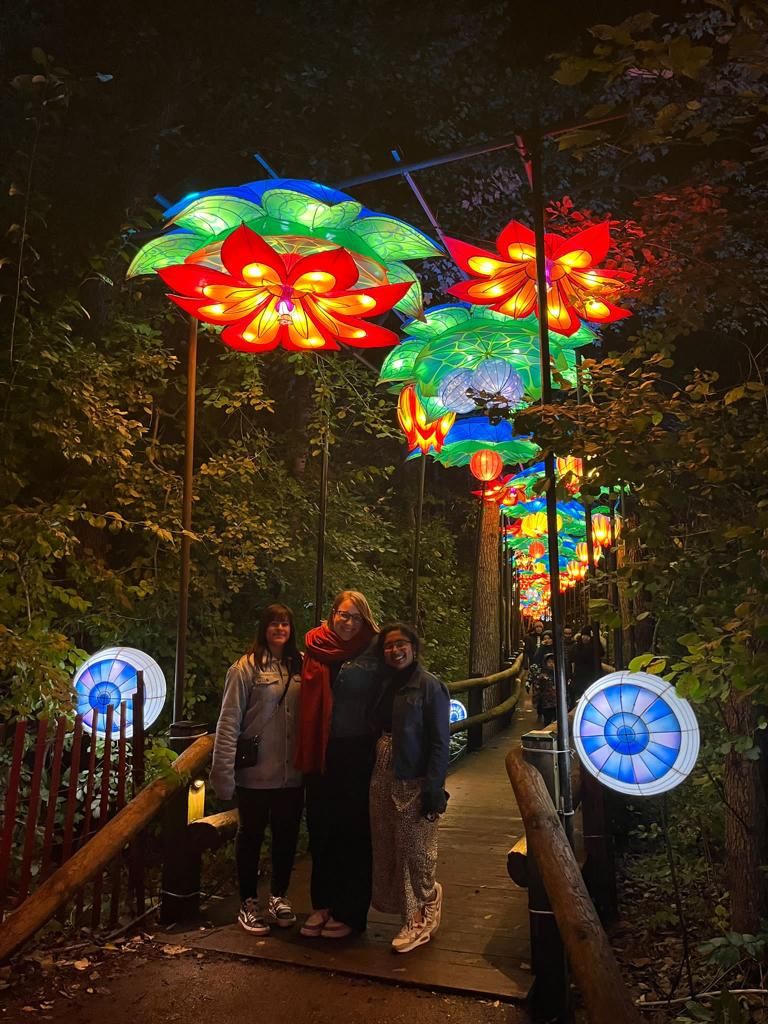
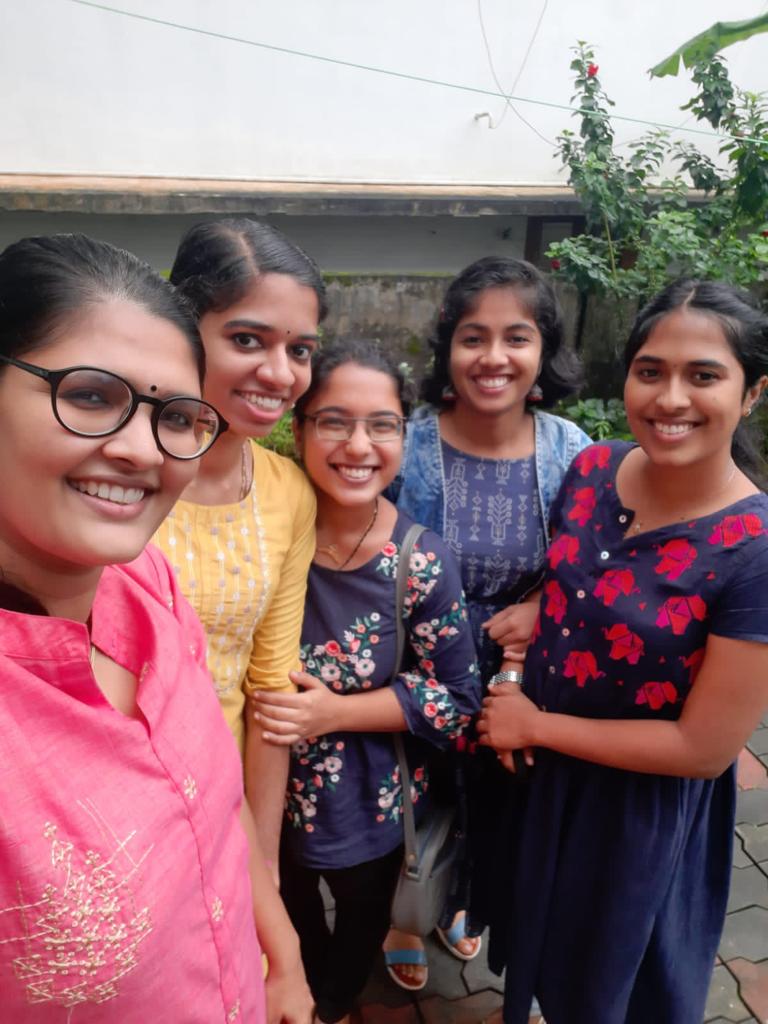

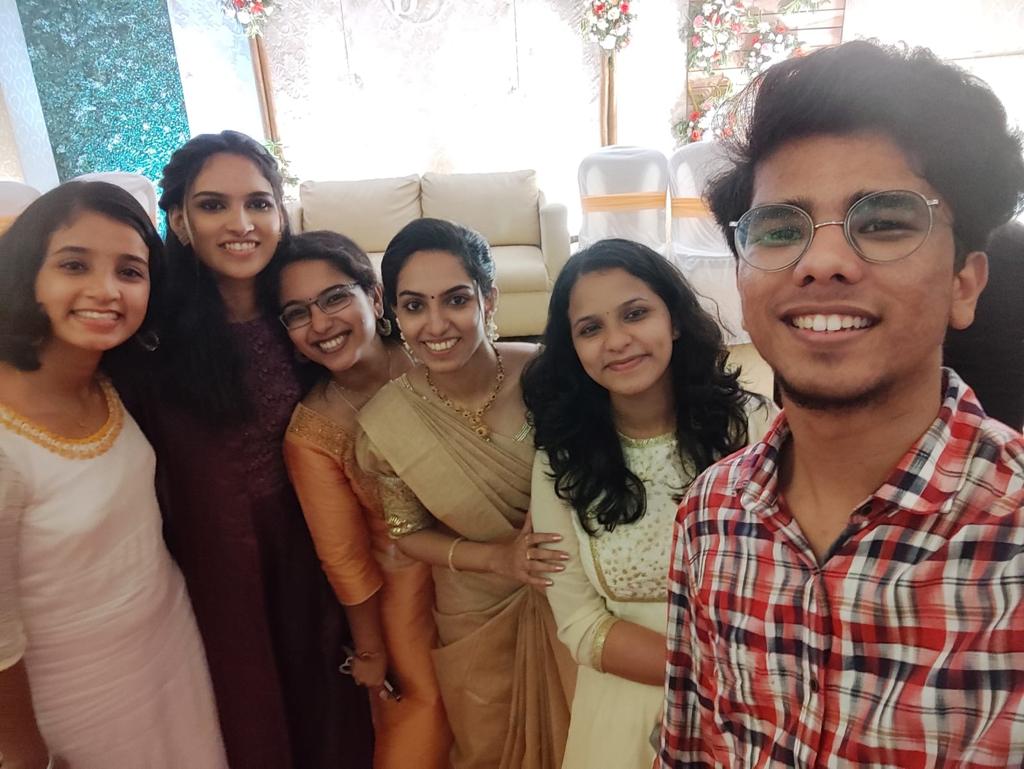
Where is India located?
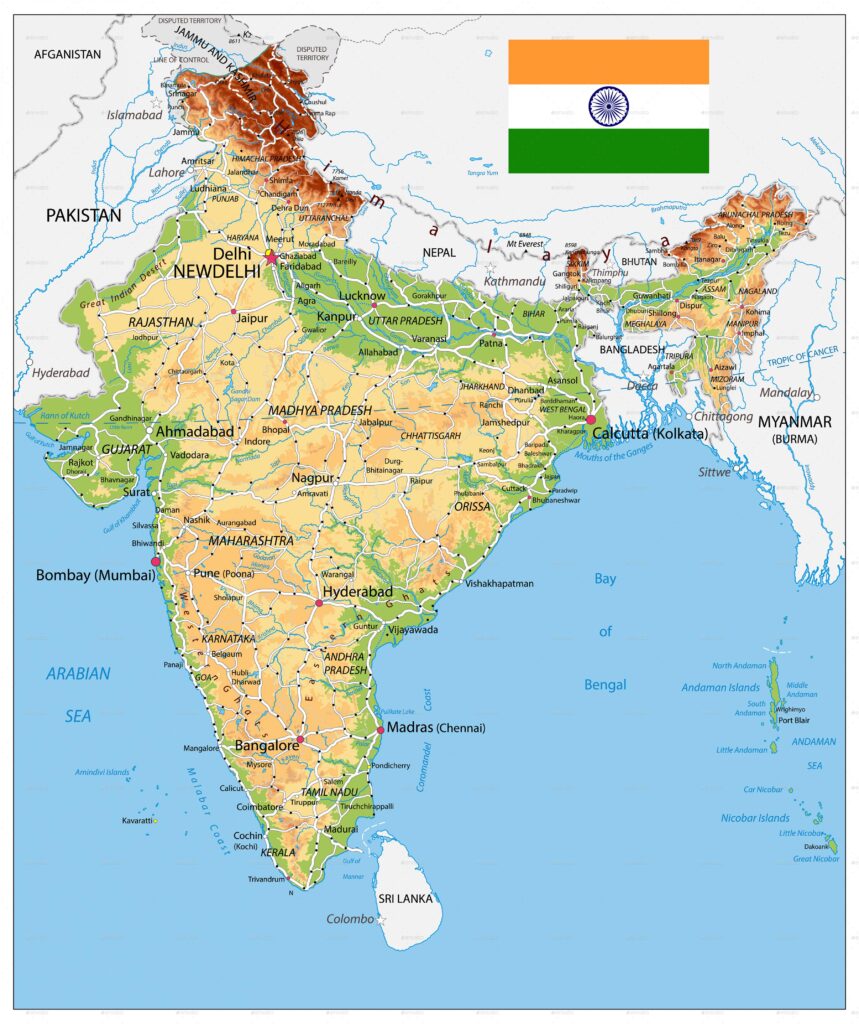
In South Asia, India borders Pakistan to the northwest, China and Nepal to the north, Bhutan to the northeast, and Bangladesh and Myanmar to the east. The Indian Ocean bounds it to the south. India is the seventh-largest country in the world by land area and the second-most populous country, after China. The capital city of India is New Delhi.
Places to visit in India
India is a diverse and culturally rich country with a wide range of places to visit. Here are some popular destinations that showcase the country’s vibrant culture, history, and natural beauty:
- Taj Mahal, Agra, Uttar Pradesh: One of the Seven Wonders of the World, the Taj Mahal is a breathtaking marble mausoleum built by Emperor Shah Jahan in memory of his wife Mumtaz Mahal.
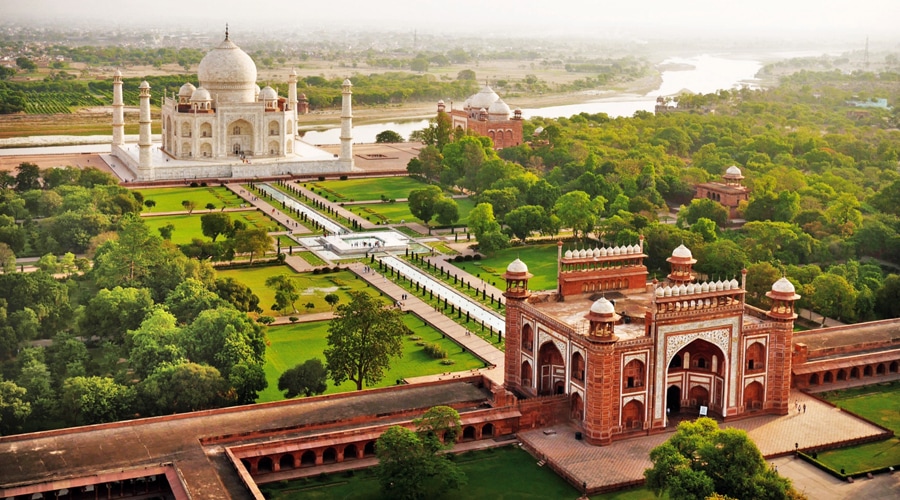
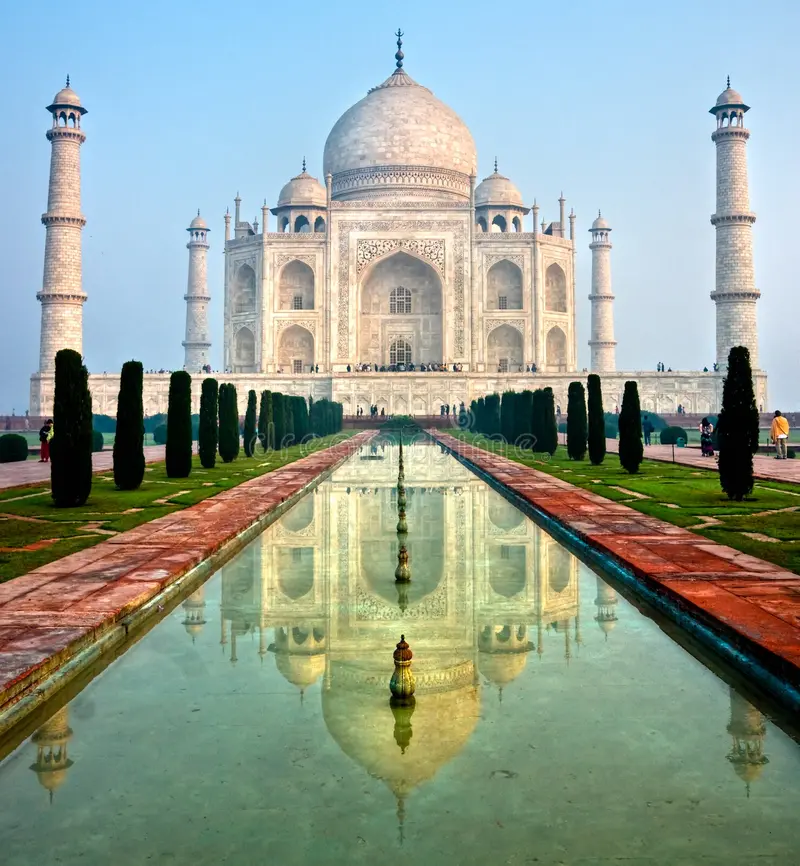
- Jaipur, Rajasthan: Known as the “Pink City,” Jaipur is famous for its historic forts, palaces, and vibrant markets. Hawa Mahal, City Palace, and Amer Fort are must-visit attractions.
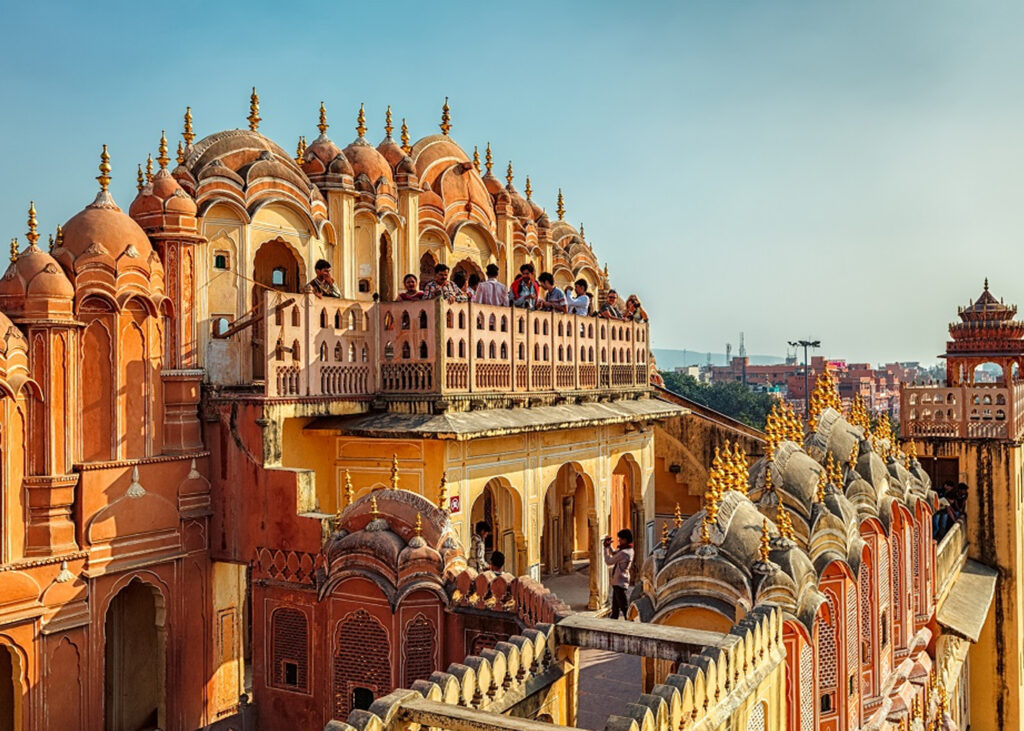
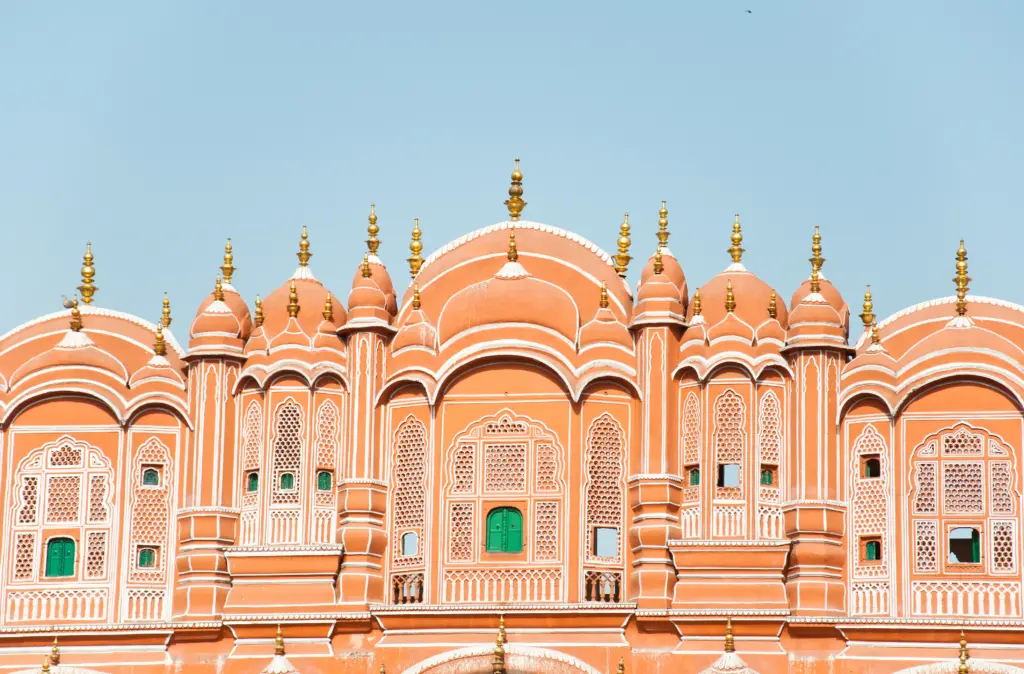
- Varanasi, Uttar Pradesh: One of the oldest continually inhabited cities in the world, Varanasi is a spiritual and cultural hub situated on the banks of the Ganges River. The ghats, temples, and narrow winding streets are iconic.

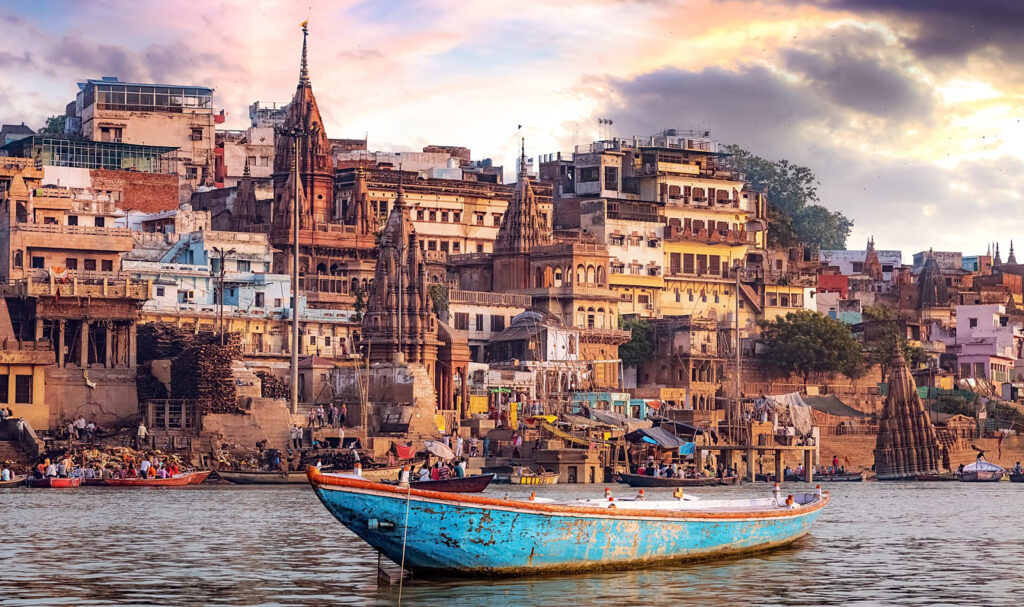
- Rishikesh and Haridwar, Uttarakhand: These twin towns on the Ganges River are known for their spiritual significance, yoga retreats, and the Ganga Aarti ceremony. Furthermore, Rishikesh serves as a gateway to the Himalayas.
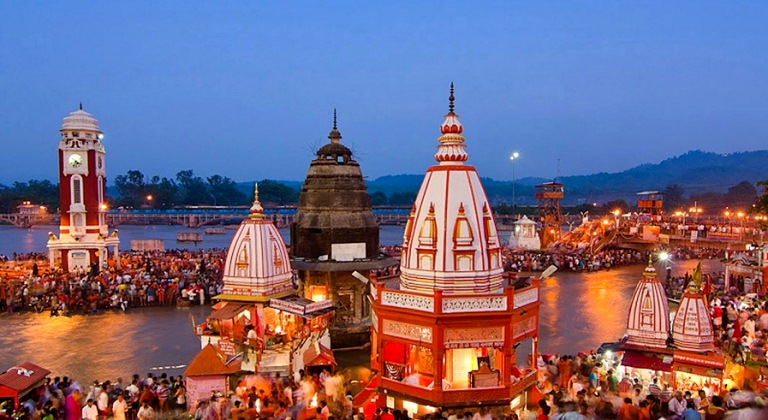
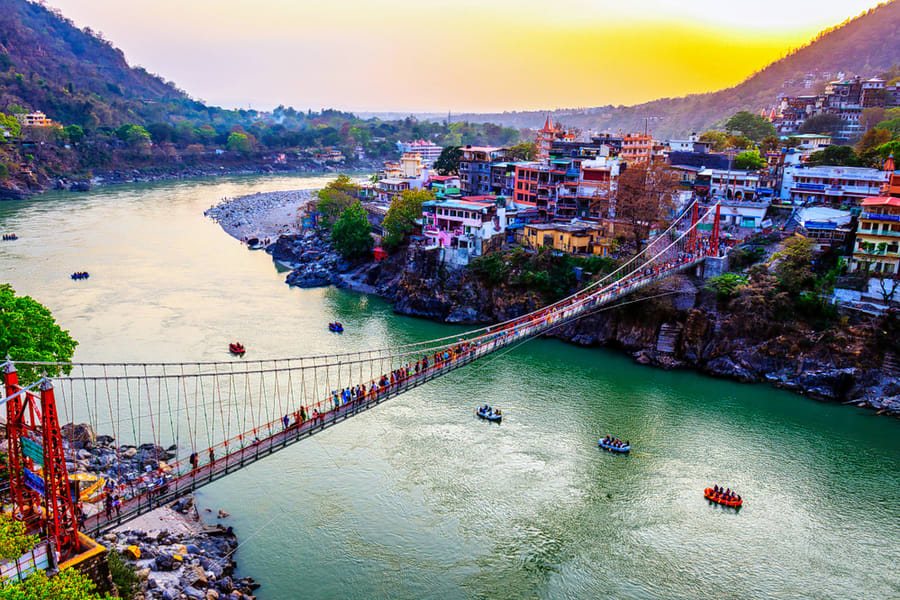
- Delhi: The capital city has a rich history with landmarks like India Gate, Qutub Minar, and Humayun’s Tomb. Moreover, Old Delhi’s chaotic markets and the Mughal-era Red Fort are also major attractions.

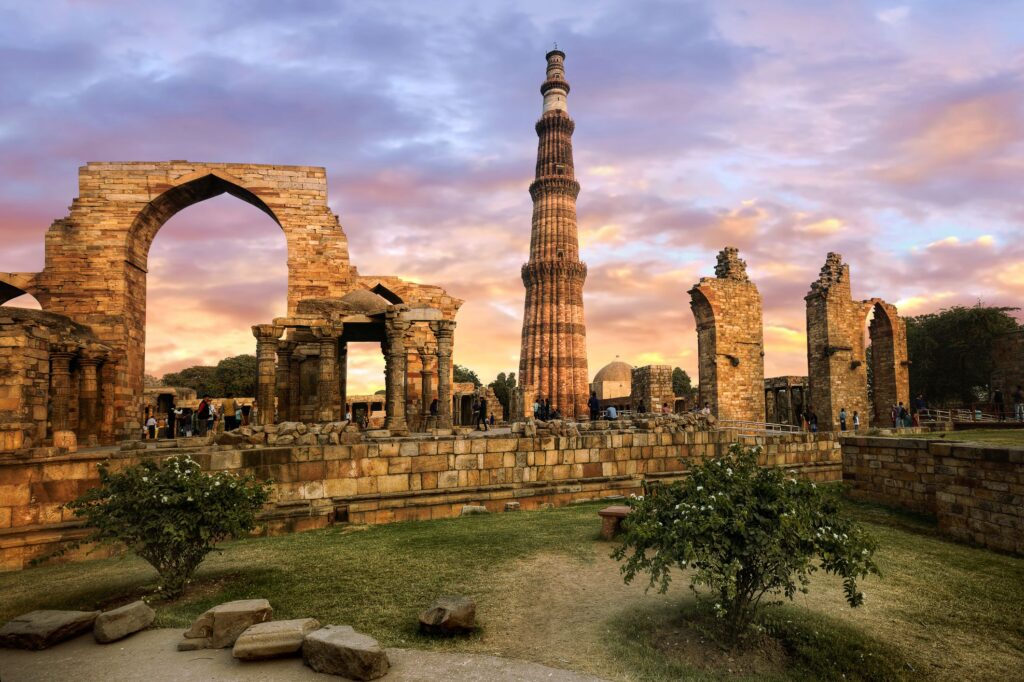
- Leh-Ladakh, Jammu and Kashmir: Known for its stunning landscapes, monasteries, and high-altitude deserts, Leh-Ladakh is a haven for adventure enthusiasts and nature lovers.
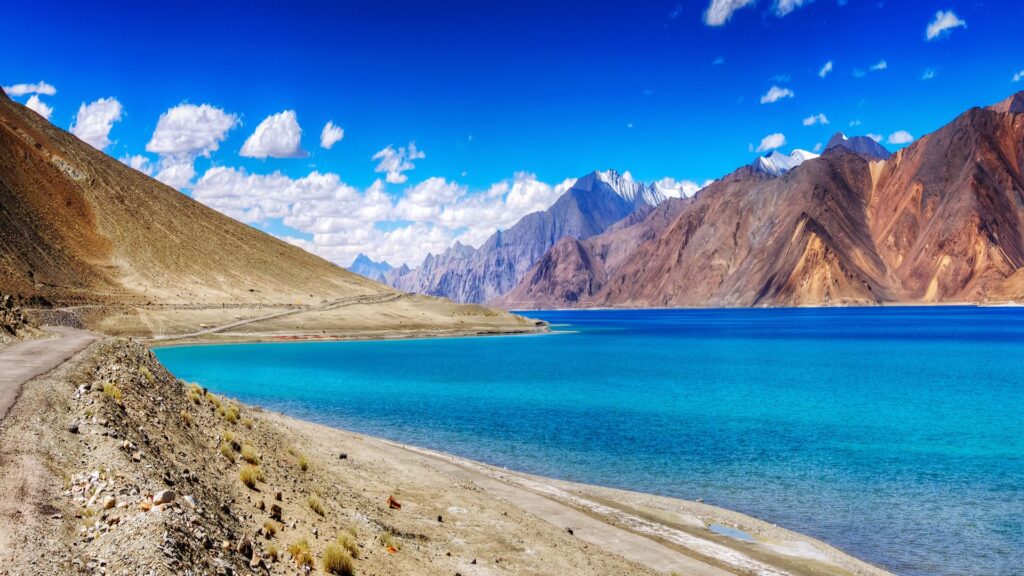
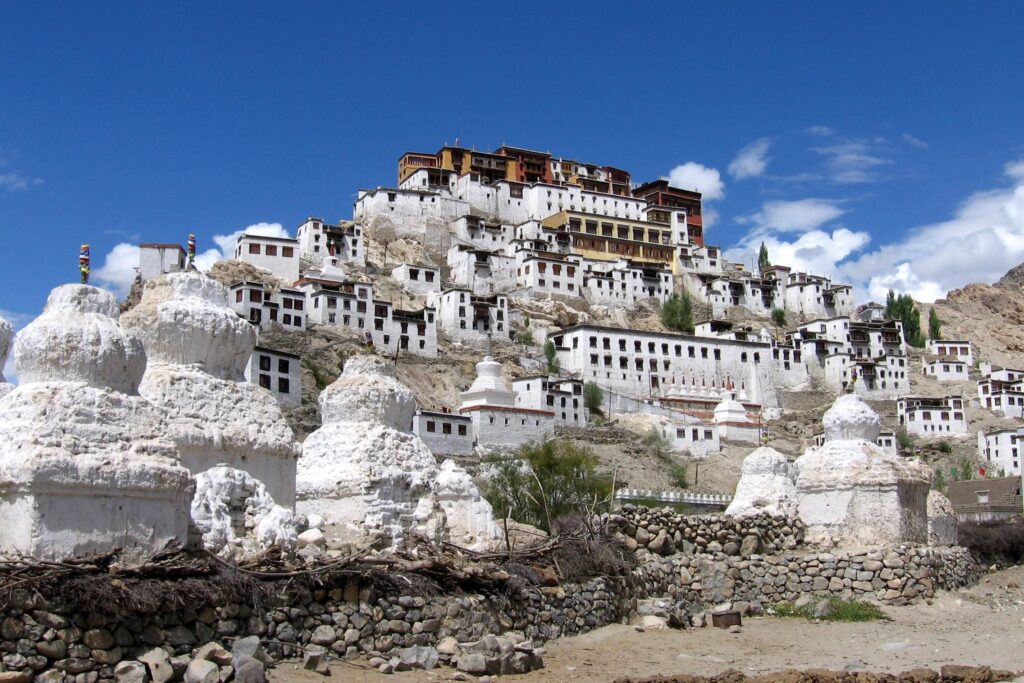
- Khajuraho, Madhya Pradesh: Famous for its intricately carved temples, Khajuraho is a UNESCO World Heritage Site and offers a glimpse into India’s medieval art and architecture.

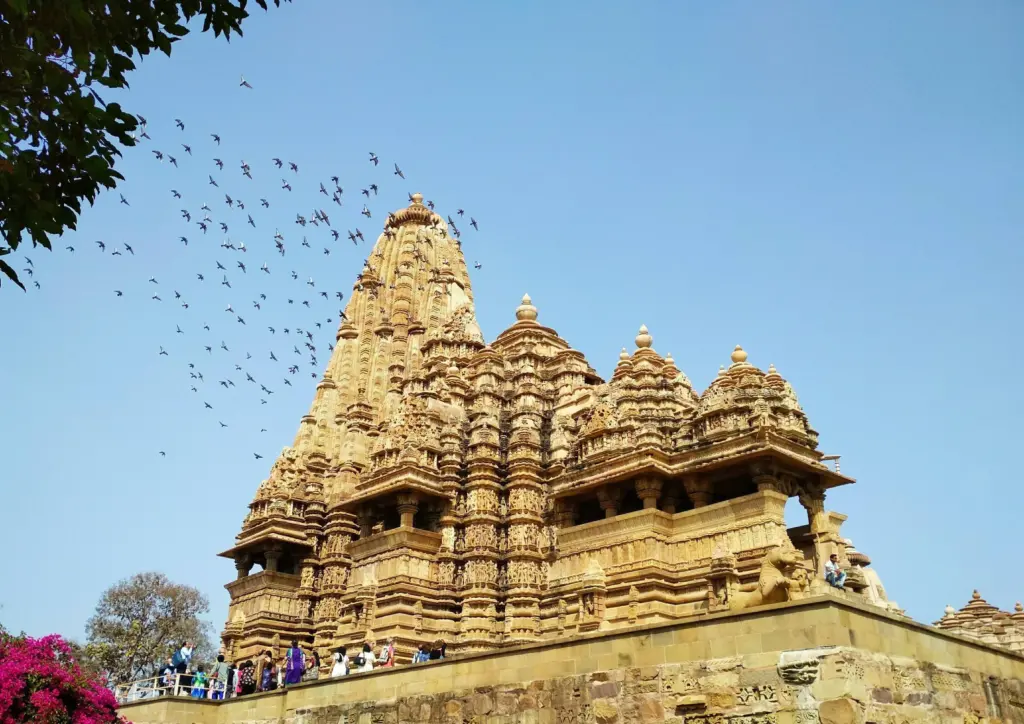
- Ajanta and Ellora Caves, Maharashtra: These UNESCO World Heritage Sites house ancient rock-cut caves with exquisite sculptures and paintings, showcasing the rich cultural heritage of India.
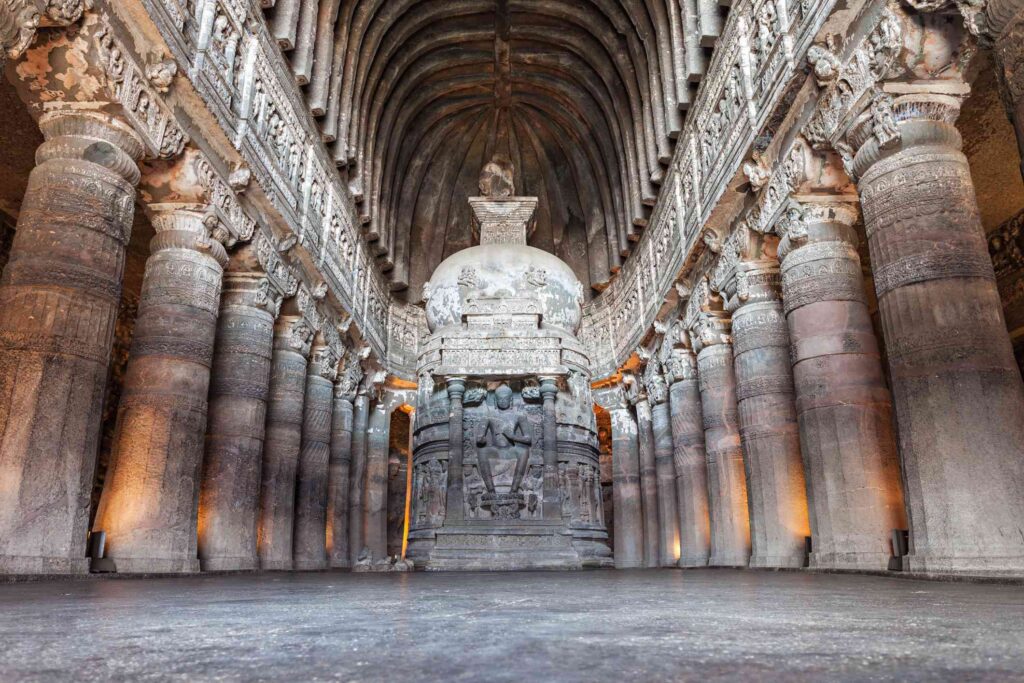
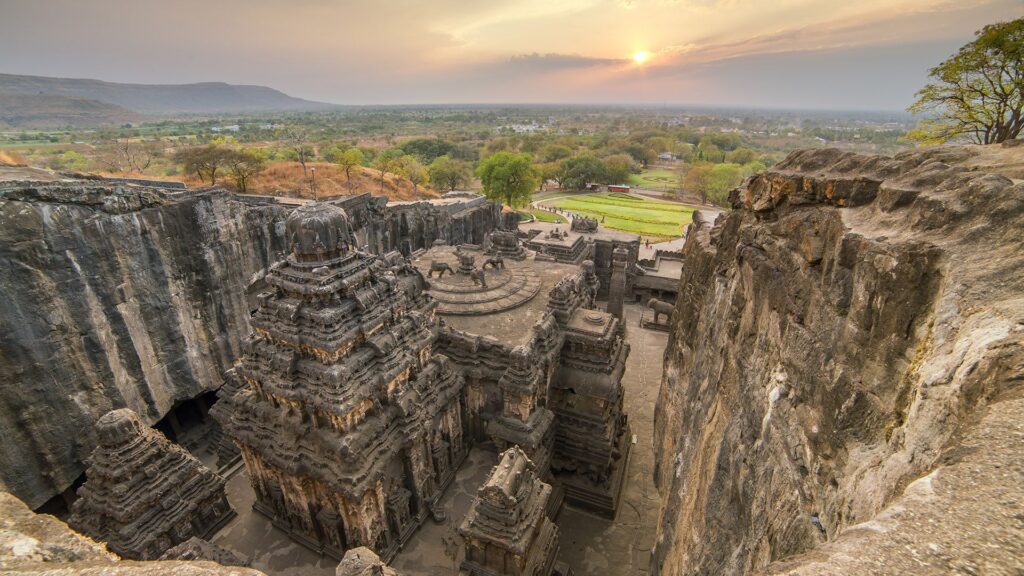
- Rajasthan’s Forts and Palaces: Apart from Jaipur, cities like Jodhpur, Udaipur, and Jaisalmer are known for their majestic forts, palaces, and vibrant culture.
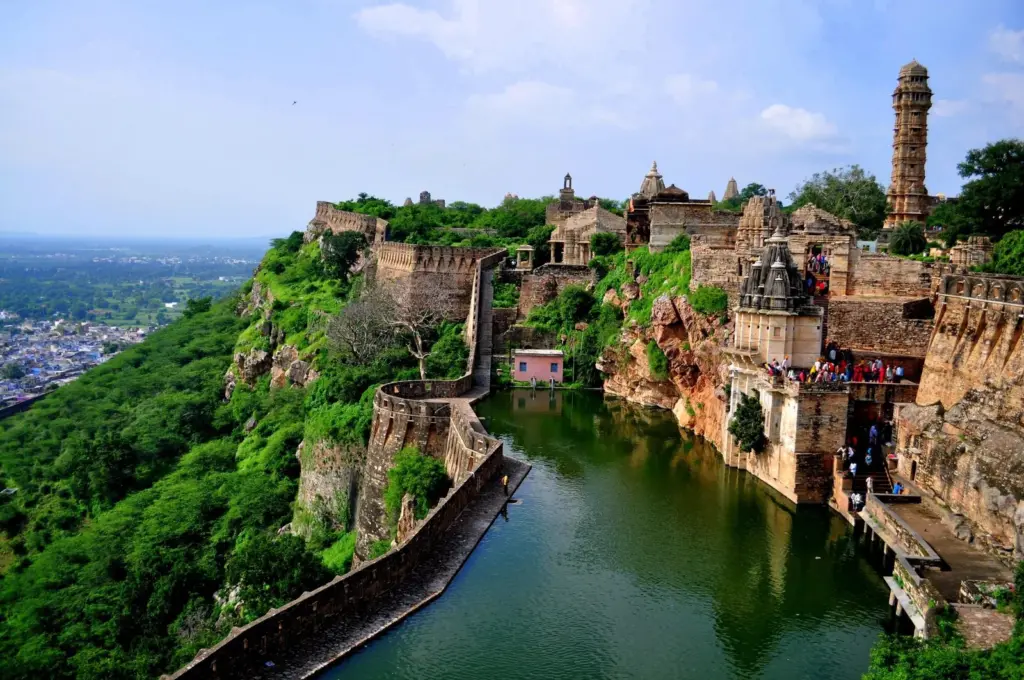
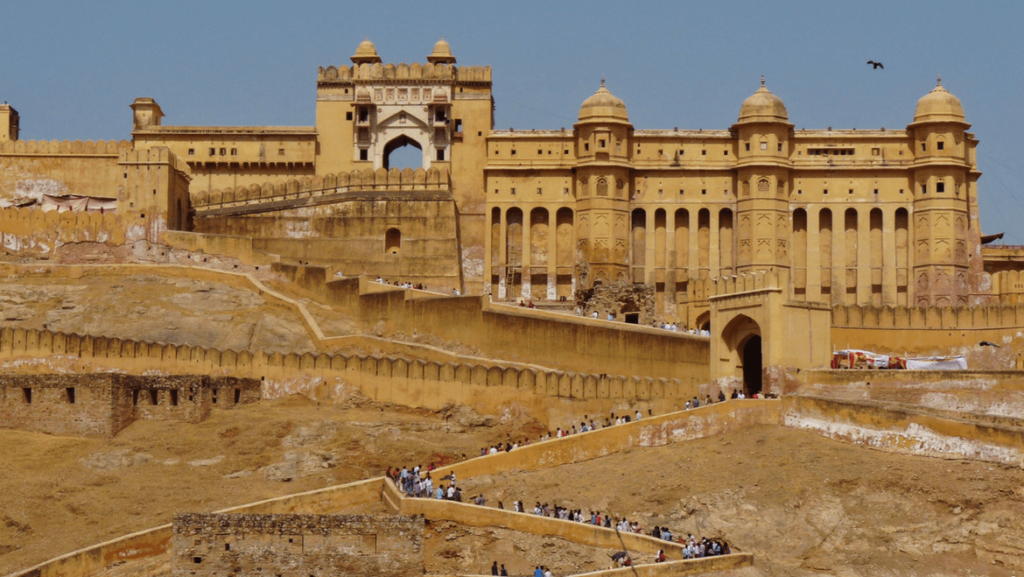
India’s traditional food
Indian cuisine is incredibly diverse, reflecting the country’s rich cultural and regional variations. Here are some traditional Indian dishes that are popular across the country:
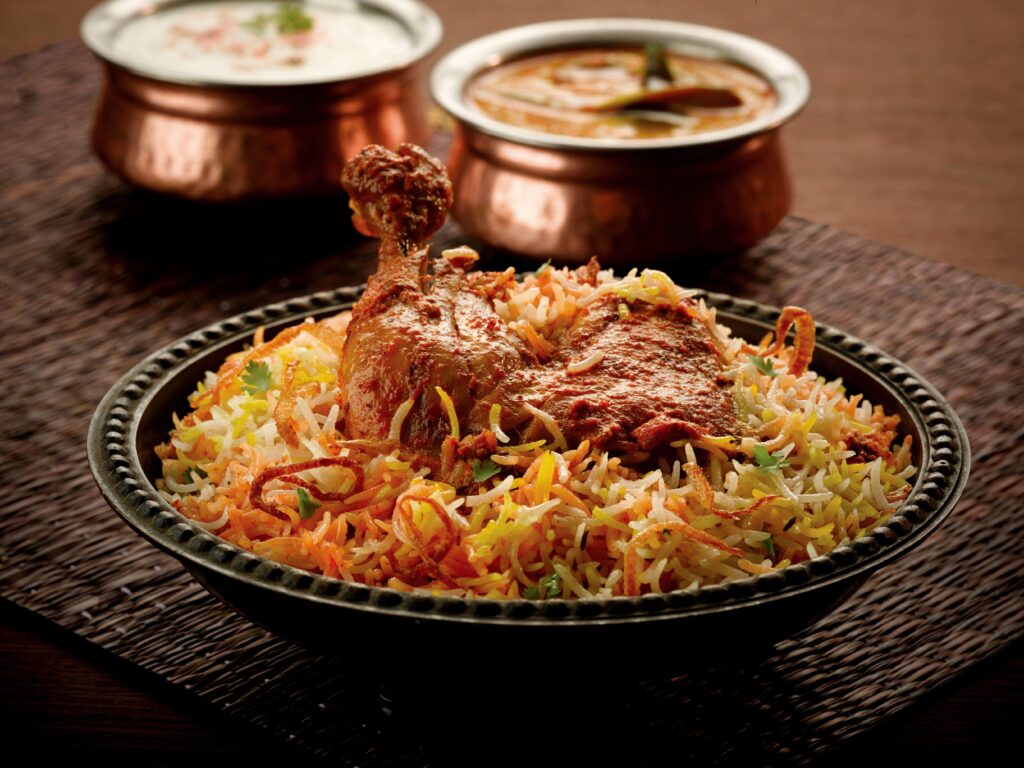
Biryani: A fragrant and flavorful rice dish cooked with aromatic spices, basmati rice, and meat (often chicken, mutton, or fish) or vegetables. Each region has its own variation of biryani.

Chole Bhature: A popular North Indian dish, chole bhature consists of spicy chickpeas (chole) served with deep-fried bread (bhature).
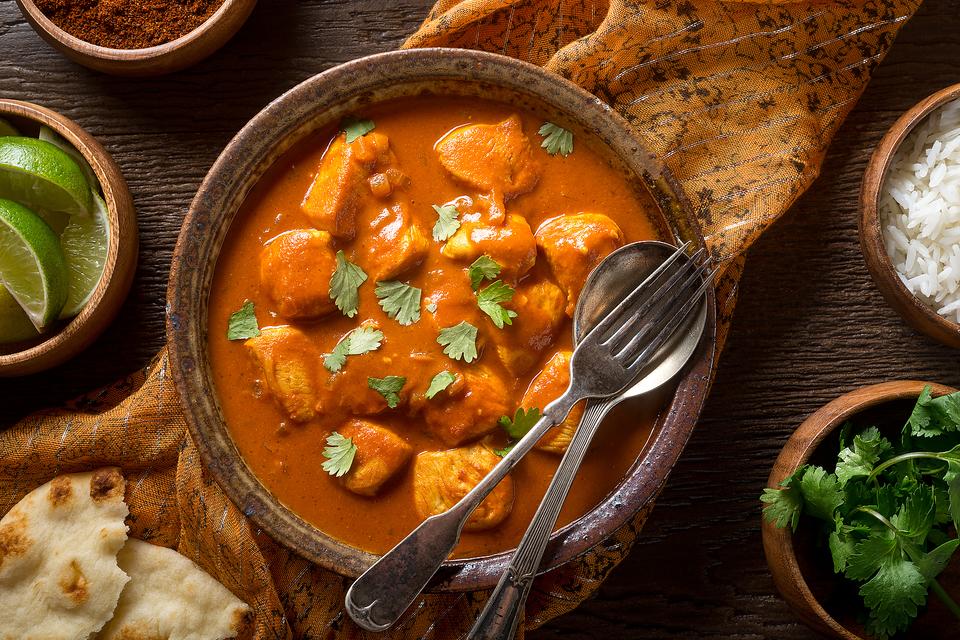
Butter Chicken (Murgh Makhani): A creamy and mildly spiced curry made with tender pieces of chicken, butter chicken is a favorite in many parts of India.
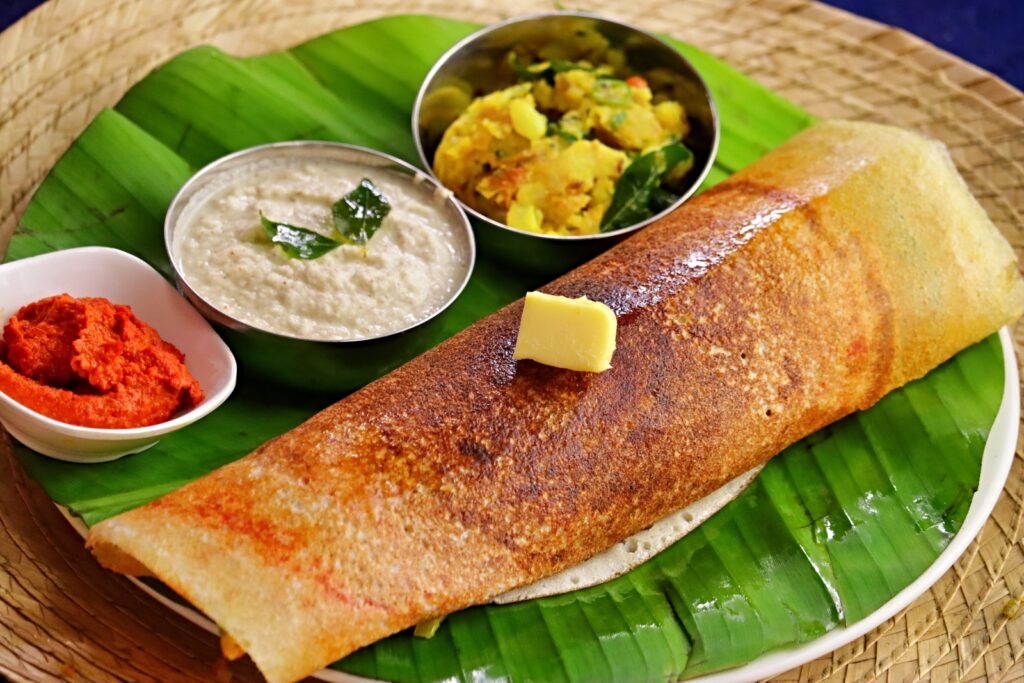
Masala Dosa: A South Indian specialty, masala dosa is a thin, crispy rice crepe filled with a spiced potato mixture. One commonly serves it with coconut chutney and sambar (a lentil-based vegetable stew).
Traditional Costumes in India
Owing to its rich cultural diversity, India boasts a wide variety of traditional costumes across different regions. Here are some traditional costumes from various parts of India:
- Sari (Saree): The sari is a traditional attire for women in India. A long piece of fabric, typically around 6 to 9 yards, is elegantly draped around the body. The style of draping varies across regions.
- Salwar Kameez: It consists of loose-fitting trousers (salwar), a tunic-style top (kameez), and a matching scarf or shawl (dupatta).
- Lehenga Choli, frequently worn during weddings and festivals, comprises a long, flared skirt (lehenga), a fitted blouse (choli), and a matching dupatta. Moreover, this traditional ensemble is a symbol of elegance and festivity in Indian culture.

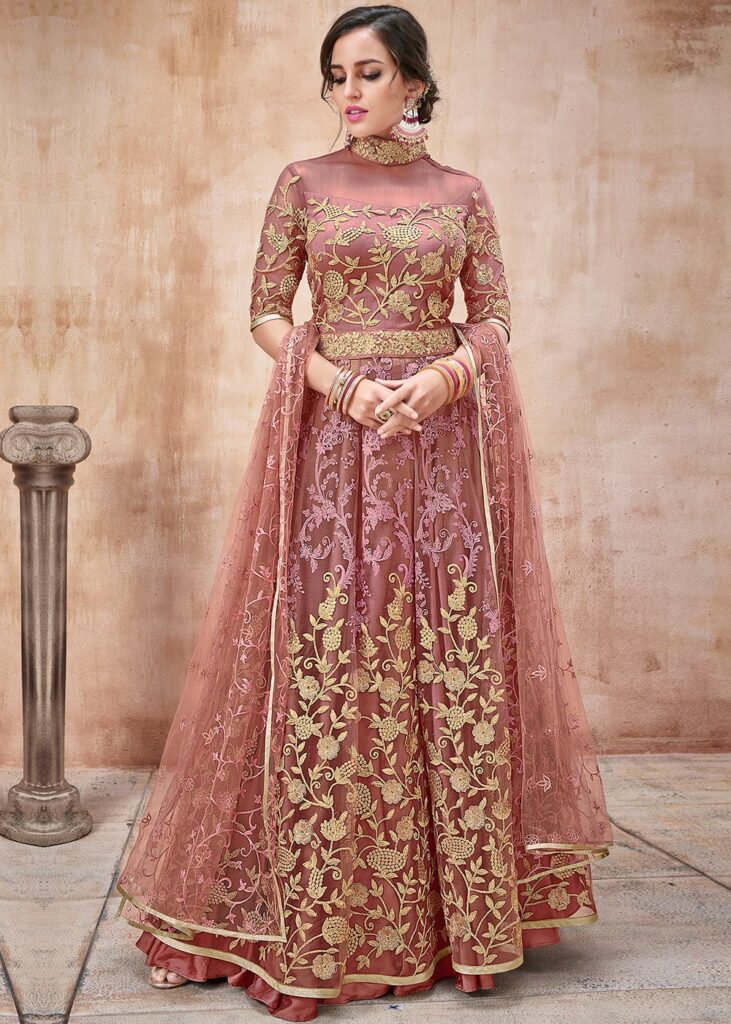

Sari (Saree)Salwar KameezLehenga Choli
- Men often wear a Bandhgala, a formal jacket with a high neck, paired with a kurta or shirt and trousers.
- Dhoti: The dhoti is a traditional garment for men, especially in South India. One wraps a piece of cloth around the waist and legs.
- Kurta Pajama: A common traditional outfit for men, the kurta is a loose-fitting shirt, and the pajama is a type of trousers. A dupatta or shawl is frequently paired with it.



Festivals in India
Its vibrant and diverse festivals, celebrated with enthusiasm and grandeur, contribute to India’s renown.Here are some of the major festivals in India:
Diwali, known as the Festival of Lights, ranks among the most widely celebrated festivals in India. It marks the victory of light over darkness and good over evil. People light lamps, burst fireworks, and exchange sweets and gifts.
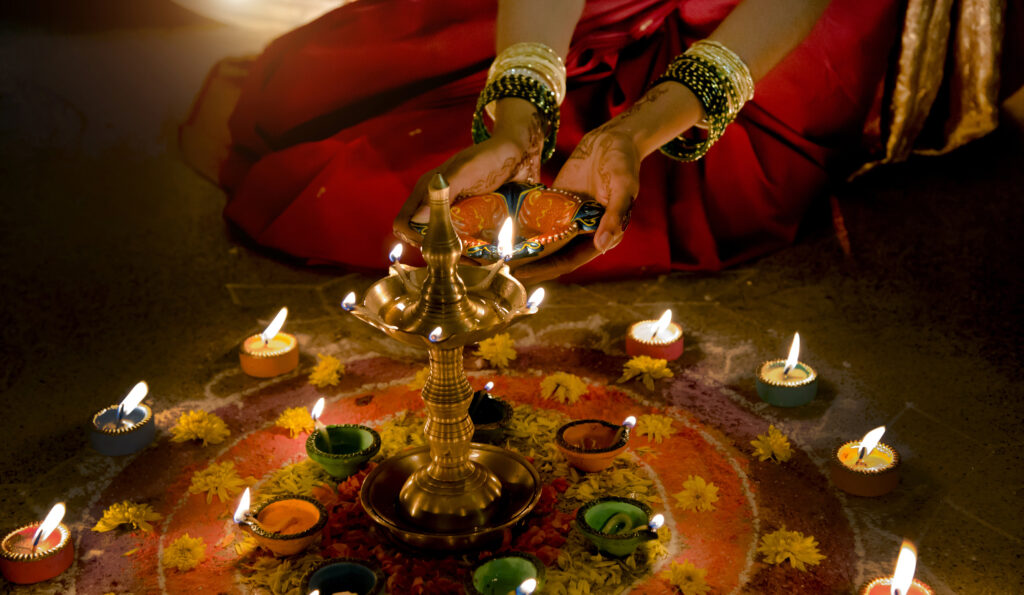

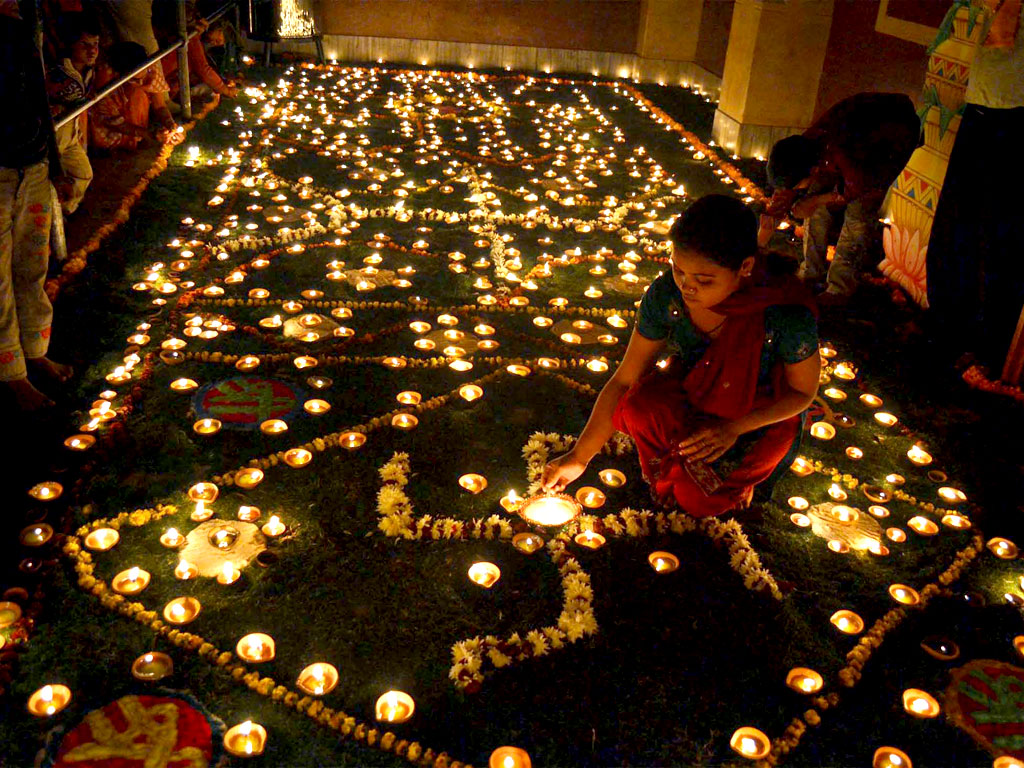
Holi: Often referred to as the Festival of Colors, Holi marks the arrival of spring. People celebrate by throwing colored powders and water at each other, singing and dancing. It’s a joyful and lively celebration.



Eid al-Fitr: Celebrated by Muslims across India, Eid al-Fitr marks the end of Ramadan, the holy month of fasting. It is a time for prayers, feasts, and giving to charity.
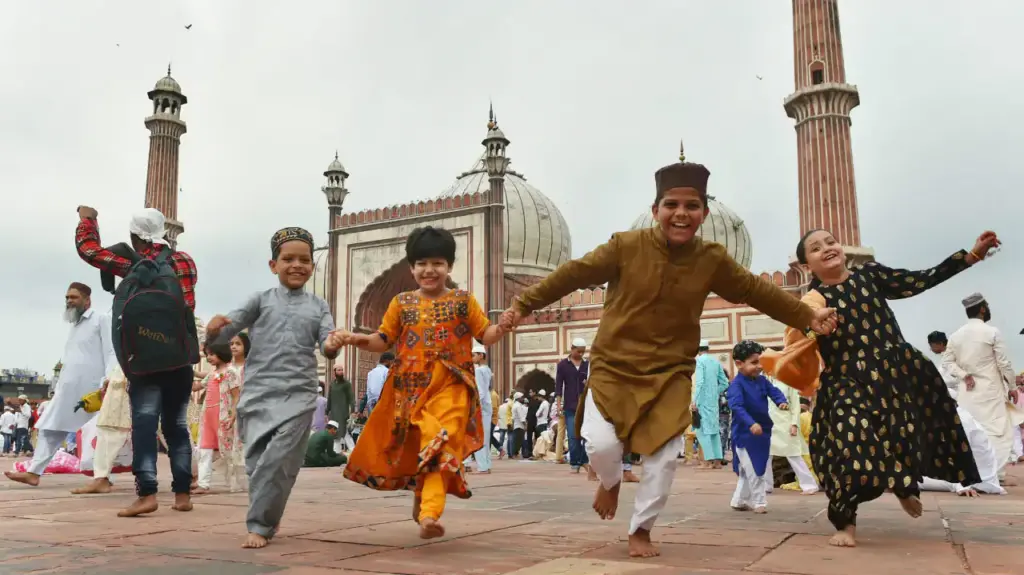
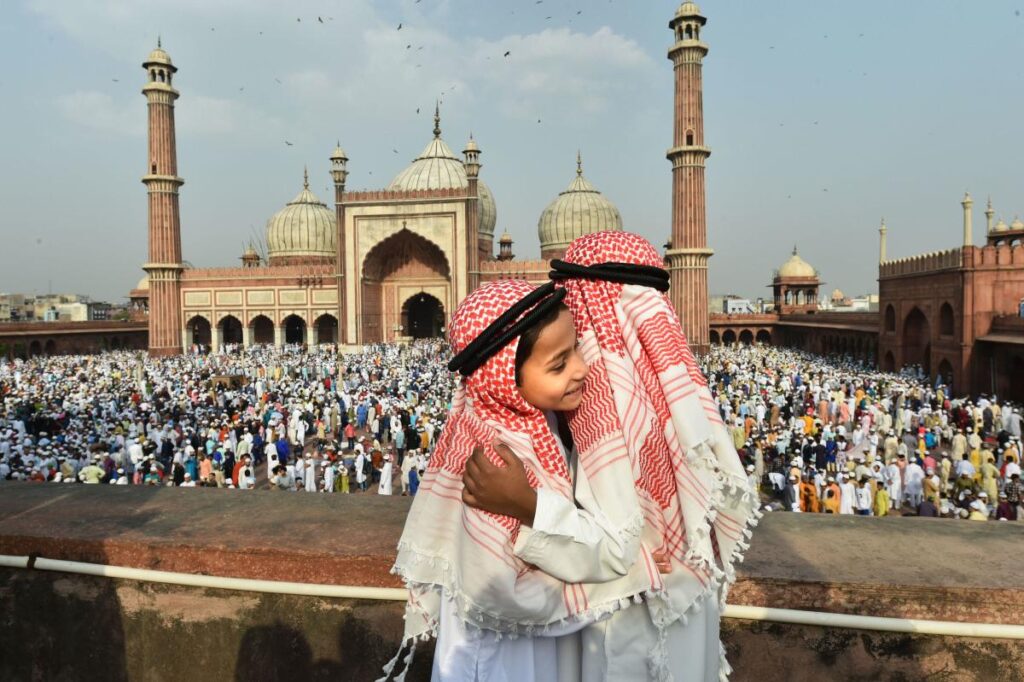
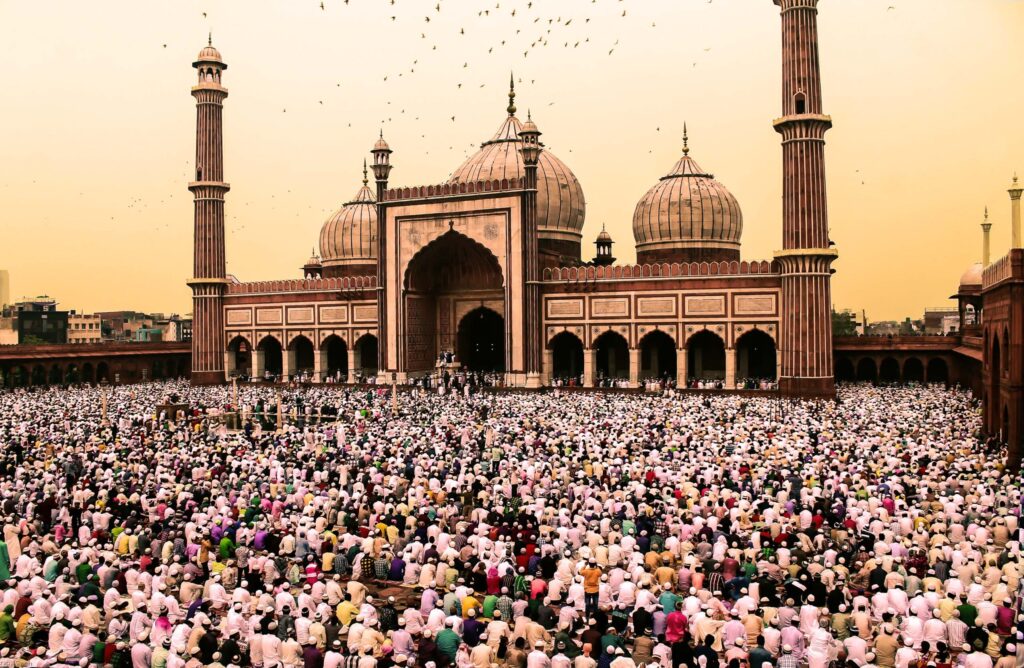
Navratri, a nine-night festival, dedicates itself to the worship of the goddess Durga.In some regions, especially West Bengal, it culminates in Durga Puja, a festival that celebrates the victory of goddess Durga over the demon Mahishasura.
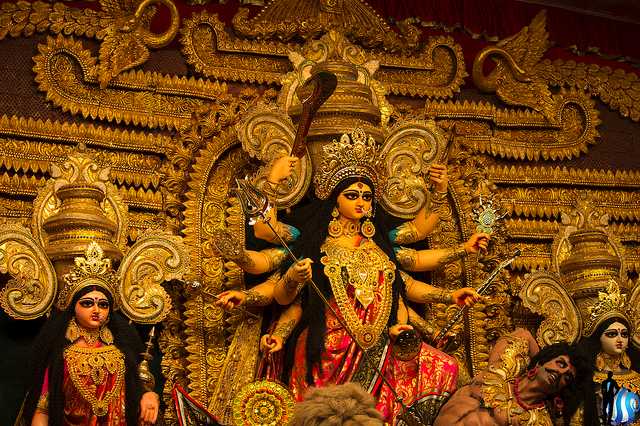
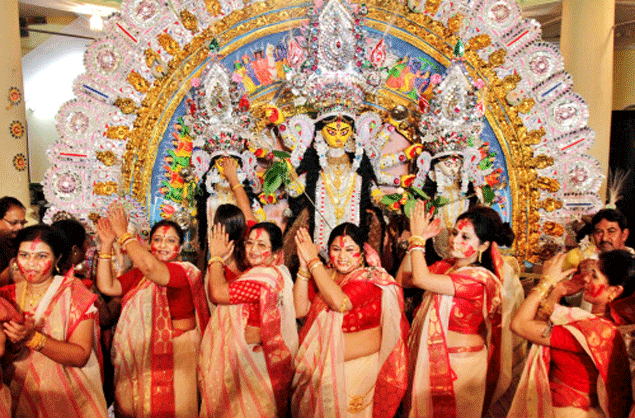
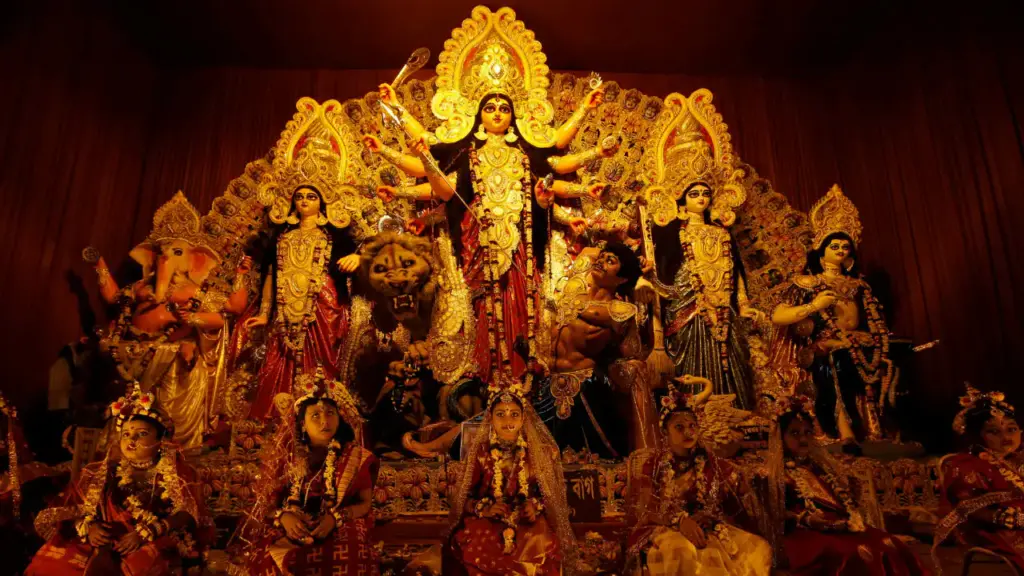
Lohri: Celebrated primarily in Punjab, Lohri marks the winter solstice. People light bonfires, singing and dancing around them, celebrating the warmth of the season.

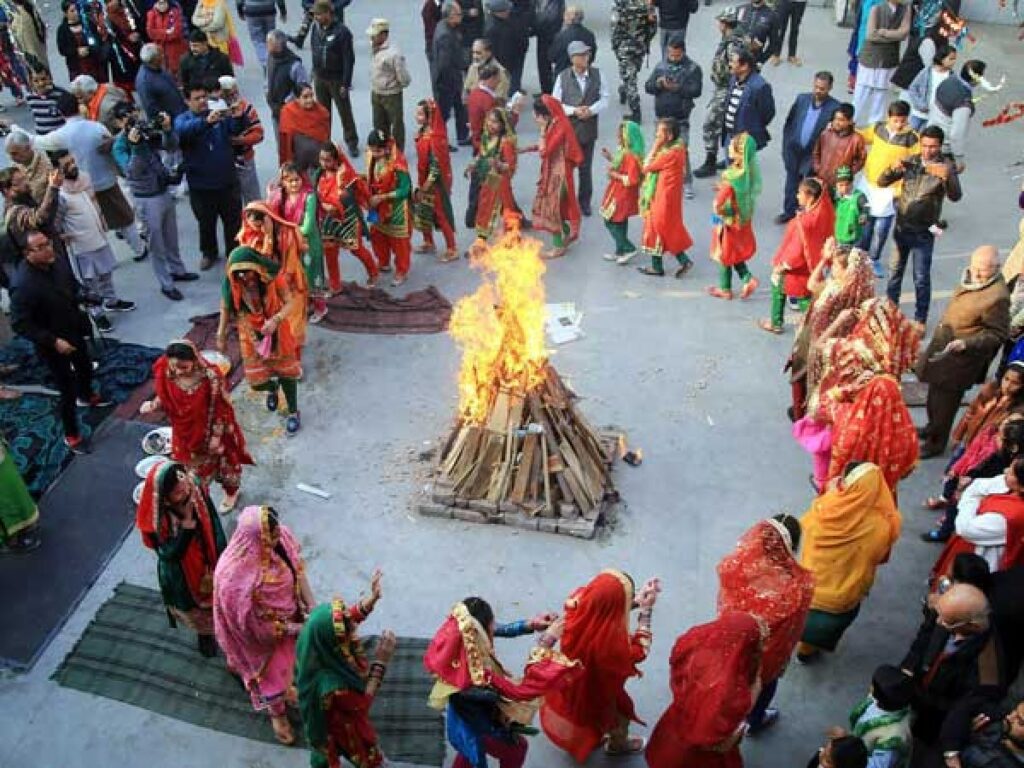
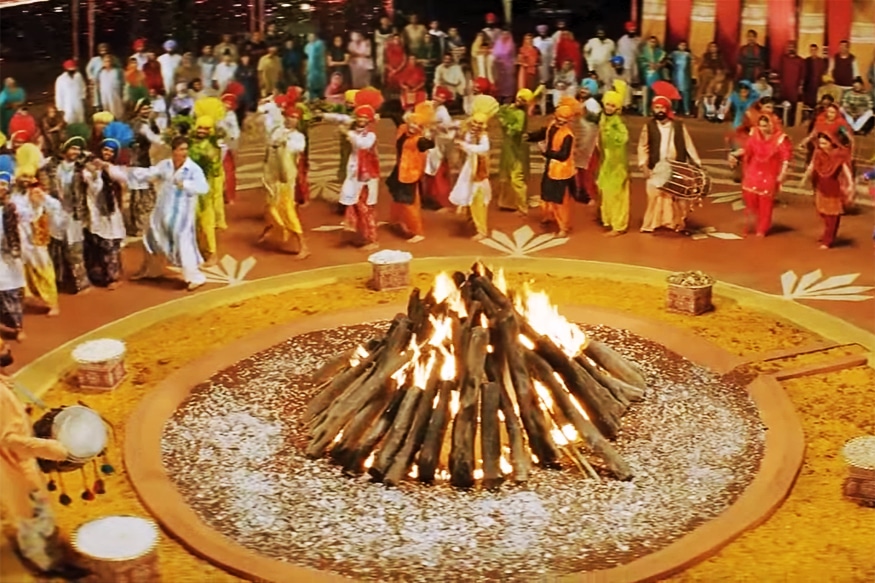
Facts
- Varied Geography: India is geographically diverse, with the Himalayan mountain range in the north, the Thar Desert in the west, and the Sundarbans Delta in the east. It also has a vast coastline along the Arabian Sea and the Bay of Bengal.
- Second Most Populous Country: India is the second-most populous country in the world, with over 1.3 billion people.
- World’s Largest Democracy: India is the world’s largest democracy, with a parliamentary system of government. The President of India is the head of state, and the Prime Minister is the head of government.
- Incredible Cuisine: Indian cuisine earns recognition for crafting diverse and flavorful dishes. Each region has its own specialties, and the use of spices is a hallmark of Indian cooking. Popular dishes include biryani, curry, dosa, and samosa.
- Bollywood: India is home to Bollywood, the largest film industry in the world in terms of the number of films produced.Bollywood movies feature colorful musical numbers and dramatic storytelling, earning them renown.
- Cultural Diversity: Incredibly diverse culturally, India is home to over 2,000 distinct ethnic groups and more than 1,600 spoken languages. The official languages include Hindi and English, with 21 languages officially recognized.
- Taj Mahal: One of the Seven Wonders of the World, the Taj Mahal in Agra is a stunning white marble mausoleum built by Emperor Shah Jahan in memory of his wife Mumtaz Mahal.
- Ayurveda: India is the birthplace of Ayurveda, one of the world’s oldest holistic healing systems. Ayurveda emphasizes a balance between the mind, body, and spirit, contributing to overall well-being.
- Zero and Decimal System: The concept of zero as a number and the decimal system originated in India. Indian mathematician Aryabhata introduced the concept of zero in the 5th century.
- Unity in Diversity: India’s national emblem, an adaptation of the Lion Capital of Ashoka, features four lions standing back to back. This symbolizes power, courage, and confidence, and it reflects the idea of unity in diversity.
- Wildlife Diversity: India is home to a diverse range of wildlife, including Bengal tigers, Asian elephants, Indian rhinoceroses, and various species of deer and monkeys. Several organizations actively conserve these species in dedicated national parks and wildlife sanctuaries.
- Kumbh Mela: The Kumbh Mela is a major Hindu festival and the world’s largest gathering of people. It occurs every 12 years, attracting millions of pilgrims who come to bathe in the sacred rivers.

Let’s embark on a cultural journey to explore the vibrant tapestry of India. Join Elizabeth and me as we delve into the enchanting landscapes, culinary delights, traditional attire, and festive celebrations that make India truly unique.
Meet Elizabeth!

എല്ലാവർക്കും നമസ്ക്കാരം, എന്റെ പേര് എലിസബത്ത് ബേബി. ഞാൻ ഇന്ത്യയിലെ “ദൈവത്തിന്റെ സ്വന്തം നാട്” എന്ന് അറിയപ്പെടുന്ന കേരളത്തിൽ നിന്നും വരുന്നു. യൂണിവേഴ്സിറ്റി ഓഫ് നോർത്തേൺ അയോവയിൽ പോസ്റ്റ് സെക്കിന്ററി എഡ്യൂക്കേഷൻ: സ്റ്റുഡന്റ് ആഫെയിഴ്സിൽ ബിരുദാനന്തര ബിരുദം നേടുന്നു. ഉന്നത വിദ്യാഭ്യാസ മേഖലയിൽ പ്രവർത്തിക്കുന്നതും വിദ്യാർത്ഥികളെ അവരുടെ അകാഡെമിക്, പ്രൊഫഷണൽ തലങ്ങളിൽ കഴിയുന്ന വിധത്തിൽ സഹായിക്കുക എന്നതും എനിക്ക് എന്നും സന്തോഷം നൽകിയിരുന്നു കാര്യമാണ്. എനിക്ക് ഒരുപാട് ഇഷ്ടമുള്ള ഈ മേഖലയെക്കുറിച്ച് പഠിക്കാനും അതിൽ പ്രവർത്തിക്കാനും സാധിച്ചത് വളരെ ഭാഗ്യമായി ഞാൻ കരുതുന്നു.
Hello everyone. My name is Elizabeth Baby and I come from the state of Kerala, India which is also known as “God’s own country”. I am a graduate student pursuing my Masters in Post Secondary Education: Student Affairs. I have always loved working in higher education, helping students navigate their academic and professional life and I consider myself fortunate to be at UNI learning and doing what I love the most.
Elizabeth Mavarayil – Graduate Student
More about Elizabeth…






Where is India located?

In South Asia, India borders Pakistan to the northwest, China and Nepal to the north, Bhutan to the northeast, and Bangladesh and Myanmar to the east. The Indian Ocean bounds it to the south. India is the seventh-largest country in the world by land area and the second-most populous country, after China. The capital city of India is New Delhi.
Places to visit in India
India is a diverse and culturally rich country with a wide range of places to visit. Here are some popular destinations that showcase the country’s vibrant culture, history, and natural beauty:
- Taj Mahal, Agra, Uttar Pradesh: One of the Seven Wonders of the World, the Taj Mahal is a breathtaking marble mausoleum built by Emperor Shah Jahan in memory of his wife Mumtaz Mahal.


- Jaipur, Rajasthan: Known as the “Pink City,” Jaipur is famous for its historic forts, palaces, and vibrant markets. Hawa Mahal, City Palace, and Amer Fort are must-visit attractions.


- Varanasi, Uttar Pradesh: One of the oldest continually inhabited cities in the world, Varanasi is a spiritual and cultural hub situated on the banks of the Ganges River. The ghats, temples, and narrow winding streets are iconic.


- Rishikesh and Haridwar, Uttarakhand: These twin towns on the Ganges River are known for their spiritual significance, yoga retreats, and the Ganga Aarti ceremony. Furthermore, Rishikesh serves as a gateway to the Himalayas.


- Delhi: The capital city has a rich history with landmarks like India Gate, Qutub Minar, and Humayun’s Tomb. Moreover, Old Delhi’s chaotic markets and the Mughal-era Red Fort are also major attractions.


- Leh-Ladakh, Jammu and Kashmir: Known for its stunning landscapes, monasteries, and high-altitude deserts, Leh-Ladakh is a haven for adventure enthusiasts and nature lovers.


- Khajuraho, Madhya Pradesh: Famous for its intricately carved temples, Khajuraho is a UNESCO World Heritage Site and offers a glimpse into India’s medieval art and architecture.


- Ajanta and Ellora Caves, Maharashtra: These UNESCO World Heritage Sites house ancient rock-cut caves with exquisite sculptures and paintings, showcasing the rich cultural heritage of India.


- Rajasthan’s Forts and Palaces: Apart from Jaipur, cities like Jodhpur, Udaipur, and Jaisalmer are known for their majestic forts, palaces, and vibrant culture.


India’s traditional food
Indian cuisine is incredibly diverse, reflecting the country’s rich cultural and regional variations. Here are some traditional Indian dishes that are popular across the country:

Biryani: A fragrant and flavorful rice dish cooked with aromatic spices, basmati rice, and meat (often chicken, mutton, or fish) or vegetables. Each region has its own variation of biryani.

Chole Bhature: A popular North Indian dish, chole bhature consists of spicy chickpeas (chole) served with deep-fried bread (bhature).

Butter Chicken (Murgh Makhani): A creamy and mildly spiced curry made with tender pieces of chicken, butter chicken is a favorite in many parts of India.

Masala Dosa: A South Indian specialty, masala dosa is a thin, crispy rice crepe filled with a spiced potato mixture. One commonly serves it with coconut chutney and sambar (a lentil-based vegetable stew).
Traditional Costumes in India
Owing to its rich cultural diversity, India boasts a wide variety of traditional costumes across different regions. Here are some traditional costumes from various parts of India:
- Sari (Saree): The sari is a traditional attire for women in India. A long piece of fabric, typically around 6 to 9 yards, is elegantly draped around the body. The style of draping varies across regions.
- Salwar Kameez: It consists of loose-fitting trousers (salwar), a tunic-style top (kameez), and a matching scarf or shawl (dupatta).
- Lehenga Choli, frequently worn during weddings and festivals, comprises a long, flared skirt (lehenga), a fitted blouse (choli), and a matching dupatta. Moreover, this traditional ensemble is a symbol of elegance and festivity in Indian culture.



Sari (Saree)Salwar KameezLehenga Choli
- Men often wear a Bandhgala, a formal jacket with a high neck, paired with a kurta or shirt and trousers.
- Dhoti: The dhoti is a traditional garment for men, especially in South India. One wraps a piece of cloth around the waist and legs.
- Kurta Pajama: A common traditional outfit for men, the kurta is a loose-fitting shirt, and the pajama is a type of trousers. A dupatta or shawl is frequently paired with it.



Festivals in India
Its vibrant and diverse festivals, celebrated with enthusiasm and grandeur, contribute to India’s renown.Here are some of the major festivals in India:
Diwali, known as the Festival of Lights, ranks among the most widely celebrated festivals in India. It marks the victory of light over darkness and good over evil. People light lamps, burst fireworks, and exchange sweets and gifts.



Holi: Often referred to as the Festival of Colors, Holi marks the arrival of spring. People celebrate by throwing colored powders and water at each other, singing and dancing. It’s a joyful and lively celebration.



Eid al-Fitr: Celebrated by Muslims across India, Eid al-Fitr marks the end of Ramadan, the holy month of fasting. It is a time for prayers, feasts, and giving to charity.



Navratri, a nine-night festival, dedicates itself to the worship of the goddess Durga.In some regions, especially West Bengal, it culminates in Durga Puja, a festival that celebrates the victory of goddess Durga over the demon Mahishasura.



Lohri: Celebrated primarily in Punjab, Lohri marks the winter solstice. People light bonfires, singing and dancing around them, celebrating the warmth of the season.



Facts
- Varied Geography: India is geographically diverse, with the Himalayan mountain range in the north, the Thar Desert in the west, and the Sundarbans Delta in the east. It also has a vast coastline along the Arabian Sea and the Bay of Bengal.
- Second Most Populous Country: India is the second-most populous country in the world, with over 1.3 billion people.
- World’s Largest Democracy: India is the world’s largest democracy, with a parliamentary system of government. The President of India is the head of state, and the Prime Minister is the head of government.
- Incredible Cuisine: Indian cuisine earns recognition for crafting diverse and flavorful dishes. Each region has its own specialties, and the use of spices is a hallmark of Indian cooking. Popular dishes include biryani, curry, dosa, and samosa.
- Bollywood: India is home to Bollywood, the largest film industry in the world in terms of the number of films produced.Bollywood movies feature colorful musical numbers and dramatic storytelling, earning them renown.
- Cultural Diversity: Incredibly diverse culturally, India is home to over 2,000 distinct ethnic groups and more than 1,600 spoken languages. The official languages include Hindi and English, with 21 languages officially recognized.
- Taj Mahal: One of the Seven Wonders of the World, the Taj Mahal in Agra is a stunning white marble mausoleum built by Emperor Shah Jahan in memory of his wife Mumtaz Mahal.
- Ayurveda: India is the birthplace of Ayurveda, one of the world’s oldest holistic healing systems. Ayurveda emphasizes a balance between the mind, body, and spirit, contributing to overall well-being.
- Zero and Decimal System: The concept of zero as a number and the decimal system originated in India. Indian mathematician Aryabhata introduced the concept of zero in the 5th century.
- Unity in Diversity: India’s national emblem, an adaptation of the Lion Capital of Ashoka, features four lions standing back to back. This symbolizes power, courage, and confidence, and it reflects the idea of unity in diversity.
- Wildlife Diversity: India is home to a diverse range of wildlife, including Bengal tigers, Asian elephants, Indian rhinoceroses, and various species of deer and monkeys. Several organizations actively conserve these species in dedicated national parks and wildlife sanctuaries.
- Kumbh Mela: The Kumbh Mela is a major Hindu festival and the world’s largest gathering of people. It occurs every 12 years, attracting millions of pilgrims who come to bathe in the sacred rivers.

Embark on a captivating journey as we delve into the rich tapestry of Pakistan’s cultural heritage. From its vibrant traditions to the warm hospitality that defines the nation, join us in unraveling the unique and diverse aspects that make up the cultural mosaic of Pakistan. As we navigate through the customs, art, and traditions, get ready to be immersed in a fascinating exploration of the enchanting world that is Pakistan’s cultural landscape.
Meet Bilal!

میرا نام بلال ہے اور میں یہاں یونیورسٹی آف ناردرن آئیووا میں کمپیوٹر سائنس کا نیا میجر ہوں۔
میں کراچی، پاکستان سے ہوں جو پاکستان کے جنوب میں واقع ایک بہت بڑا ہلچل مچانے والا شہر ہے۔
میں کل تین بہن بھائیوں میں سب سے چھوٹا ہوں اور دونوں نے اپنے ماسٹرز کے لیے بیرون ملک تعلیم حاصل کی ہے اس لیے میرے والد چاہتے تھے کہ میں بھی اپنے خوابوں کو پورا کروں۔
میں بہت باہر جانے والا اور سماجی شخص ہوں۔ مجھے خاص طور پر اپنے دوستوں کے ساتھ پاکستان کے شمالی حصے میں پہاڑوں کا دورہ کرنا پسند ہے۔
میں دنیا کو تلاش کرنے اور پوری دنیا کے لوگوں سے مل کر نئی چیزیں سیکھنے کا شوق رکھتا ہوں۔
!میں یہ دیکھ کر پرجوش ہوں کہ مستقبل میں میرے لیے کیا ہے
Hi my name is Bilal and I am a freshman computer science major here at the university of northern iowa.
I am from Karachi, Pakistan which is a huge hustling bustling tropical city located in the south side of Pakistan.
I am the youngest of total three siblings and both of them studied abroad for their masters so my dad wanted me to pursue my dreams as well and here i am.
I am a very outgoing and social person. I love visiting the mountains in the northern side of Pakistan especially with my friends.
I am passionate about exploring the world and learning new things by meeting people from all across the world.
I am excited to see what the future has in store for me!
Bilal Iqbal Baig – Undergraduate Student
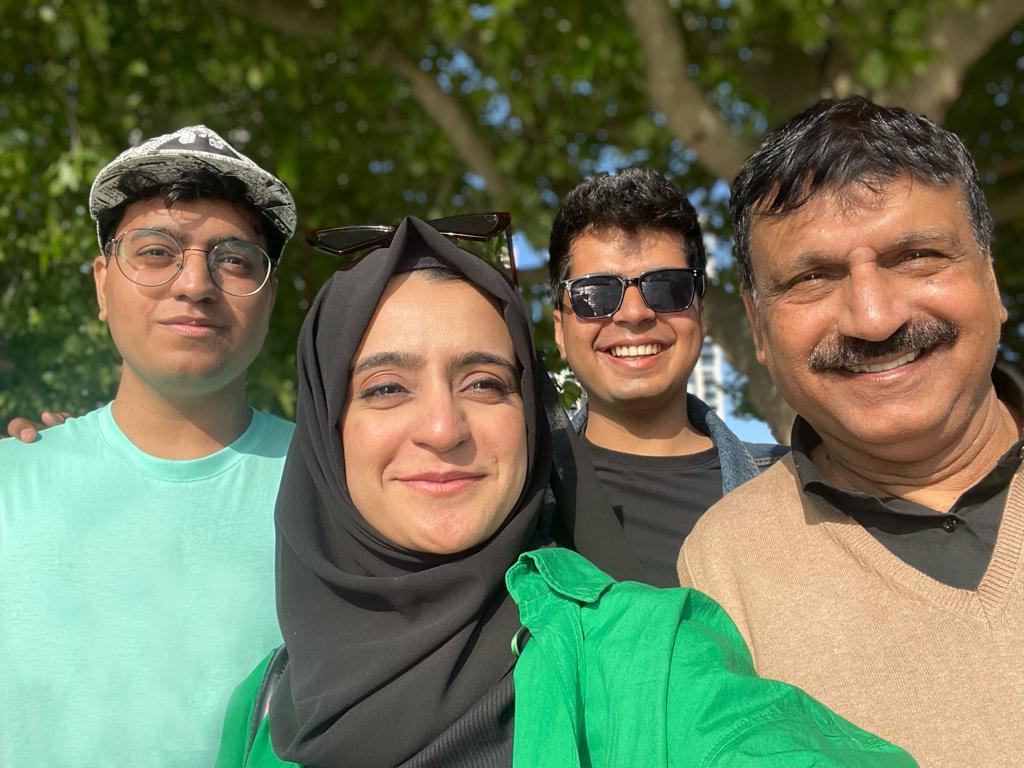
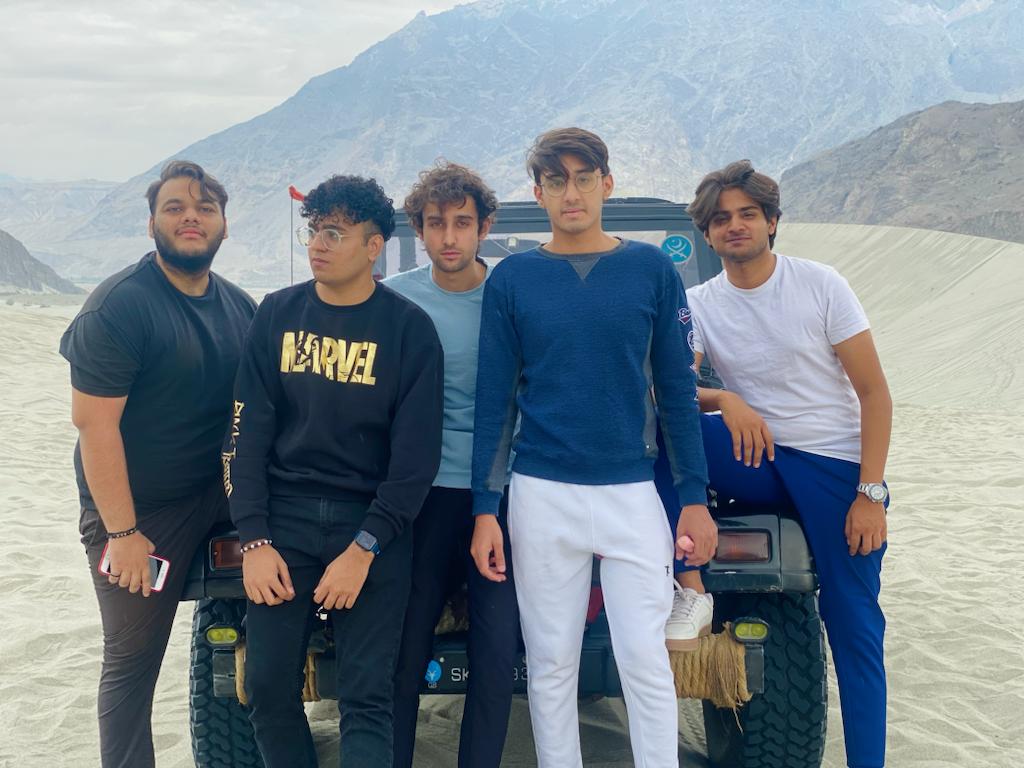
Meet Mursal!

Aslamuallikum mera naam mursal he, me Pakistan se taluq rakhta Hu, me UNI spring 2022 me aya tha, aur yaha ke log bohot he achey Mizaj ke he, or yeh mera bohot Acha Faisla tha jab mene UNI ko choose kiya Me business analytics parh raha Hu kyuke mujhe data ke barey maloomat Lena bohot Passand he.
My name is Mursal, I am a sophomore majoring in Business Analytics, I come from Hyderabad,Pakistan and I came to UNI in Spring of 2022, Coming to UNI was my best decision when I was choosing a university in the United States, people here are amazing and welcoming, specially professors, they are super helpful and flexible. I chose business analytics because as the world is growing and so is data so I really liked learning about data, that’s why I chose Business analytics. I look forward for internships my next summer so I can have some work experience before graduation.
Mursal Ahmed Khatian – Undergraduate Student
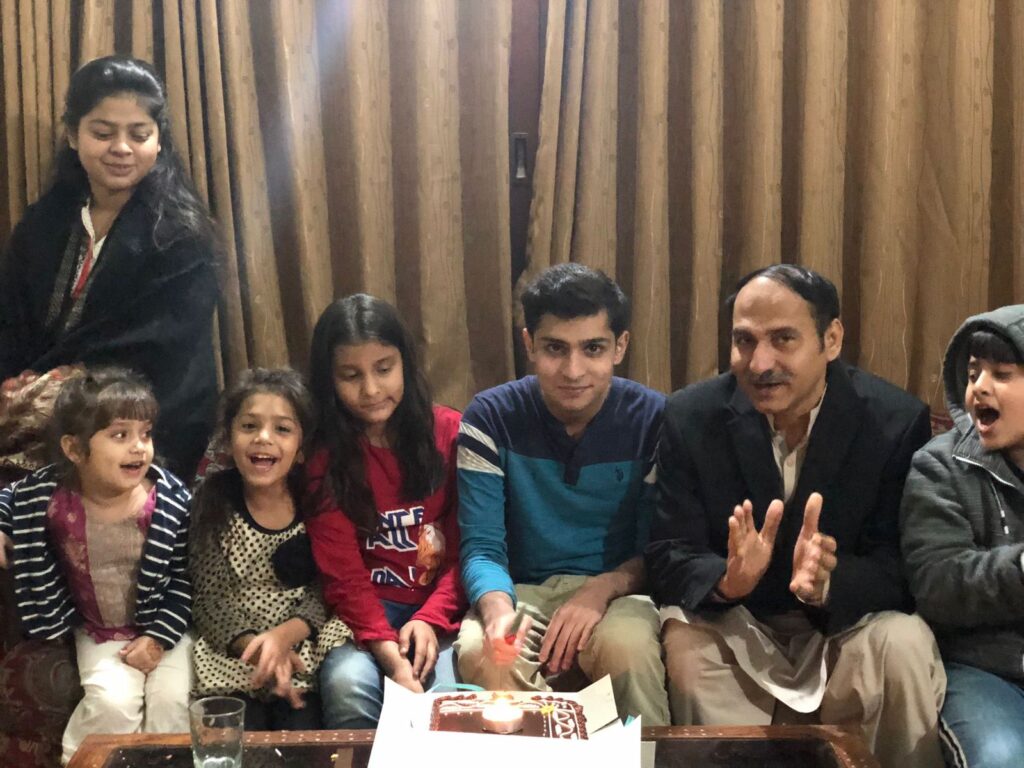
Landscapes of Pakistan
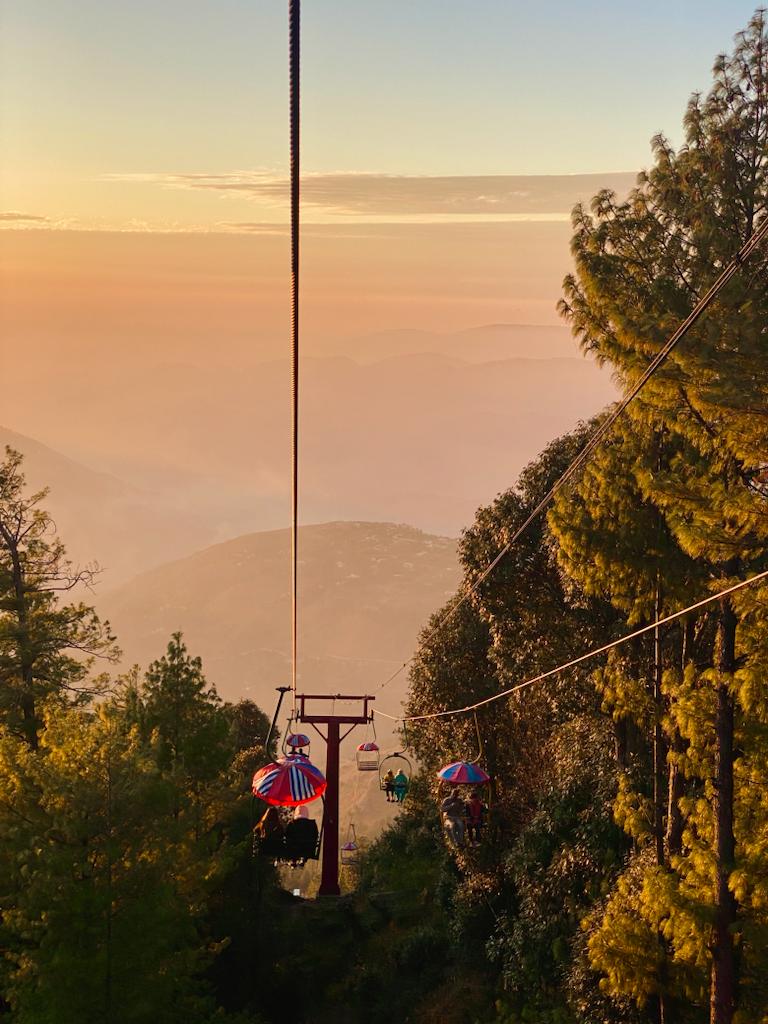
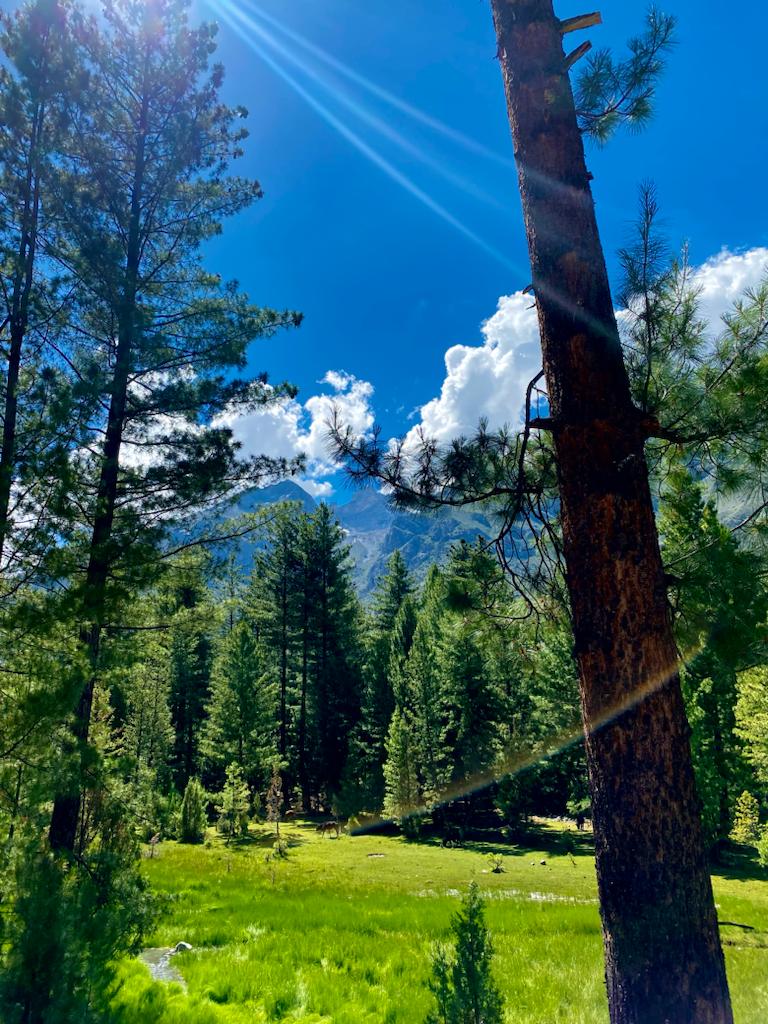
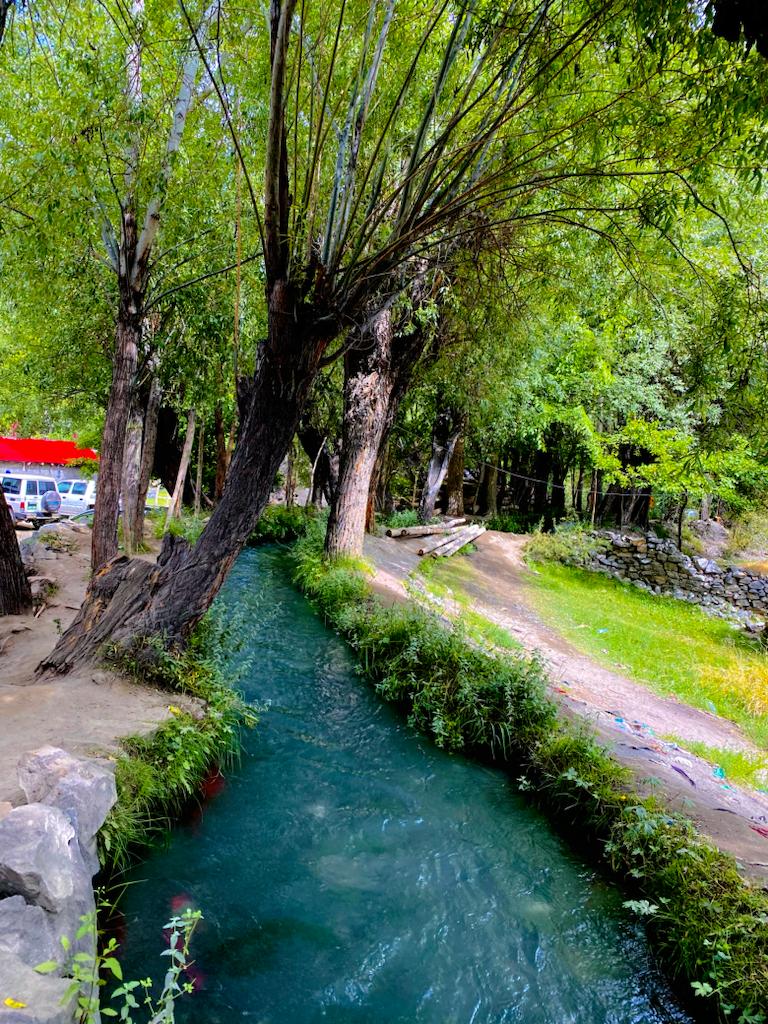
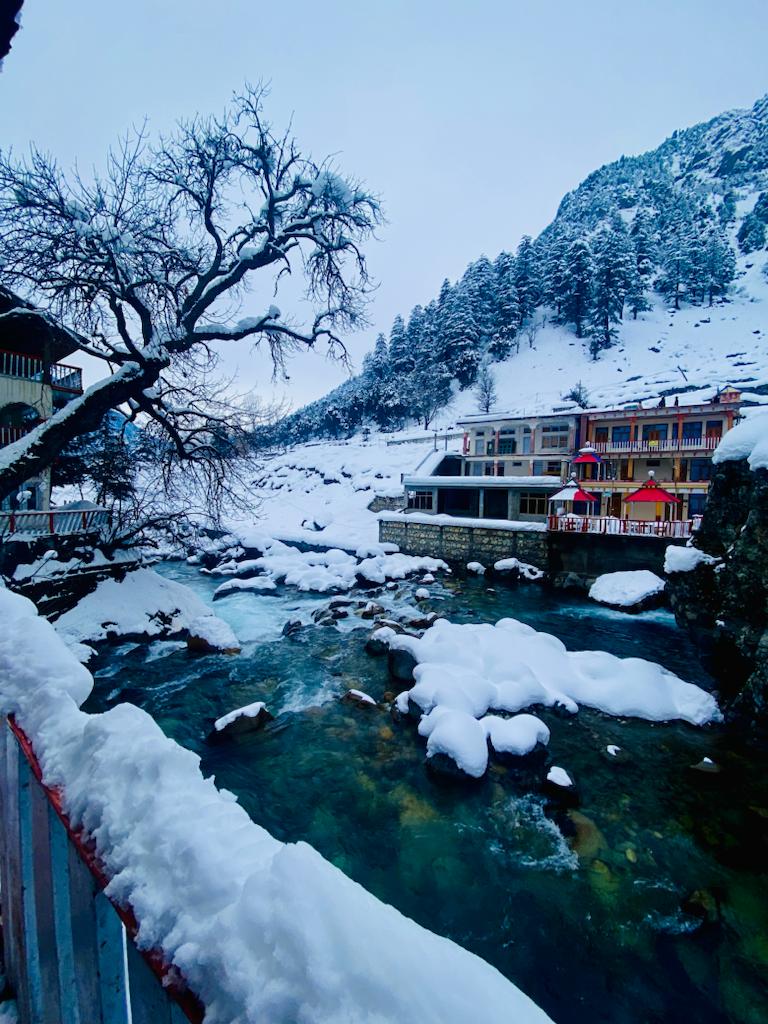
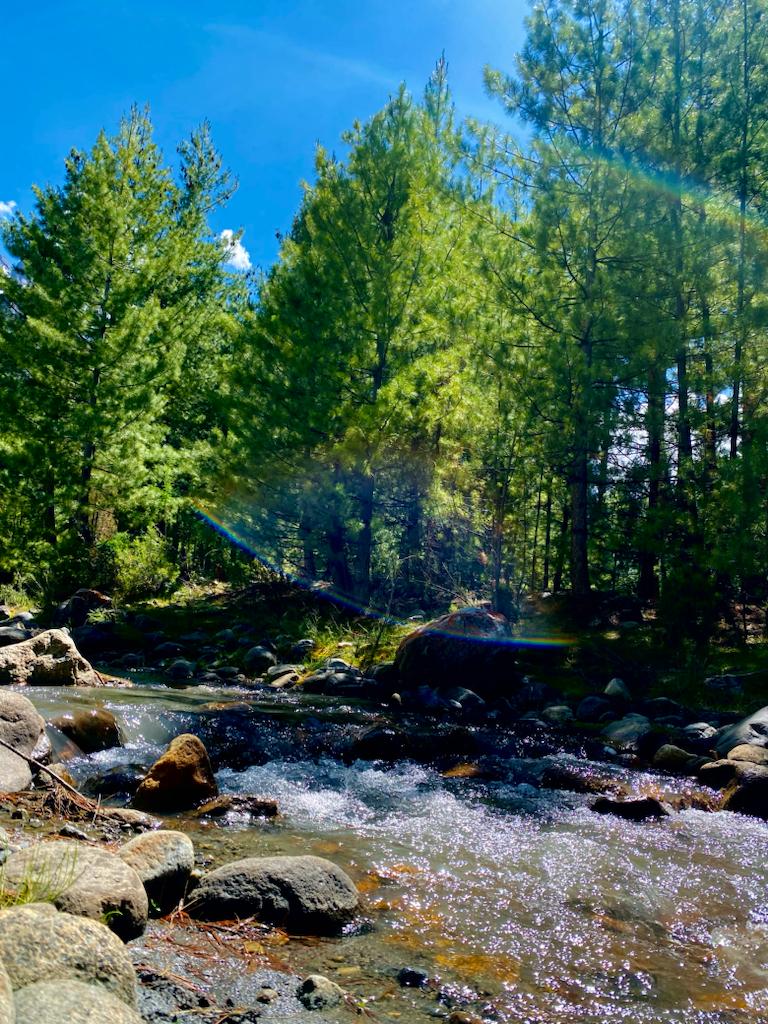
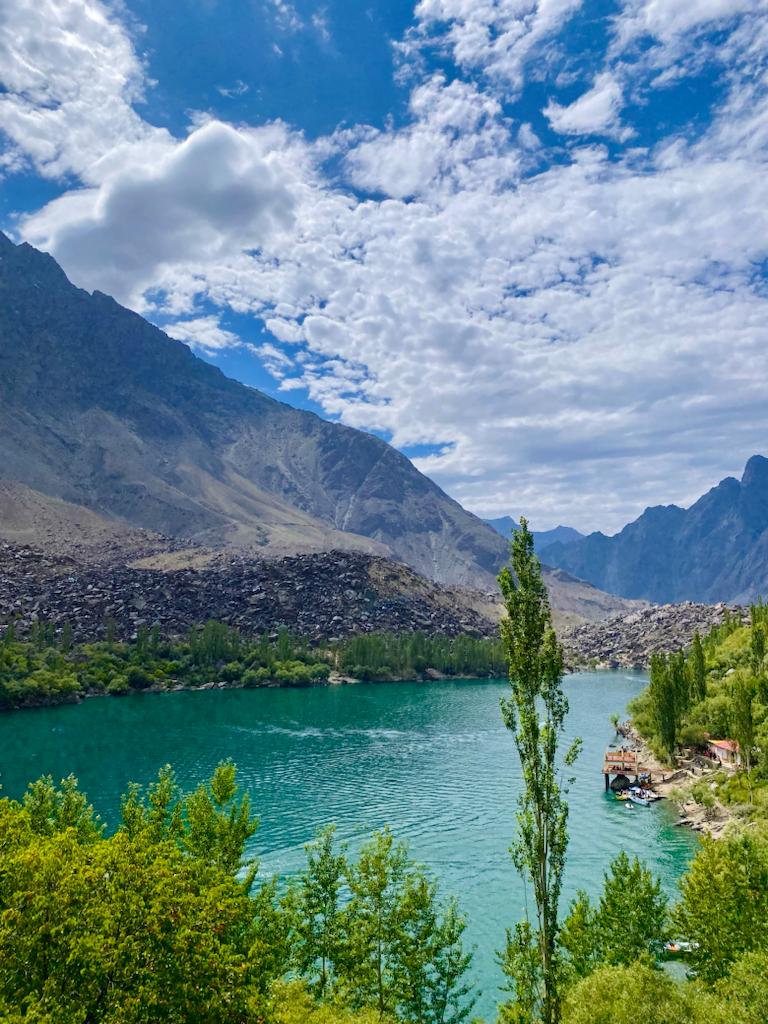
Where is Pakistan located?
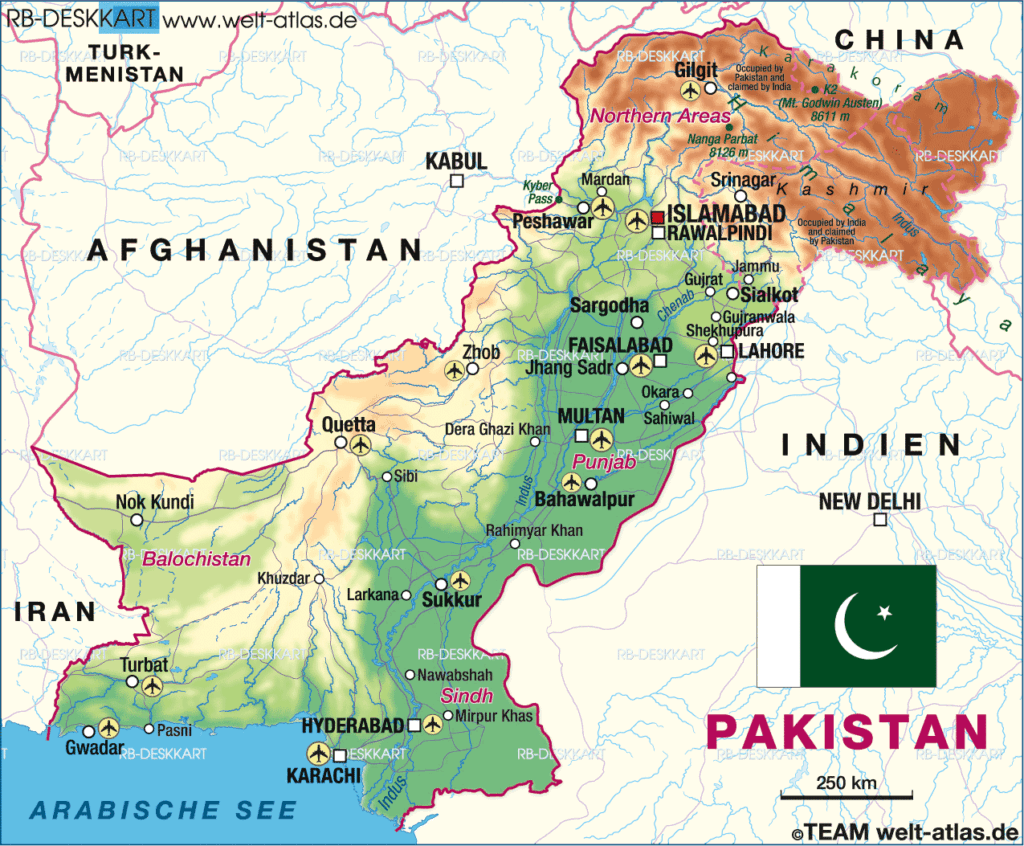
Pakistan is a country located in South Asia. It shares borders with India to the east, Afghanistan and Iran to the west, and China to the north. To the south, Pakistan has a coastline along the Arabian Sea. The capital city of Pakistan is Islamabad, and its largest city is Karachi.
Places to visit in Pakistan
Pakistan is a country with a diverse landscape and a rich cultural heritage, offering a variety of destinations for travelers. Here are some notable places to visit in Pakistan:
- Hunza Valley: Nestled in the Karakoram Range, Hunza Valley is renowned for its breathtaking scenery, including snow-capped peaks, serene lakes, and picturesque villages like Karimabad.
- Skardu: Located in Gilgit-Baltistan, Skardu serves as a gateway to some of the world’s highest peaks, such as K2. The Shangrila Resort and Shigar Fort are among the attractions in the area.
- Lahore: Known as the cultural capital, Lahore boasts historical landmarks like the Badshahi Mosque, Lahore Fort, and the vibrant Walled City. The Lahore Museum and Shalimar Gardens are also must-visit attractions.
- Islamabad: The capital city is surrounded by the Margalla Hills National Park, providing a scenic backdrop. Faisal Mosque, one of the largest mosques globally, and Daman-e-Koh viewpoint are popular spots.
- Karachi: As the largest city, Karachi offers a mix of modernity and tradition. Clifton Beach, Pakistan Maritime Museum, and Quaid’s Mausoleum are among the city’s attractions.

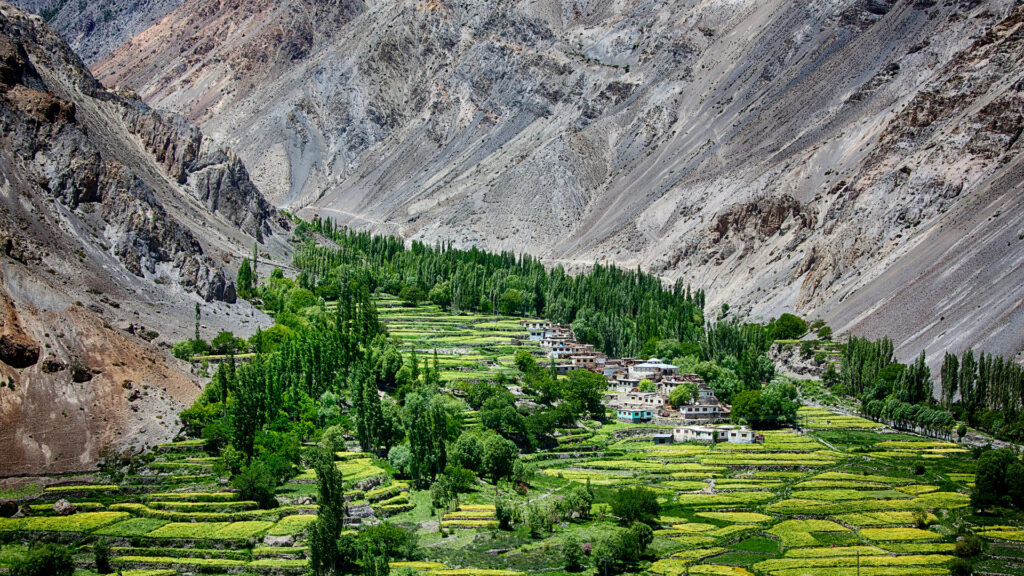
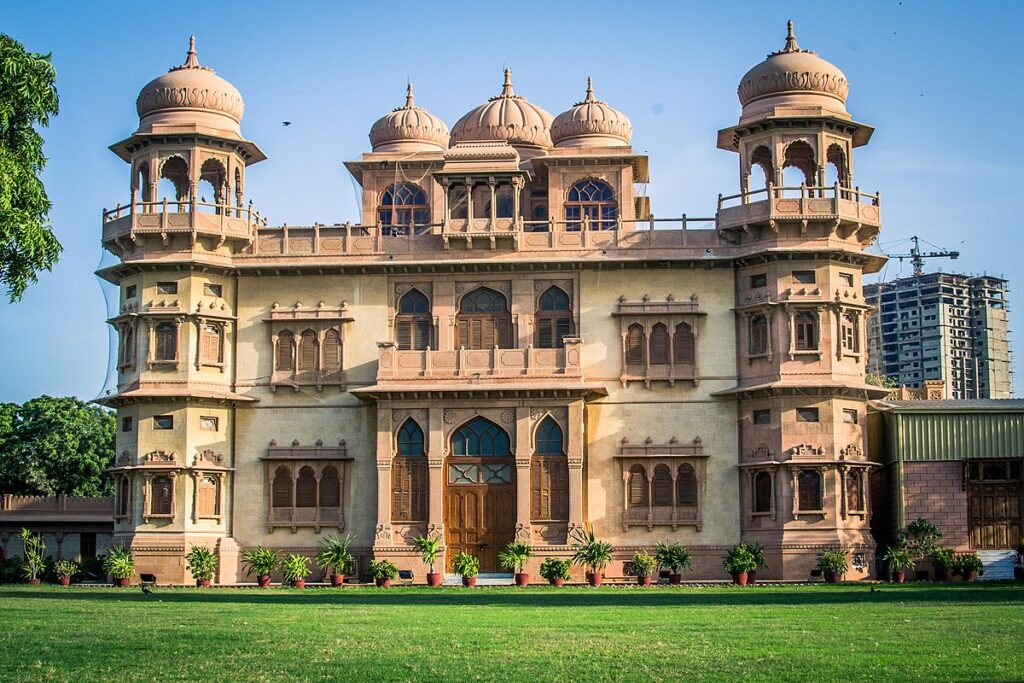
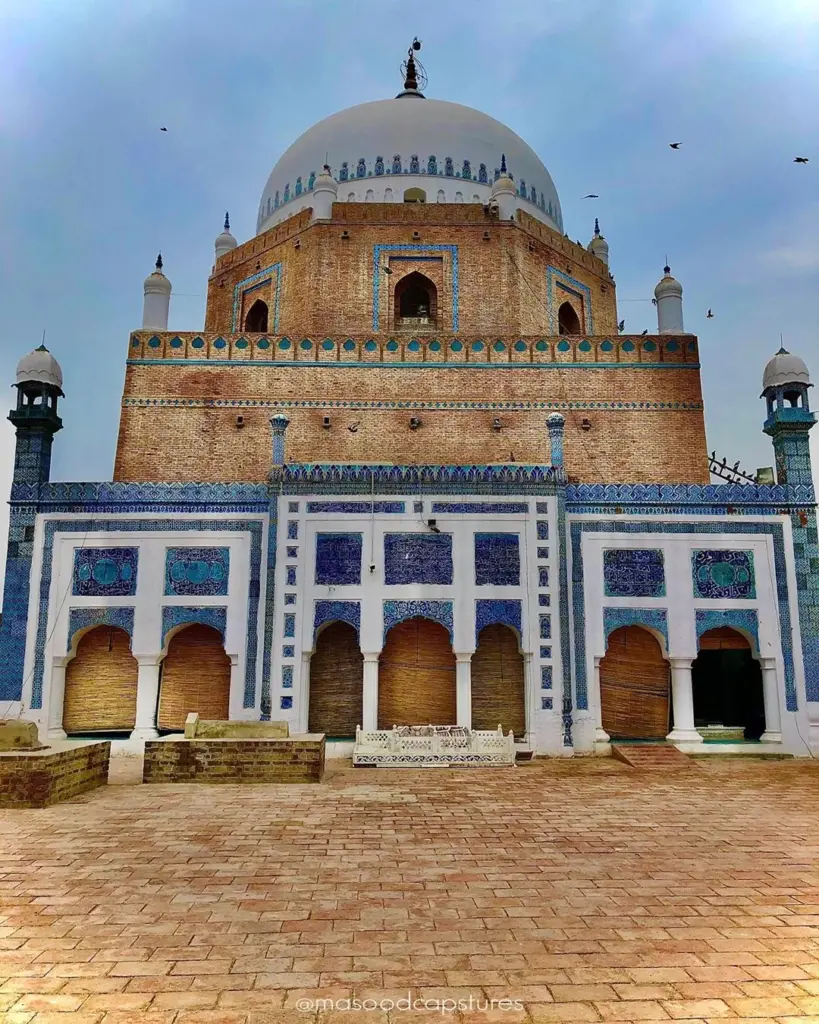
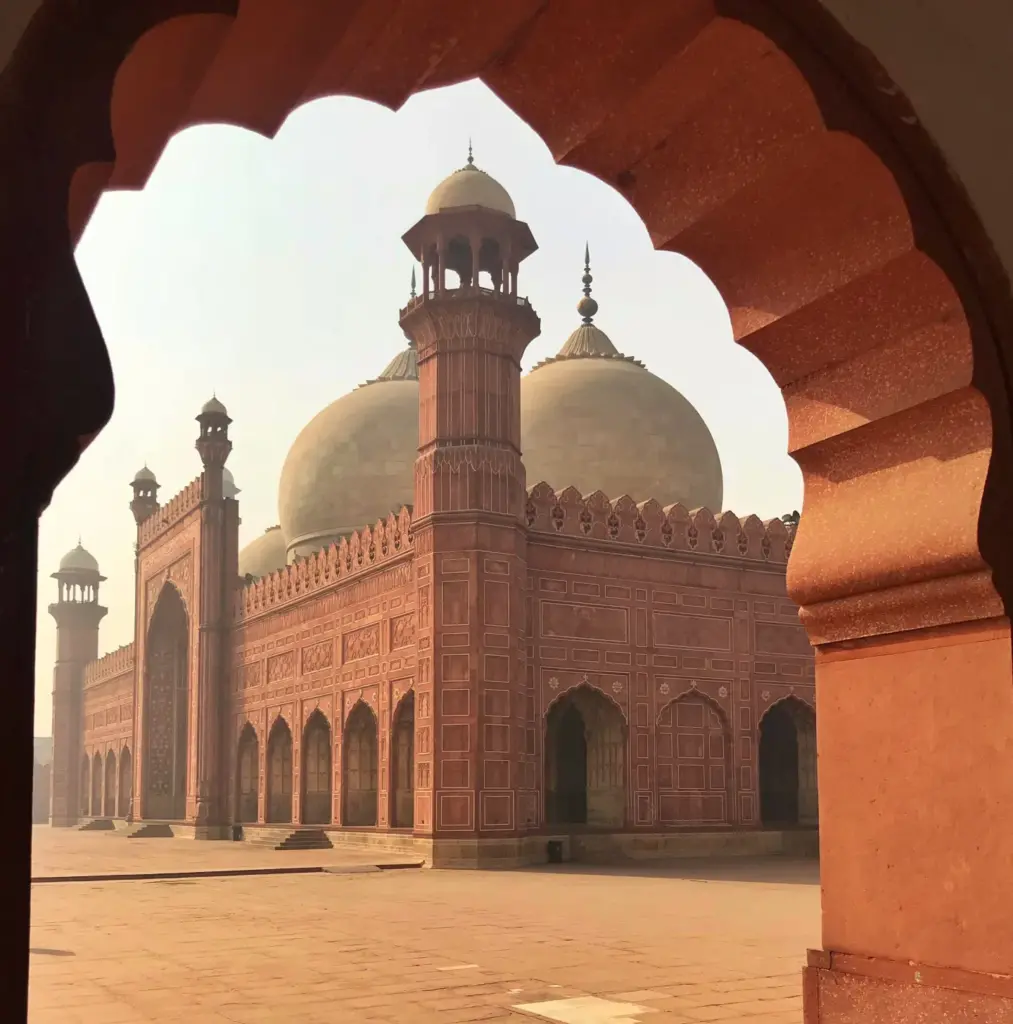
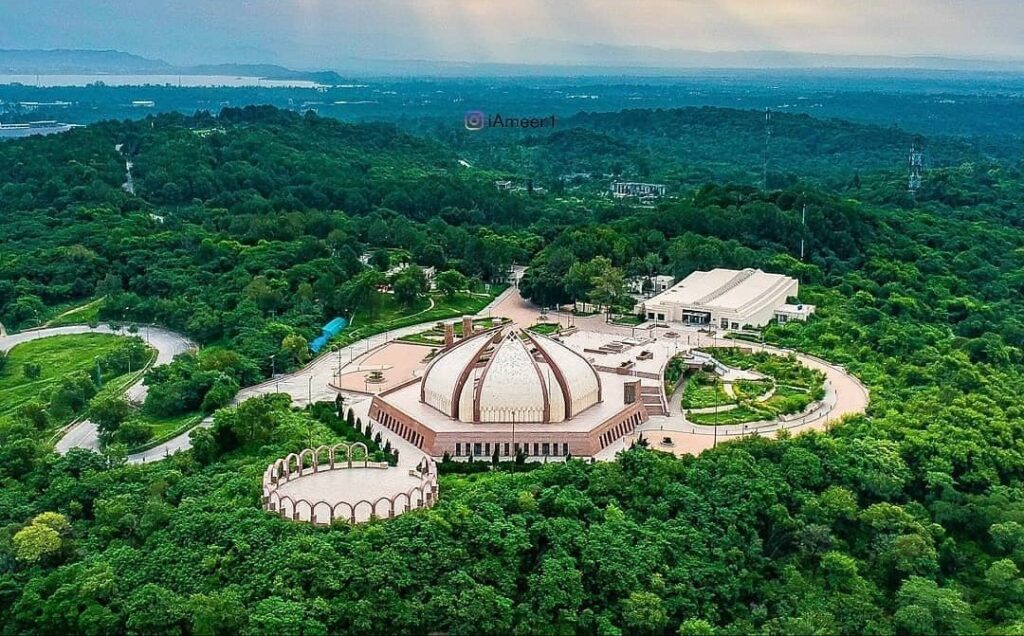
- Swat Valley: Often referred to as the “Switzerland of Pakistan,” Swat Valley is known for its lush green valleys, waterfalls, and archaeological sites like the Buddhist stupas in Butkara and Udegram.
- Multan: Known as the “City of Saints,” Multan is famous for its bazaars, historic shrines, and the Multan Fort. The annual Sufi festival, known as Urs, attracts visitors from all over.
- Fairy Meadows: Situated near Nanga Parbat, the world’s ninth-highest mountain, Fairy Meadows offers stunning views and serves as a base camp for trekkers.
- Mohatta Palace, Karachi: An architectural gem, Mohatta Palace showcases the blend of Indo-Saracenic and European styles and houses an art gallery.
- Mohenjo-daro: An ancient archaeological site of the Indus Valley Civilization, Mohenjo-daro provides a glimpse into one of the world’s earliest urban centers.

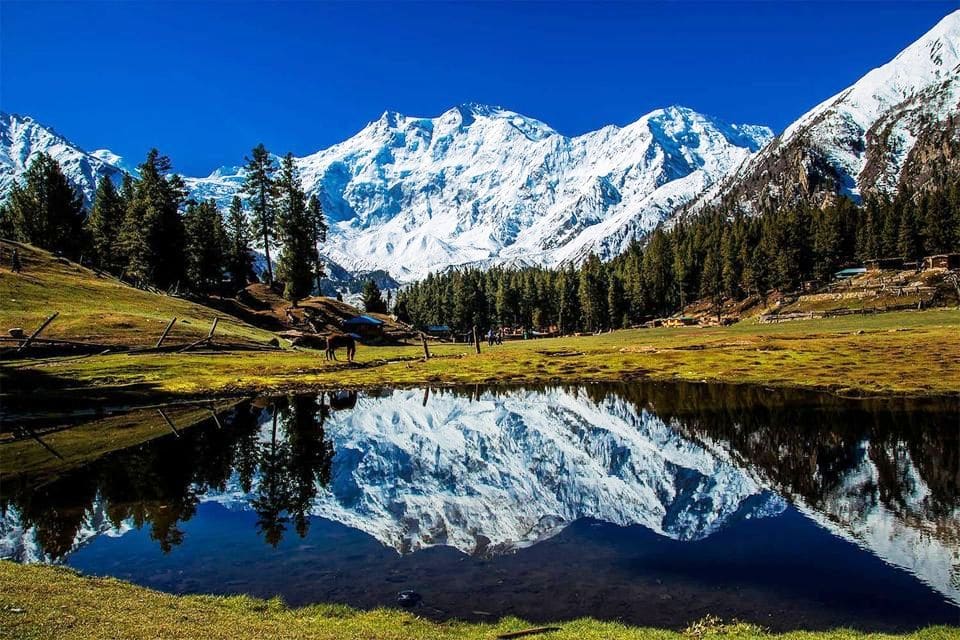
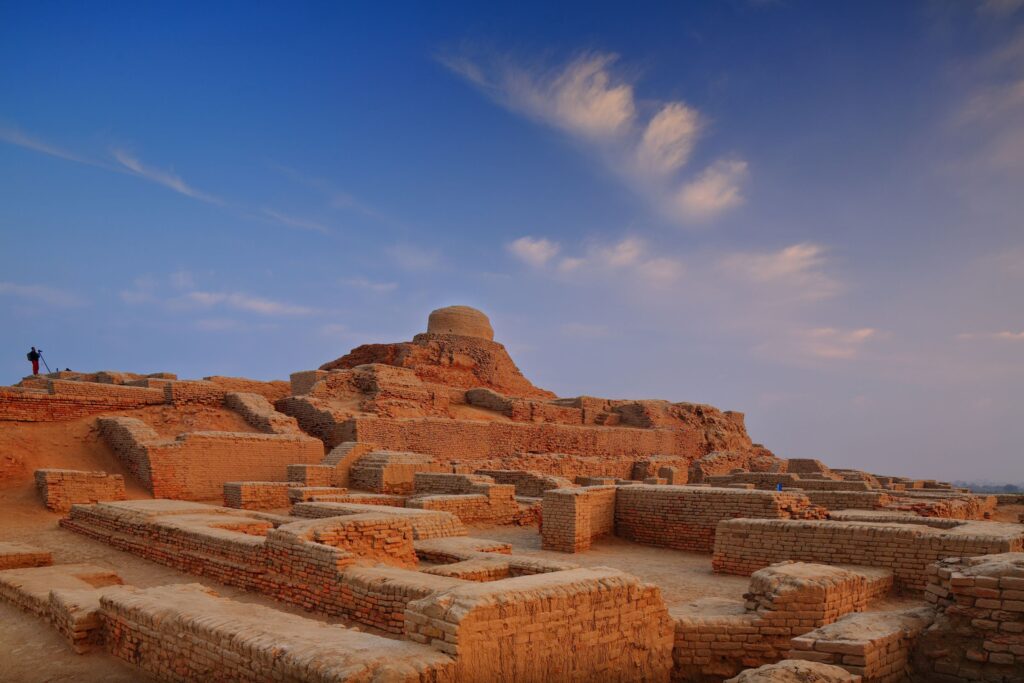
Traditional food
Pakistan has a rich and diverse culinary heritage, influenced by various regions and cultures. Here are some traditional Pakistani dishes that are popular across the country:
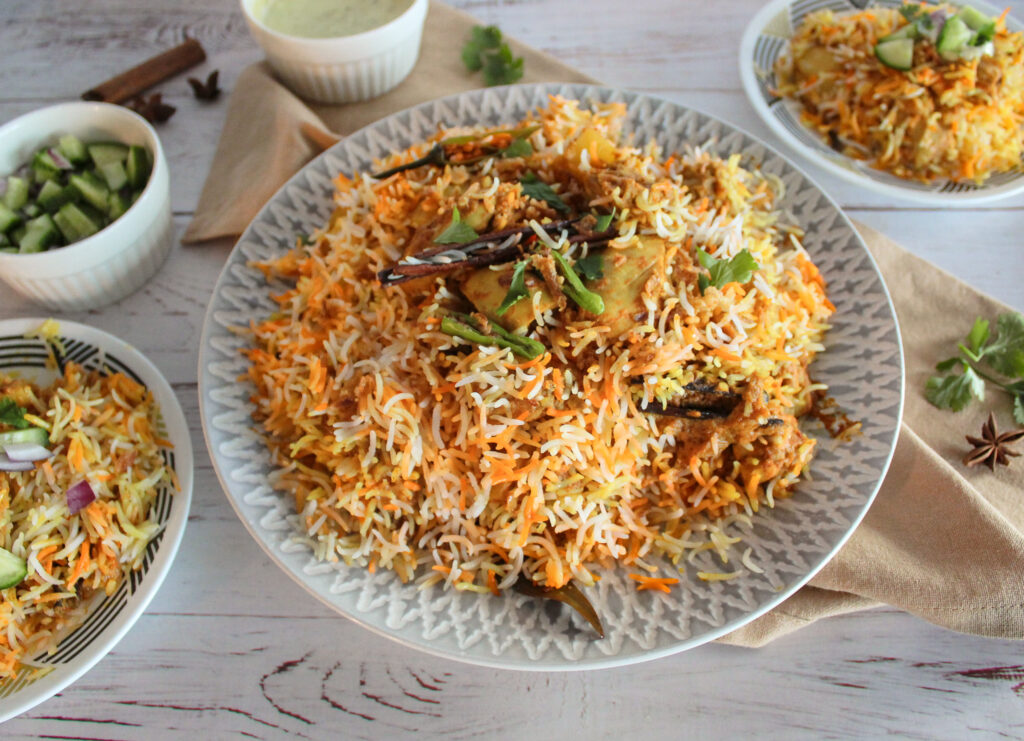
- Biryani: A flavorful and aromatic rice dish, biryani is made with basmati rice, meat (chicken, beef, or mutton), and a blend of spices. It often includes ingredients like yogurt, tomatoes, and fried onions.
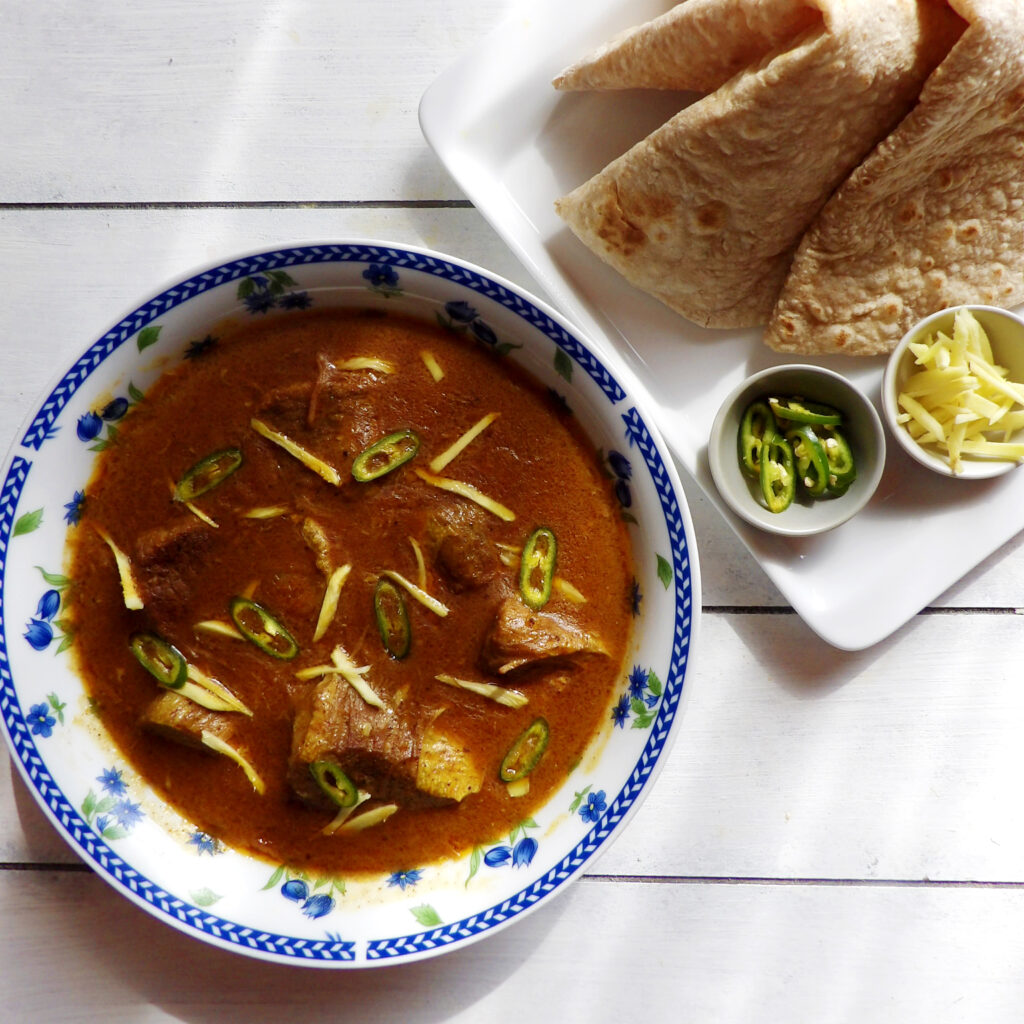
- Nihari: A slow-cooked stew made with meat, usually beef or mutton, Nihari is rich in spices and has a distinct flavor. It’s often enjoyed with naan (flatbread) and garnished with fresh ginger, green chilies, and coriander.
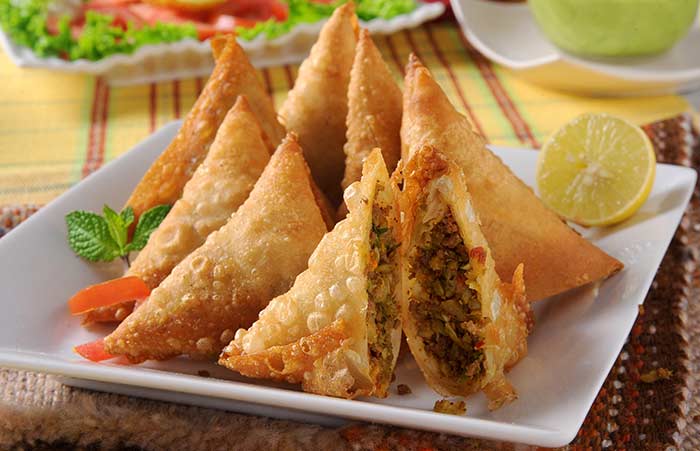
- Samosas: Deep-fried pastry pockets filled with a mixture of spiced potatoes, peas, and sometimes meat. Samosas are popular snacks and are often served with chutney.
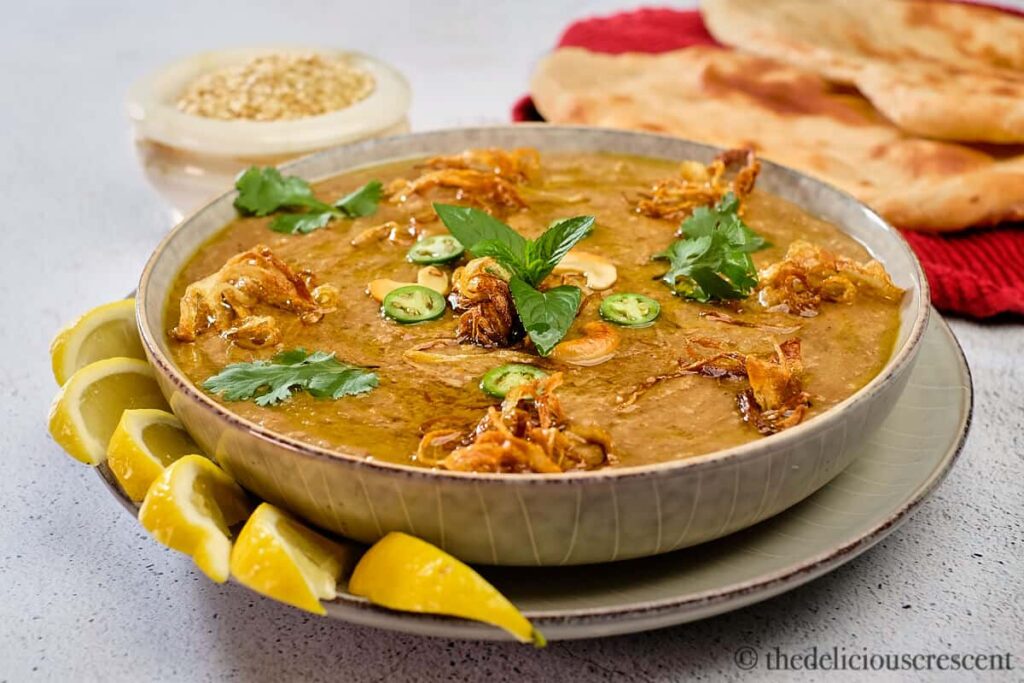
- Haleem: A thick and hearty stew made with a blend of lentils, wheat, and meat (usually chicken or beef). Haleem is slow-cooked to achieve a smooth consistency and is seasoned with a mix of spices.
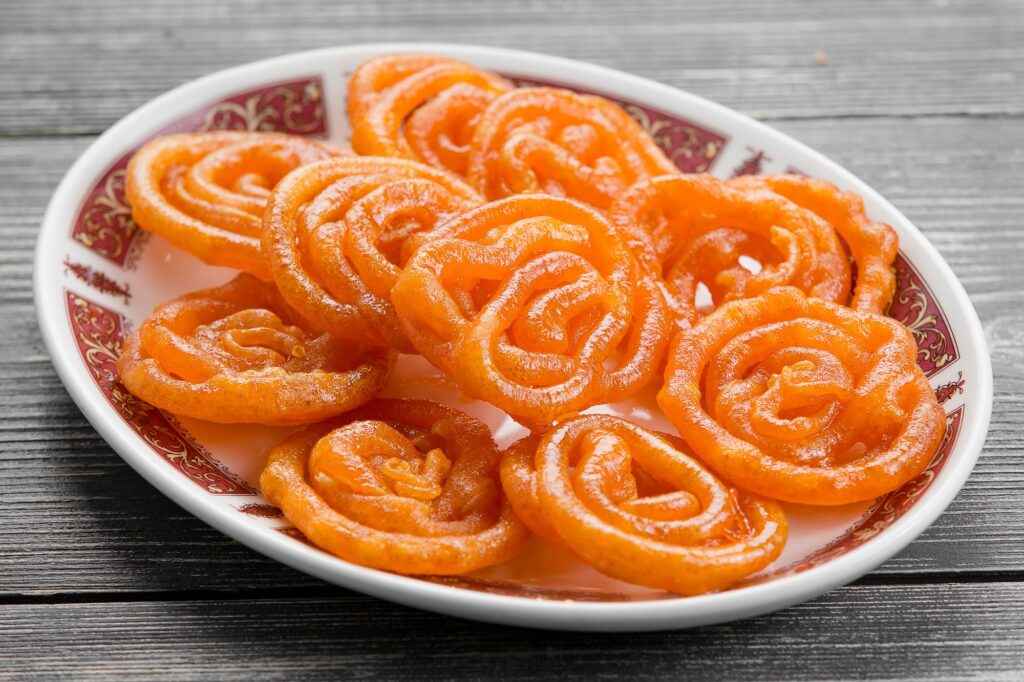
Jalebi: A sweet treat made by deep-frying wheat-flour batter into pretzel or circular shapes, which are then soaked in sugar syrup. Jalebi is enjoyed as a dessert.
Traditional Costumes

Shalwar Kameez:
- This is the most common traditional outfit worn by both men and women in Pakistan. It consists of loose-fitting trousers (shalwar) paired with a long tunic-like shirt (kameez). Women often wear a dupatta (scarf) with it.
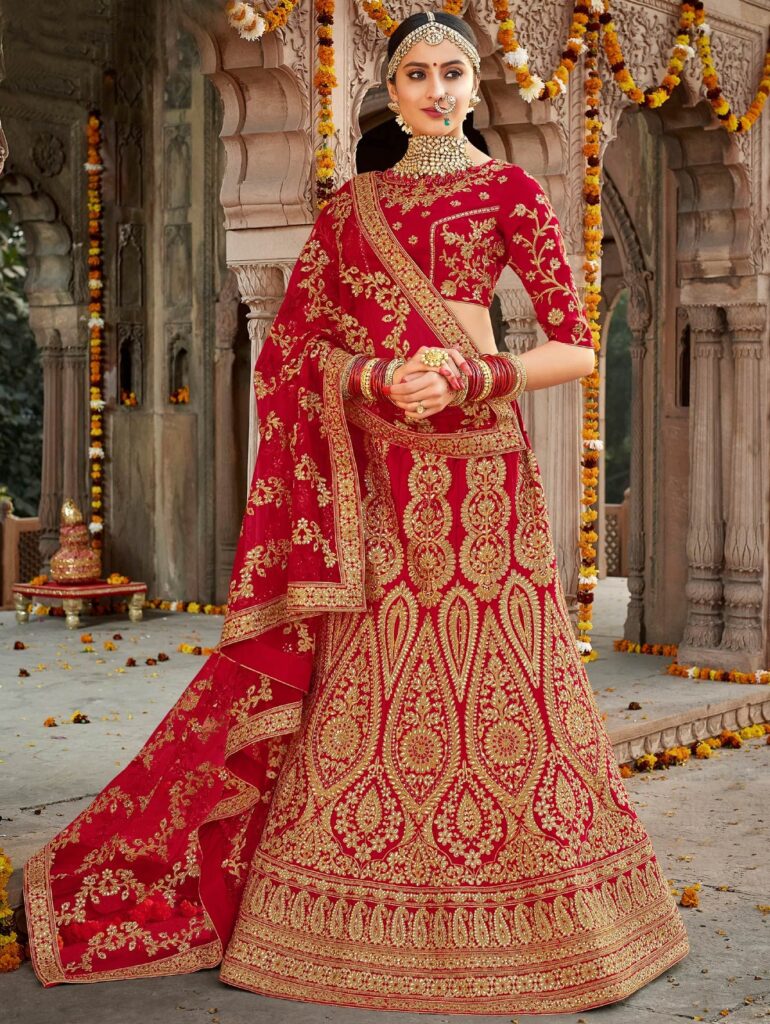
Lehenga Choli:
- Lehenga choli is a traditional outfit, particularly popular among women in Punjab and Sindh. It consists of a flared skirt (lehenga), a short blouse (choli), and a long scarf or dupatta.

Sari:
- Although more commonly associated with Indian culture, the sari is also worn by women in Pakistan, especially in the eastern parts of the country. It is a long piece of cloth draped elegantly around the body.
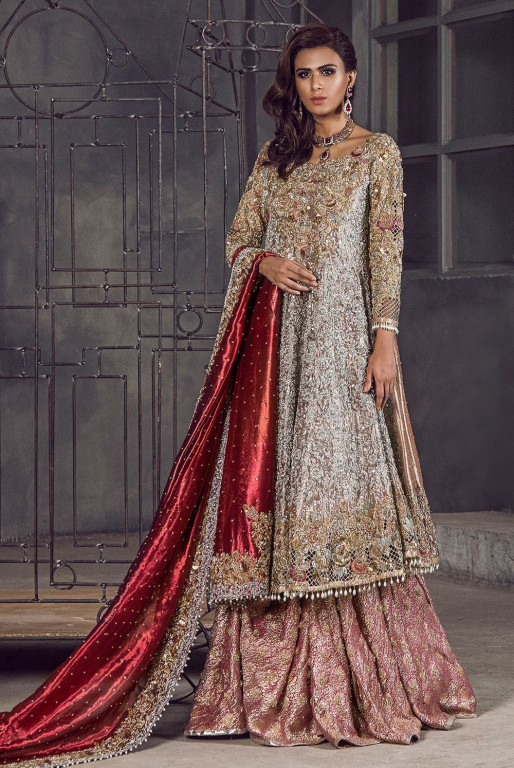
Peshawari Dress:
- The Peshawari dress is popular among men, especially in the Khyber Pakhtunkhwa (KP) province. It includes a loose-fitting, knee-length shirt with embroidery and straight-cut trousers.
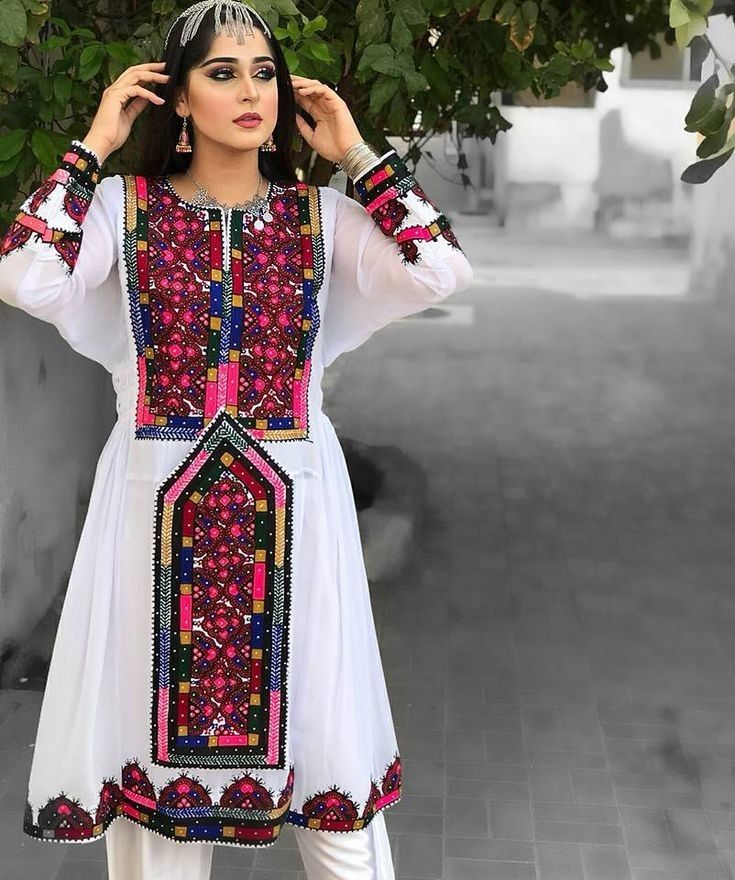
Balochi Dress:
- The traditional dress of the Baloch people includes a loose-fitting tunic (kurta) paired with straight trousers (shalwar). The men often wear a turban, while women wear colorful dresses and elaborate jewelry.

Sindhi Ajrak:
- The Sindhi people are known for their distinctive ajrak, a block-printed shawl or cloth that is an integral part of their traditional dress. It is often worn by both men and women.
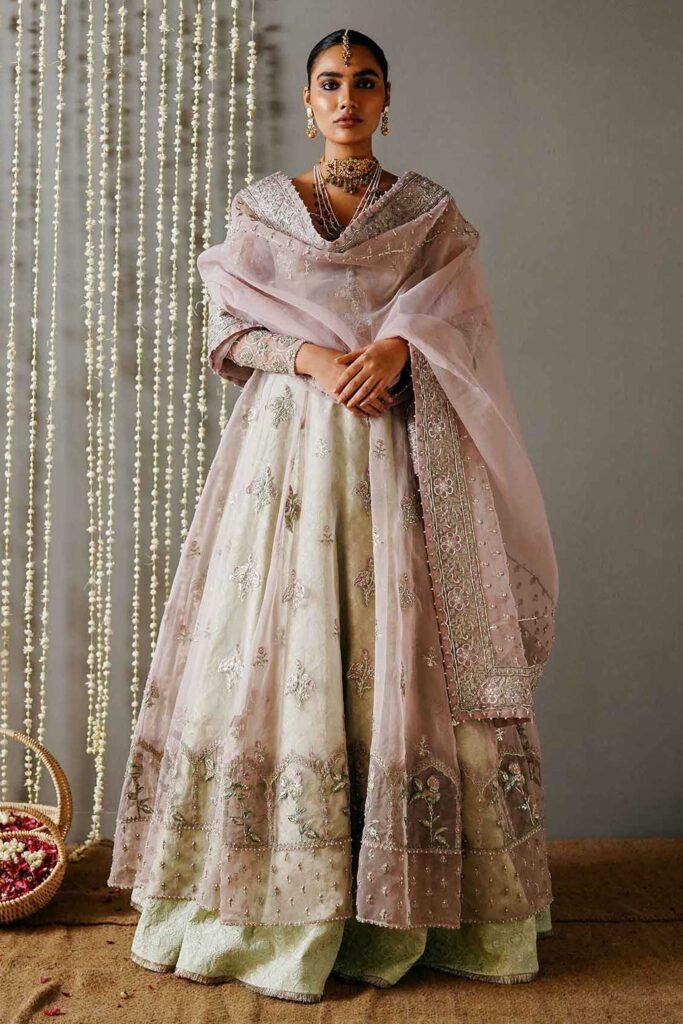
Punjabi Pothohari Suit:
- In Punjab, women often wear the Pothohari suit, which includes a knee-length tunic with intricate embroidery, paired with straight trousers and a dupatta.

Chitrali Patti:
- The people of Chitral, in the northern areas of Pakistan, have a distinct traditional costume known as the Chitrali Patti. It includes a long tunic with embroidered patterns, wide trousers, and a distinctive woolen cap.
Festivals
Pakistan celebrates a variety of festivals, reflecting its diverse cultural and religious landscape. Here are some of the major festivals celebrated in Pakistan:
Eid-ul-Fitr:
- This is one of the most important Muslim festivals celebrated at the end of Ramadan, the holy month of fasting. Families come together, offer prayers, and share festive meals. It is a time for giving and receiving gifts and charity.
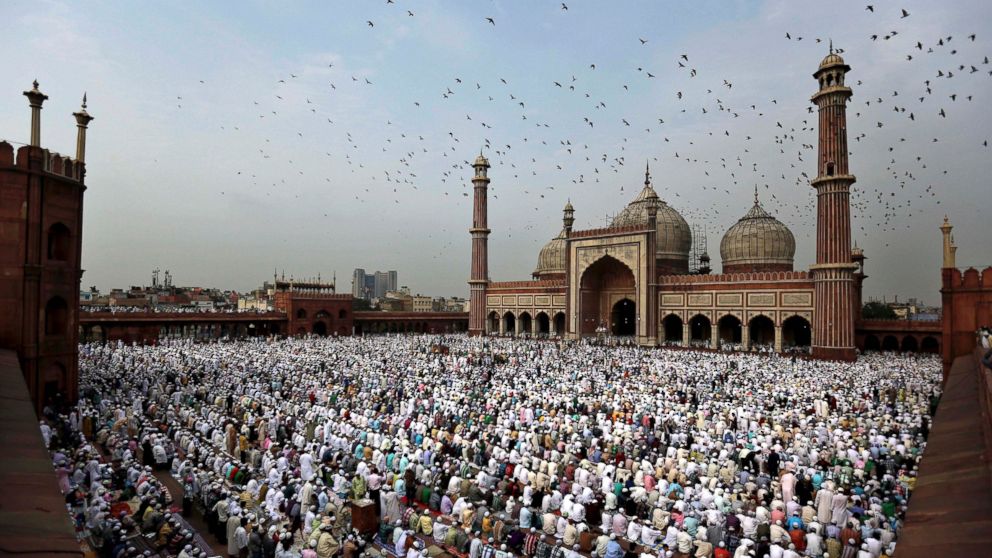
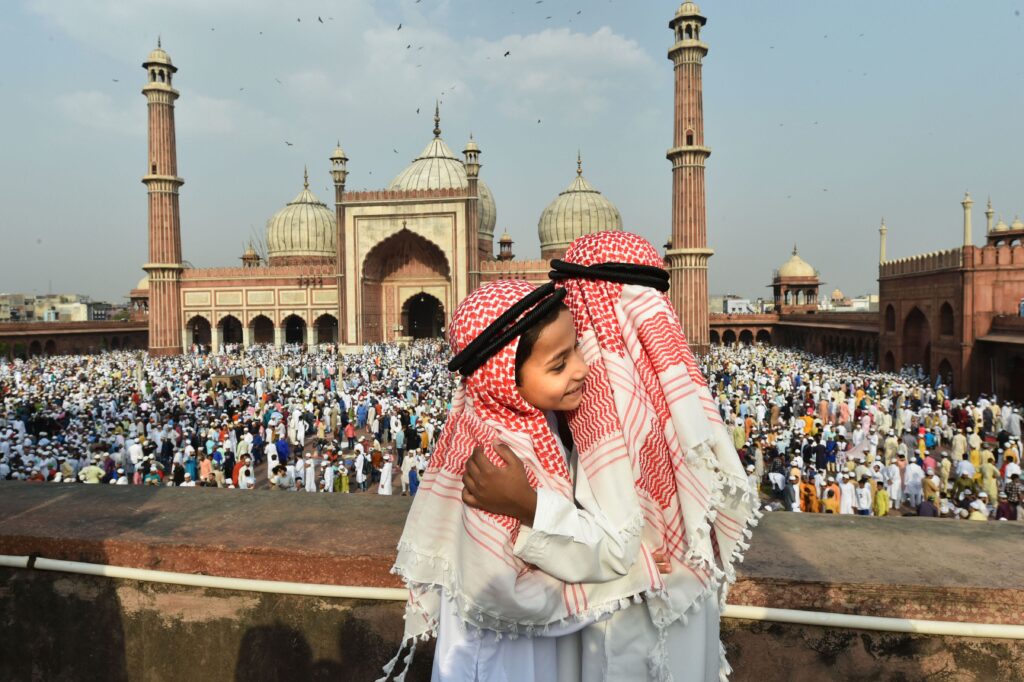

Eid-ul-Adha:
- Also known as the “Festival of Sacrifice,” Eid-ul-Adha commemorates the willingness of Prophet Ibrahim (Abraham) to sacrifice his son as an act of obedience to God. Families sacrifice animals, and the meat is distributed among relatives, neighbors, and the less fortunate.
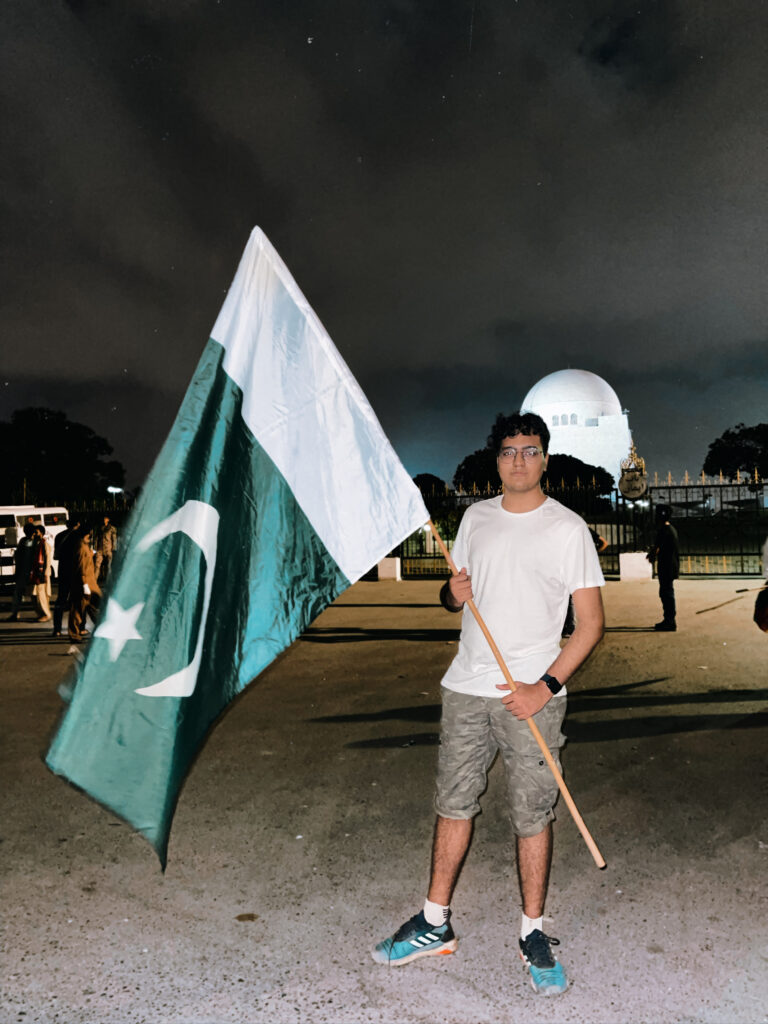
Independence Day (August 14)
Pakistan celebrates its Independence Day on August 14th to commemorate the day in 1947 when the country gained independence from British rule. The day is marked with patriotic fervor, flag hoisting, parades, and cultural events.
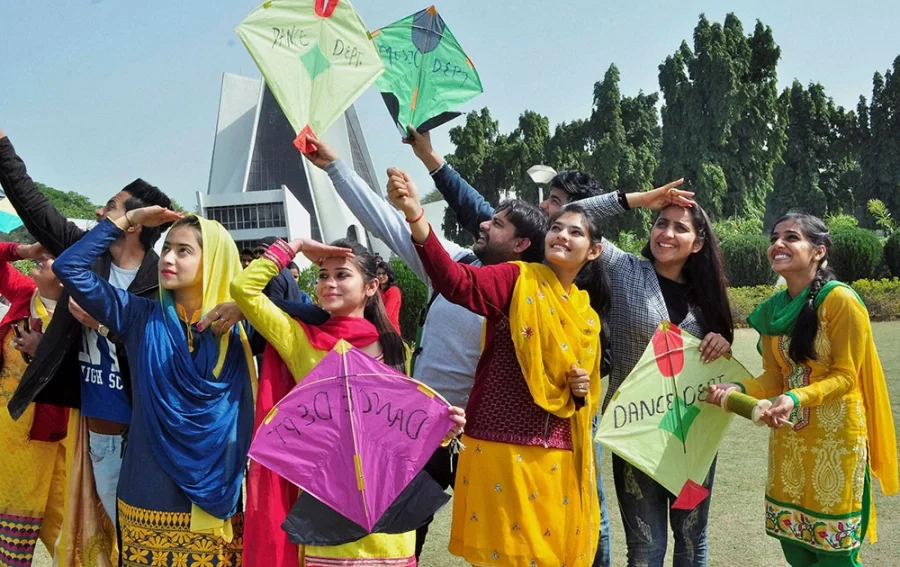
Basant (Kite Festival)
- Basant is a traditional spring festival celebrated in some parts of Pakistan, particularly in Lahore. People fly kites, wear colorful clothes, and enjoy festive foods. However, due to safety concerns associated with kite flying, the festival has faced restrictions in recent years.
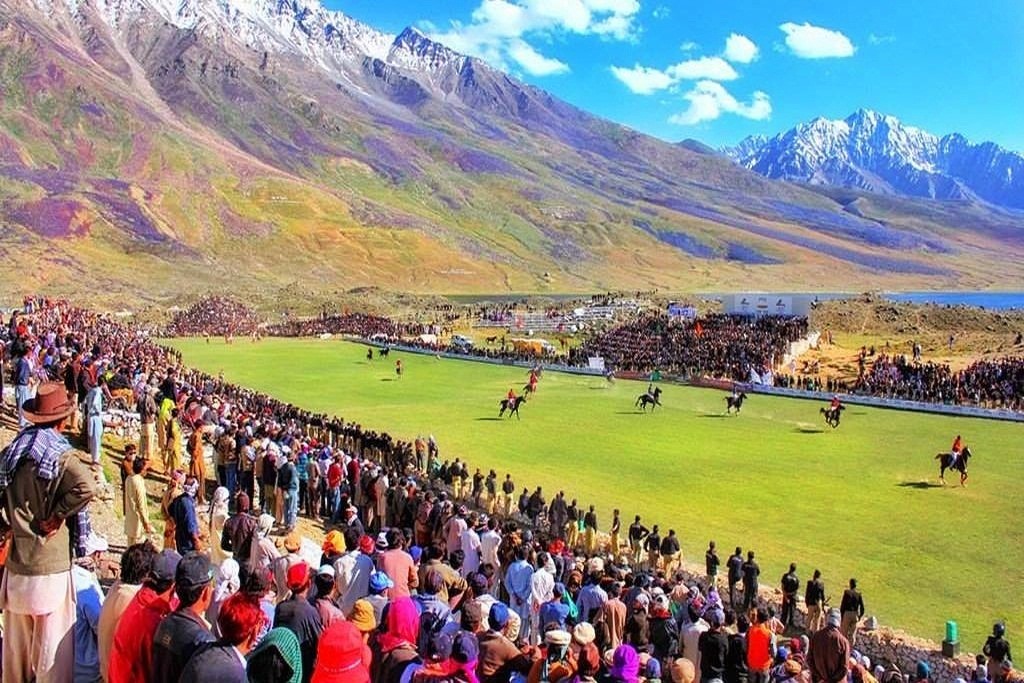
Shandur Polo Festival
- Shandur Polo Festival is held at Shandur Pass in the Gilgit-Baltistan region. It is a high-altitude polo tournament that attracts teams from different regions. The festival also features traditional music, dance, and cultural activities.
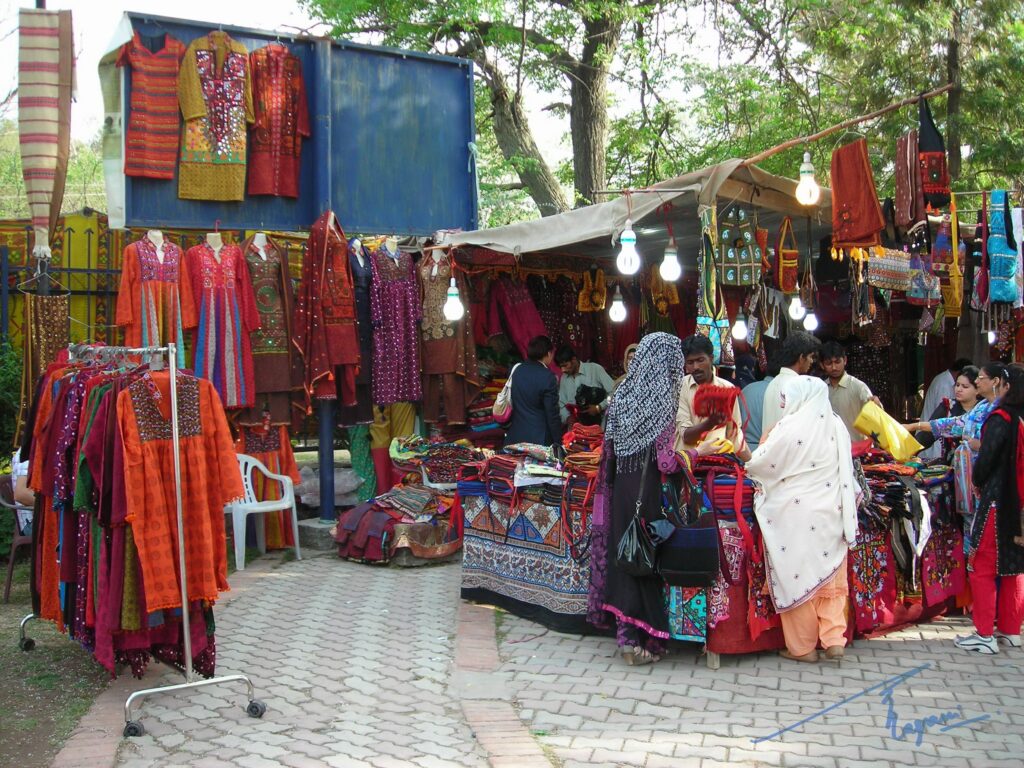
Lok Mela
- Lok Mela is a folk festival organized by the National Institute of Folk and Traditional Heritage (Lok Virsa). It showcases the diverse cultural heritage of Pakistan, featuring traditional music, dance, crafts, and cuisine.

Chilam Joshi Festival
- Celebrated by the Kalash people in the Chitral district, this festival marks the arrival of spring. It involves traditional dances, rituals, and the making of floral wreaths.
Facts…
- World’s Second-Highest Mountain:
- Pakistan is home to K2, the second-highest mountain in the world after Mount Everest. Situated in the Karakoram Range, K2 is renowned among mountaineers for its challenging ascent.
- Largest Deep Sea Port:
- The Gwadar Port, located in the southwestern province of Balochistan, is Pakistan’s largest deep-sea port. It plays a crucial role in the China-Pakistan Economic Corridor (CPEC) and serves as a strategic trade route.
- World’s Highest ATM:
- The National Bank of Pakistan has set up the world’s highest ATM at a height of over 16,000 feet above sea level in the Khunjerab Pass, along the border with China.
- Largest Irrigation System:
- The Indus Basin Irrigation System in Pakistan is one of the largest contiguous irrigation systems in the world. It has been vital for the agricultural productivity of the region.
- Edhi Foundation:
- Pakistan is home to the Edhi Foundation, one of the world’s largest and most organized social welfare systems. Founded by Abdul Sattar Edhi, the foundation provides healthcare, social services, and burial services to millions of people.
- Second Largest Salt Mine:
- The Khewra Salt Mine, located in the Punjab region, is the world’s second-largest salt mine. It is a popular tourist destination, known for its stunning salt formations.

Embark on a captivating journey as we delve into the rich tapestry of Pakistan’s cultural heritage. From its vibrant traditions to the warm hospitality that defines the nation, join us in unraveling the unique and diverse aspects that make up the cultural mosaic of Pakistan. As we navigate through the customs, art, and traditions, get ready to be immersed in a fascinating exploration of the enchanting world that is Pakistan’s cultural landscape.
Meet Bilal!

میرا نام بلال ہے اور میں یہاں یونیورسٹی آف ناردرن آئیووا میں کمپیوٹر سائنس کا نیا میجر ہوں۔
میں کراچی، پاکستان سے ہوں جو پاکستان کے جنوب میں واقع ایک بہت بڑا ہلچل مچانے والا شہر ہے۔
میں کل تین بہن بھائیوں میں سب سے چھوٹا ہوں اور دونوں نے اپنے ماسٹرز کے لیے بیرون ملک تعلیم حاصل کی ہے اس لیے میرے والد چاہتے تھے کہ میں بھی اپنے خوابوں کو پورا کروں۔
میں بہت باہر جانے والا اور سماجی شخص ہوں۔ مجھے خاص طور پر اپنے دوستوں کے ساتھ پاکستان کے شمالی حصے میں پہاڑوں کا دورہ کرنا پسند ہے۔
میں دنیا کو تلاش کرنے اور پوری دنیا کے لوگوں سے مل کر نئی چیزیں سیکھنے کا شوق رکھتا ہوں۔
!میں یہ دیکھ کر پرجوش ہوں کہ مستقبل میں میرے لیے کیا ہے
Hi my name is Bilal and I am a freshman computer science major here at the university of northern iowa.
I am from Karachi, Pakistan which is a huge hustling bustling tropical city located in the south side of Pakistan.
I am the youngest of total three siblings and both of them studied abroad for their masters so my dad wanted me to pursue my dreams as well and here i am.
I am a very outgoing and social person. I love visiting the mountains in the northern side of Pakistan especially with my friends.
I am passionate about exploring the world and learning new things by meeting people from all across the world.
I am excited to see what the future has in store for me!
Bilal Iqbal Baig – Undergraduate Student


Meet Mursal!

Aslamuallikum mera naam mursal he, me Pakistan se taluq rakhta Hu, me UNI spring 2022 me aya tha, aur yaha ke log bohot he achey Mizaj ke he, or yeh mera bohot Acha Faisla tha jab mene UNI ko choose kiya Me business analytics parh raha Hu kyuke mujhe data ke barey maloomat Lena bohot Passand he.
My name is Mursal, I am a sophomore majoring in Business Analytics, I come from Hyderabad,Pakistan and I came to UNI in Spring of 2022, Coming to UNI was my best decision when I was choosing a university in the United States, people here are amazing and welcoming, specially professors, they are super helpful and flexible. I chose business analytics because as the world is growing and so is data so I really liked learning about data, that’s why I chose Business analytics. I look forward for internships my next summer so I can have some work experience before graduation.
Mursal Ahmed Khatian – Undergraduate Student

Landscapes of Pakistan






Where is Pakistan located?

Pakistan is a country located in South Asia. It shares borders with India to the east, Afghanistan and Iran to the west, and China to the north. To the south, Pakistan has a coastline along the Arabian Sea. The capital city of Pakistan is Islamabad, and its largest city is Karachi.
Places to visit in Pakistan
Pakistan is a country with a diverse landscape and a rich cultural heritage, offering a variety of destinations for travelers. Here are some notable places to visit in Pakistan:
- Hunza Valley: Nestled in the Karakoram Range, Hunza Valley is renowned for its breathtaking scenery, including snow-capped peaks, serene lakes, and picturesque villages like Karimabad.
- Skardu: Located in Gilgit-Baltistan, Skardu serves as a gateway to some of the world’s highest peaks, such as K2. The Shangrila Resort and Shigar Fort are among the attractions in the area.
- Lahore: Known as the cultural capital, Lahore boasts historical landmarks like the Badshahi Mosque, Lahore Fort, and the vibrant Walled City. The Lahore Museum and Shalimar Gardens are also must-visit attractions.
- Islamabad: The capital city is surrounded by the Margalla Hills National Park, providing a scenic backdrop. Faisal Mosque, one of the largest mosques globally, and Daman-e-Koh viewpoint are popular spots.
- Karachi: As the largest city, Karachi offers a mix of modernity and tradition. Clifton Beach, Pakistan Maritime Museum, and Quaid’s Mausoleum are among the city’s attractions.






- Swat Valley: Often referred to as the “Switzerland of Pakistan,” Swat Valley is known for its lush green valleys, waterfalls, and archaeological sites like the Buddhist stupas in Butkara and Udegram.
- Multan: Known as the “City of Saints,” Multan is famous for its bazaars, historic shrines, and the Multan Fort. The annual Sufi festival, known as Urs, attracts visitors from all over.
- Fairy Meadows: Situated near Nanga Parbat, the world’s ninth-highest mountain, Fairy Meadows offers stunning views and serves as a base camp for trekkers.
- Mohatta Palace, Karachi: An architectural gem, Mohatta Palace showcases the blend of Indo-Saracenic and European styles and houses an art gallery.
- Mohenjo-daro: An ancient archaeological site of the Indus Valley Civilization, Mohenjo-daro provides a glimpse into one of the world’s earliest urban centers.



Traditional food
Pakistan has a rich and diverse culinary heritage, influenced by various regions and cultures. Here are some traditional Pakistani dishes that are popular across the country:

- Biryani: A flavorful and aromatic rice dish, biryani is made with basmati rice, meat (chicken, beef, or mutton), and a blend of spices. It often includes ingredients like yogurt, tomatoes, and fried onions.

- Nihari: A slow-cooked stew made with meat, usually beef or mutton, Nihari is rich in spices and has a distinct flavor. It’s often enjoyed with naan (flatbread) and garnished with fresh ginger, green chilies, and coriander.

- Samosas: Deep-fried pastry pockets filled with a mixture of spiced potatoes, peas, and sometimes meat. Samosas are popular snacks and are often served with chutney.

- Haleem: A thick and hearty stew made with a blend of lentils, wheat, and meat (usually chicken or beef). Haleem is slow-cooked to achieve a smooth consistency and is seasoned with a mix of spices.

Jalebi: A sweet treat made by deep-frying wheat-flour batter into pretzel or circular shapes, which are then soaked in sugar syrup. Jalebi is enjoyed as a dessert.
Traditional Costumes

Shalwar Kameez:
- This is the most common traditional outfit worn by both men and women in Pakistan. It consists of loose-fitting trousers (shalwar) paired with a long tunic-like shirt (kameez). Women often wear a dupatta (scarf) with it.

Lehenga Choli:
- Lehenga choli is a traditional outfit, particularly popular among women in Punjab and Sindh. It consists of a flared skirt (lehenga), a short blouse (choli), and a long scarf or dupatta.

Sari:
- Although more commonly associated with Indian culture, the sari is also worn by women in Pakistan, especially in the eastern parts of the country. It is a long piece of cloth draped elegantly around the body.

Peshawari Dress:
- The Peshawari dress is popular among men, especially in the Khyber Pakhtunkhwa (KP) province. It includes a loose-fitting, knee-length shirt with embroidery and straight-cut trousers.

Balochi Dress:
- The traditional dress of the Baloch people includes a loose-fitting tunic (kurta) paired with straight trousers (shalwar). The men often wear a turban, while women wear colorful dresses and elaborate jewelry.

Sindhi Ajrak:
- The Sindhi people are known for their distinctive ajrak, a block-printed shawl or cloth that is an integral part of their traditional dress. It is often worn by both men and women.

Punjabi Pothohari Suit:
- In Punjab, women often wear the Pothohari suit, which includes a knee-length tunic with intricate embroidery, paired with straight trousers and a dupatta.

Chitrali Patti:
- The people of Chitral, in the northern areas of Pakistan, have a distinct traditional costume known as the Chitrali Patti. It includes a long tunic with embroidered patterns, wide trousers, and a distinctive woolen cap.
Festivals
Pakistan celebrates a variety of festivals, reflecting its diverse cultural and religious landscape. Here are some of the major festivals celebrated in Pakistan:
Eid-ul-Fitr:
- This is one of the most important Muslim festivals celebrated at the end of Ramadan, the holy month of fasting. Families come together, offer prayers, and share festive meals. It is a time for giving and receiving gifts and charity.



Eid-ul-Adha:
- Also known as the “Festival of Sacrifice,” Eid-ul-Adha commemorates the willingness of Prophet Ibrahim (Abraham) to sacrifice his son as an act of obedience to God. Families sacrifice animals, and the meat is distributed among relatives, neighbors, and the less fortunate.

Independence Day (August 14)
Pakistan celebrates its Independence Day on August 14th to commemorate the day in 1947 when the country gained independence from British rule. The day is marked with patriotic fervor, flag hoisting, parades, and cultural events.

Basant (Kite Festival)
- Basant is a traditional spring festival celebrated in some parts of Pakistan, particularly in Lahore. People fly kites, wear colorful clothes, and enjoy festive foods. However, due to safety concerns associated with kite flying, the festival has faced restrictions in recent years.

Shandur Polo Festival
- Shandur Polo Festival is held at Shandur Pass in the Gilgit-Baltistan region. It is a high-altitude polo tournament that attracts teams from different regions. The festival also features traditional music, dance, and cultural activities.

Lok Mela
- Lok Mela is a folk festival organized by the National Institute of Folk and Traditional Heritage (Lok Virsa). It showcases the diverse cultural heritage of Pakistan, featuring traditional music, dance, crafts, and cuisine.

Chilam Joshi Festival
- Celebrated by the Kalash people in the Chitral district, this festival marks the arrival of spring. It involves traditional dances, rituals, and the making of floral wreaths.
Facts…
- World’s Second-Highest Mountain:
- Pakistan is home to K2, the second-highest mountain in the world after Mount Everest. Situated in the Karakoram Range, K2 is renowned among mountaineers for its challenging ascent.
- Largest Deep Sea Port:
- The Gwadar Port, located in the southwestern province of Balochistan, is Pakistan’s largest deep-sea port. It plays a crucial role in the China-Pakistan Economic Corridor (CPEC) and serves as a strategic trade route.
- World’s Highest ATM:
- The National Bank of Pakistan has set up the world’s highest ATM at a height of over 16,000 feet above sea level in the Khunjerab Pass, along the border with China.
- Largest Irrigation System:
- The Indus Basin Irrigation System in Pakistan is one of the largest contiguous irrigation systems in the world. It has been vital for the agricultural productivity of the region.
- Edhi Foundation:
- Pakistan is home to the Edhi Foundation, one of the world’s largest and most organized social welfare systems. Founded by Abdul Sattar Edhi, the foundation provides healthcare, social services, and burial services to millions of people.
- Second Largest Salt Mine:
- The Khewra Salt Mine, located in the Punjab region, is the world’s second-largest salt mine. It is a popular tourist destination, known for its stunning salt formations.
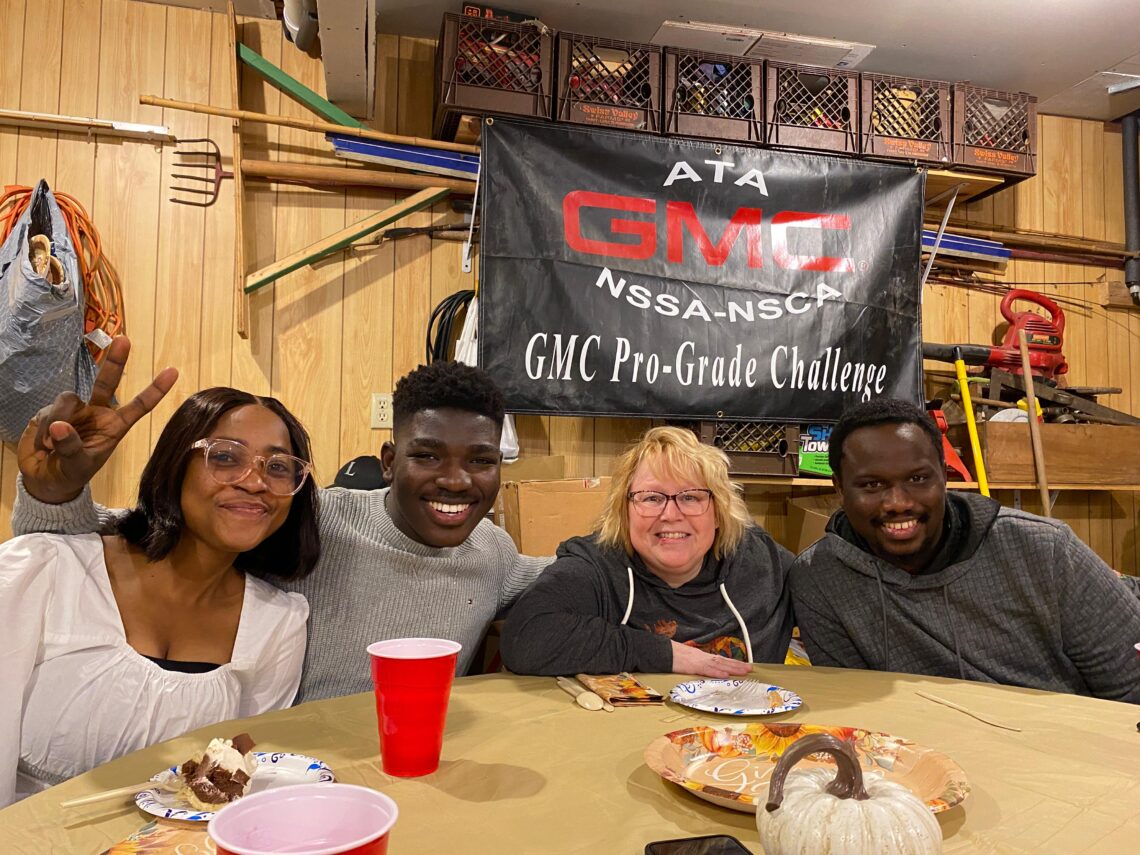
Thanksgiving, the grand celebration that unites families and friends across the United States, is not just about turkey and pies. Tt’s a time to reflect on gratitude and share the abundance of blessings. This year, on the 23rd of November, the vibrant Cedar Falls community embraced the true spirit of Thanksgiving by extending a warm welcome to international students at the University of Northern Iowa (UNI). In today’s article, we delve into the heartwarming story of how this close-knit community came together to create a memorable Thanksgiving for students from around the globe.
History of Thanksgiving
Thanksgiving as a national holiday in the United States was established by President Abraham Lincoln. On October 3, 1863, during the Civil War, Lincoln proclaimed Thanksgiving as a national holiday, setting the date as the final Thursday in November. Prior to this, Thanksgiving had been celebrated at various times and in different ways by individual states. Lincoln’s proclamation aimed to foster a sense of unity and gratitude during a challenging period in the nation’s history. Over time, Thanksgiving became a beloved and widely celebrated holiday, symbolizing a time for family, reflection, and expressions of gratitude.
The Essence of Thanksgiving in Cedar Falls
Thanksgiving, often celebrated as a feast with loved ones, took on a special meaning in Cedar Falls as the community opened its arms to those who might be far from home during this significant holiday. The warmth and hospitality extended by the Cedar Falls community created a sense of belonging for the international students, making them feel like they were part of a larger family. As the students expressed their gratitude for the experience, it became evident that Thanksgiving is not just about giving thanks for material possessions but also for the bonds formed and the connections forged.
Host families or conversation partners frequently pair up with UNI students, extending invitations for special events. These events provide international students with a glimpse into American culture. Today, I had the delightful opportunity to attend three Thanksgiving dinners. I am immensely grateful for the chance to experience the warmth of an American Traditional Thanksgiving dinner with these loving families.
Thanksgiving at Moonfire-Ridge at Professor Chris Schrage’s Acreage
In a thoughtful gesture, Professor Chris Schrage, the advisor of a student club, opened her home at the beautiful acreage in New Hartfield. Most of the club members and other students interested in celebrating a grand American Traditional Meal for lunch visited her. It’s truly remarkable to witness the compassion of Professor Schrage as she goes above and beyond to care for students who are far from their families, creating an environment that makes them feel at home.
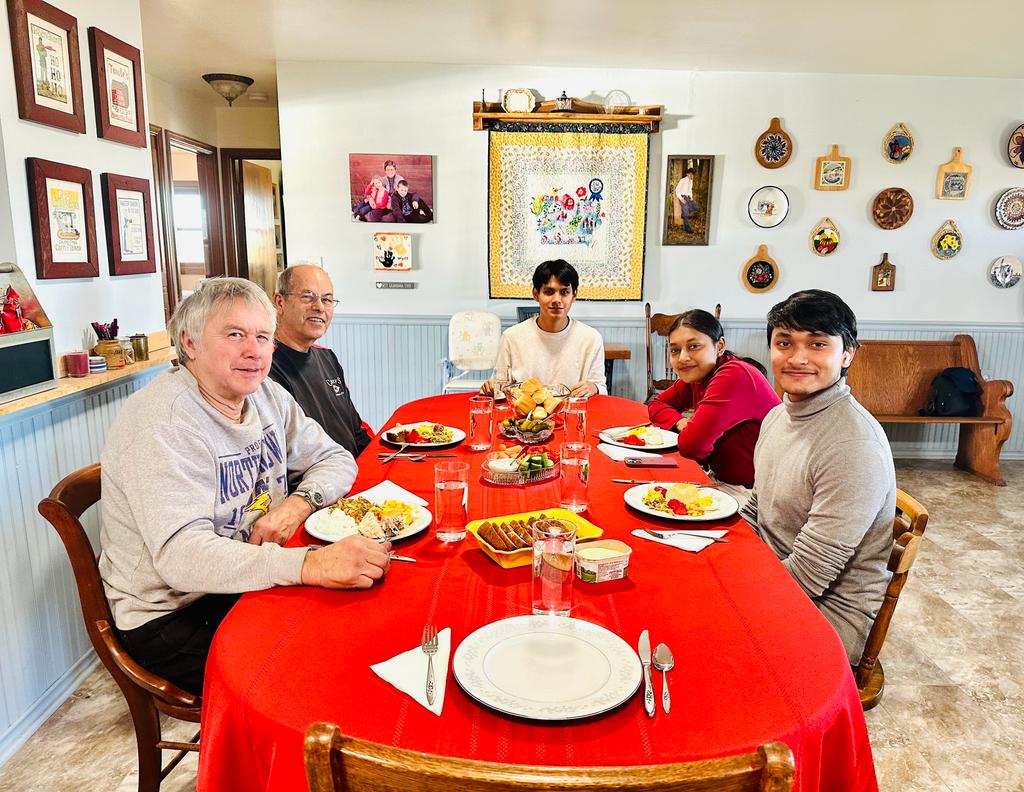
Our International Students, Nicolas from Peru, Karima, and Salman from Bangladesh, at Prof. Chris Schrage’s Thanksgiving Lunch
Thanksgiving with Mr. & Mrs. Tiemessen
I had the pleasure of attending Thanksgiving lunch at Mr. and Mrs. Tiemessen’s. It is a special occasion made even more exciting by the fact that my host family is none other than Mrs. Tiemessen’s daughter, Cassandra. It was incredibly sweet of her to extend an invitation to her beautiful parents home in New Hampton, just an hour’s drive from Cedar Falls. The road trip itself was a delight, passing by cornfields, horse stables, and picturesque countryside.
Upon arriving, we were warmly welcomed by Mrs. Linda Tiemessen and her loving family. The time spent there was filled with engaging conversations and the enjoyment of delicious food. Before indulging in the feast, we each shared one thing we were grateful for. Personally, I expressed my gratitude for my loving family back in Sri Lanka. And my second family here in Iowa—Cassandra and her parents, Mr. & Mrs. Tiemessen. Following this, we said the Lord’s prayer and commenced the delightful meal.
I couldn’t resist sharing a bit of my Sri Lankan cuisine. I contributed fried rice and a cream caramel, adding a taste of my culture to the Thanksgiving table. Mrs. Tiemessen, an experienced host to many international students over the years, shared captivating stories of her diverse experiences and connections. It was truly fascinating to hear about her interactions with students from around the world. And it’s evident why she’s renowned as an amazing host mom. The day was a testament to the Tiemessen family’s hospitality, creating lasting memories of warmth and camaraderie during this Thanksgiving celebration.

With my Amazing Host Family: Mrs. Linda Tiemessen, Mr. Tiemessen and Cassandra
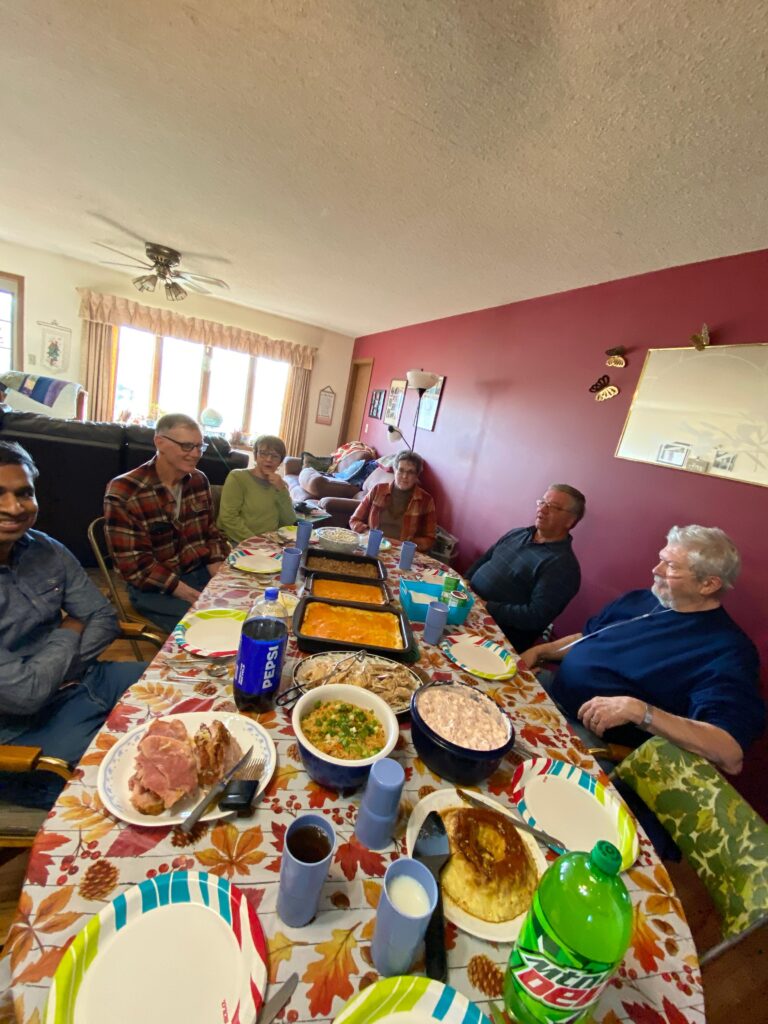
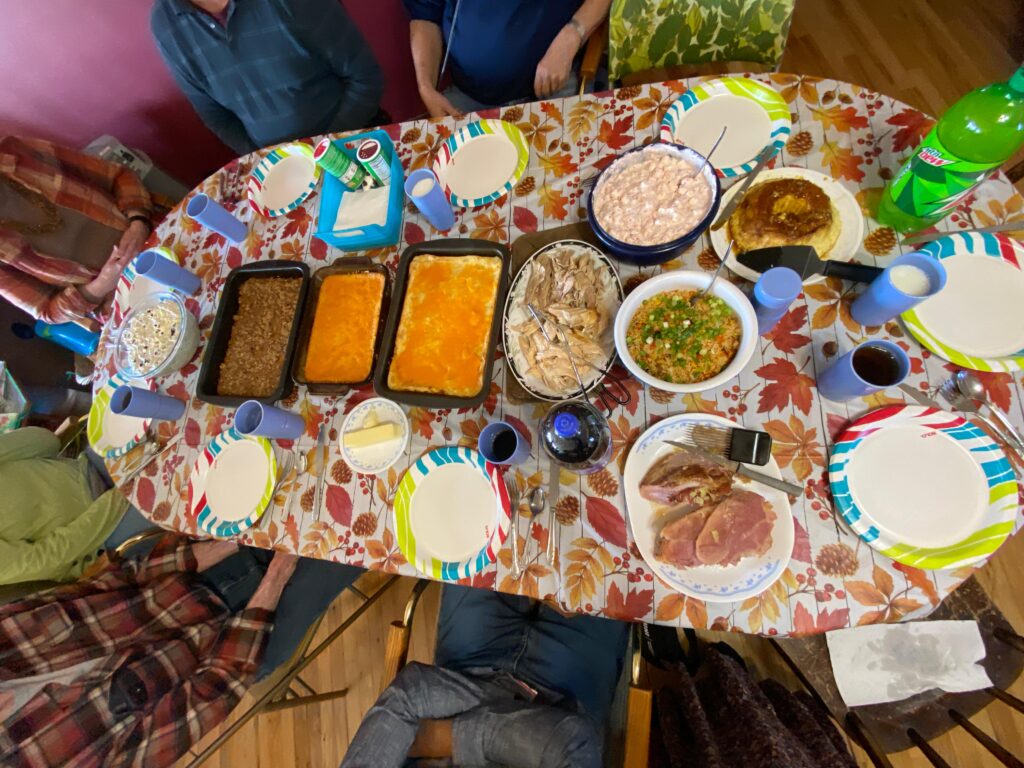
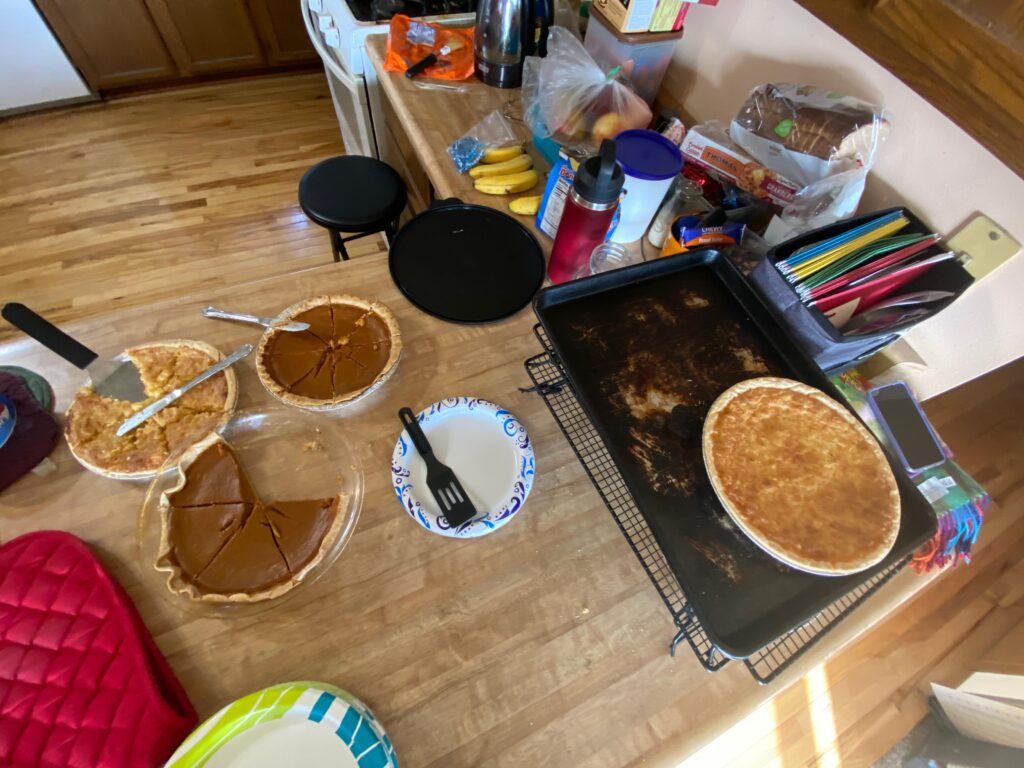
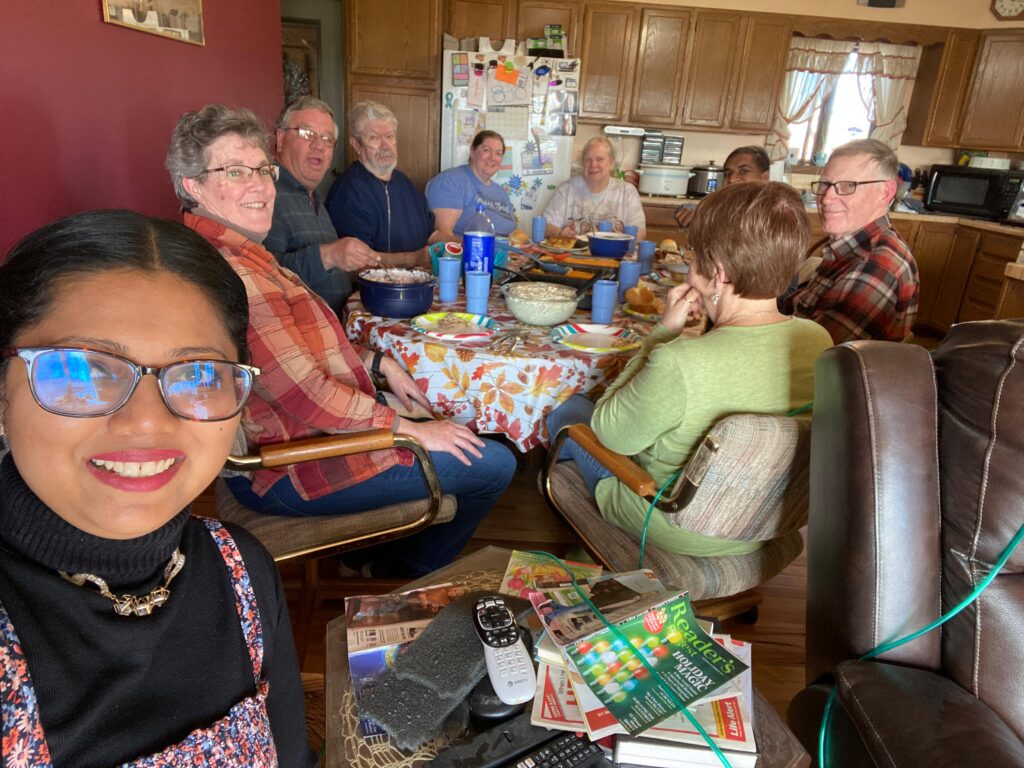 Feeling truly blessed to be a part of Thanksgiving with them
Feeling truly blessed to be a part of Thanksgiving with them
Thanksgiving with Mr. & Mrs. Luck
I experienced the thrill of receiving an invitation to Mr. and Mrs. Luck’s Thanksgiving Dinner. A joy that only matched being in the company of Carla, the exceptional graduate student counselor at UNI International Admissions at the University of Northern Iowa and a dear friend of mine. Despite a late start on the drive, the happiness of reuniting with friends at Carla’s Thanksgiving celebration overshadowed any sense of time.
The Luck family, including Carla, Clyde, and their sons and daughters-in-law—Chad & Ashley and Conor & Taylor—opened their home with open arms, extending a warm welcome to all international students. Carla’s generosity and hospitality shone through, creating an atmosphere of gratitude and camaraderie. It’s evident that her big heart has left a lasting impression on the international student community. Carla is a beloved figure among all who have had the pleasure of knowing her. The evening was a testament to the power of connection and the warmth that can be found in shared moments of celebration.
 Taylor, George, Yohan and Conor
Taylor, George, Yohan and Conor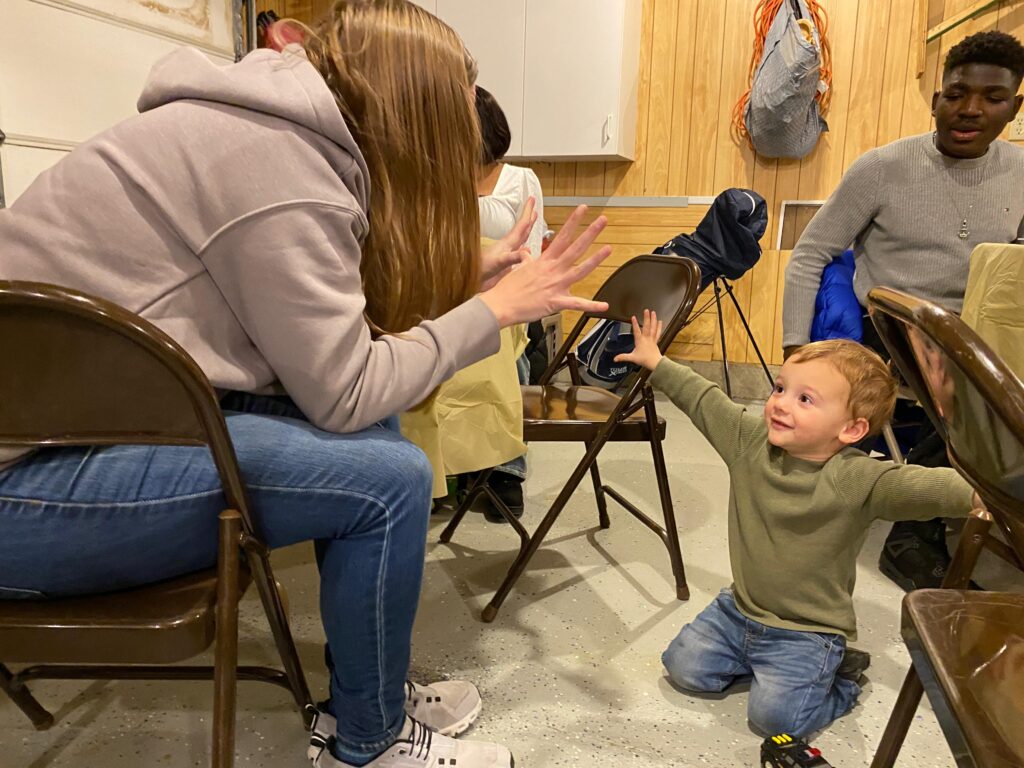 Theo being playful and too cute!
Theo being playful and too cute!
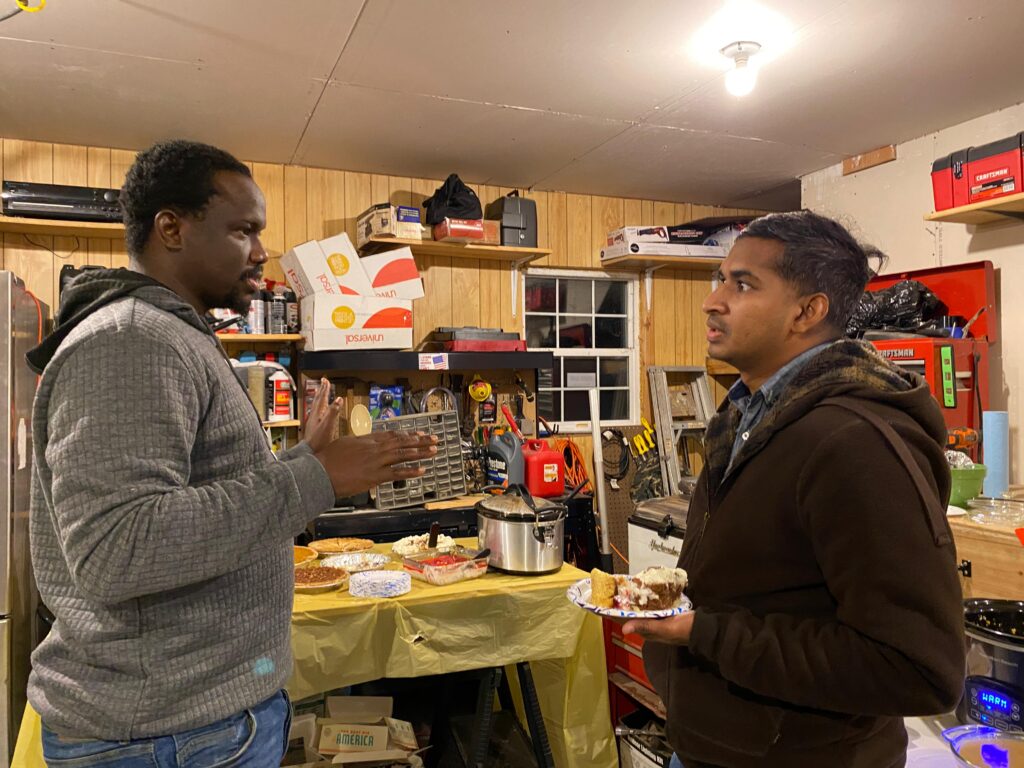
Everyone had a good time!
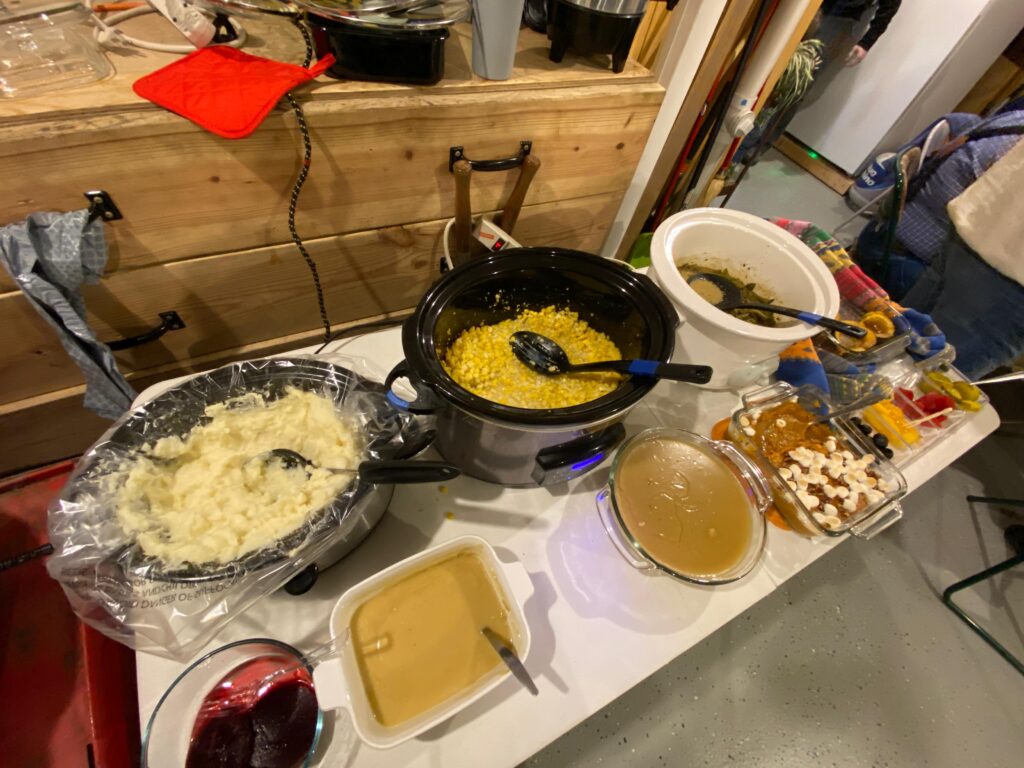
A Traditional American Thanksgiving Feast
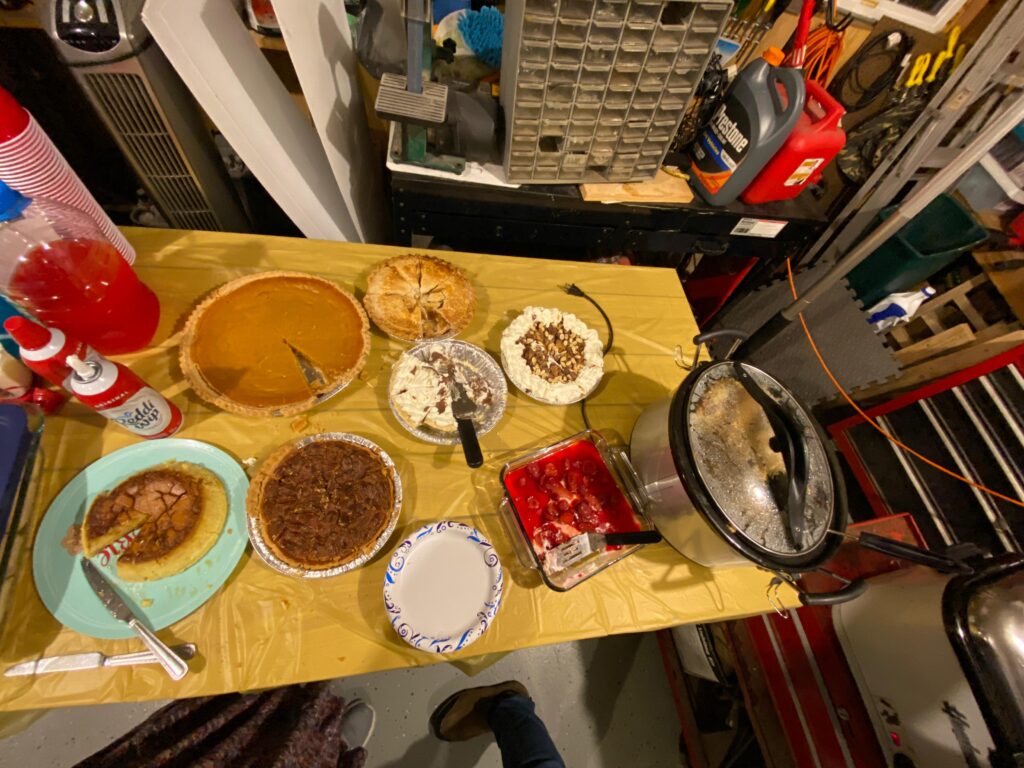
More pies of various kinds
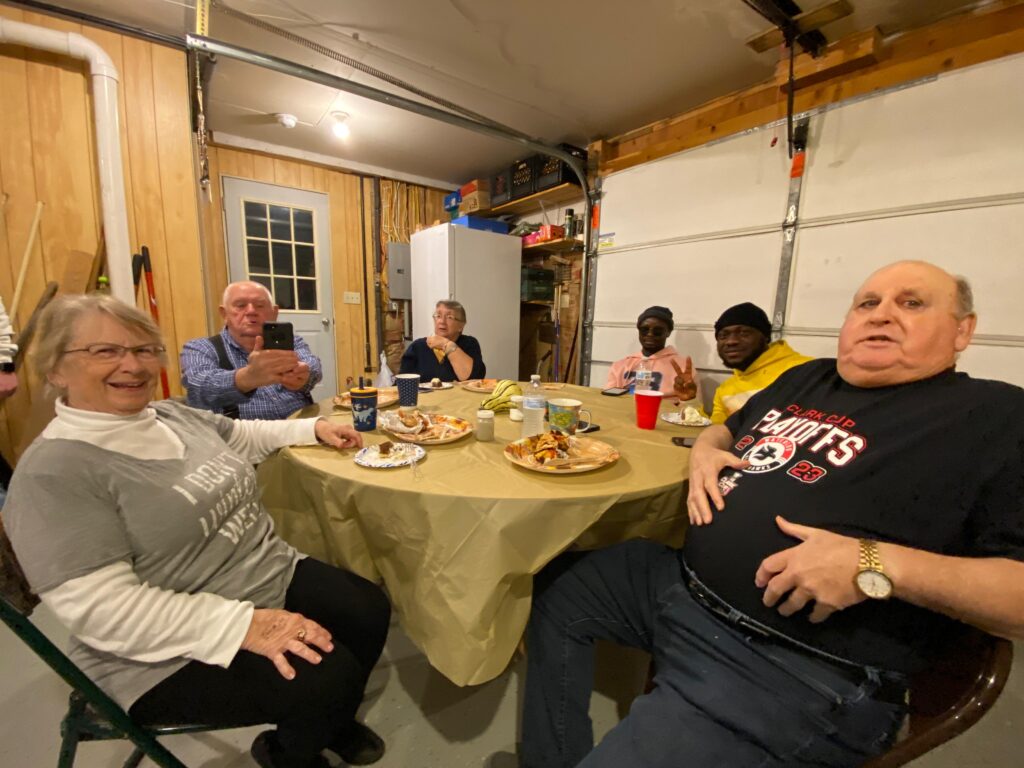
Carla’s Mom Susan and their family & friends with International students
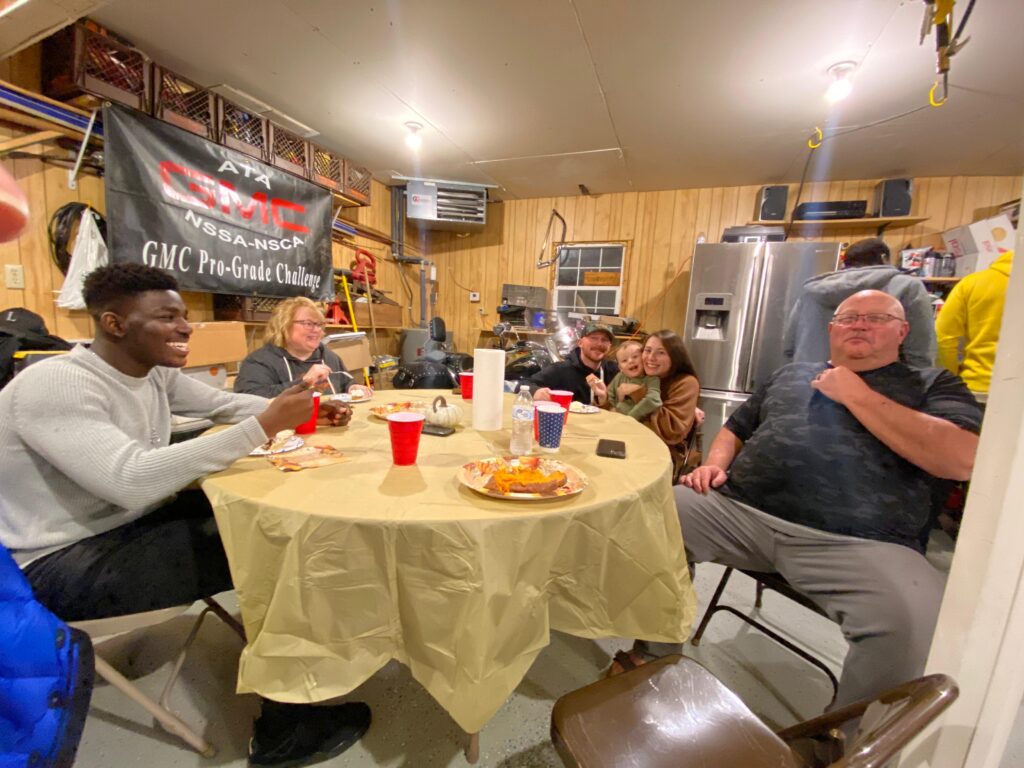
The amazing Hosts: Carla, Chad, Ashley, Theo, and Clyde with International Student Nathaniel
Thanksgiving Hosted by the Office of International Engagement
The Office of International Engagement hosted a heartwarming Thanksgiving Dinner on November 16th, bringing together a diverse community to celebrate the spirit of gratitude. Amidst the festivities, I had the privilege of extending an invitation to someone special. She is Ms. Sue Green, a retired math teacher and a beloved friend from Cedar Falls. Ms. Green holds a special place in my heart as during the summer, she generously shared her time, taking me to various events in Downtown Cedar Falls, creating cherished memories. Not only has she been a guide through the city’s activities. She’s also been a supportive friend, assisting in my language improvement journey. Inviting her to Thanksgiving was my way of expressing gratitude and celebrating her as more than just a friend but a cherished part of my Cedar Falls experience.
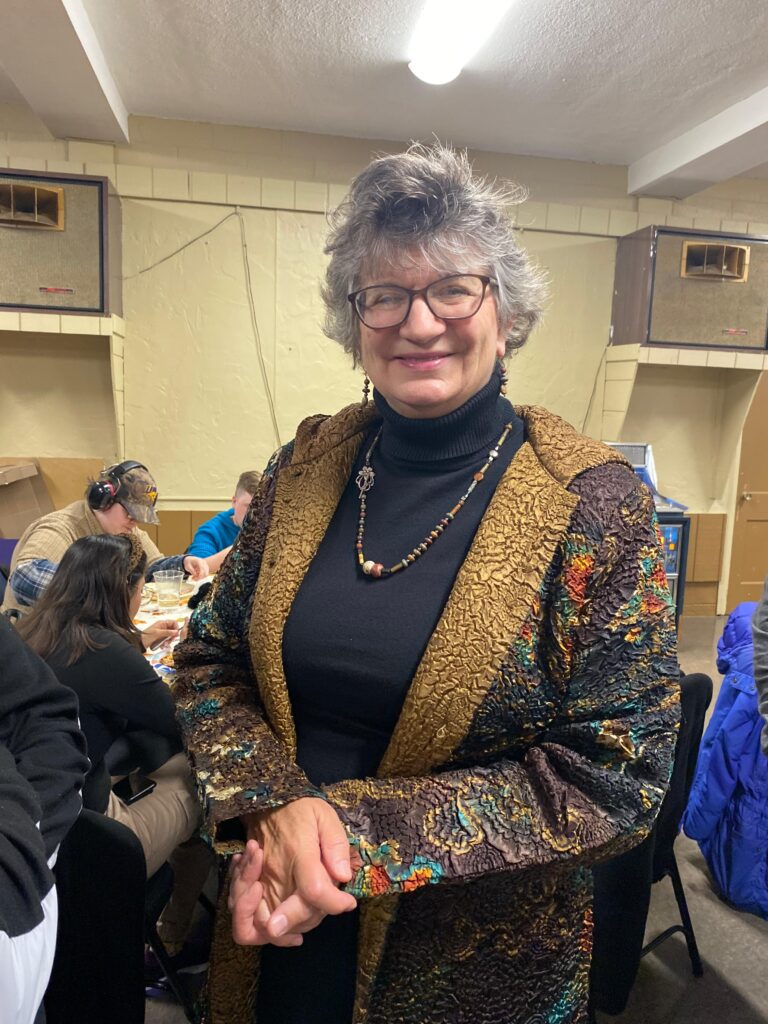
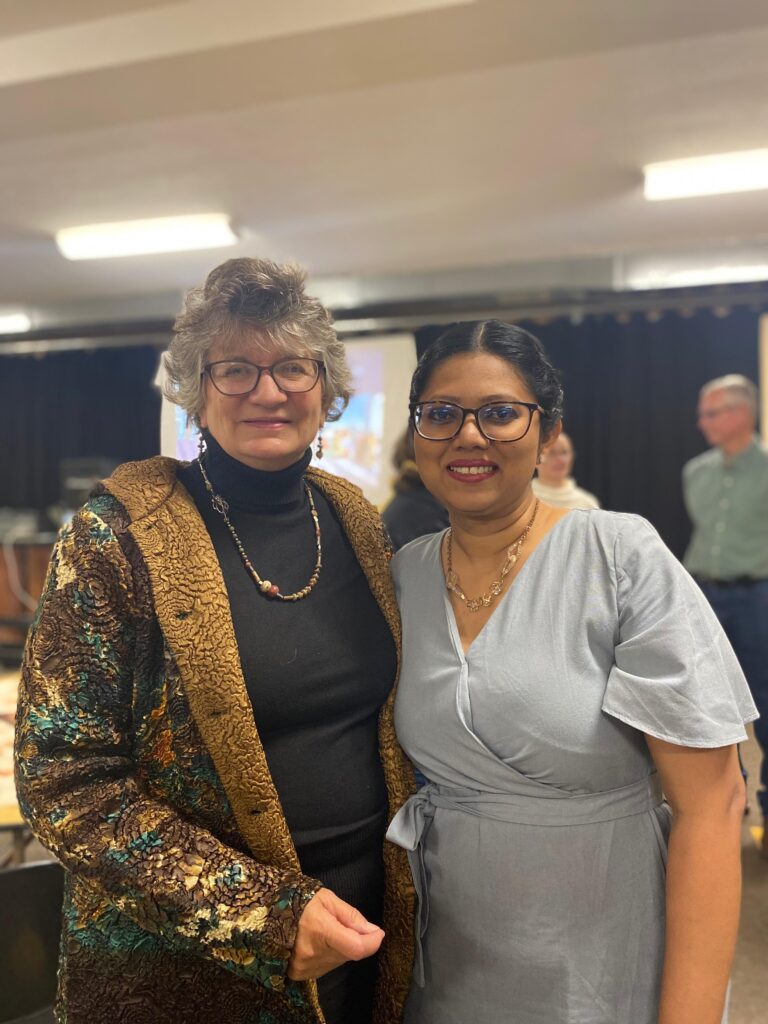
I am very grateful and blessed to know Ms. Sue Green
Thanksgiving is more than just a day marked by feasting. It is a celebration that beckons us to reflect on the values that make it truly special. As we gather with loved ones, whether family, friends, or newfound acquaintances, the essence of Thanksgiving becomes a tapestry woven with threads of joy, diversity, and unity.
Check out ‘How Host Families Enrich the Lives of International Students’ and join the adventure!

Thanksgiving, the grand celebration that unites families and friends across the United States, is not just about turkey and pies. Tt’s a time to reflect on gratitude and share the abundance of blessings. This year, on the 23rd of November, the vibrant Cedar Falls community embraced the true spirit of Thanksgiving by extending a warm welcome to international students at the University of Northern Iowa (UNI). In today’s article, we delve into the heartwarming story of how this close-knit community came together to create a memorable Thanksgiving for students from around the globe.
History of Thanksgiving
Thanksgiving as a national holiday in the United States was established by President Abraham Lincoln. On October 3, 1863, during the Civil War, Lincoln proclaimed Thanksgiving as a national holiday, setting the date as the final Thursday in November. Prior to this, Thanksgiving had been celebrated at various times and in different ways by individual states. Lincoln’s proclamation aimed to foster a sense of unity and gratitude during a challenging period in the nation’s history. Over time, Thanksgiving became a beloved and widely celebrated holiday, symbolizing a time for family, reflection, and expressions of gratitude.
The Essence of Thanksgiving in Cedar Falls
Thanksgiving, often celebrated as a feast with loved ones, took on a special meaning in Cedar Falls as the community opened its arms to those who might be far from home during this significant holiday. The warmth and hospitality extended by the Cedar Falls community created a sense of belonging for the international students, making them feel like they were part of a larger family. As the students expressed their gratitude for the experience, it became evident that Thanksgiving is not just about giving thanks for material possessions but also for the bonds formed and the connections forged.
Host families or conversation partners frequently pair up with UNI students, extending invitations for special events. These events provide international students with a glimpse into American culture. Today, I had the delightful opportunity to attend three Thanksgiving dinners. I am immensely grateful for the chance to experience the warmth of an American Traditional Thanksgiving dinner with these loving families.
Thanksgiving at Moonfire-Ridge at Professor Chris Schrage’s Acreage
In a thoughtful gesture, Professor Chris Schrage, the advisor of a student club, opened her home at the beautiful acreage in New Hartfield. Most of the club members and other students interested in celebrating a grand American Traditional Meal for lunch visited her. It’s truly remarkable to witness the compassion of Professor Schrage as she goes above and beyond to care for students who are far from their families, creating an environment that makes them feel at home.

Our International Students, Nicolas from Peru, Karima, and Salman from Bangladesh, at Prof. Chris Schrage’s Thanksgiving Lunch
Thanksgiving with Mr. & Mrs. Tiemessen
I had the pleasure of attending Thanksgiving lunch at Mr. and Mrs. Tiemessen’s. It is a special occasion made even more exciting by the fact that my host family is none other than Mrs. Tiemessen’s daughter, Cassandra. It was incredibly sweet of her to extend an invitation to her beautiful parents home in New Hampton, just an hour’s drive from Cedar Falls. The road trip itself was a delight, passing by cornfields, horse stables, and picturesque countryside.
Upon arriving, we were warmly welcomed by Mrs. Linda Tiemessen and her loving family. The time spent there was filled with engaging conversations and the enjoyment of delicious food. Before indulging in the feast, we each shared one thing we were grateful for. Personally, I expressed my gratitude for my loving family back in Sri Lanka. And my second family here in Iowa—Cassandra and her parents, Mr. & Mrs. Tiemessen. Following this, we said the Lord’s prayer and commenced the delightful meal.
I couldn’t resist sharing a bit of my Sri Lankan cuisine. I contributed fried rice and a cream caramel, adding a taste of my culture to the Thanksgiving table. Mrs. Tiemessen, an experienced host to many international students over the years, shared captivating stories of her diverse experiences and connections. It was truly fascinating to hear about her interactions with students from around the world. And it’s evident why she’s renowned as an amazing host mom. The day was a testament to the Tiemessen family’s hospitality, creating lasting memories of warmth and camaraderie during this Thanksgiving celebration.

With my Amazing Host Family: Mrs. Linda Tiemessen, Mr. Tiemessen and Cassandra



 Feeling truly blessed to be a part of Thanksgiving with them
Feeling truly blessed to be a part of Thanksgiving with them
Thanksgiving with Mr. & Mrs. Luck
I experienced the thrill of receiving an invitation to Mr. and Mrs. Luck’s Thanksgiving Dinner. A joy that only matched being in the company of Carla, the exceptional graduate student counselor at UNI International Admissions at the University of Northern Iowa and a dear friend of mine. Despite a late start on the drive, the happiness of reuniting with friends at Carla’s Thanksgiving celebration overshadowed any sense of time.
The Luck family, including Carla, Clyde, and their sons and daughters-in-law—Chad & Ashley and Conor & Taylor—opened their home with open arms, extending a warm welcome to all international students. Carla’s generosity and hospitality shone through, creating an atmosphere of gratitude and camaraderie. It’s evident that her big heart has left a lasting impression on the international student community. Carla is a beloved figure among all who have had the pleasure of knowing her. The evening was a testament to the power of connection and the warmth that can be found in shared moments of celebration.
 Taylor, George, Yohan and Conor
Taylor, George, Yohan and Conor Theo being playful and too cute!
Theo being playful and too cute!

Everyone had a good time!

A Traditional American Thanksgiving Feast

More pies of various kinds

Carla’s Mom Susan and their family & friends with International students

The amazing Hosts: Carla, Chad, Ashley, Theo, and Clyde with International Student Nathaniel
Thanksgiving Hosted by the Office of International Engagement
The Office of International Engagement hosted a heartwarming Thanksgiving Dinner on November 16th, bringing together a diverse community to celebrate the spirit of gratitude. Amidst the festivities, I had the privilege of extending an invitation to someone special. She is Ms. Sue Green, a retired math teacher and a beloved friend from Cedar Falls. Ms. Green holds a special place in my heart as during the summer, she generously shared her time, taking me to various events in Downtown Cedar Falls, creating cherished memories. Not only has she been a guide through the city’s activities. She’s also been a supportive friend, assisting in my language improvement journey. Inviting her to Thanksgiving was my way of expressing gratitude and celebrating her as more than just a friend but a cherished part of my Cedar Falls experience.


I am very grateful and blessed to know Ms. Sue Green
Thanksgiving is more than just a day marked by feasting. It is a celebration that beckons us to reflect on the values that make it truly special. As we gather with loved ones, whether family, friends, or newfound acquaintances, the essence of Thanksgiving becomes a tapestry woven with threads of joy, diversity, and unity.
Check out ‘How Host Families Enrich the Lives of International Students’ and join the adventure!
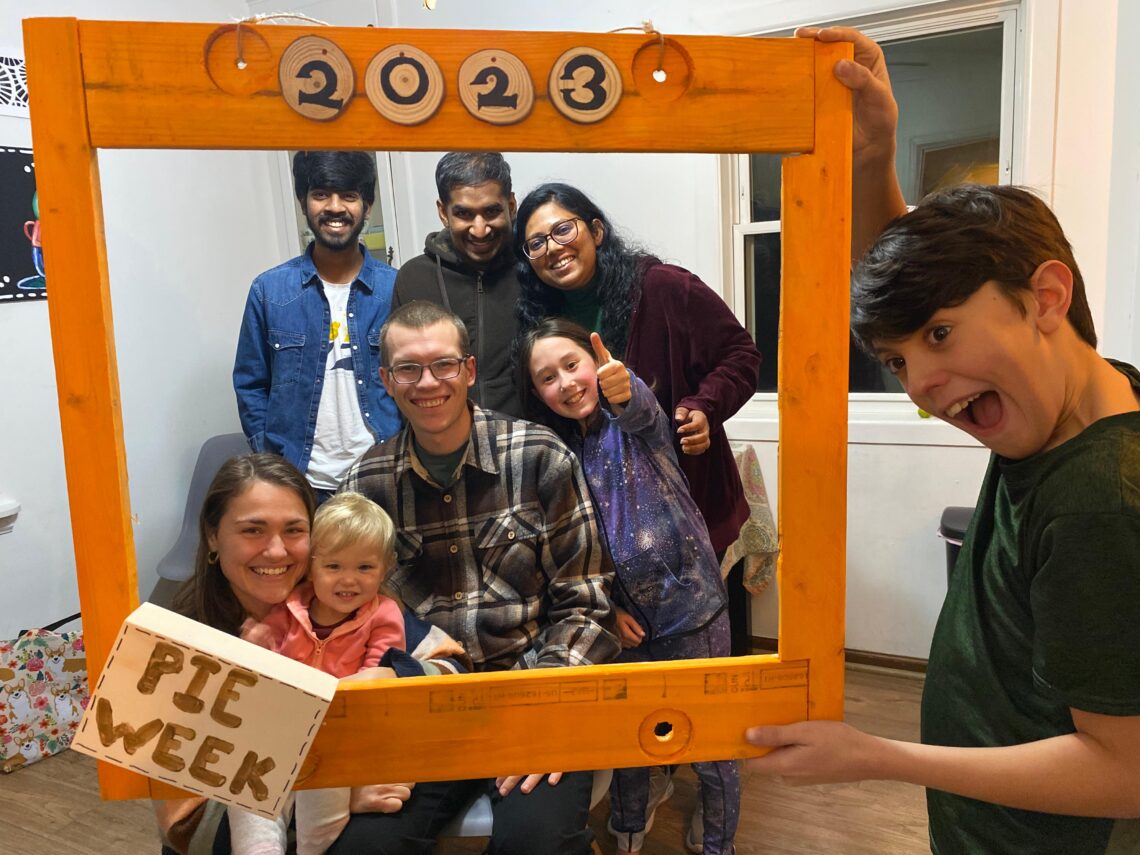
Host families play a pivotal role in shaping the transformative experience of international students. The exchange of customs, traditions, and daily life not only enriches the students’ understanding of the host country but also fosters deep connections that go beyond geographical borders. In this article, we explore how host families become catalysts for personal growth, cultural exchange, and lifelong connections, creating a home away from home for international students.
In the heart of Cedar Falls, where the cold winds may blow, the warmth of the community, embodied by hosts like Mr. & Mrs. Johnson, remains a constant flame. Their story is not just about hosting international students; it’s about building bridges, fostering friendships, and creating a home that stretches far beyond the physical walls—a home where everyone is not just welcome but embraced with open arms.
-Yohan Fernando, Sri Lanka
As the crisp autumn leaves make way for the chilly winds of winter, the Cedar Falls community stands as a beacon of warmth and hospitality for international students. Cedar Falls, nestled in the heart of Iowa, is not just a place on the map. It’s a community that takes pride in its inclusive nature and the genuine connections forged within its bounds. For international students, the transition to a new culture and environment can be both exciting and challenging. However, the residents of Cedar Falls, like Mr. & Mrs. Johnson, go above and beyond to make this transition seamless and memorable. Today, let’s delve into the heartwarming tale of one exceptional host family, Mr. & Mrs. Johnson, who embody the spirit of kindness and camaraderie.
Meet Avery and Lauren Johnson!
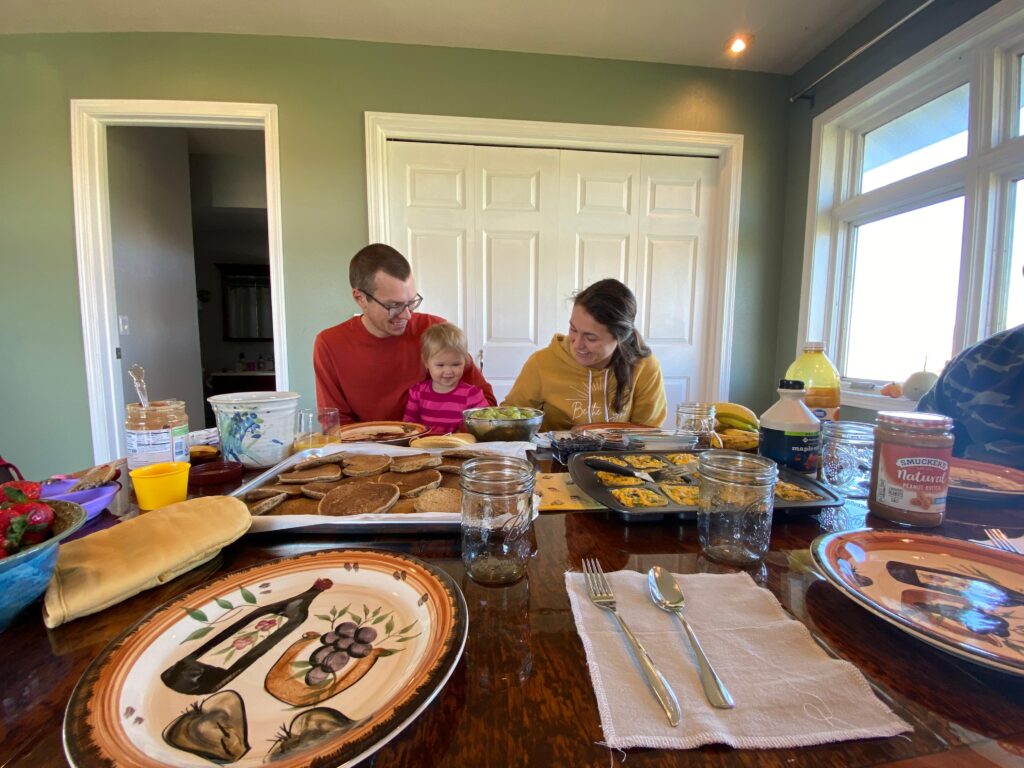
Avery and Lauren, designated as my spouse’s host family by the International Engagement Office, graciously extended their hospitality to include me as well. Our first encounter took place on Saturday, November 18, 2023, at their charming countryside residence in Cedar Falls. Avery is employed at the Admissions Office at University of Northern Iowa. His spouse Lauren, a dedicated homemaker, have a delightful daughter named Martha, a lively two year old who undoubtedly holds the title of the cutest little girl I’ve ever had the pleasure of meeting.
Invitation for Brunch
The Johnsons warmly invited us to brunch, where we were joined by our mutual friend Caleb, another resident and a cherished companion. The spread was delectable, featuring pancakes accompanied by fresh fruits and maple syrup, as well as Lauren’s delicious egg muffins and Cherry Pie for Dessert. It was my inaugural experience with egg muffins, and I must admit, they were exceptionally tasty—testament to Lauren’s culinary prowess. Her culinary skills not only lean towards the scrumptious but also encompass a dedication to crafting wholesome and nutritious meals, a quality that left me genuinely impressed.
Post-brunch, we embarked on a leisurely stroll around the picturesque surroundings. Our route included a visit to a charming bridge and a glimpse of a nearby train track, adding a touch of adventure to our day. Martha, the Johnsons’ spirited daughter, reveled in the outdoor experience, particularly enjoying throwing stones into a pond—a source of simple yet delightful amusement. As the day wound down, we returned home, having enjoyed a day filled with good company, delicious food, and the joy of discovering the natural beauty surrounding.

Pancakes, fresh fruits, egg muffins, and a delightful Cherry Pie
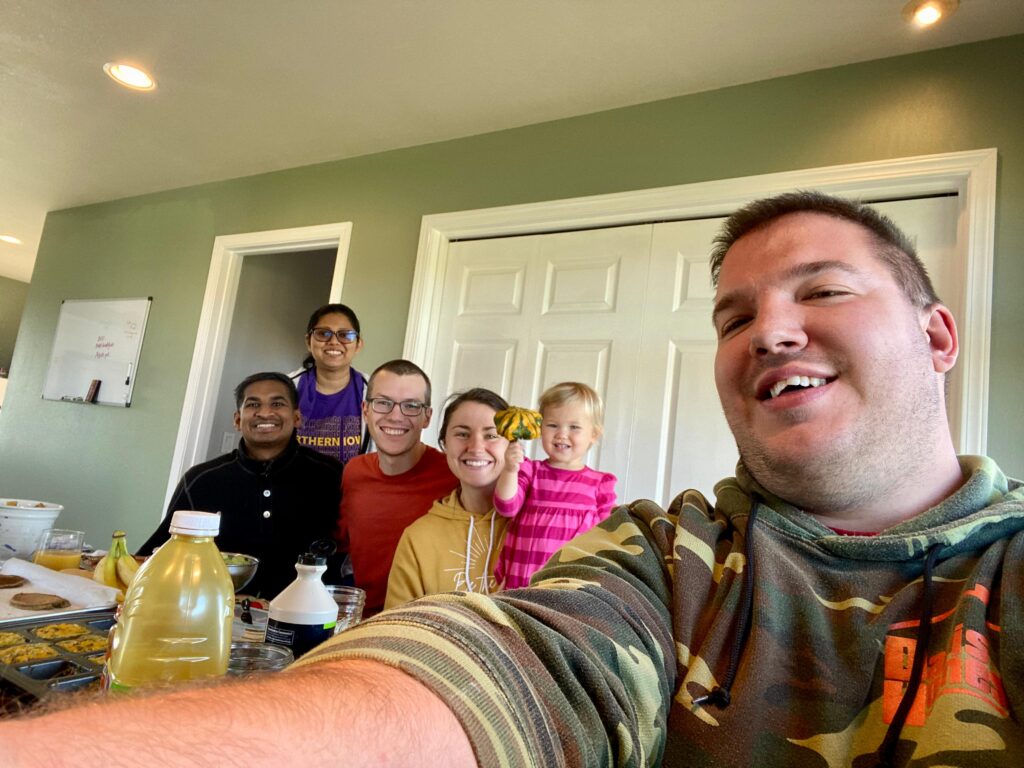
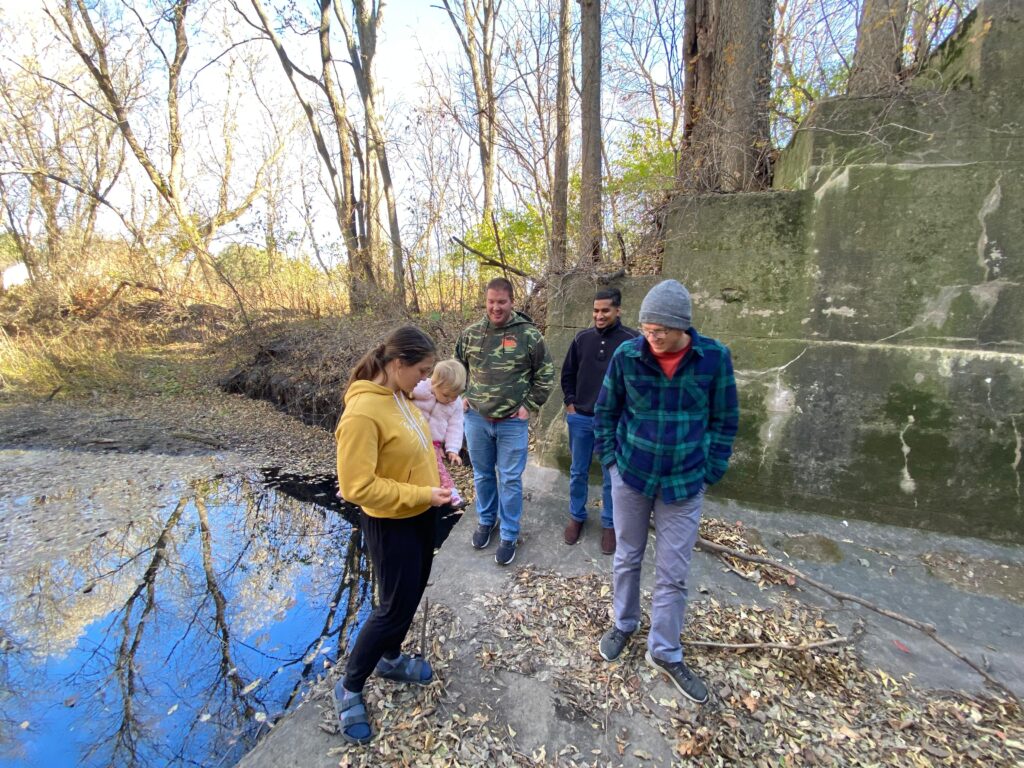
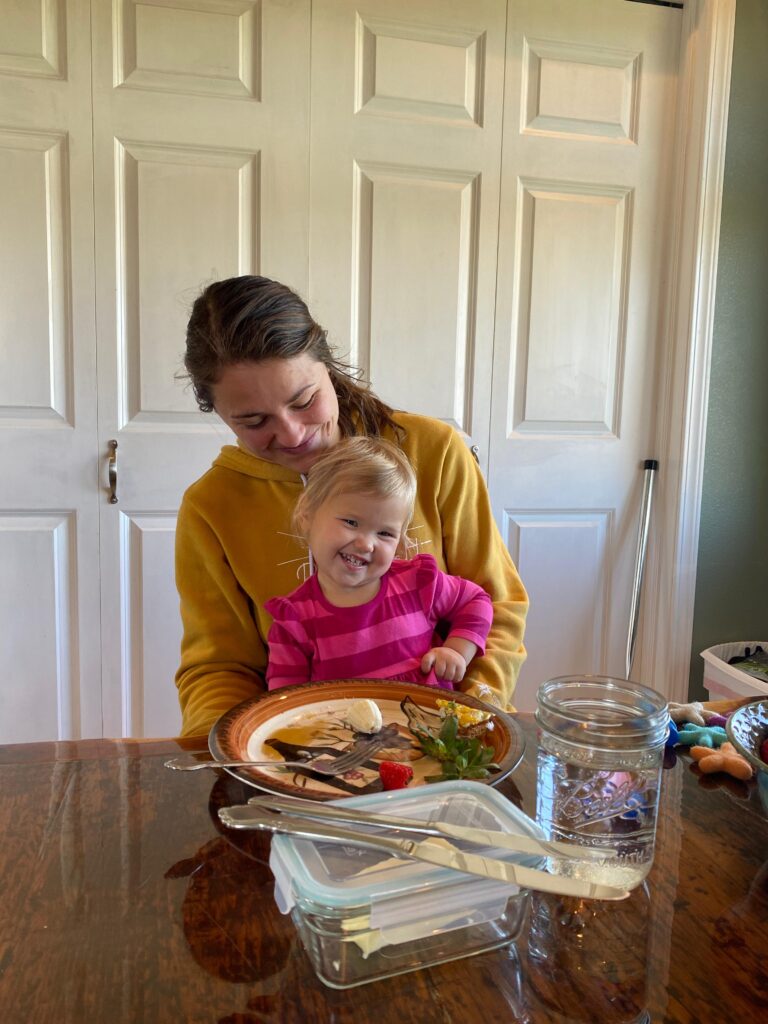
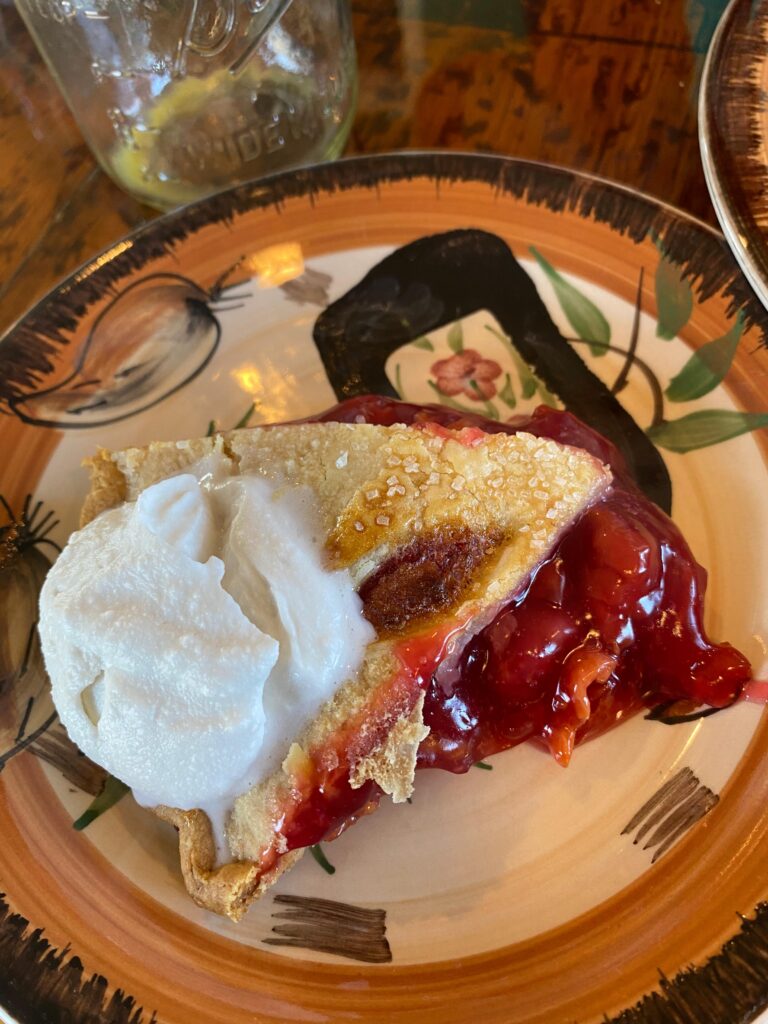

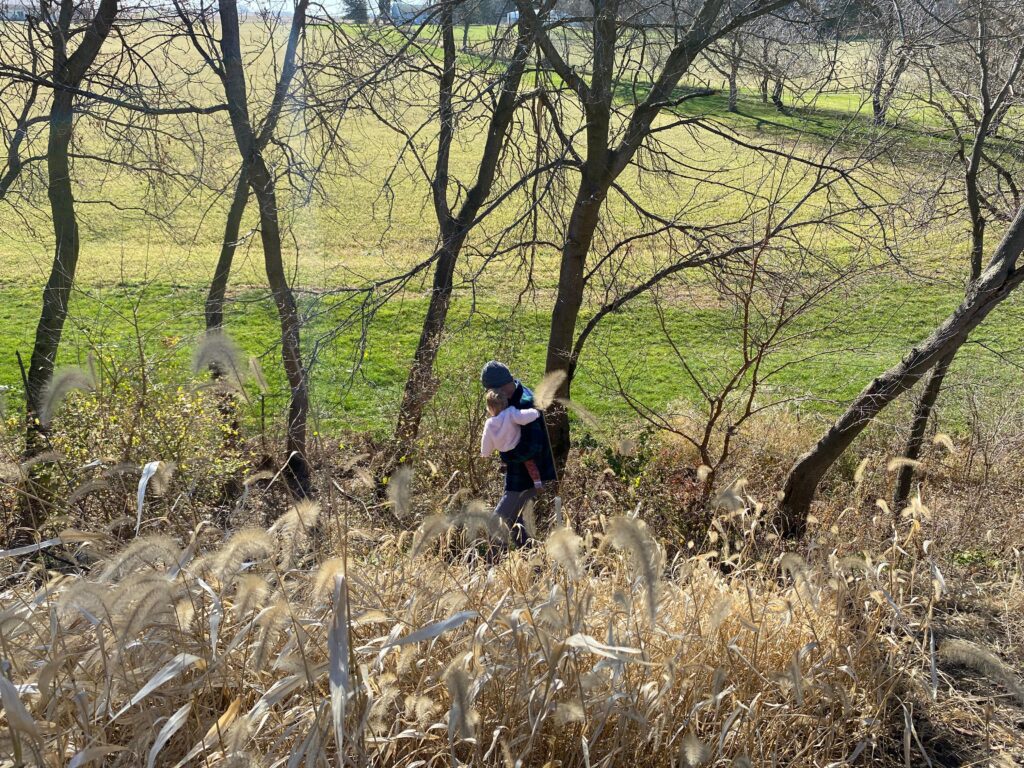
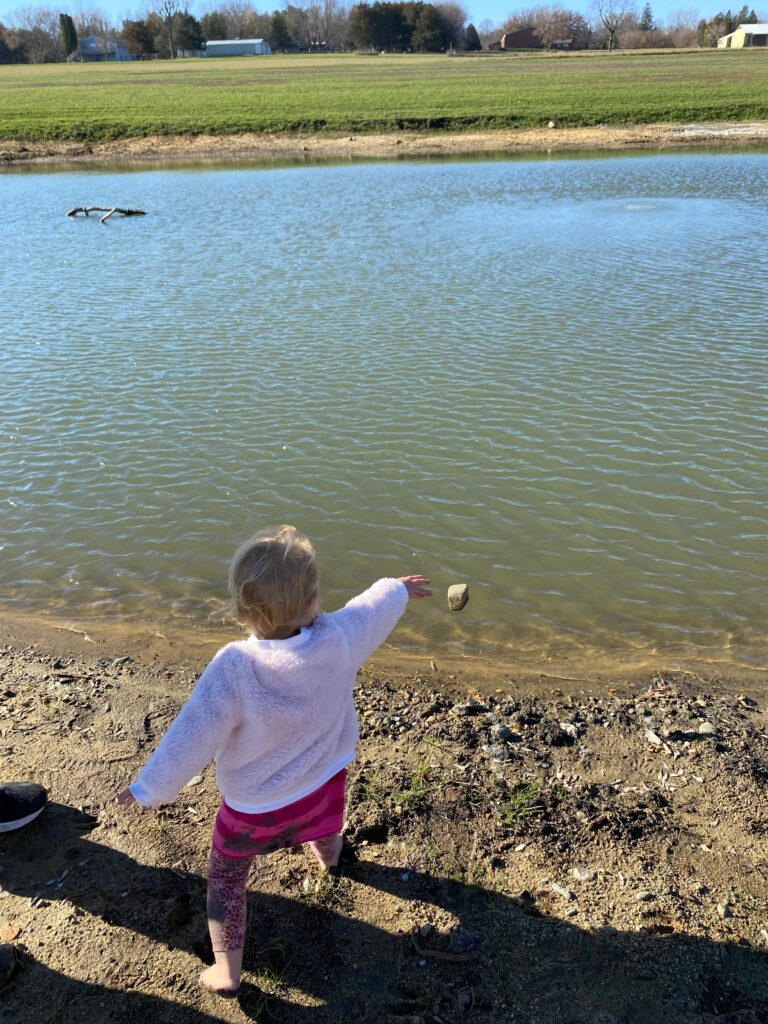
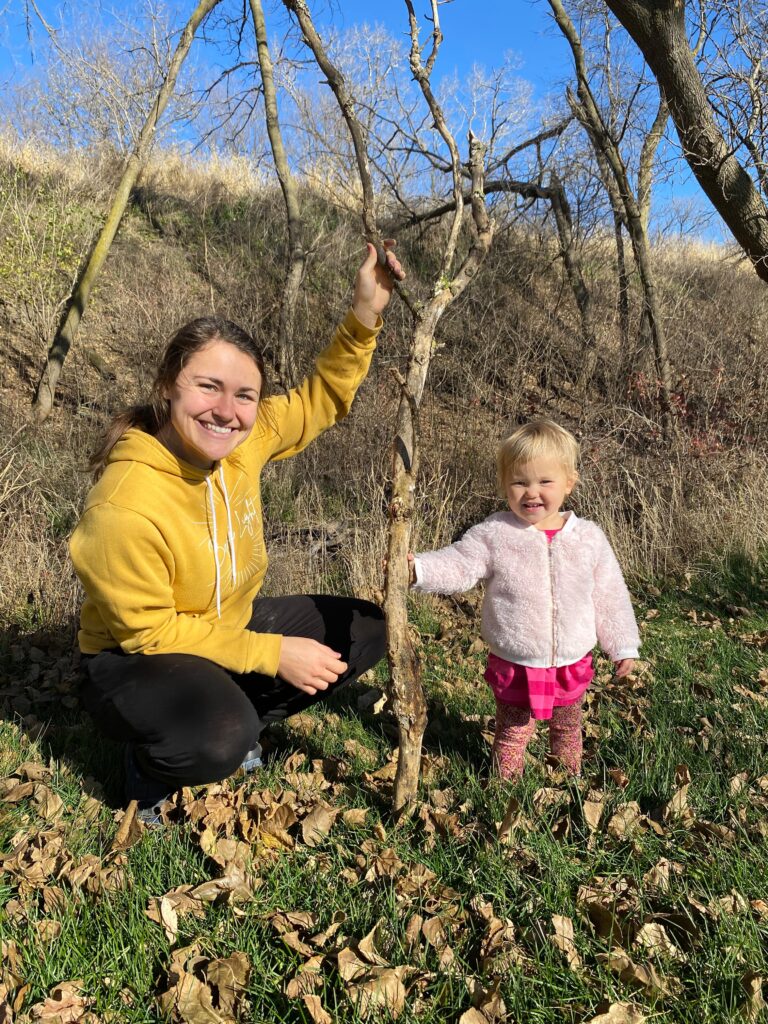


Invitation for a Pie Night
The Johnsons family extended yet another gracious invitation, this time for a delightful pie night within their small group. If you are not sure what a Pie Night is, click here to find some exciting information about its tradition . Thrilled by the prospect of learning the art of pie-making, I eagerly joined Lauren in her kitchen on Tuesday, November 21, 2023. While I was familiar with the concept of pies, my exposure to them had been limited in Sri Lanka, making this hands-on experience in the United States particularly exciting.
Baking Delicious Apple Pies & Jalapeño Cheddar Sourdough Bread
Under Lauren’s expert guidance, we embarked on creating an Apple Pie entirely from scratch. Lauren’s teaching prowess made the process seem surprisingly easy, and I relished both the learning experience and the engaging conversations that accompanied our baking endeavors. The end result was nothing short of fantastic, and I couldn’t help but marvel at how well the Apple Pie turned out. Lauren, not content with just pie-making, generously shared her expertise in crafting Jalapeño Cheddar Sourdough Bread—a revelation in freshness compared to store-bought alternatives. Her culinary skills, in my opinion, deserve a solid 5-star rating.
Getting ready for the Pie Night
The entire pie-making venture, from preparation to baking, took a couple of hours. Post our culinary exploits, we joined the small group gathering, where we were joined by Steve, another international student from India. The evening unfolded as an extraordinary experience, with a diverse array of savory and sweet pies on display. It was my first encounter with such a variety of pies, adding an extra layer of excitement to the evening. The ‘2023 Pie Week’ was undoubtedly the Pie Night photo op, capturing the joyous moments we shared.
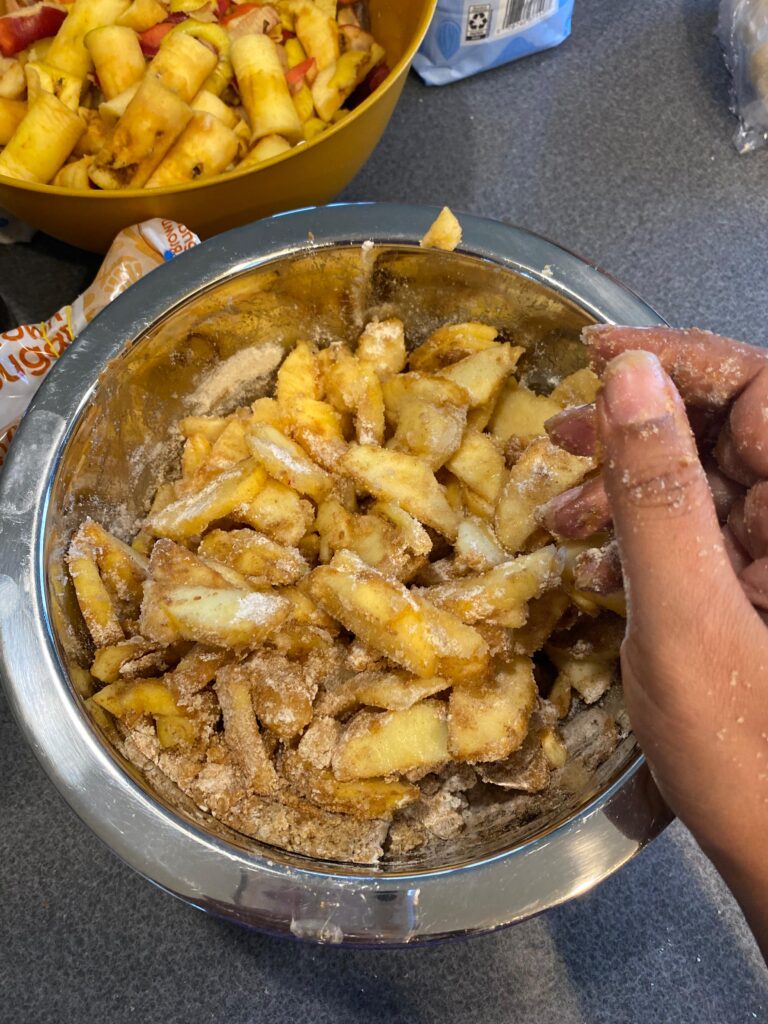

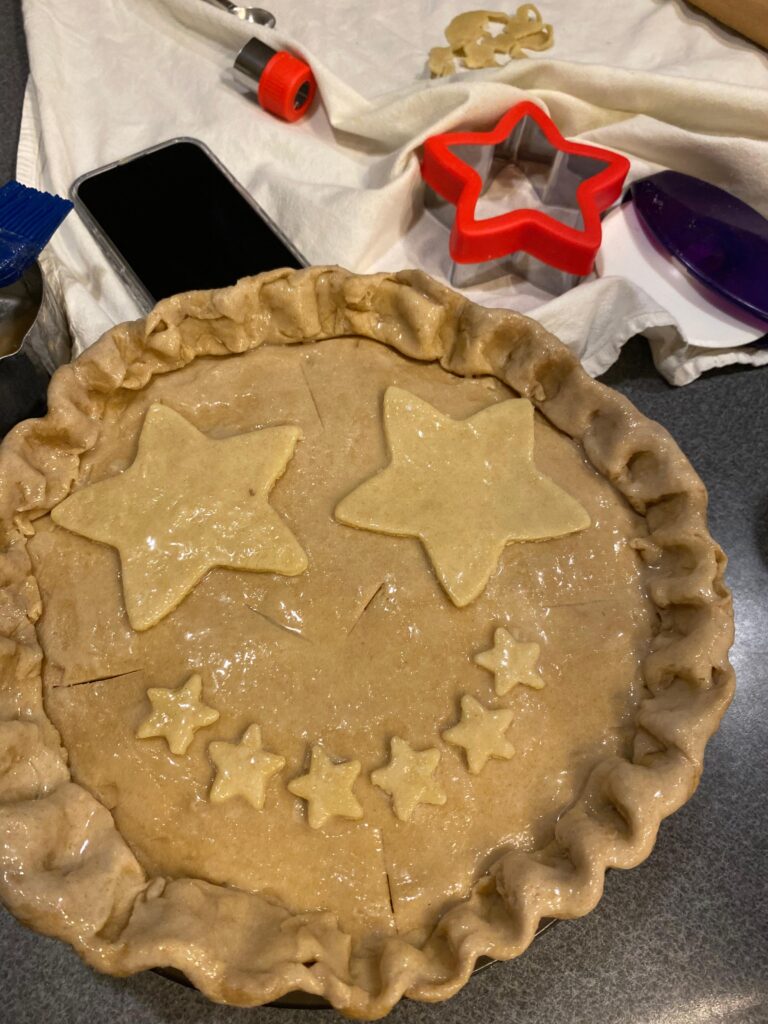
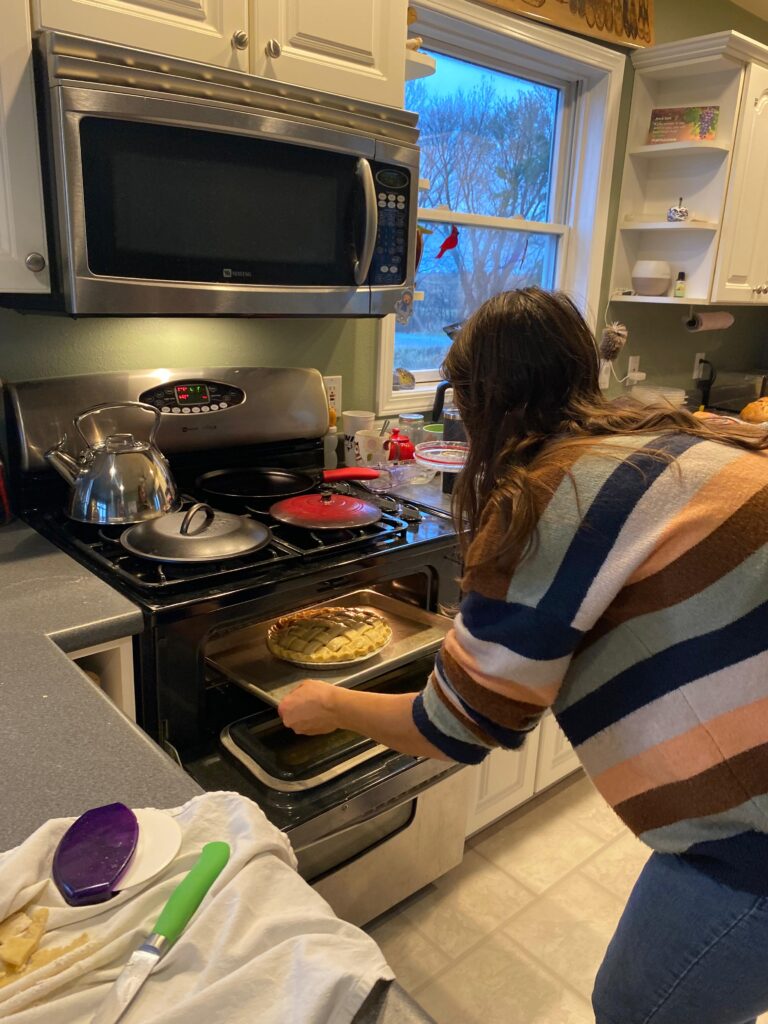
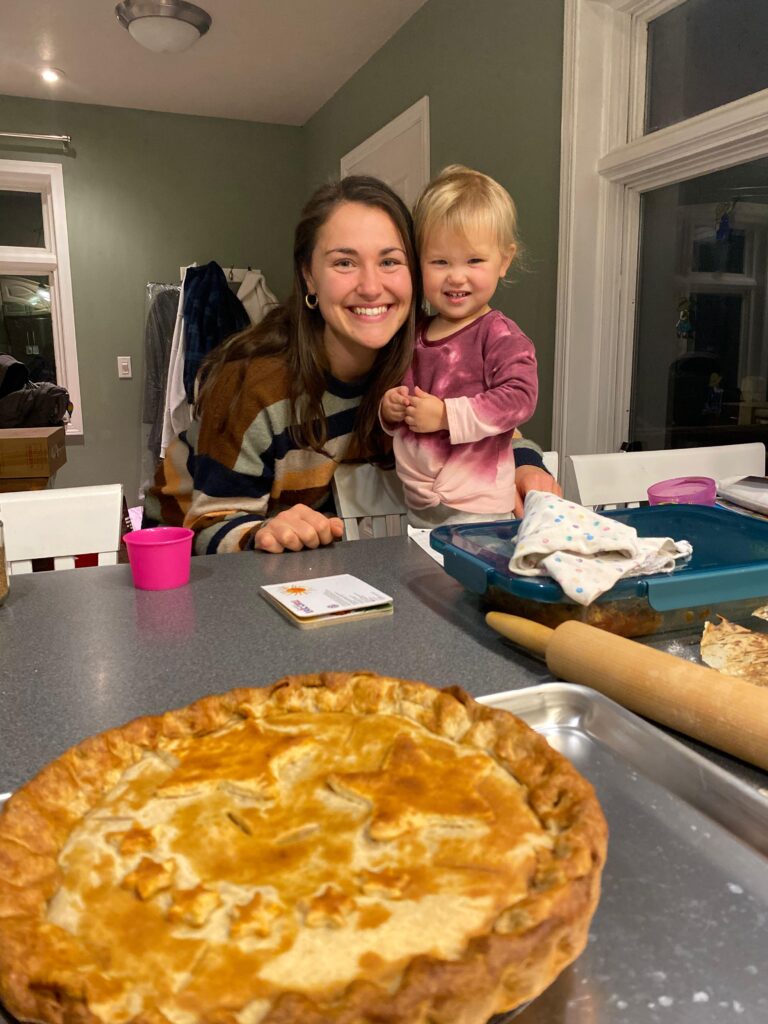
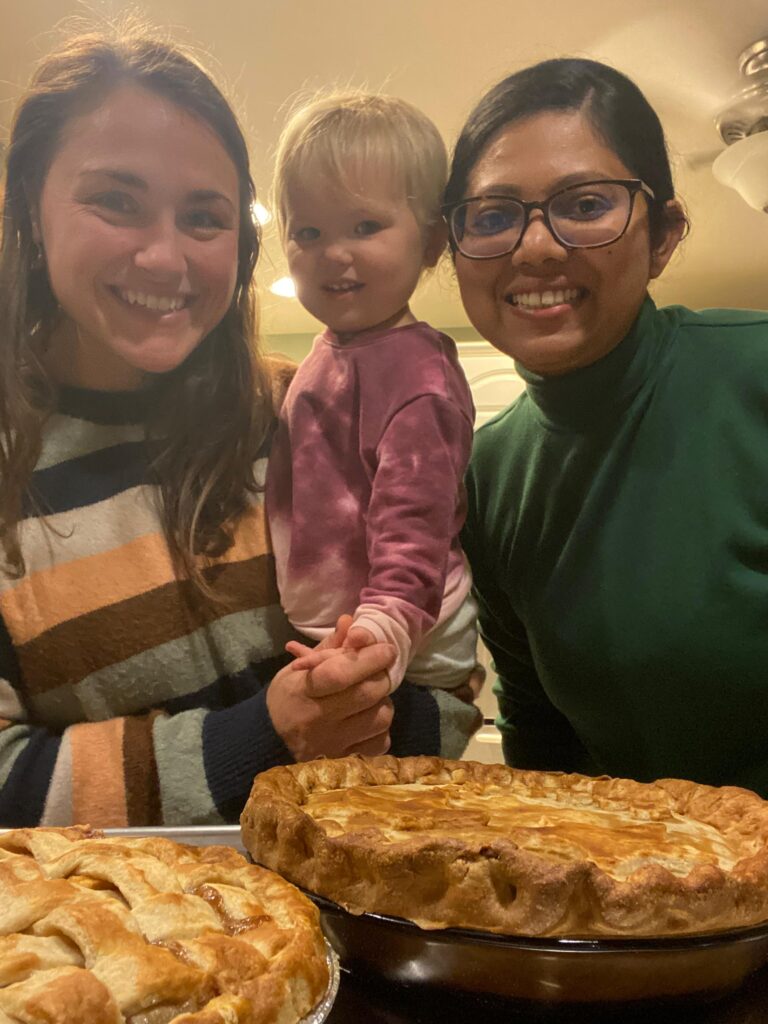
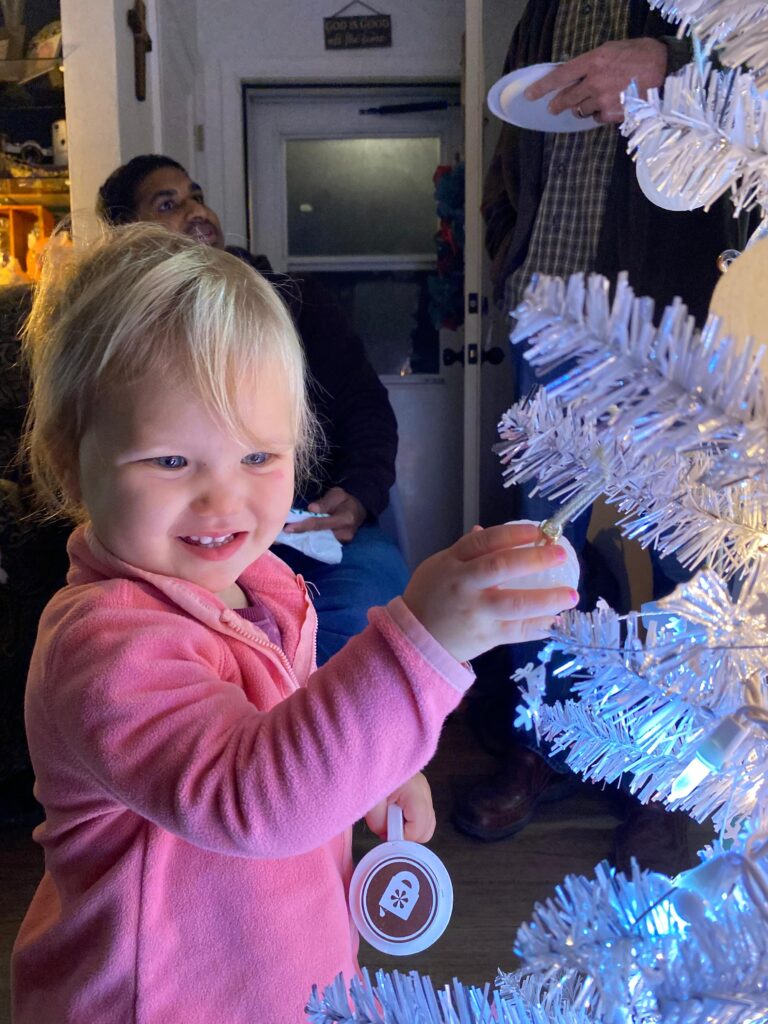
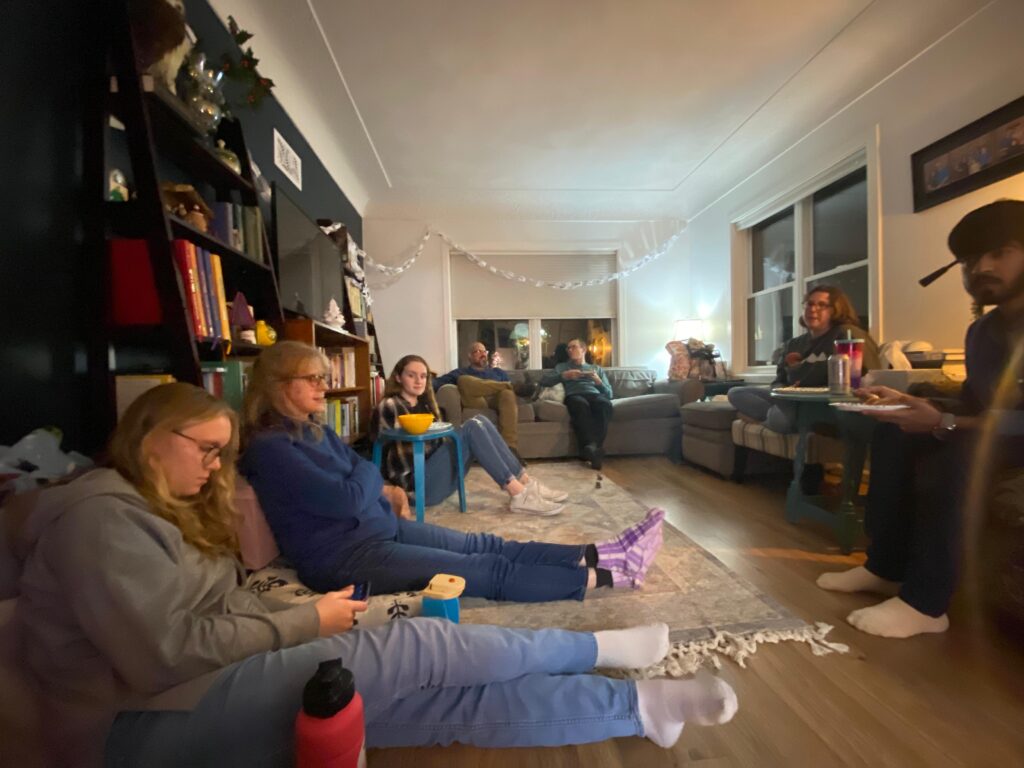
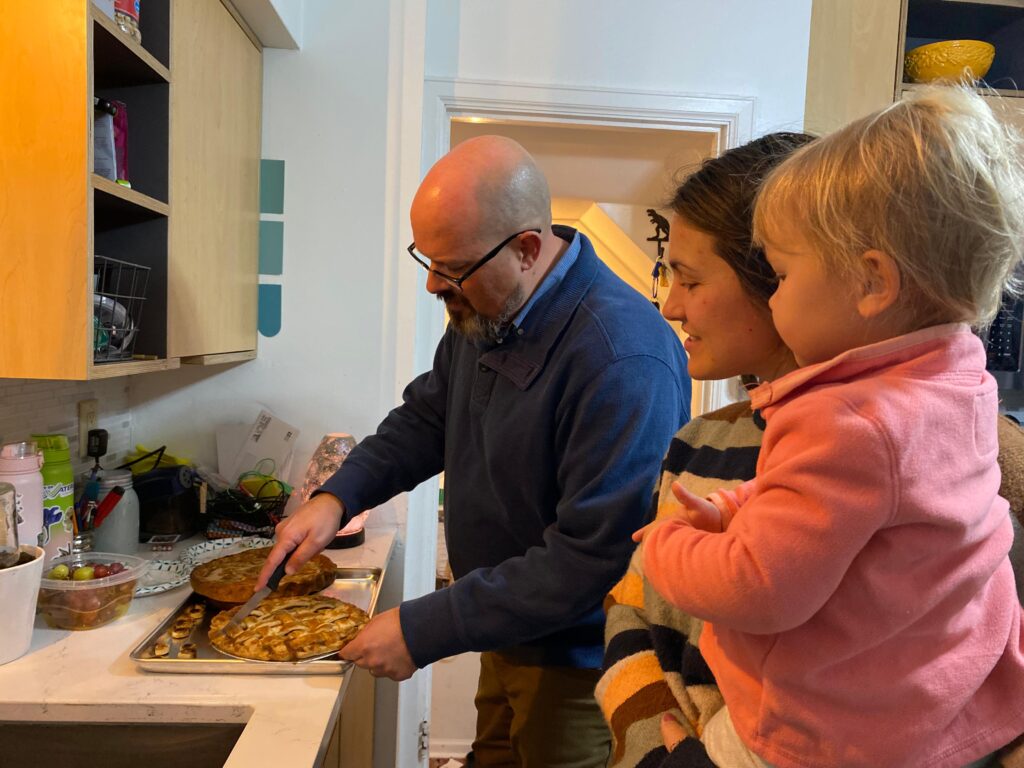

A delightful spread featuring pumpkin, cherry, pecan, blueberry, and some delicious mysteries waiting to be unraveled
Reflecting on our time with Avery and Lauren, I am immensely grateful for their warm welcome and hospitality. They go above and beyond to facilitate cultural exchange, offering international students like myself a window into American life. Their support and efforts contribute significantly to making our stay in the U.S. not only memorable but truly enriching.

Host families play a pivotal role in shaping the transformative experience of international students. The exchange of customs, traditions, and daily life not only enriches the students’ understanding of the host country but also fosters deep connections that go beyond geographical borders. In this article, we explore how host families become catalysts for personal growth, cultural exchange, and lifelong connections, creating a home away from home for international students.
In the heart of Cedar Falls, where the cold winds may blow, the warmth of the community, embodied by hosts like Mr. & Mrs. Johnson, remains a constant flame. Their story is not just about hosting international students; it’s about building bridges, fostering friendships, and creating a home that stretches far beyond the physical walls—a home where everyone is not just welcome but embraced with open arms.
-Yohan Fernando, Sri Lanka
As the crisp autumn leaves make way for the chilly winds of winter, the Cedar Falls community stands as a beacon of warmth and hospitality for international students. Cedar Falls, nestled in the heart of Iowa, is not just a place on the map. It’s a community that takes pride in its inclusive nature and the genuine connections forged within its bounds. For international students, the transition to a new culture and environment can be both exciting and challenging. However, the residents of Cedar Falls, like Mr. & Mrs. Johnson, go above and beyond to make this transition seamless and memorable. Today, let’s delve into the heartwarming tale of one exceptional host family, Mr. & Mrs. Johnson, who embody the spirit of kindness and camaraderie.
Meet Avery and Lauren Johnson!

Avery and Lauren, designated as my spouse’s host family by the International Engagement Office, graciously extended their hospitality to include me as well. Our first encounter took place on Saturday, November 18, 2023, at their charming countryside residence in Cedar Falls. Avery is employed at the Admissions Office at University of Northern Iowa. His spouse Lauren, a dedicated homemaker, have a delightful daughter named Martha, a lively two year old who undoubtedly holds the title of the cutest little girl I’ve ever had the pleasure of meeting.
Invitation for Brunch
The Johnsons warmly invited us to brunch, where we were joined by our mutual friend Caleb, another resident and a cherished companion. The spread was delectable, featuring pancakes accompanied by fresh fruits and maple syrup, as well as Lauren’s delicious egg muffins and Cherry Pie for Dessert. It was my inaugural experience with egg muffins, and I must admit, they were exceptionally tasty—testament to Lauren’s culinary prowess. Her culinary skills not only lean towards the scrumptious but also encompass a dedication to crafting wholesome and nutritious meals, a quality that left me genuinely impressed.
Post-brunch, we embarked on a leisurely stroll around the picturesque surroundings. Our route included a visit to a charming bridge and a glimpse of a nearby train track, adding a touch of adventure to our day. Martha, the Johnsons’ spirited daughter, reveled in the outdoor experience, particularly enjoying throwing stones into a pond—a source of simple yet delightful amusement. As the day wound down, we returned home, having enjoyed a day filled with good company, delicious food, and the joy of discovering the natural beauty surrounding.

Pancakes, fresh fruits, egg muffins, and a delightful Cherry Pie










Invitation for a Pie Night
The Johnsons family extended yet another gracious invitation, this time for a delightful pie night within their small group. If you are not sure what a Pie Night is, click here to find some exciting information about its tradition . Thrilled by the prospect of learning the art of pie-making, I eagerly joined Lauren in her kitchen on Tuesday, November 21, 2023. While I was familiar with the concept of pies, my exposure to them had been limited in Sri Lanka, making this hands-on experience in the United States particularly exciting.
Baking Delicious Apple Pies & Jalapeño Cheddar Sourdough Bread
Under Lauren’s expert guidance, we embarked on creating an Apple Pie entirely from scratch. Lauren’s teaching prowess made the process seem surprisingly easy, and I relished both the learning experience and the engaging conversations that accompanied our baking endeavors. The end result was nothing short of fantastic, and I couldn’t help but marvel at how well the Apple Pie turned out. Lauren, not content with just pie-making, generously shared her expertise in crafting Jalapeño Cheddar Sourdough Bread—a revelation in freshness compared to store-bought alternatives. Her culinary skills, in my opinion, deserve a solid 5-star rating.
Getting ready for the Pie Night
The entire pie-making venture, from preparation to baking, took a couple of hours. Post our culinary exploits, we joined the small group gathering, where we were joined by Steve, another international student from India. The evening unfolded as an extraordinary experience, with a diverse array of savory and sweet pies on display. It was my first encounter with such a variety of pies, adding an extra layer of excitement to the evening. The ‘2023 Pie Week’ was undoubtedly the Pie Night photo op, capturing the joyous moments we shared.










A delightful spread featuring pumpkin, cherry, pecan, blueberry, and some delicious mysteries waiting to be unraveled
Reflecting on our time with Avery and Lauren, I am immensely grateful for their warm welcome and hospitality. They go above and beyond to facilitate cultural exchange, offering international students like myself a window into American life. Their support and efforts contribute significantly to making our stay in the U.S. not only memorable but truly enriching.
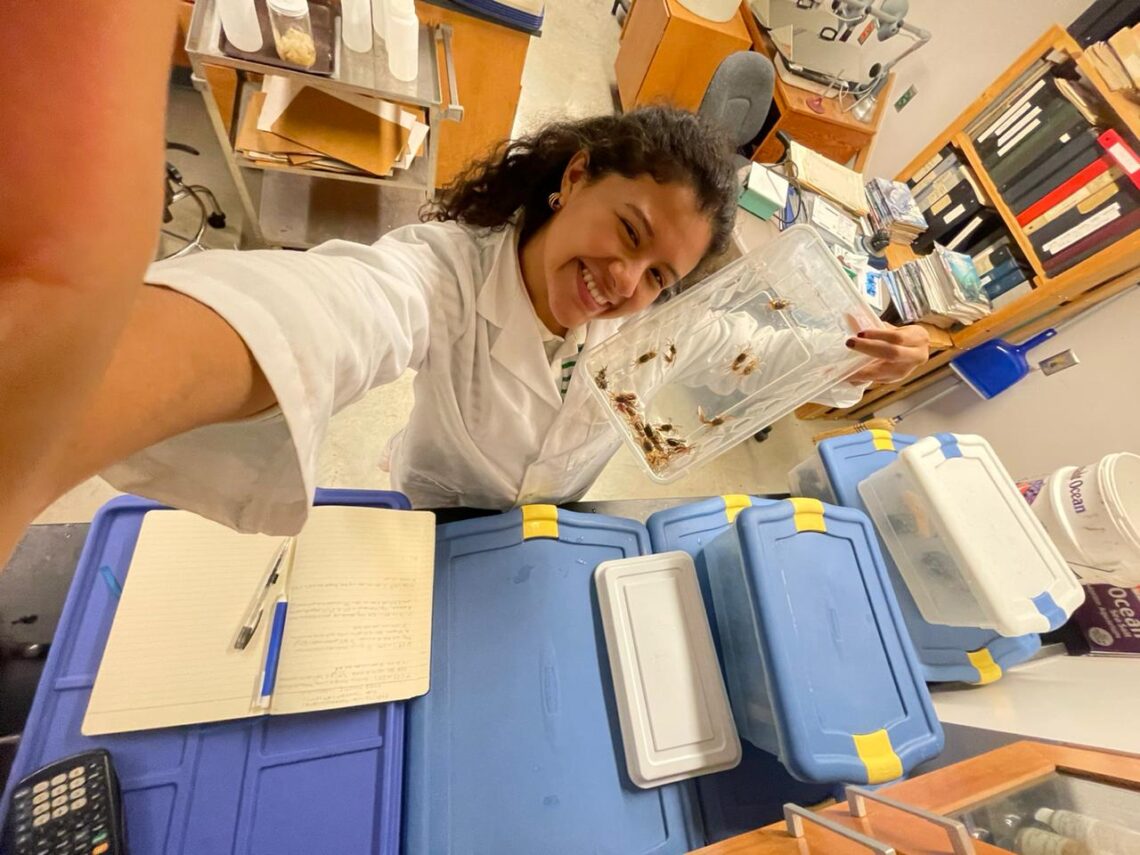
We’re back with another enthralling article, this time immersing ourselves in the enchanting wonders of Mexico. Join us on a captivating journey with Lorena, a true enthusiast deeply connected to the beauty and richness of her homeland. Mexico is a vibrant and diverse country located in the southern part of North America.
Meet Lorena!

¡Hola! Mi nombre es Lorena, tengo 25 años y soy orgullosamente mexicana!
México es un país que todos deberían visitar al menos una vez en la vida. Está lleno de color, comida increíble, gente amable, lugares y música hermosos y una cultura increíble. Nací y crecí en la ciudad más increíble del mundo: la Ciudad de México.
Estudié Biología en la Universidad Nacional Autónoma de México (UNAM). Estoy realmente enamorado de la Biología y siempre he sido un amante de los animales, desde cangrejos y abejas hasta ballenas y gatos. Terminé mi carrera el año pasado, pero decidí hacer una investigación internacional para mi tesis y encontré la UNI, y cuando llegó la oportunidad no lo dudé.
Mi proyecto actual se enfoca en el problema del Calentamiento Global ya que siempre me han interesado los problemas ambientales, o mejor dicho, las soluciones ambientales, y estoy usando cangrejos violinistas como modelo para intentar estableces límites de tolerancia térmicas de los organismos costeros a intentar proteger los hábitats costeros.
Mi experiencia en la UNI ha sido increíble. Lo más preciado son los amigos que he hecho. Gracias a nuevos amigos, he tenido la oportunidad de aprender más sobre muchos países y culturas. Además, toda la gente de la Universidad y de Iowa en general es muy amable y cálida.
Definitivamente esta experiencia ha cambiado mi vida, he crecido mucho en estos últimos meses y he aprendido mucho de los demás, de mí y de los cangrejos. Estaré eternamente agradecido por esta experiencia.
Hi! My name is Lorena, I am 25 years old and I am proudly Mexican!
México is a country that everybody should visit at least once in their lives. It’s full of color, amazing food, kind people, beautiful places and music, and an incredible culture. I was born and raised in the most amazing city in the world: Mexico City!
I studied Biology in the National Autonomous University of Mexico (UNAM). I am really in love with the Biology and I have always been an animal person, from crabs and bees to whales and cats. I finished my major last year, but decided to make an international research for my thesis and found the UNI, and when the opportunity came I didn’t doubt about it.
Right now my project is focused on the Global Warming problem since I’ve always been interested on environmental problems, or better, environmental solutions, and I am using fiddler crabs as a model to try to set limits on the thermal tolerances on coastal organisms to try to protect the coastal habitats.
My experience on the UNI has been amazing! The most precious thing are the friends that I have made. Because of new friends, I’ve had the opportunity to learns more about many countries and cultures. Also, all the people on the University and in Iowa in general are very nice and warm.
Definitely this experience have been a life changer for me, I have grown a lot on this past few months and have learn a lot from the others, from me and from the crabs. I will be forever thankful for this experience.
Lorena Martinez – Transfer Student
More about Lorena…
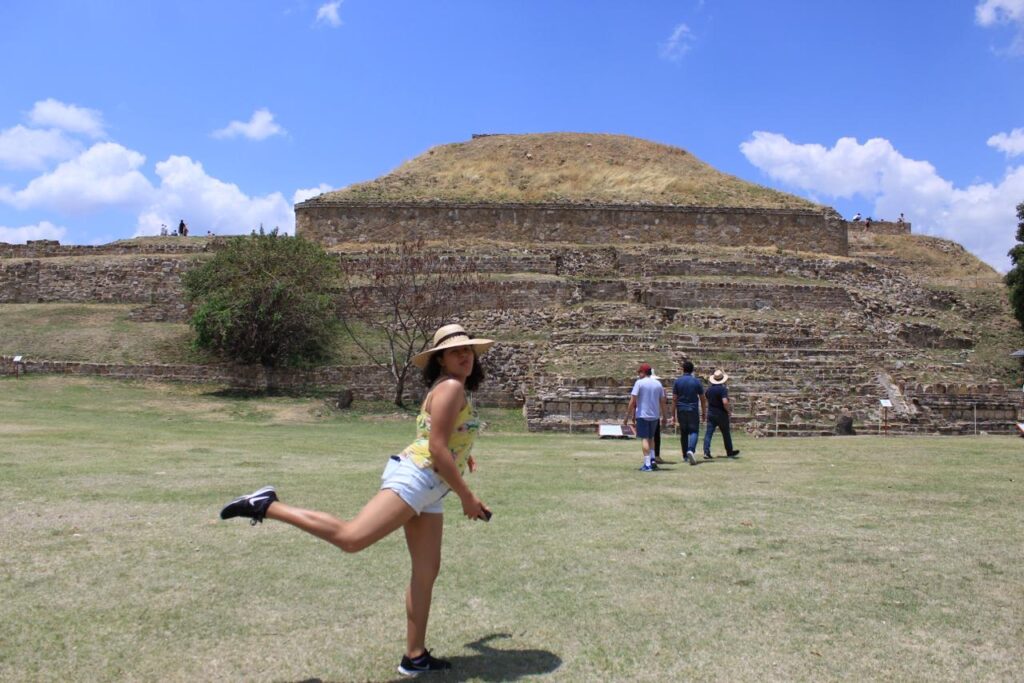
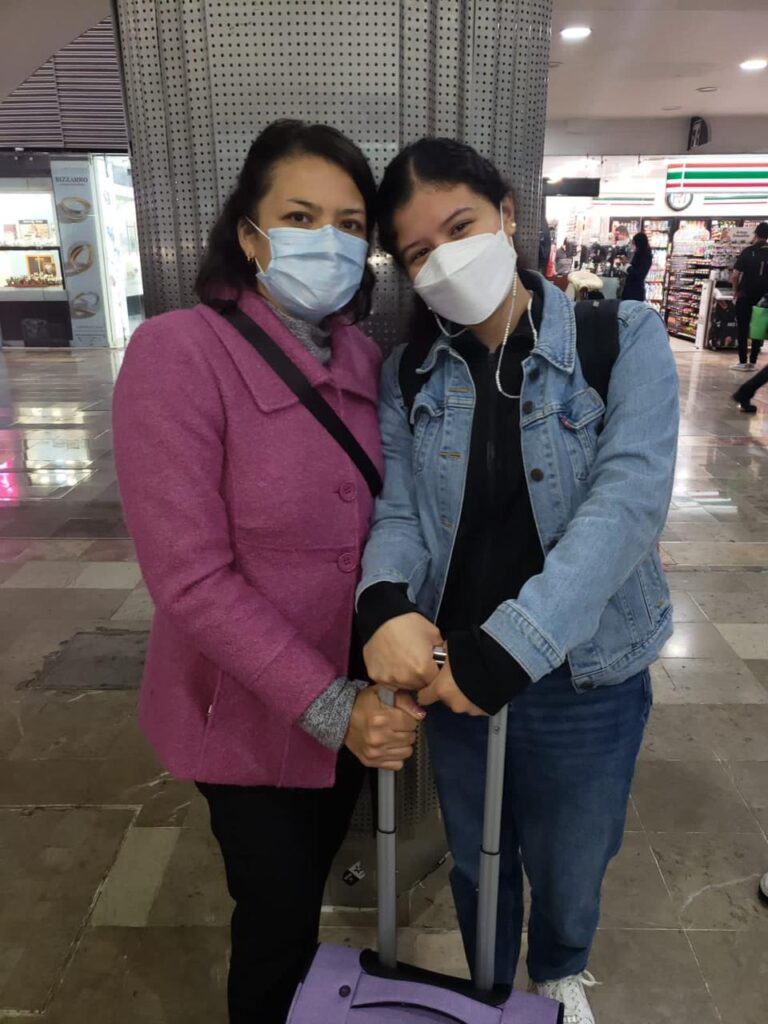





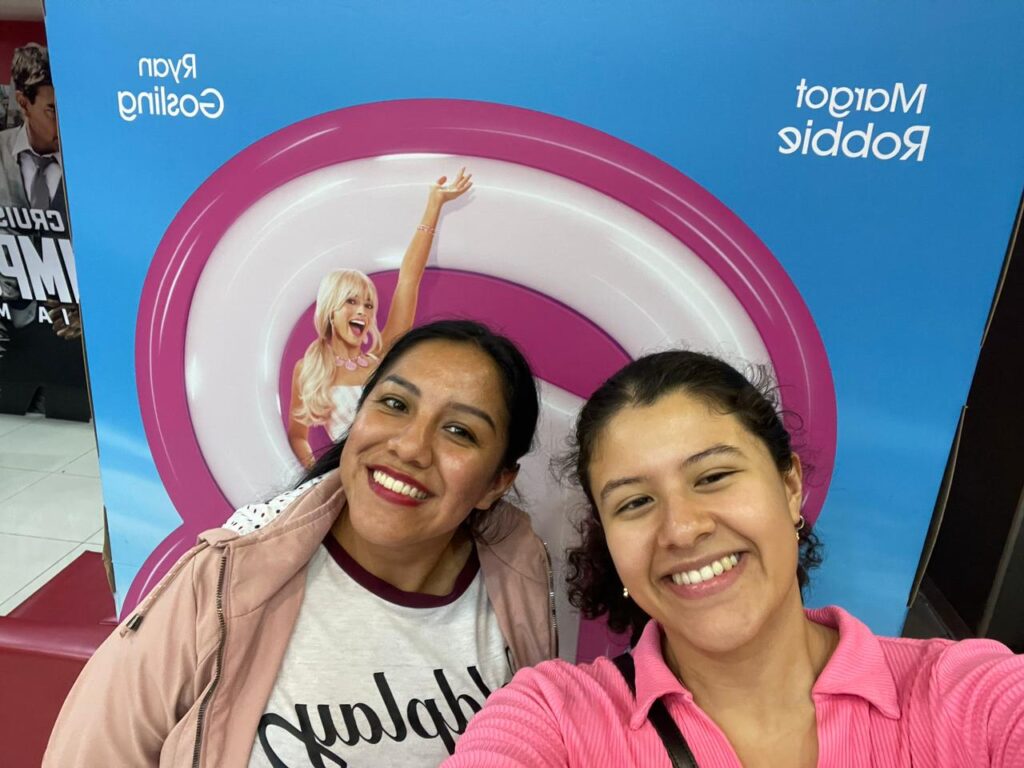
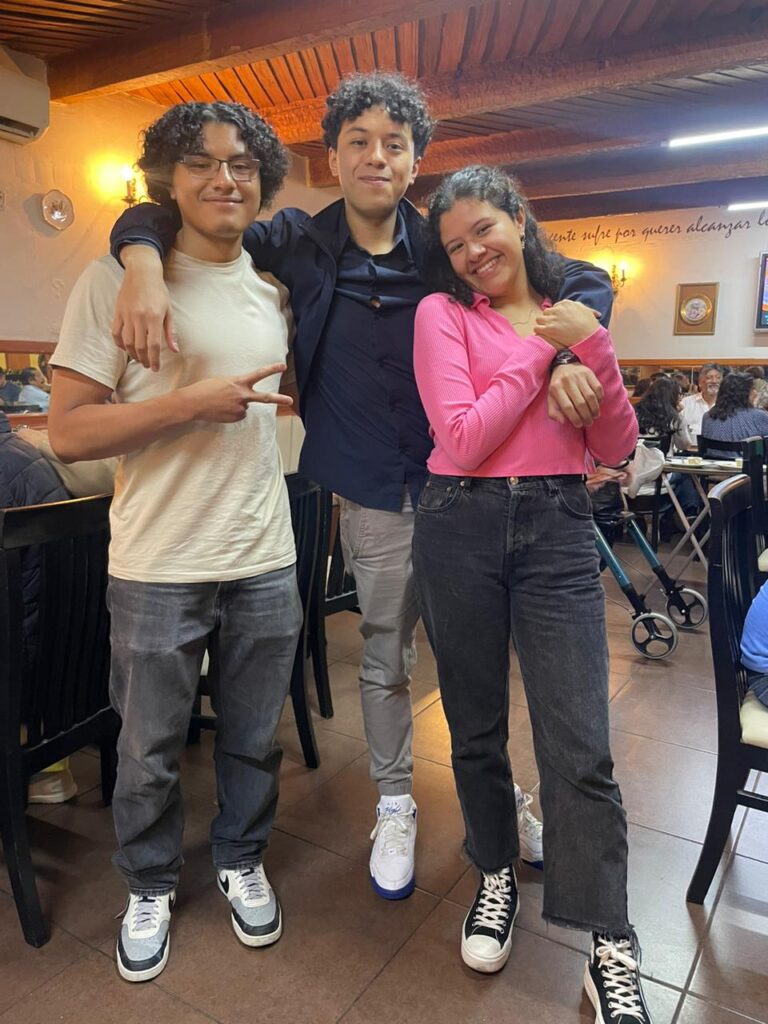
Where is Mexico located?

Mexico is located in the southern part of North America, sharing borders with the United States to the north, Belize and Guatemala to the south, the Pacific Ocean to the west, and the Gulf of Mexico and Caribbean Sea to the east. It is a country with diverse geography, including mountains, plateaus, and coastal areas. Mexico is the third-largest country in Latin America and covers a vast and varied land area. The capital city is Mexico City.
Places to visit in Mexico!
Mexico offers a wealth of diverse and captivating destinations for travelers. Here are some notable places to visit in Mexico:
Mexico City: The vibrant capital city is a cultural hub with museums like the National Museum of Anthropology, historic sites like the Zocalo, and the iconic Chapultepec Castle. Explore neighborhoods like Condesa and Roma for trendy vibes.
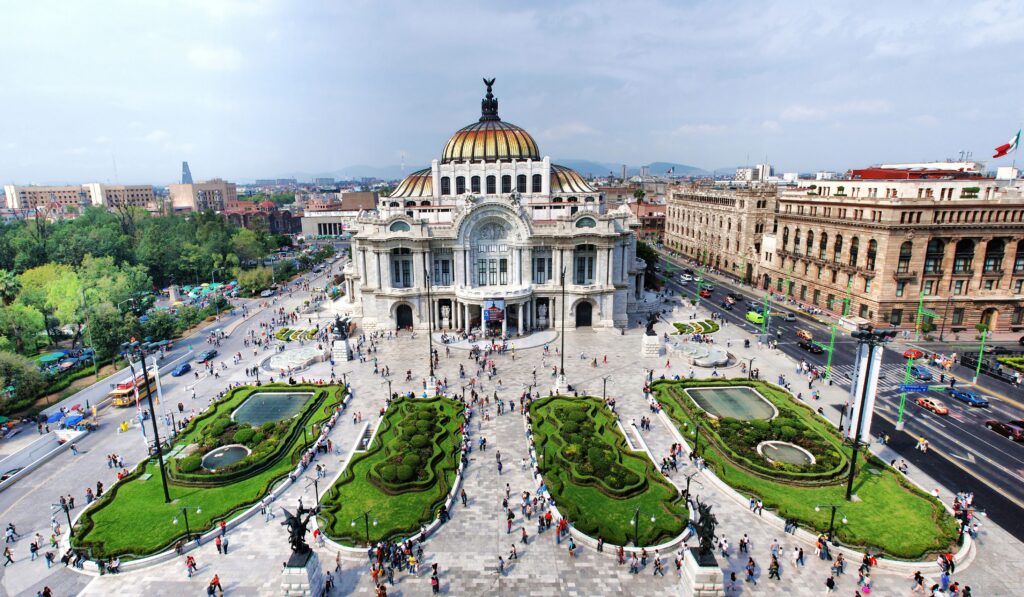
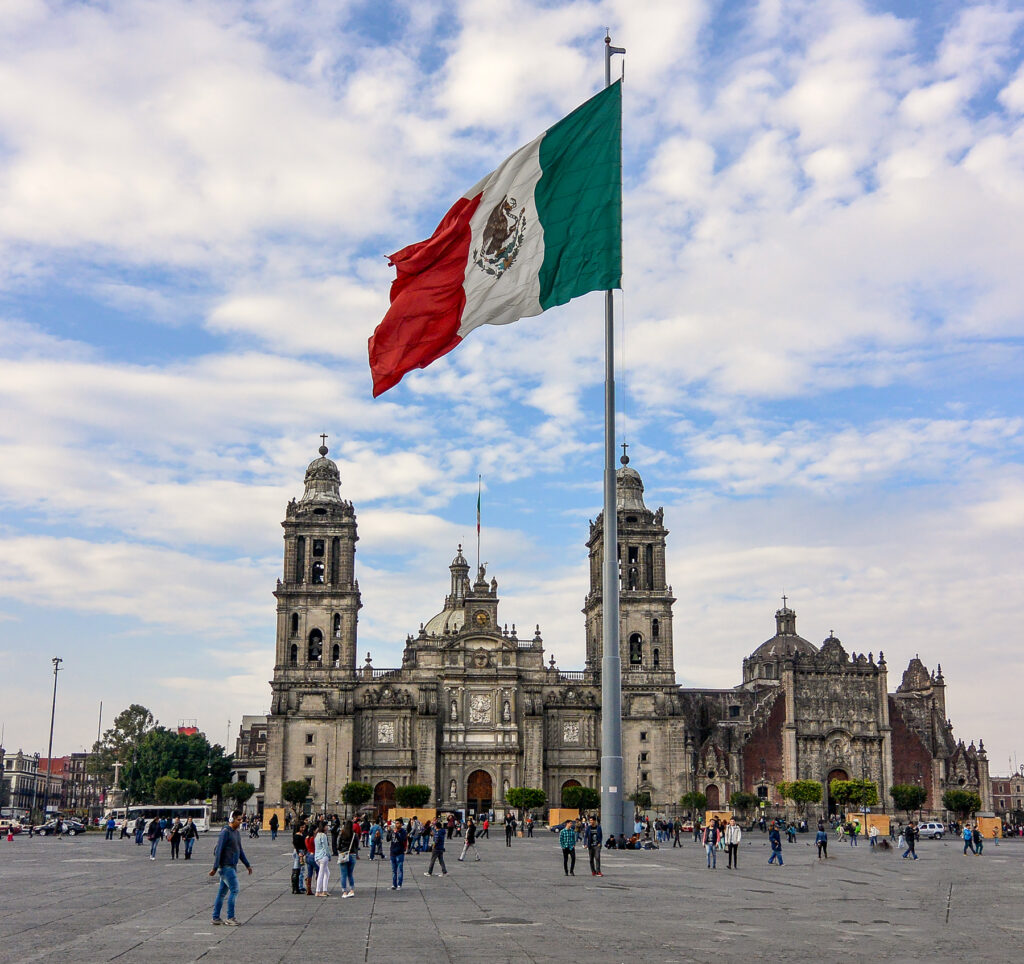
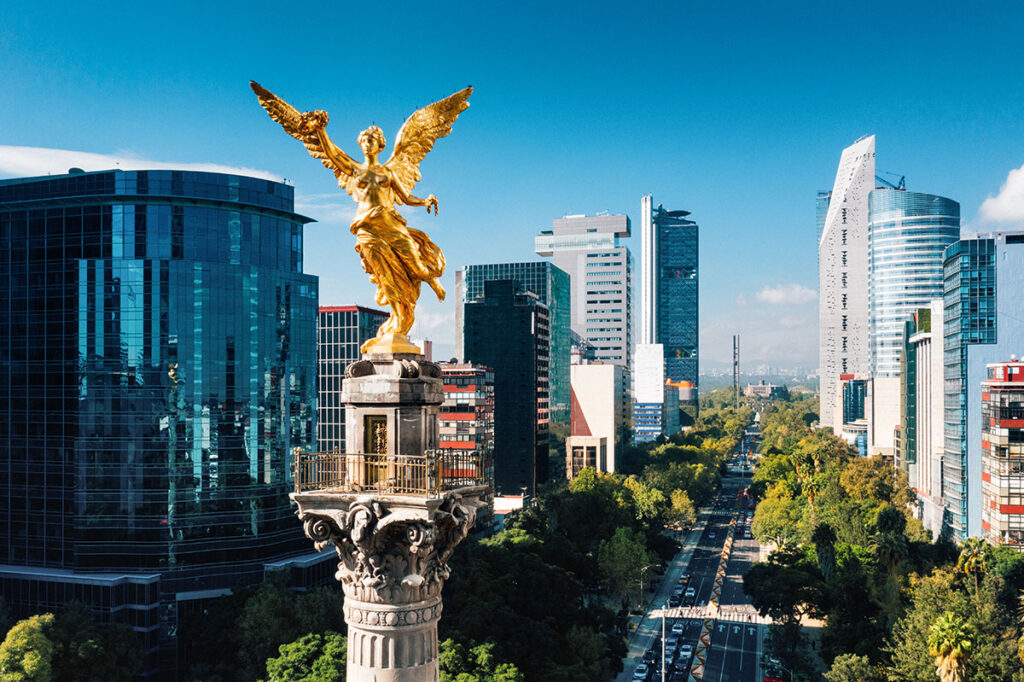
Cancun and the Riviera Maya: Known for stunning beaches and vibrant nightlife, Cancun is a popular destination. The nearby Riviera Maya offers archaeological wonders like Tulum and the natural beauty of Xcaret and Xel-Ha.
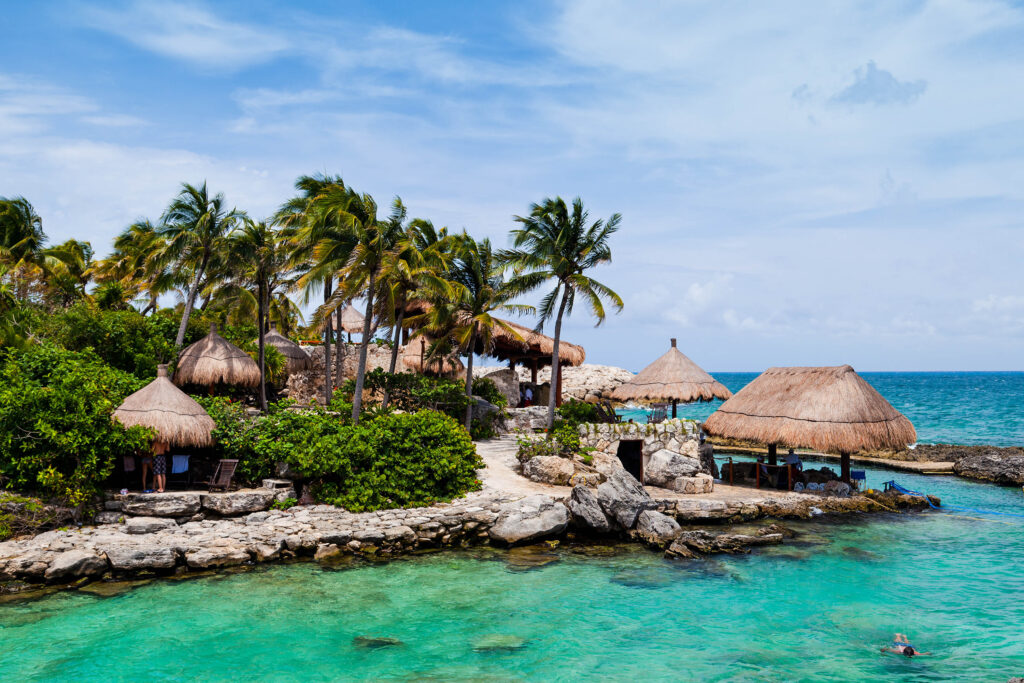
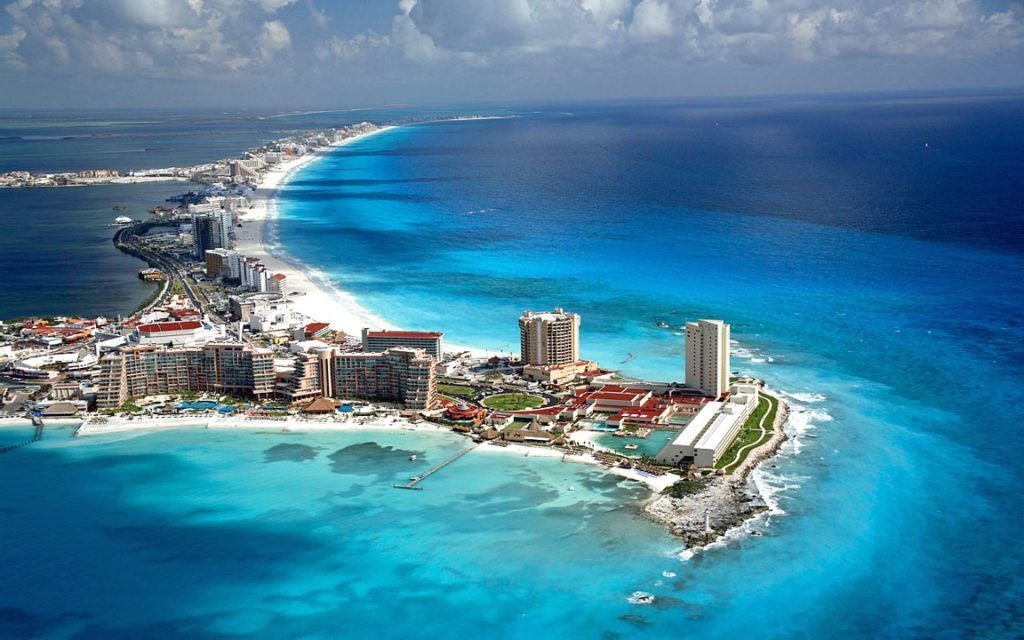
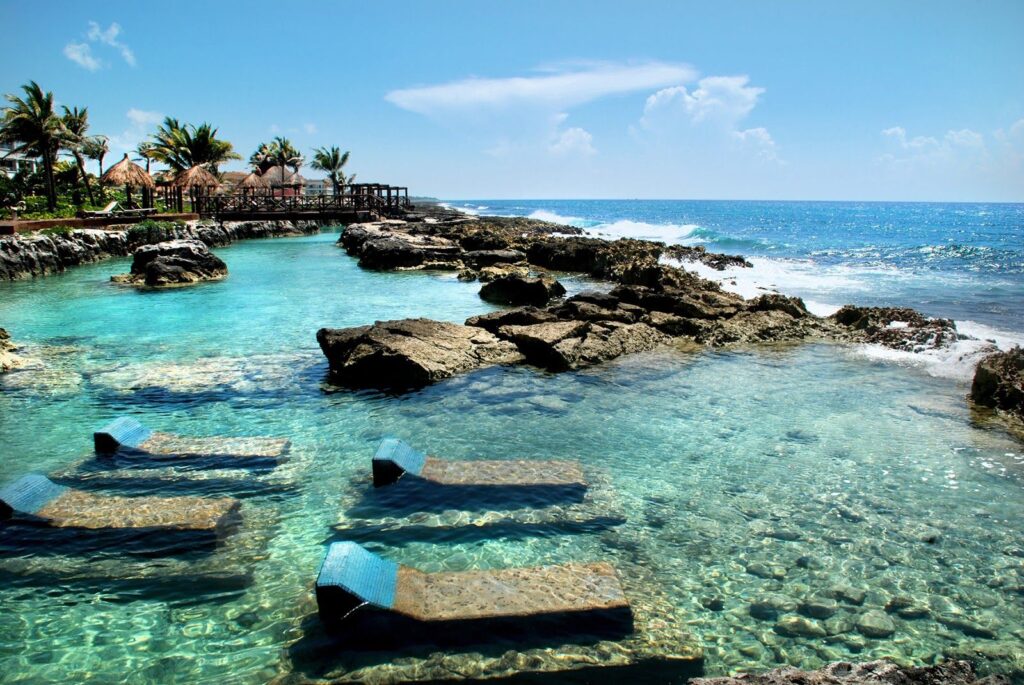
Guadalajara: Mexico’s second-largest city is famous for its mariachi music, tequila, and historic architecture. Visit the Hospicio Cabañas and enjoy the lively atmosphere of the Plaza de los Mariachis.
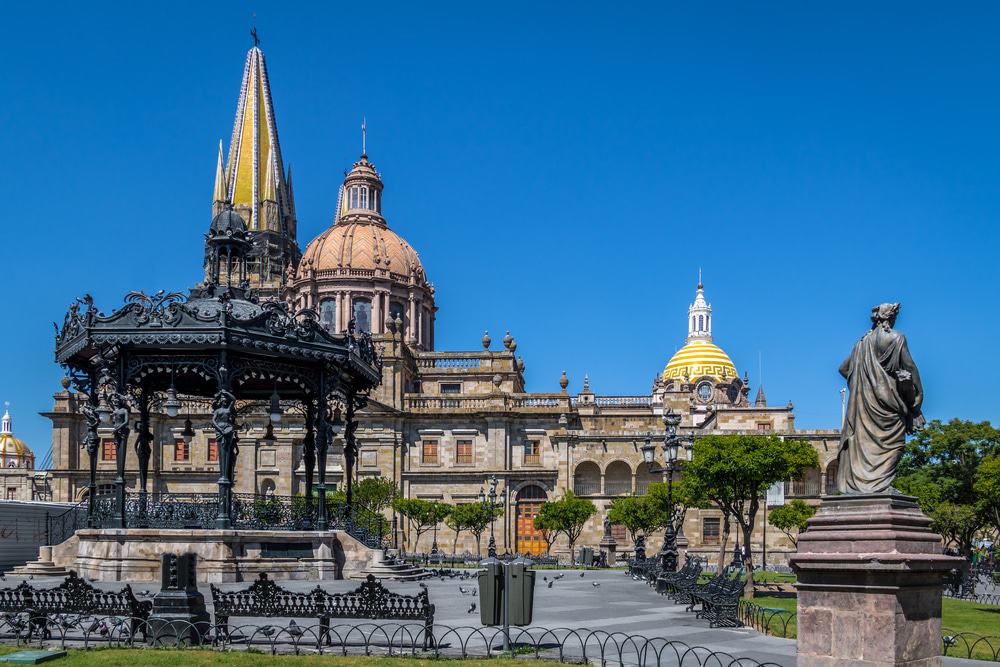
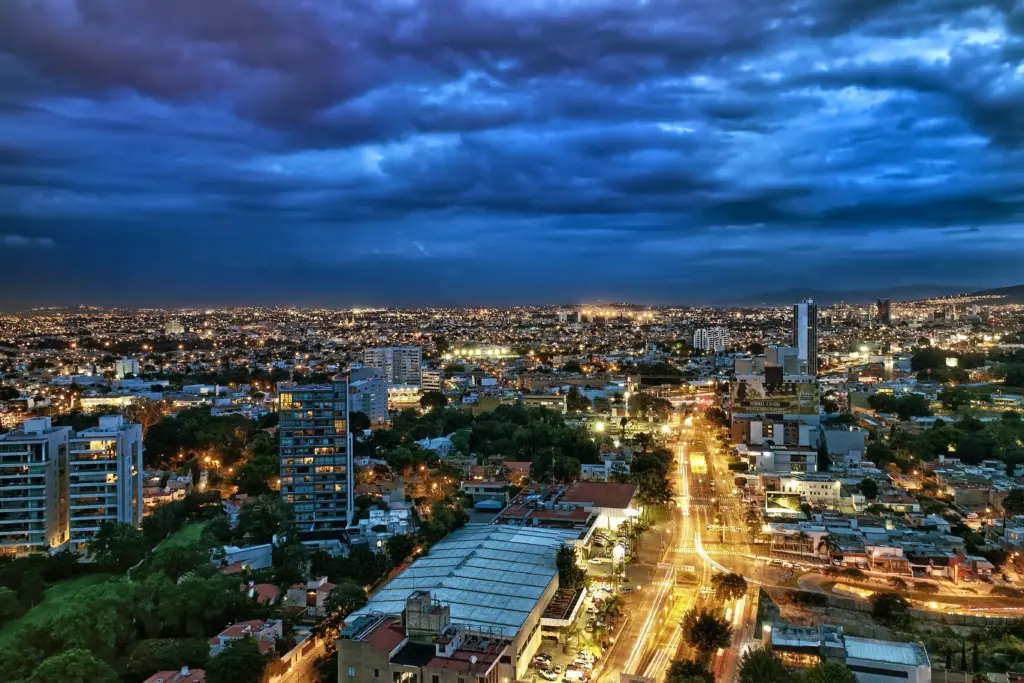
Guanajuato: A picturesque city with colorful buildings, narrow cobblestone streets, and underground tunnels. Explore the historic Alhóndiga de Granaditas and the Callejón del Beso.
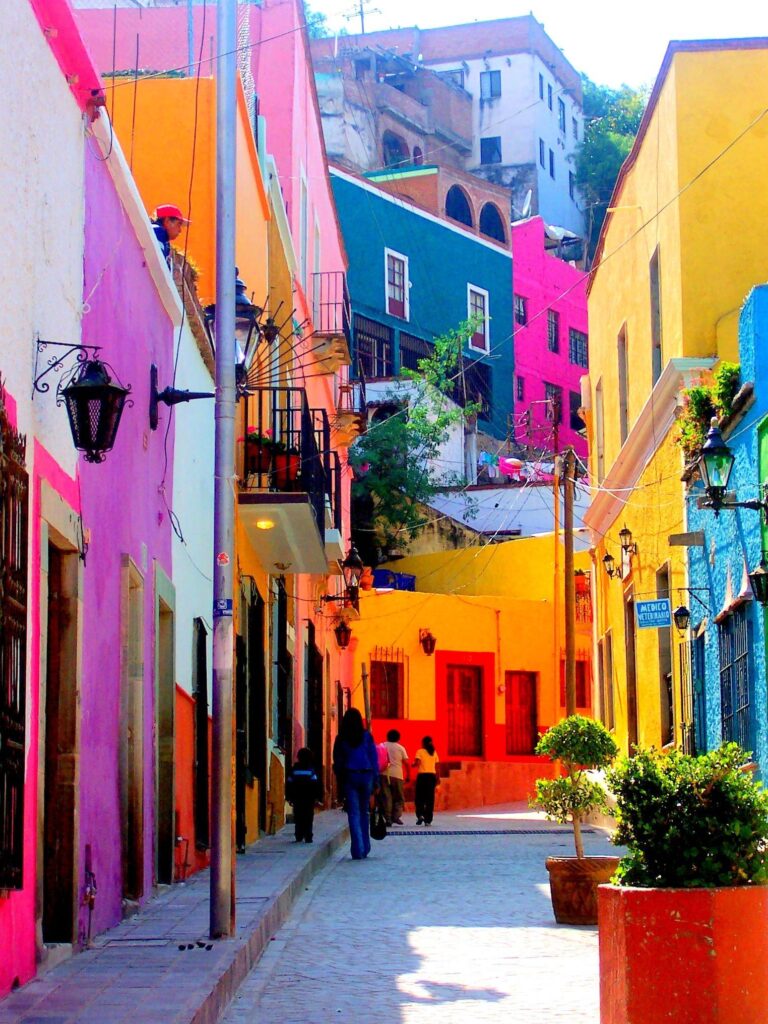
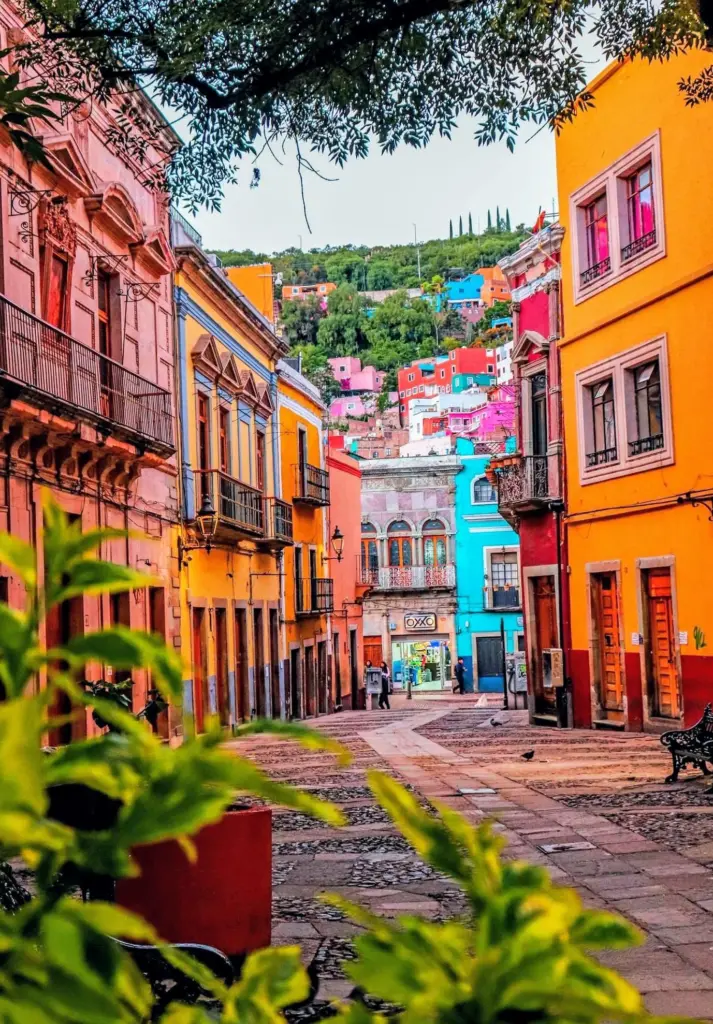
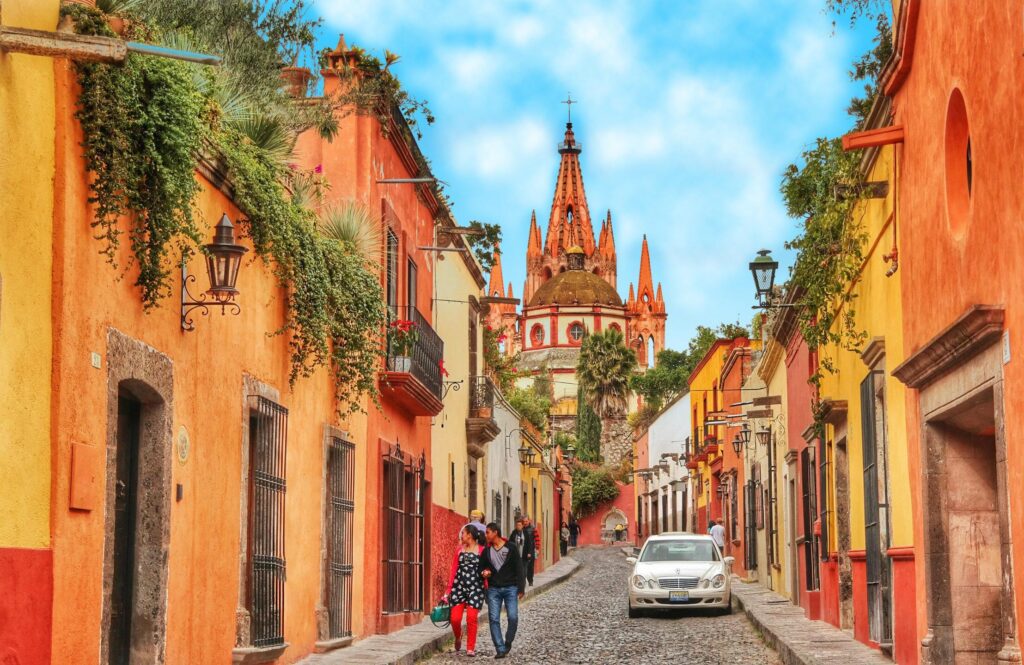
Cozumel: A popular island in the Caribbean Sea, Cozumel is known for its coral reefs, making it a top destination for snorkeling and diving.
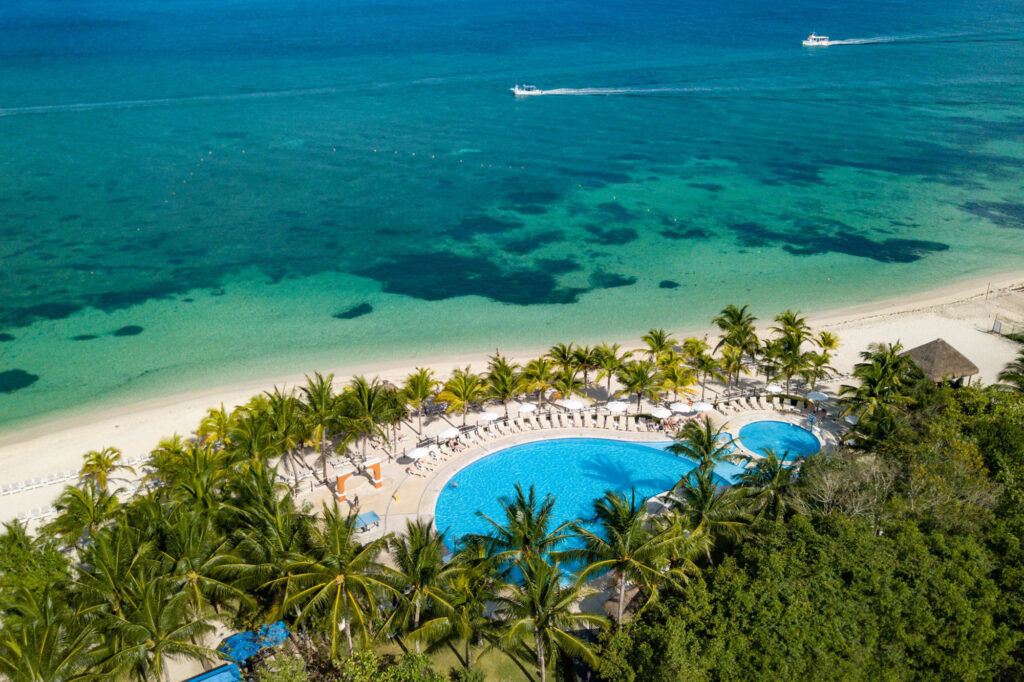
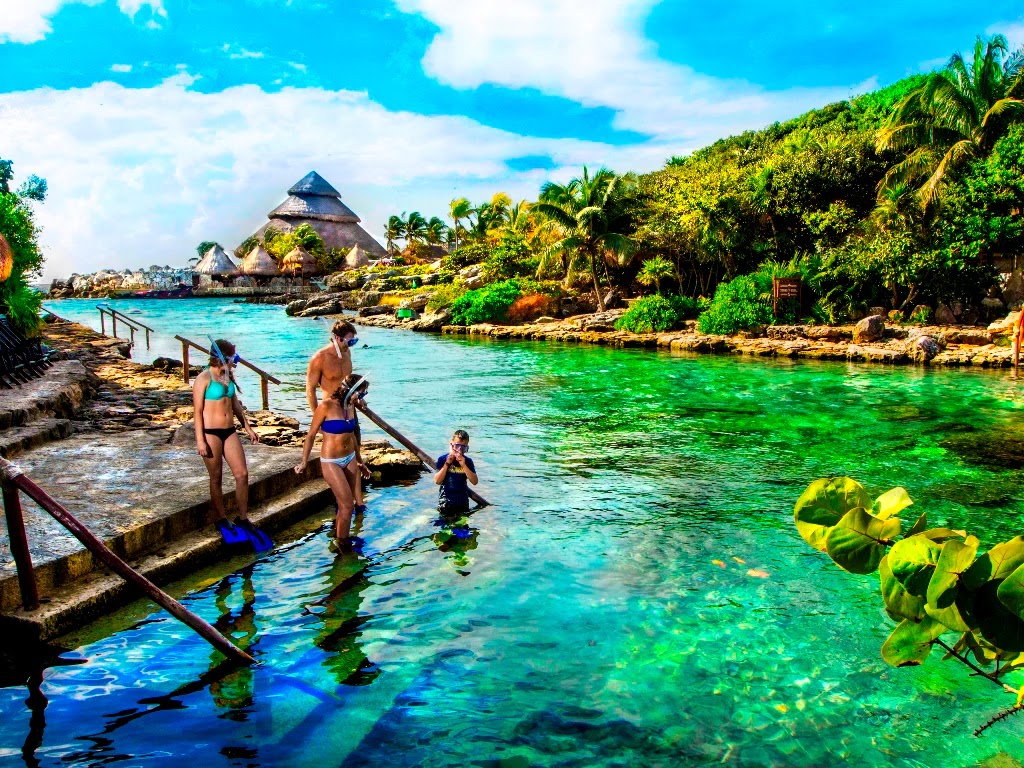
Copper Canyon (Barrancas del Cobre): Located in the Sierra Madre Occidental, this series of canyons is larger and deeper than the Grand Canyon. The scenic train ride through the canyons is a must-try experience.
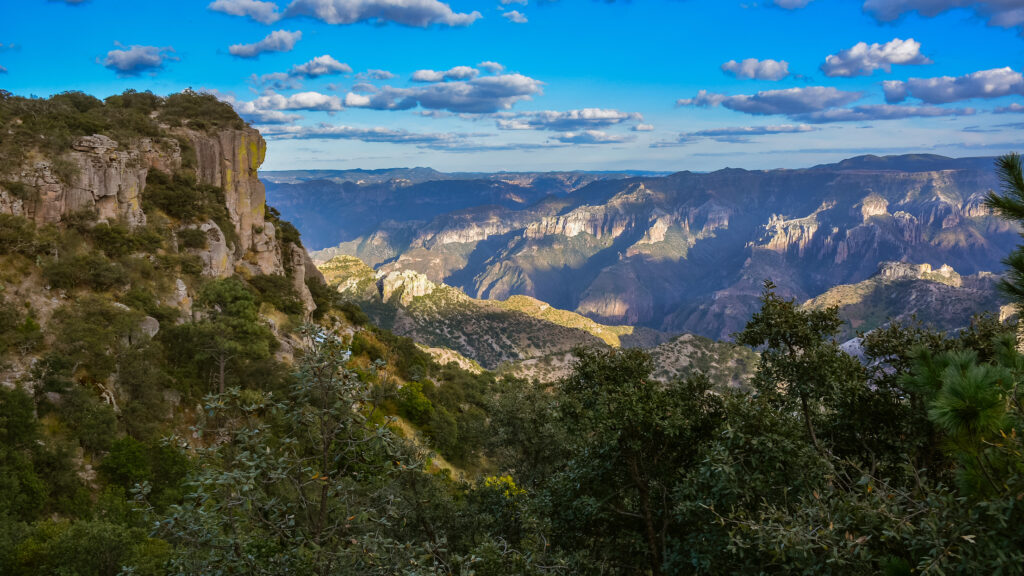
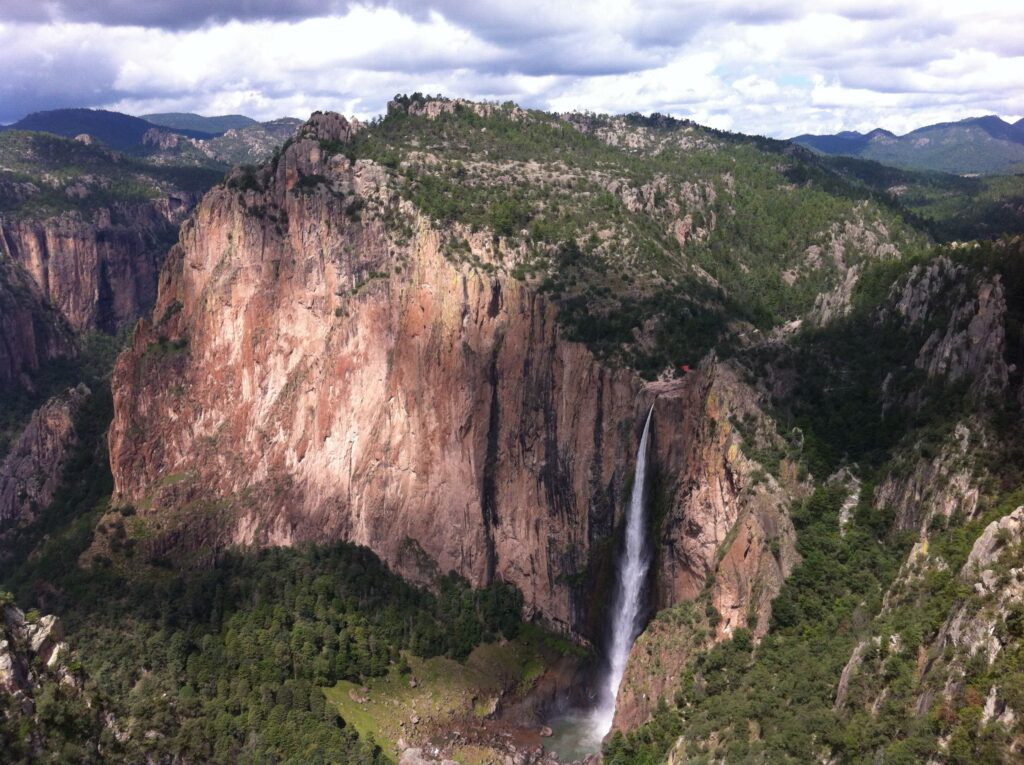
Oaxaca City: Recognized for its rich indigenous culture, Oaxaca is a UNESCO World Heritage Site. Explore the vibrant markets, sample the local cuisine, and visit archaeological sites like Monte Albán.
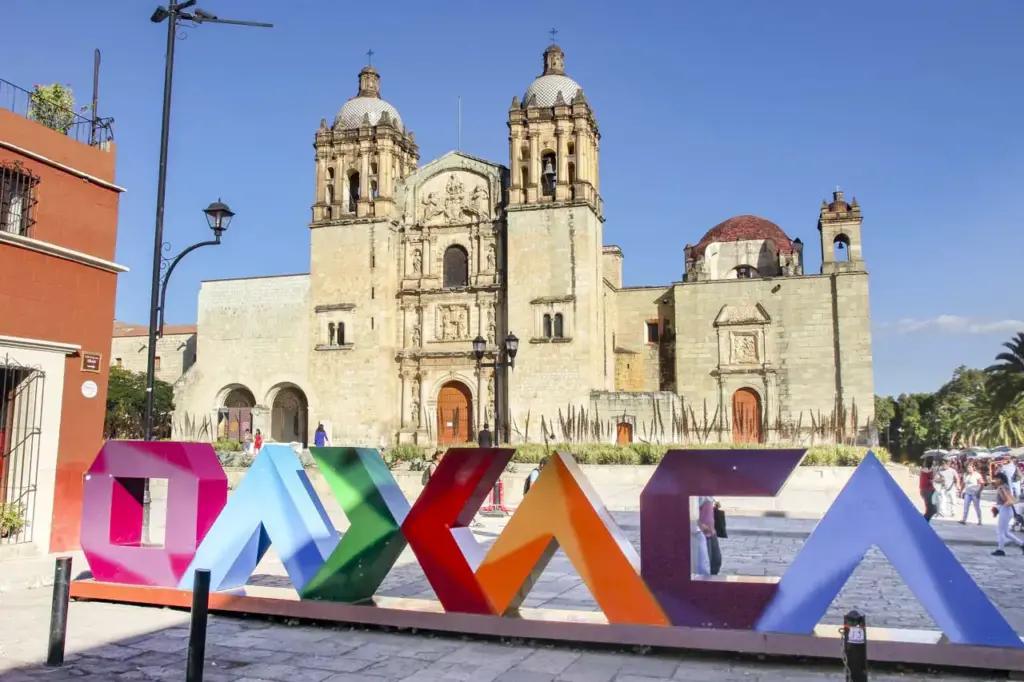
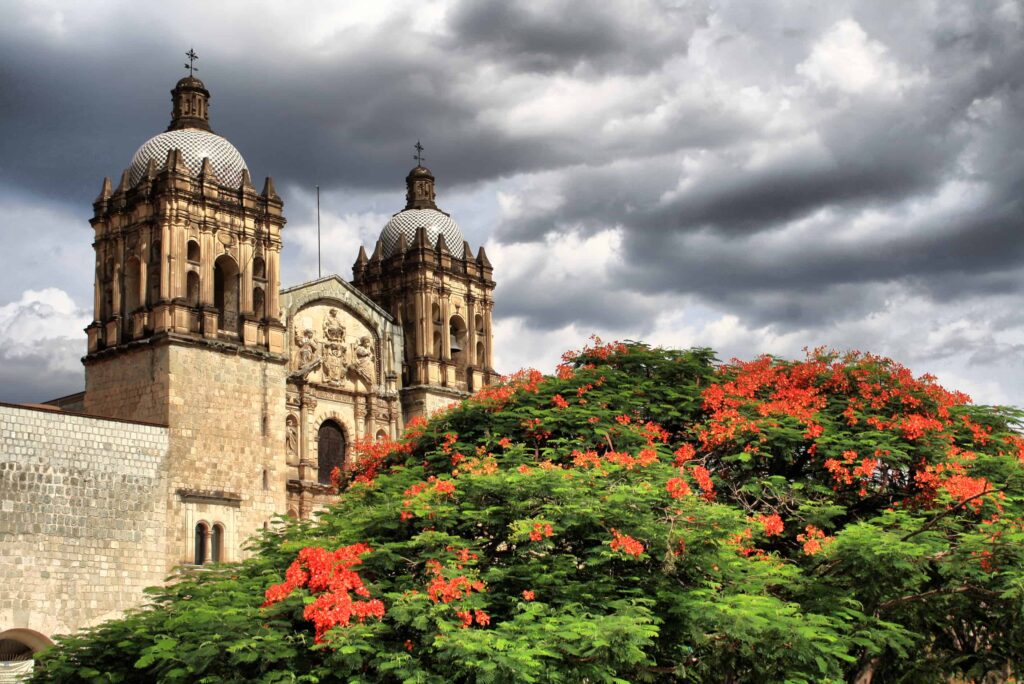
Mexico’s traditional food
Mexican cuisine is renowned worldwide for its rich flavors, diverse ingredients, and vibrant colors. Traditional Mexican food is a reflection of the country’s history, cultural diversity, and the ingenious use of local ingredients. Here are some key elements of Mexico’s traditional cuisine:
- Tacos: Perhaps the most iconic Mexican dish, tacos consist of folded or rolled tortillas filled with various ingredients. Common fillings include seasoned meats (such as carne asada or al pastor), beans, cheese, and salsa.
- Tamales: Tamales are a traditional Mesoamerican dish made of masa (a dough made from corn) that is filled with various ingredients, such as meats, chilies, fruits, or beans. The mixture is wrapped in a corn husk and steamed.
- Enchiladas: These are rolled tortillas filled with meat, cheese, beans, or a combination, and covered in a chili pepper sauce. Enchiladas are often baked and topped with additional ingredients like sour cream and guacamole.
- Guacamole: A classic Mexican dip made with mashed avocados, diced tomatoes, onions, cilantro, lime juice, and chili peppers. It’s often served with tortilla chips or as a topping for various dishes.
- Salsa: Mexico offers a variety of salsas, ranging from mild to fiery. Salsas are typically made with tomatoes, onions, cilantro, chili peppers, and lime juice. They add a burst of flavor to many Mexican dishes.
- Chiles Rellenos: This dish consists of large, mild chili peppers stuffed with cheese, meat, or beans, then battered and fried. They are often served with tomato sauce or other flavorful toppings.
- Mole: Mole is a rich and complex sauce that comes in various regional styles. It typically includes ingredients like chili peppers, chocolate, spices, and sometimes nuts. Mole is often served with poultry or pork.
- Pozole: A hearty soup made with hominy (dried corn kernels that have been treated with an alkali), meat (usually pork or chicken), and seasoned with chili peppers, garlic, and other spices. It’s often garnished with radishes, lettuce, and lime.
- Chiles en Nogada: This dish is a symbol of Mexican patriotism, featuring large poblano chili peppers stuffed with a mixture of meat, fruits, and spices. They are topped with a walnut-based cream sauce and garnished with pomegranate seeds.
- Ceviche: A seafood dish where raw fish or shrimp is “cooked” in lime or lemon juice and mixed with tomatoes, onions, cilantro, and chili peppers. It’s a refreshing and flavorful option, particularly in coastal regions.
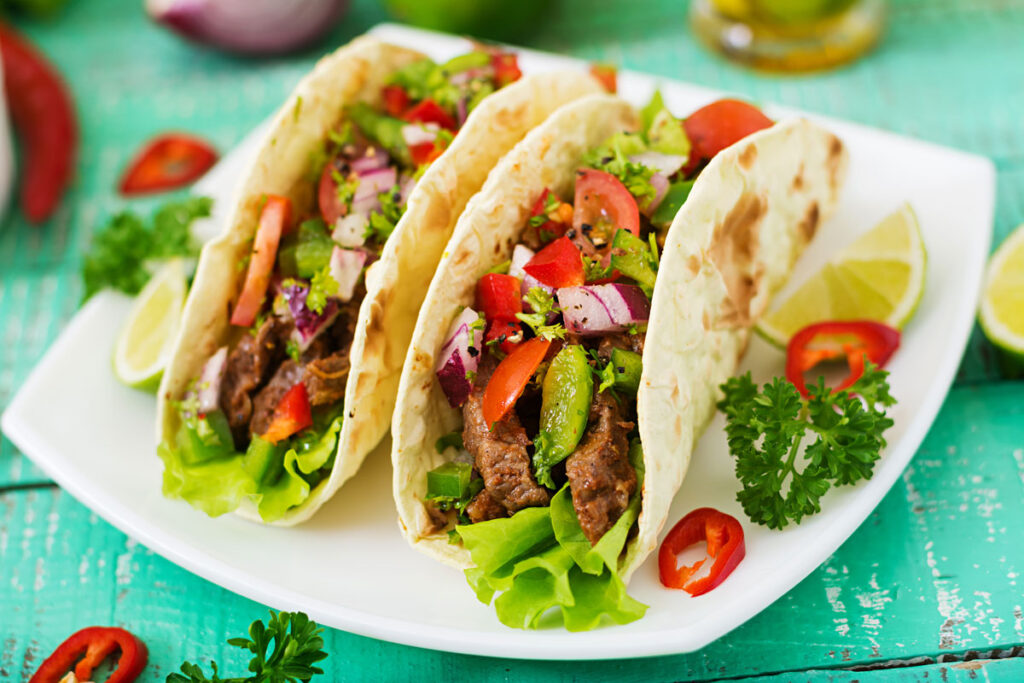
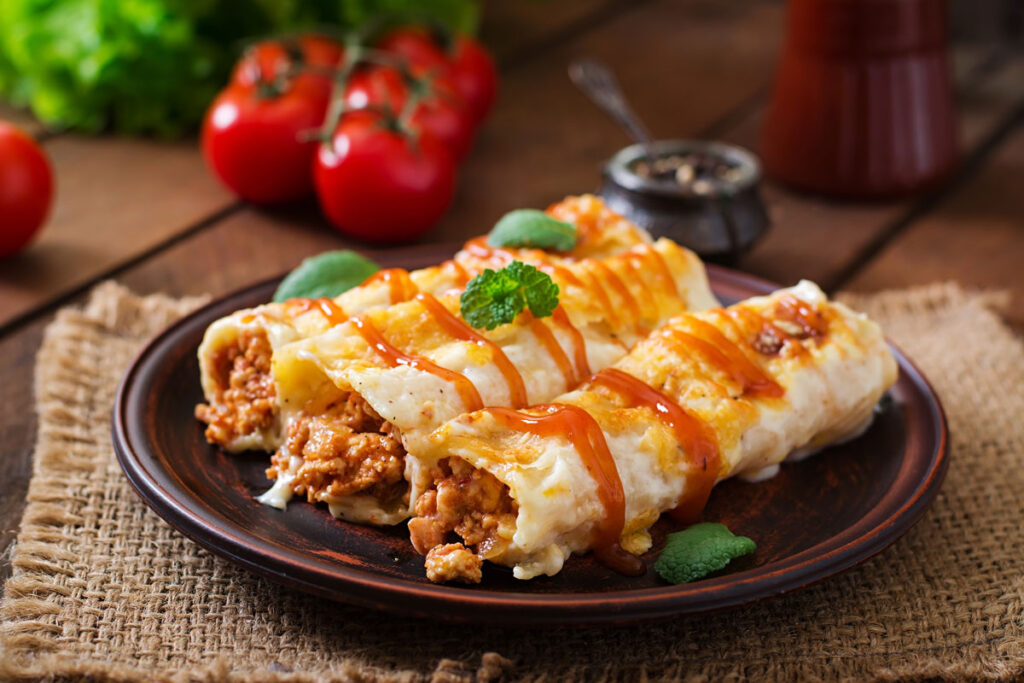
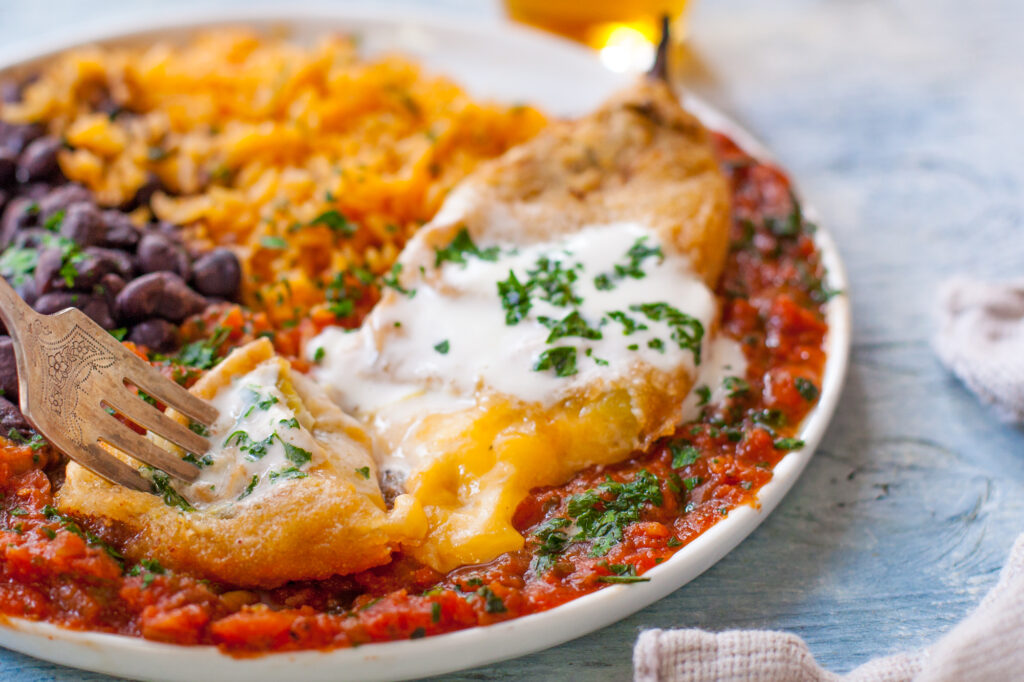

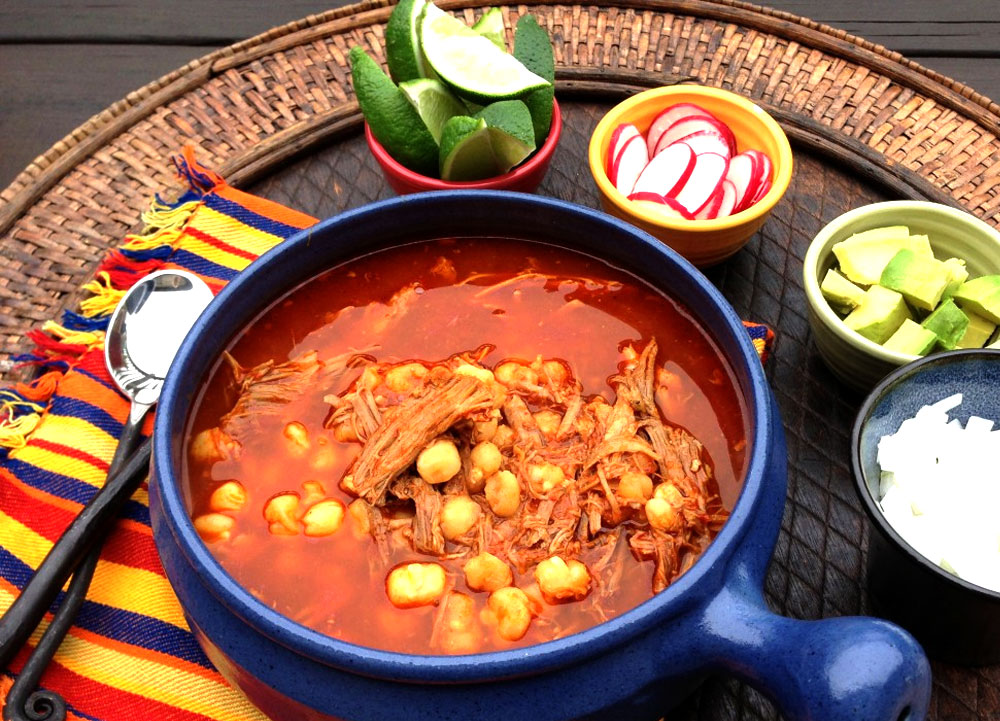
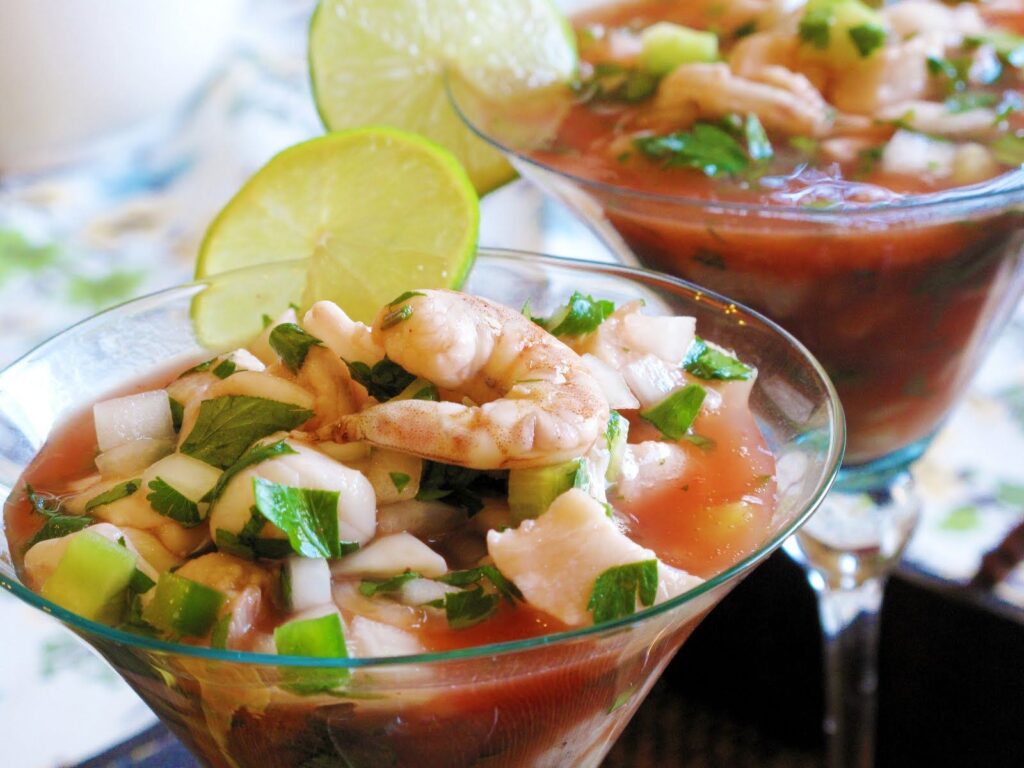
Traditional Costumes in Mexico
Traditional costumes in Mexico are vibrant, diverse, and reflective of the country’s rich cultural heritage. Different regions and indigenous communities have their own distinct styles of clothing, often influenced by historical and cultural factors. Here are some examples of traditional costumes in Mexico:
- Charro Suit (Traje de Charro): The charro suit is a traditional outfit worn by Mexican cowboys, known as charros. It typically includes tight-fitting pants adorned with embroidery, a wide-brimmed sombrero, a bow tie, a short jacket, and a vest. The charro suit is often associated with Mariachi bands and is worn during festive occasions.
- China Poblana: Originating in the state of Puebla, the China Poblana costume is characterized by a colorful, embroidered blouse with a square neckline, a full, vibrant skirt, and a rebozo (shawl). This traditional dress is often worn during folkloric dances and celebrations.
- Tehuana Dress: Hailing from the Isthmus of Tehuantepec in Oaxaca, the Tehuana dress is a distinctive outfit characterized by a heavily embroidered blouse, a wraparound skirt, and a headdress adorned with flowers and ribbons. This traditional costume represents the strength and independence of the women in the region.
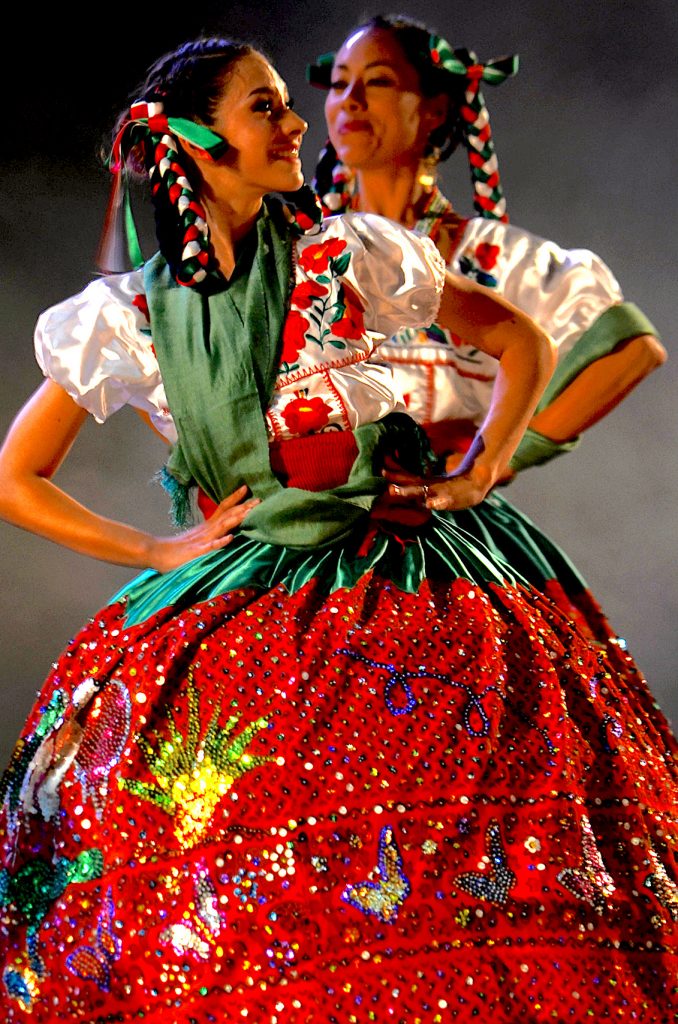

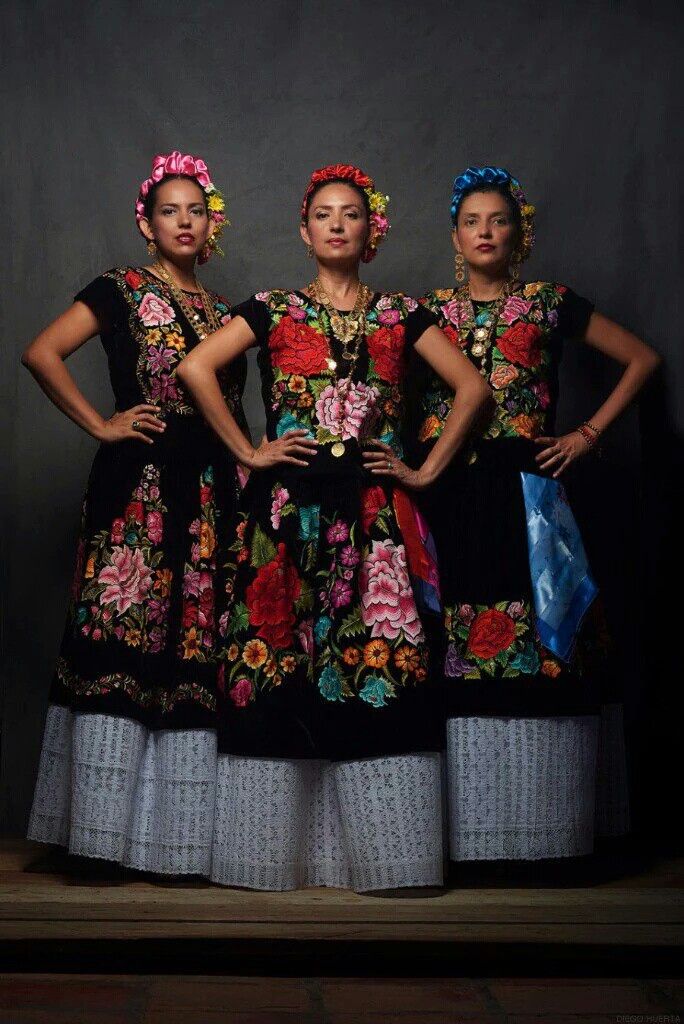
More
- Jalisco Dress (Adelita): The Jalisco dress, also known as the Adelita dress, is a colorful and elegant outfit worn during traditional dances in the state of Jalisco. It features a tiered skirt with vibrant ruffles, an embroidered blouse, and a wide-brimmed hat. The Jarabe Tapatío dance is often associated with this attire.
- Indigenous women in various regions of Mexico wear a traditional embroidered blouse called Huipil. The corte is a wraparound skirt, often made of woven fabric with intricate patterns. Together, the huipil and corte create a distinctive and culturally significant outfit.
- Zapotec Clothing: The Zapotec people in Oaxaca have unique traditional clothing. Women often wear brightly colored embroidered blouses and skirts, while men may wear woolen ponchos and embroidered pants. The designs often incorporate symbols and patterns with cultural significance.
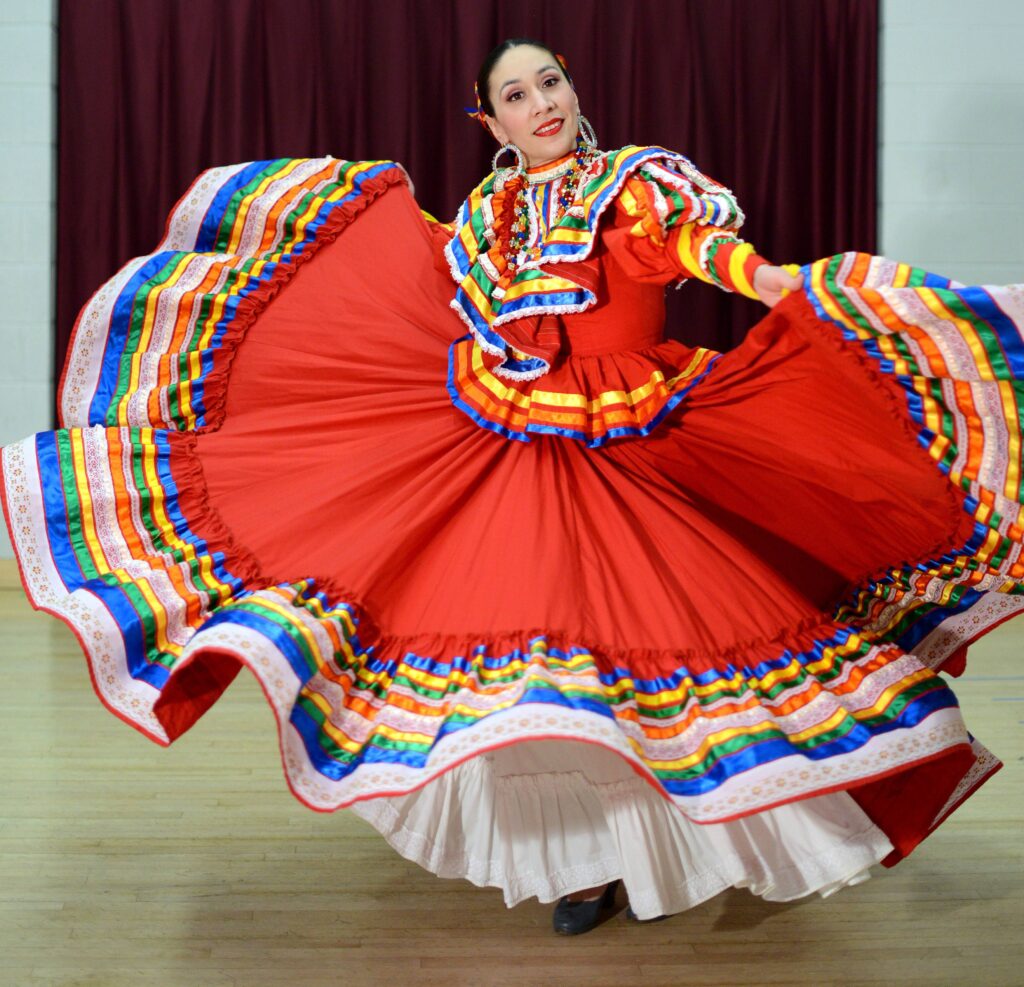
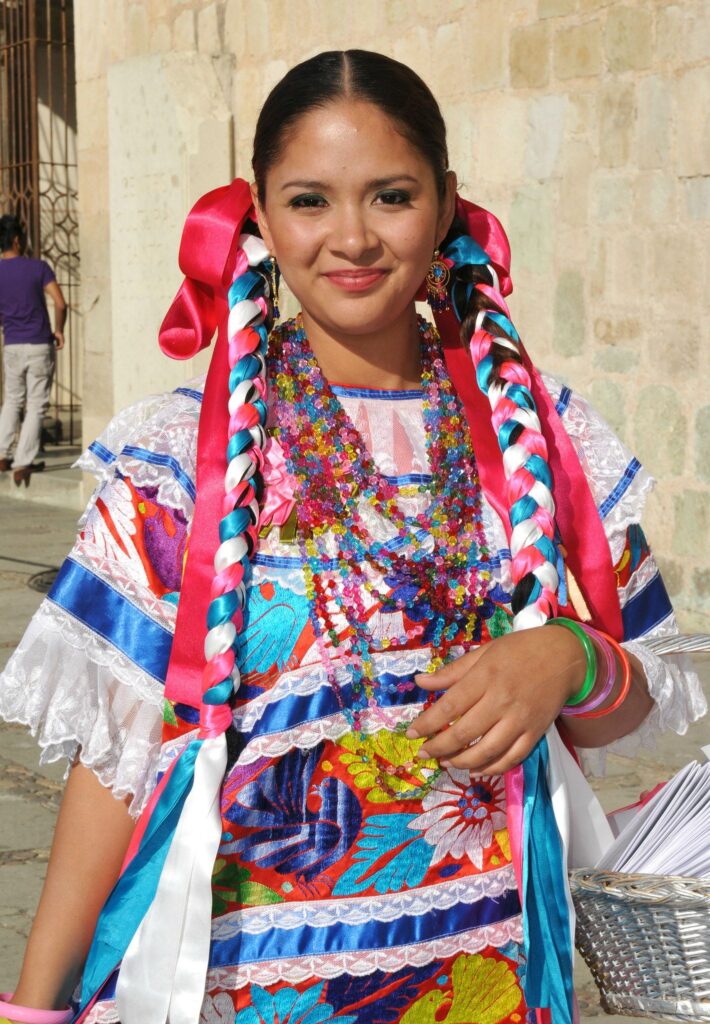
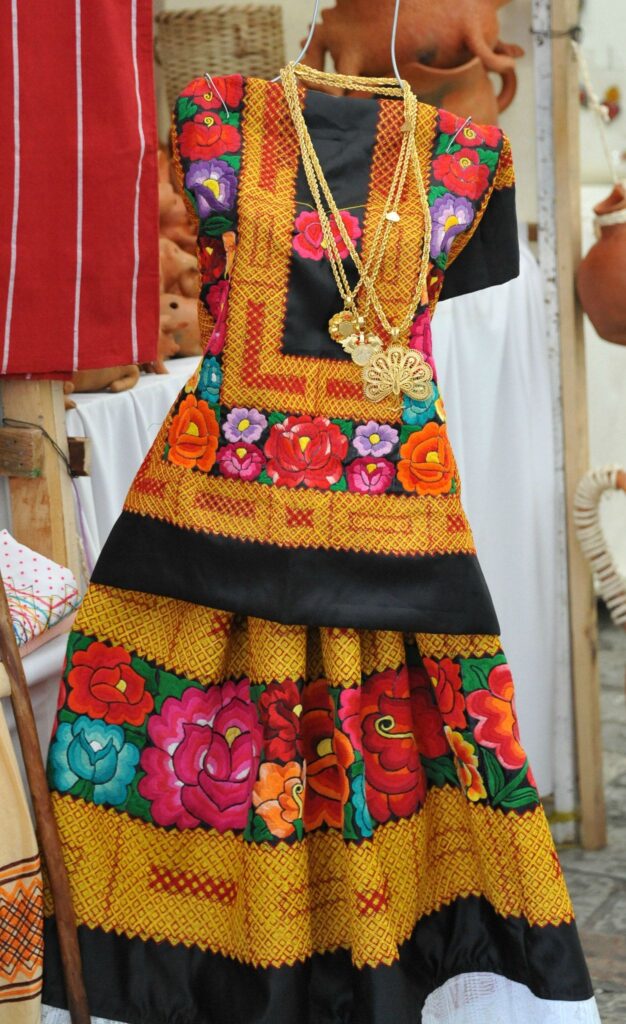
Festivals in Mexico
Known for its lively and colorful festivals, Mexico reflects its rich cultural heritage and diverse traditions. Here are some of the most celebrated festivals in Mexico:
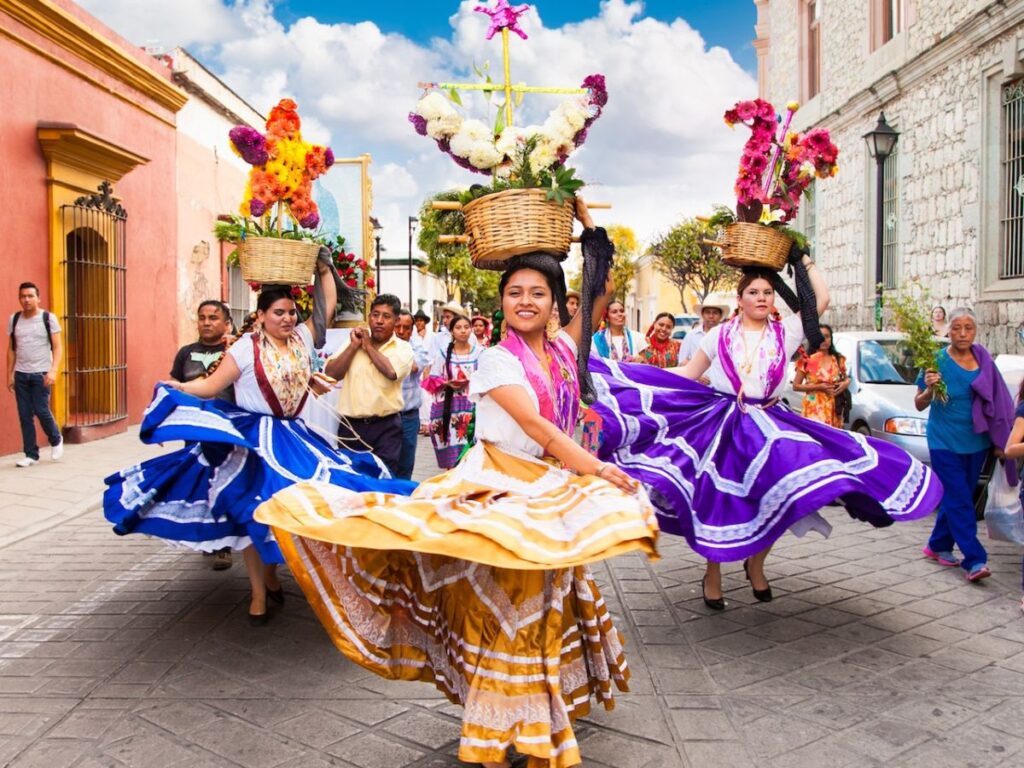
Guelaguetza: Held in the city of Oaxaca, the Guelaguetza is a vibrant cultural festival that takes place in July. It features traditional dances, music, and colorful costumes representing the diverse indigenous communities of the region.
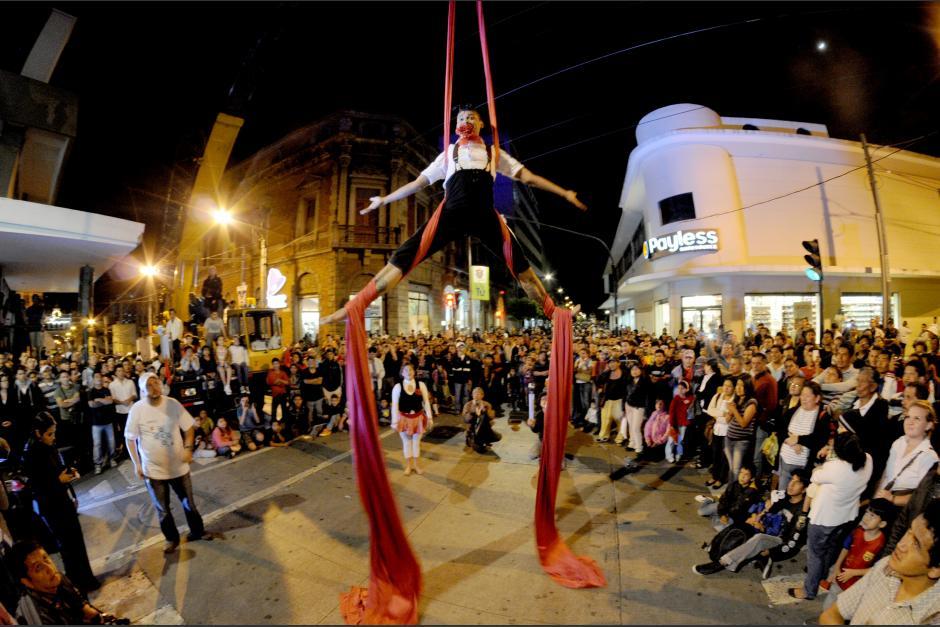
Festival del Centro Histórico: Celebrated in Mexico City, this festival showcases a wide range of cultural events, including concerts, dance performances, theater, and art exhibitions. It aims to highlight the rich cultural heritage of Mexico’s capital.
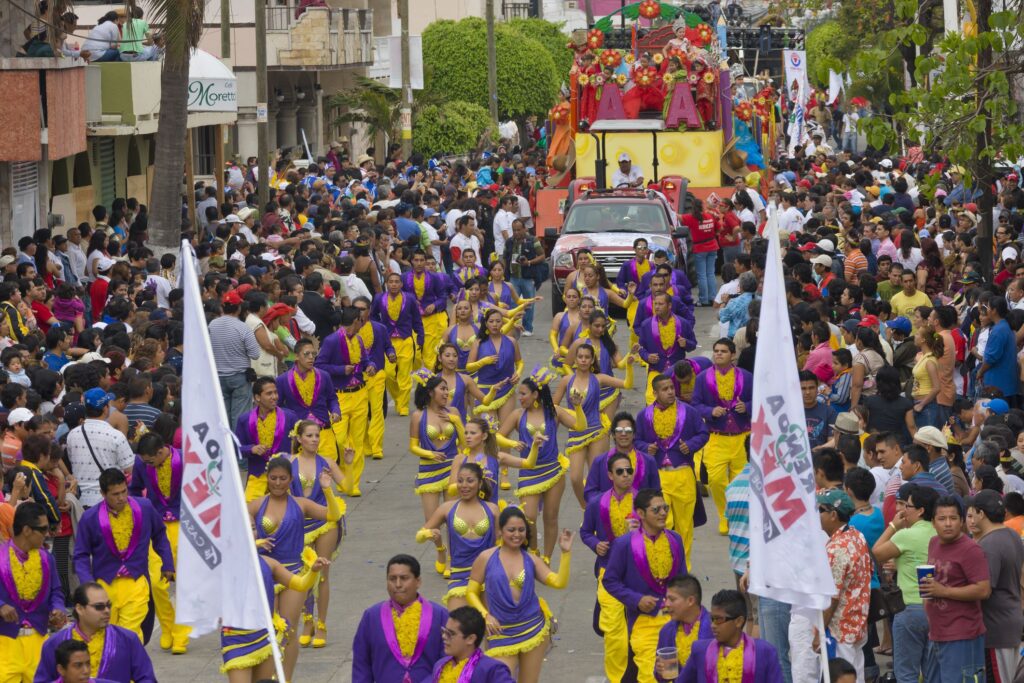
Carnaval: Various cities across Mexico celebrate Carnaval with colorful parades, music, dance, and elaborate costumes. Mazatlán, Veracruz, and Mérida host particularly vibrant Carnaval celebrations.
Traditional arts and crafts in Mexico
Mexico’s rich tradition of arts and crafts showcases the country’s diverse cultural influences and craftsmanship. Here are some notable Mexican crafts:
Mexican Folk Art:
- Alebrijes: Brightly colored Mexican folk art sculptures depict fantastical creatures. Carved from wood and painted in intricate patterns, alebrijes have become iconic symbols of Mexican folk art.
- Papel Picado: This traditional Mexican folk art involves cutting intricate designs into colorful tissue paper. People often use these delicate paper banners to decorate streets, festivals, and celebrations.
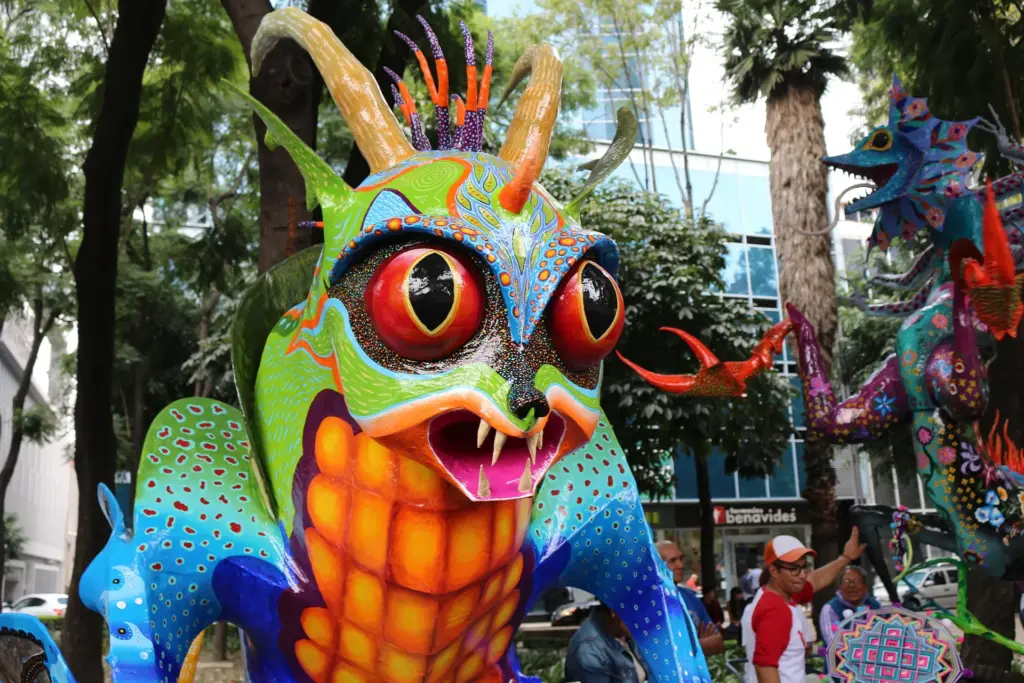
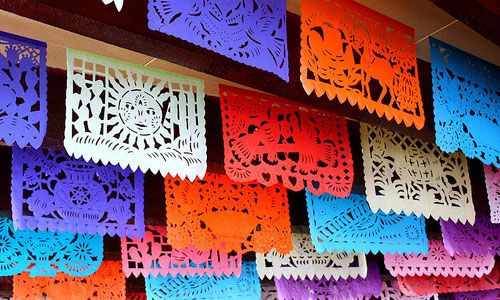
Amate Bark Painting:
- Indigenous communities in Mexico create vibrant paintings on amate, a type of bark paper. The paintings often depict traditional stories, rituals, and nature scenes.

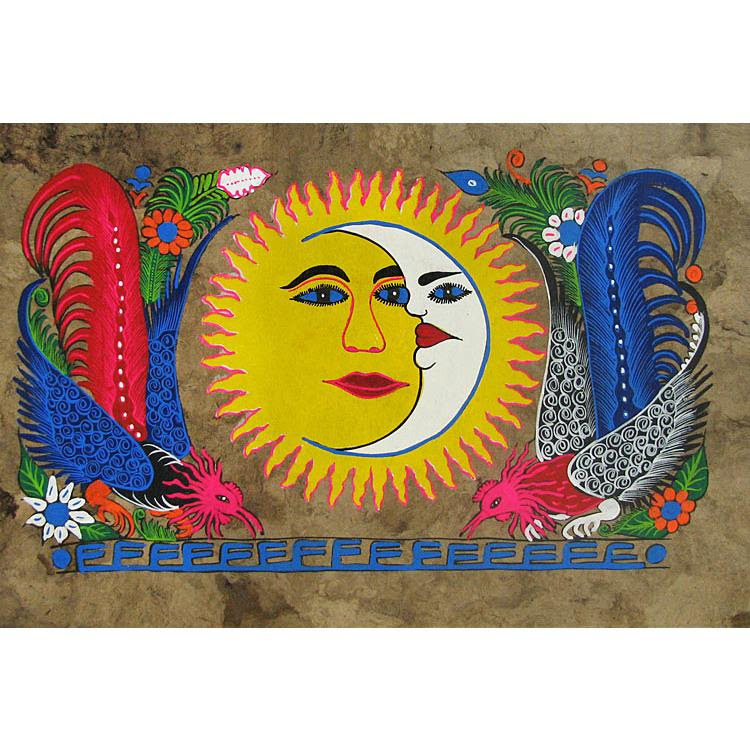
Facts about Mexico…
- UNESCO recognizes Mexico’s cuisine as an Intangible Cultural Heritage. It includes dishes such as tacos, tamales, mole, and guacamole, which have gained international popularity.
- Mexico is the most populous Spanish-speaking country in the world and the third-largest by land area in Latin America, after Brazil and Argentina.
- Celebrated on November 1st and 2nd, Día de los Muertos is a time to honor and remember deceased loved ones. It involves colorful altars, sugar skulls, marigolds, and visits to cemeteries.
- Mexican professional wrestling, known for its colorful masks and high-flying acrobatics, features prominently in the entertainment scene. The sport has gained a cult following and has become a significant part of Mexican popular culture.
If you want to know more about Spain, check here!

We’re back with another enthralling article, this time immersing ourselves in the enchanting wonders of Mexico. Join us on a captivating journey with Lorena, a true enthusiast deeply connected to the beauty and richness of her homeland. Mexico is a vibrant and diverse country located in the southern part of North America.
Meet Lorena!

¡Hola! Mi nombre es Lorena, tengo 25 años y soy orgullosamente mexicana!
México es un país que todos deberían visitar al menos una vez en la vida. Está lleno de color, comida increíble, gente amable, lugares y música hermosos y una cultura increíble. Nací y crecí en la ciudad más increíble del mundo: la Ciudad de México.
Estudié Biología en la Universidad Nacional Autónoma de México (UNAM). Estoy realmente enamorado de la Biología y siempre he sido un amante de los animales, desde cangrejos y abejas hasta ballenas y gatos. Terminé mi carrera el año pasado, pero decidí hacer una investigación internacional para mi tesis y encontré la UNI, y cuando llegó la oportunidad no lo dudé.
Mi proyecto actual se enfoca en el problema del Calentamiento Global ya que siempre me han interesado los problemas ambientales, o mejor dicho, las soluciones ambientales, y estoy usando cangrejos violinistas como modelo para intentar estableces límites de tolerancia térmicas de los organismos costeros a intentar proteger los hábitats costeros.
Mi experiencia en la UNI ha sido increíble. Lo más preciado son los amigos que he hecho. Gracias a nuevos amigos, he tenido la oportunidad de aprender más sobre muchos países y culturas. Además, toda la gente de la Universidad y de Iowa en general es muy amable y cálida.
Definitivamente esta experiencia ha cambiado mi vida, he crecido mucho en estos últimos meses y he aprendido mucho de los demás, de mí y de los cangrejos. Estaré eternamente agradecido por esta experiencia.
Hi! My name is Lorena, I am 25 years old and I am proudly Mexican!
México is a country that everybody should visit at least once in their lives. It’s full of color, amazing food, kind people, beautiful places and music, and an incredible culture. I was born and raised in the most amazing city in the world: Mexico City!
I studied Biology in the National Autonomous University of Mexico (UNAM). I am really in love with the Biology and I have always been an animal person, from crabs and bees to whales and cats. I finished my major last year, but decided to make an international research for my thesis and found the UNI, and when the opportunity came I didn’t doubt about it.
Right now my project is focused on the Global Warming problem since I’ve always been interested on environmental problems, or better, environmental solutions, and I am using fiddler crabs as a model to try to set limits on the thermal tolerances on coastal organisms to try to protect the coastal habitats.
My experience on the UNI has been amazing! The most precious thing are the friends that I have made. Because of new friends, I’ve had the opportunity to learns more about many countries and cultures. Also, all the people on the University and in Iowa in general are very nice and warm.
Definitely this experience have been a life changer for me, I have grown a lot on this past few months and have learn a lot from the others, from me and from the crabs. I will be forever thankful for this experience.
Lorena Martinez – Transfer Student
More about Lorena…









Where is Mexico located?

Mexico is located in the southern part of North America, sharing borders with the United States to the north, Belize and Guatemala to the south, the Pacific Ocean to the west, and the Gulf of Mexico and Caribbean Sea to the east. It is a country with diverse geography, including mountains, plateaus, and coastal areas. Mexico is the third-largest country in Latin America and covers a vast and varied land area. The capital city is Mexico City.
Places to visit in Mexico!
Mexico offers a wealth of diverse and captivating destinations for travelers. Here are some notable places to visit in Mexico:
Mexico City: The vibrant capital city is a cultural hub with museums like the National Museum of Anthropology, historic sites like the Zocalo, and the iconic Chapultepec Castle. Explore neighborhoods like Condesa and Roma for trendy vibes.



Cancun and the Riviera Maya: Known for stunning beaches and vibrant nightlife, Cancun is a popular destination. The nearby Riviera Maya offers archaeological wonders like Tulum and the natural beauty of Xcaret and Xel-Ha.



Guadalajara: Mexico’s second-largest city is famous for its mariachi music, tequila, and historic architecture. Visit the Hospicio Cabañas and enjoy the lively atmosphere of the Plaza de los Mariachis.


Guanajuato: A picturesque city with colorful buildings, narrow cobblestone streets, and underground tunnels. Explore the historic Alhóndiga de Granaditas and the Callejón del Beso.



Cozumel: A popular island in the Caribbean Sea, Cozumel is known for its coral reefs, making it a top destination for snorkeling and diving.


Copper Canyon (Barrancas del Cobre): Located in the Sierra Madre Occidental, this series of canyons is larger and deeper than the Grand Canyon. The scenic train ride through the canyons is a must-try experience.


Oaxaca City: Recognized for its rich indigenous culture, Oaxaca is a UNESCO World Heritage Site. Explore the vibrant markets, sample the local cuisine, and visit archaeological sites like Monte Albán.


Mexico’s traditional food
Mexican cuisine is renowned worldwide for its rich flavors, diverse ingredients, and vibrant colors. Traditional Mexican food is a reflection of the country’s history, cultural diversity, and the ingenious use of local ingredients. Here are some key elements of Mexico’s traditional cuisine:
- Tacos: Perhaps the most iconic Mexican dish, tacos consist of folded or rolled tortillas filled with various ingredients. Common fillings include seasoned meats (such as carne asada or al pastor), beans, cheese, and salsa.
- Tamales: Tamales are a traditional Mesoamerican dish made of masa (a dough made from corn) that is filled with various ingredients, such as meats, chilies, fruits, or beans. The mixture is wrapped in a corn husk and steamed.
- Enchiladas: These are rolled tortillas filled with meat, cheese, beans, or a combination, and covered in a chili pepper sauce. Enchiladas are often baked and topped with additional ingredients like sour cream and guacamole.
- Guacamole: A classic Mexican dip made with mashed avocados, diced tomatoes, onions, cilantro, lime juice, and chili peppers. It’s often served with tortilla chips or as a topping for various dishes.
- Salsa: Mexico offers a variety of salsas, ranging from mild to fiery. Salsas are typically made with tomatoes, onions, cilantro, chili peppers, and lime juice. They add a burst of flavor to many Mexican dishes.
- Chiles Rellenos: This dish consists of large, mild chili peppers stuffed with cheese, meat, or beans, then battered and fried. They are often served with tomato sauce or other flavorful toppings.
- Mole: Mole is a rich and complex sauce that comes in various regional styles. It typically includes ingredients like chili peppers, chocolate, spices, and sometimes nuts. Mole is often served with poultry or pork.
- Pozole: A hearty soup made with hominy (dried corn kernels that have been treated with an alkali), meat (usually pork or chicken), and seasoned with chili peppers, garlic, and other spices. It’s often garnished with radishes, lettuce, and lime.
- Chiles en Nogada: This dish is a symbol of Mexican patriotism, featuring large poblano chili peppers stuffed with a mixture of meat, fruits, and spices. They are topped with a walnut-based cream sauce and garnished with pomegranate seeds.
- Ceviche: A seafood dish where raw fish or shrimp is “cooked” in lime or lemon juice and mixed with tomatoes, onions, cilantro, and chili peppers. It’s a refreshing and flavorful option, particularly in coastal regions.






Traditional Costumes in Mexico
Traditional costumes in Mexico are vibrant, diverse, and reflective of the country’s rich cultural heritage. Different regions and indigenous communities have their own distinct styles of clothing, often influenced by historical and cultural factors. Here are some examples of traditional costumes in Mexico:
- Charro Suit (Traje de Charro): The charro suit is a traditional outfit worn by Mexican cowboys, known as charros. It typically includes tight-fitting pants adorned with embroidery, a wide-brimmed sombrero, a bow tie, a short jacket, and a vest. The charro suit is often associated with Mariachi bands and is worn during festive occasions.
- China Poblana: Originating in the state of Puebla, the China Poblana costume is characterized by a colorful, embroidered blouse with a square neckline, a full, vibrant skirt, and a rebozo (shawl). This traditional dress is often worn during folkloric dances and celebrations.
- Tehuana Dress: Hailing from the Isthmus of Tehuantepec in Oaxaca, the Tehuana dress is a distinctive outfit characterized by a heavily embroidered blouse, a wraparound skirt, and a headdress adorned with flowers and ribbons. This traditional costume represents the strength and independence of the women in the region.



More
- Jalisco Dress (Adelita): The Jalisco dress, also known as the Adelita dress, is a colorful and elegant outfit worn during traditional dances in the state of Jalisco. It features a tiered skirt with vibrant ruffles, an embroidered blouse, and a wide-brimmed hat. The Jarabe Tapatío dance is often associated with this attire.
- Indigenous women in various regions of Mexico wear a traditional embroidered blouse called Huipil. The corte is a wraparound skirt, often made of woven fabric with intricate patterns. Together, the huipil and corte create a distinctive and culturally significant outfit.
- Zapotec Clothing: The Zapotec people in Oaxaca have unique traditional clothing. Women often wear brightly colored embroidered blouses and skirts, while men may wear woolen ponchos and embroidered pants. The designs often incorporate symbols and patterns with cultural significance.



Festivals in Mexico
Known for its lively and colorful festivals, Mexico reflects its rich cultural heritage and diverse traditions. Here are some of the most celebrated festivals in Mexico:

Guelaguetza: Held in the city of Oaxaca, the Guelaguetza is a vibrant cultural festival that takes place in July. It features traditional dances, music, and colorful costumes representing the diverse indigenous communities of the region.

Festival del Centro Histórico: Celebrated in Mexico City, this festival showcases a wide range of cultural events, including concerts, dance performances, theater, and art exhibitions. It aims to highlight the rich cultural heritage of Mexico’s capital.

Carnaval: Various cities across Mexico celebrate Carnaval with colorful parades, music, dance, and elaborate costumes. Mazatlán, Veracruz, and Mérida host particularly vibrant Carnaval celebrations.
Traditional arts and crafts in Mexico
Mexico’s rich tradition of arts and crafts showcases the country’s diverse cultural influences and craftsmanship. Here are some notable Mexican crafts:
Mexican Folk Art:
- Alebrijes: Brightly colored Mexican folk art sculptures depict fantastical creatures. Carved from wood and painted in intricate patterns, alebrijes have become iconic symbols of Mexican folk art.
- Papel Picado: This traditional Mexican folk art involves cutting intricate designs into colorful tissue paper. People often use these delicate paper banners to decorate streets, festivals, and celebrations.


Amate Bark Painting:
- Indigenous communities in Mexico create vibrant paintings on amate, a type of bark paper. The paintings often depict traditional stories, rituals, and nature scenes.


Facts about Mexico…
- UNESCO recognizes Mexico’s cuisine as an Intangible Cultural Heritage. It includes dishes such as tacos, tamales, mole, and guacamole, which have gained international popularity.
- Mexico is the most populous Spanish-speaking country in the world and the third-largest by land area in Latin America, after Brazil and Argentina.
- Celebrated on November 1st and 2nd, Día de los Muertos is a time to honor and remember deceased loved ones. It involves colorful altars, sugar skulls, marigolds, and visits to cemeteries.
- Mexican professional wrestling, known for its colorful masks and high-flying acrobatics, features prominently in the entertainment scene. The sport has gained a cult following and has become a significant part of Mexican popular culture.
If you want to know more about Spain, check here!
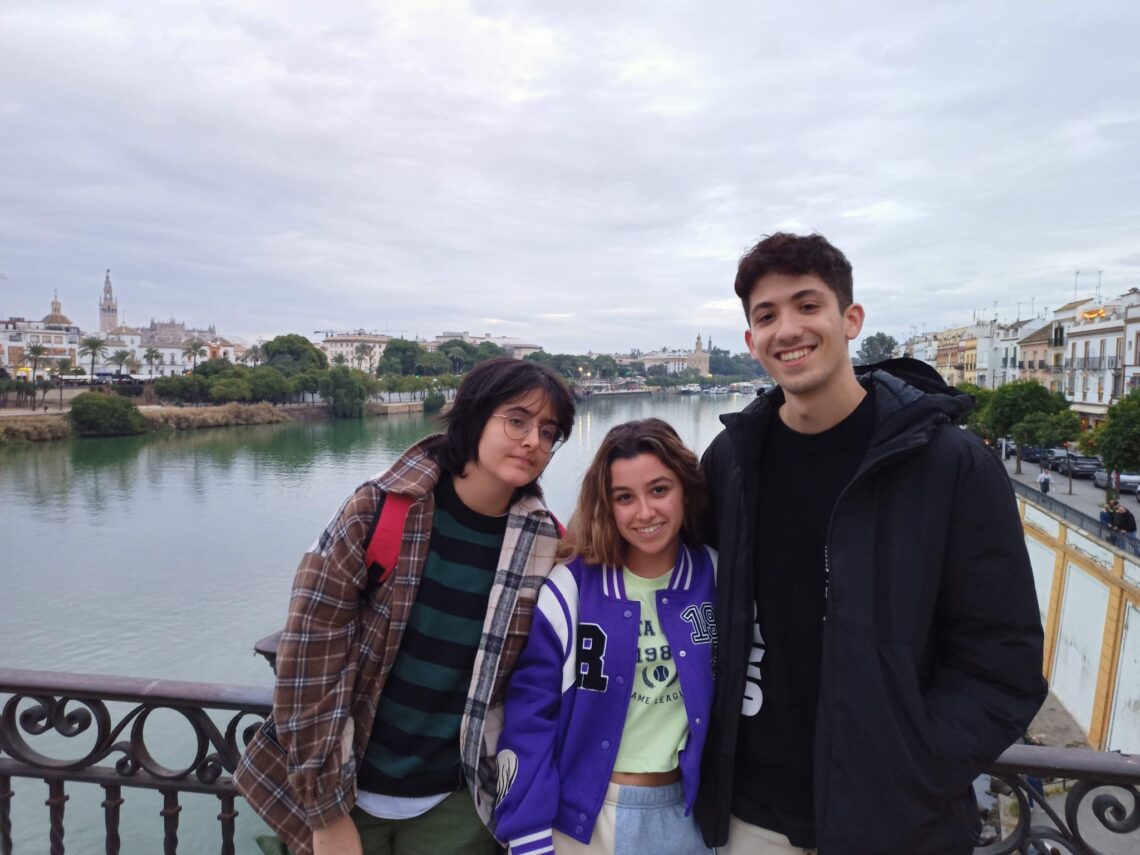
Are you ready to explore with us? We’re back with another captivating article, this time delving into the wonders of Spain. Join us as we embark on a fascinating journey with Marina, a genuine enthusiast of his home country.
Meet Marina!
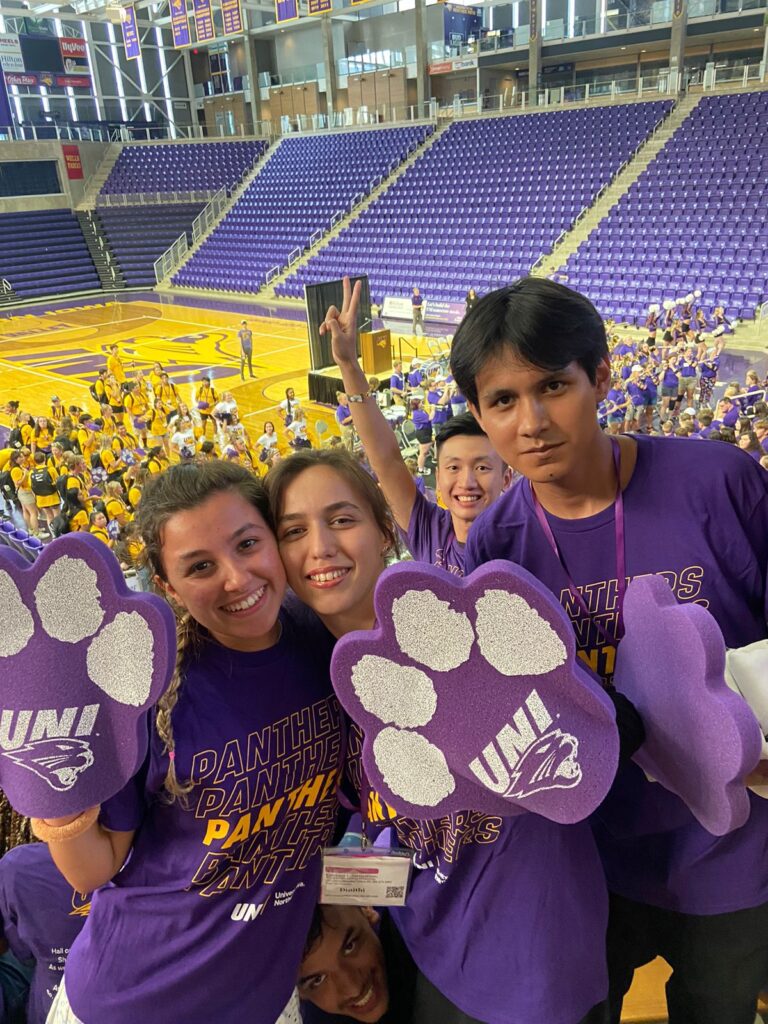
¡Hola! Soy Marina, una chica de 20 años de España, y actualmente estoy viviendo mi sueño estudiando biología en una universidad de Estados Unidos durante este fall semester. Esta es la primera vez que estoy lejos de casa, y déjenme decirles que ¡está siendo una experiencia increíble! Explorar un nuevo país, conocer gente nueva y sumergirme en la cultura estadounidense ha sido emocionante. Estoy realmente disfrutando de mi tiempo aquí. La universidad me está dando la oportunidad de sumergirme en el mundo fascinante de la biología, lo cual me apasiona. Las clases son desafiantes, pero cada día aprendo algo nuevo y emocionante. Lo mejor de todo es la conexión que he establecido con mis amigos. Pasamos mucho tiempo juntos, ya sea en actividades académicas o simplemente divirtiéndonos. La idea de estar lejos de casa inicialmente me asustaba un poco, pero gracias a la amistad y apoyo de mis compañeros, me siento como en casa. Mis días suelen estar llenos de aventuras, desde explorar nuevos lugares hasta sumergirme en eventos universitarios. La experiencia de vivir en Estados Unidos no solo me está enseñando sobre biología, sino también sobre mí misma y sobre la vida en general. Estoy ansiosa por ver qué más me depara este tiempo en la universidad y continuar disfrutando de cada momento.
Hello! I’m Marina, a 20-year-old girl from Spain, and currently, I’m living my dream studying biology at a university in the United States during this fall semester. This is the first time I’m away from home, and let me tell you, it’s been an incredible experience! Exploring a new country, meeting new people, and immersing myself in American culture has been exciting. I’m really enjoying my time here. The university is giving me the opportunity to delve into the fascinating world of biology, which I’m passionate about. The classes are challenging, but every day I learn something new and exciting. The best part is the connection I’ve established with my friends. We spend a lot of time together, whether it’s in academic activities or just having fun. The idea of being far from home initially scared me a bit, but thanks to the friendship and support of my peers, I feel at home. My days are usually filled with adventures, from exploring new places to immersing myself in university events. The experience of living in the United States is not only teaching me about biology but also about myself and life in general. I’m eager to see what else this time at university has in store for me and to continue enjoying every moment.
Marina Giménez Cases – Transfer Student
Before delving deeper into Spain…
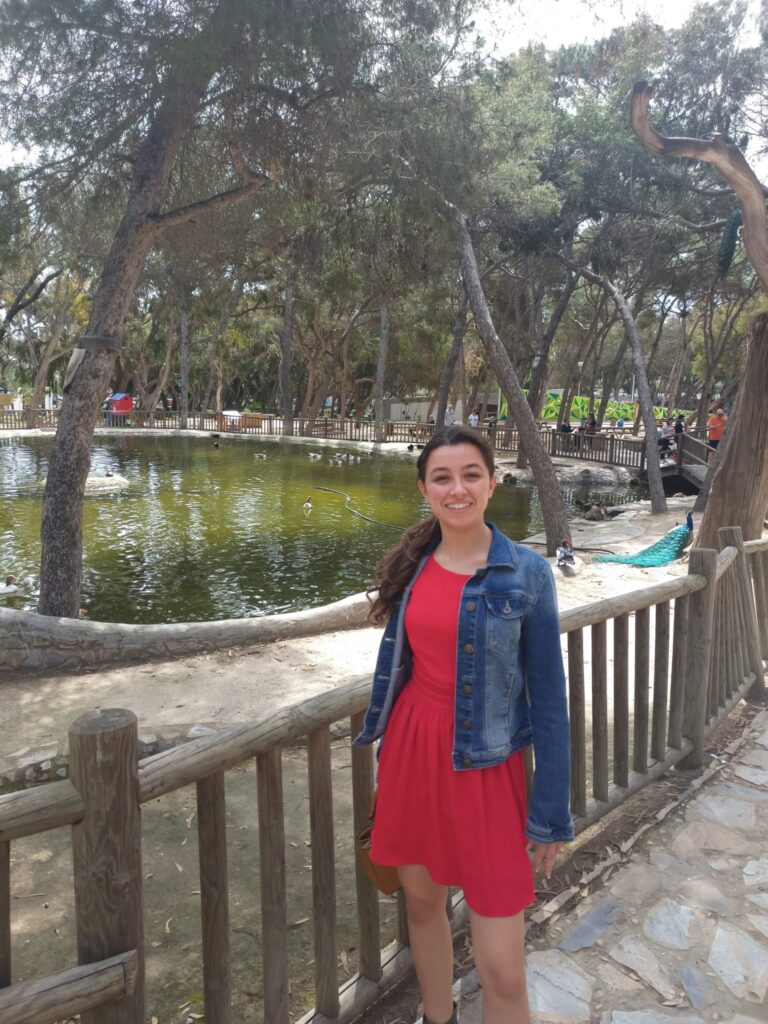
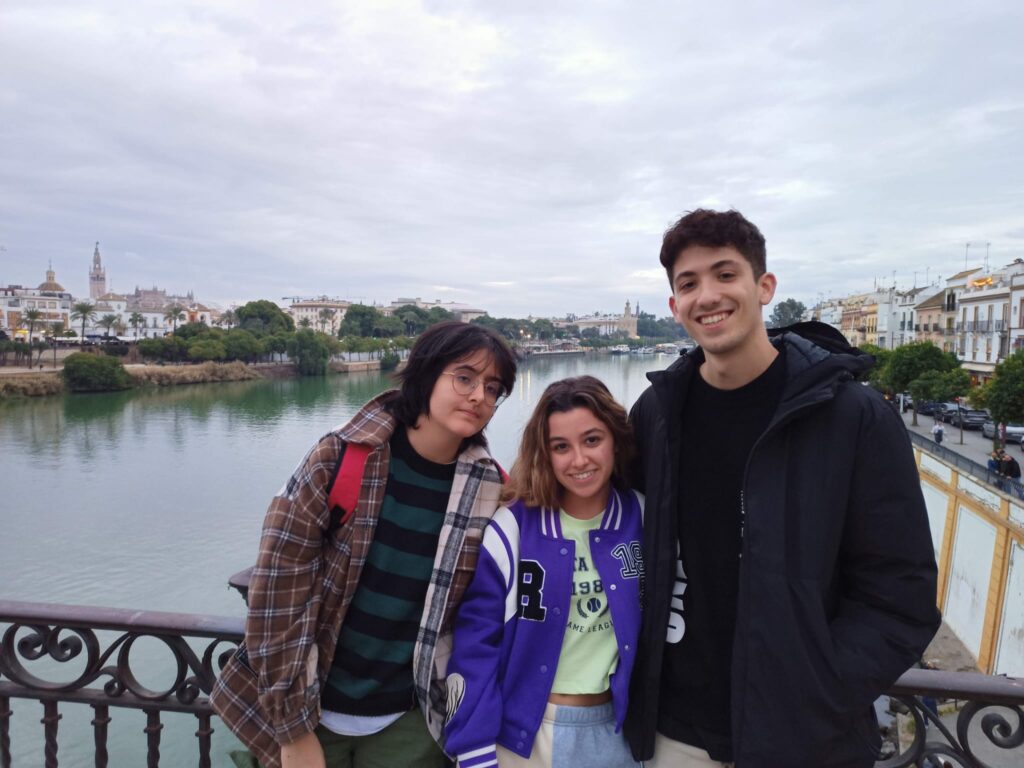
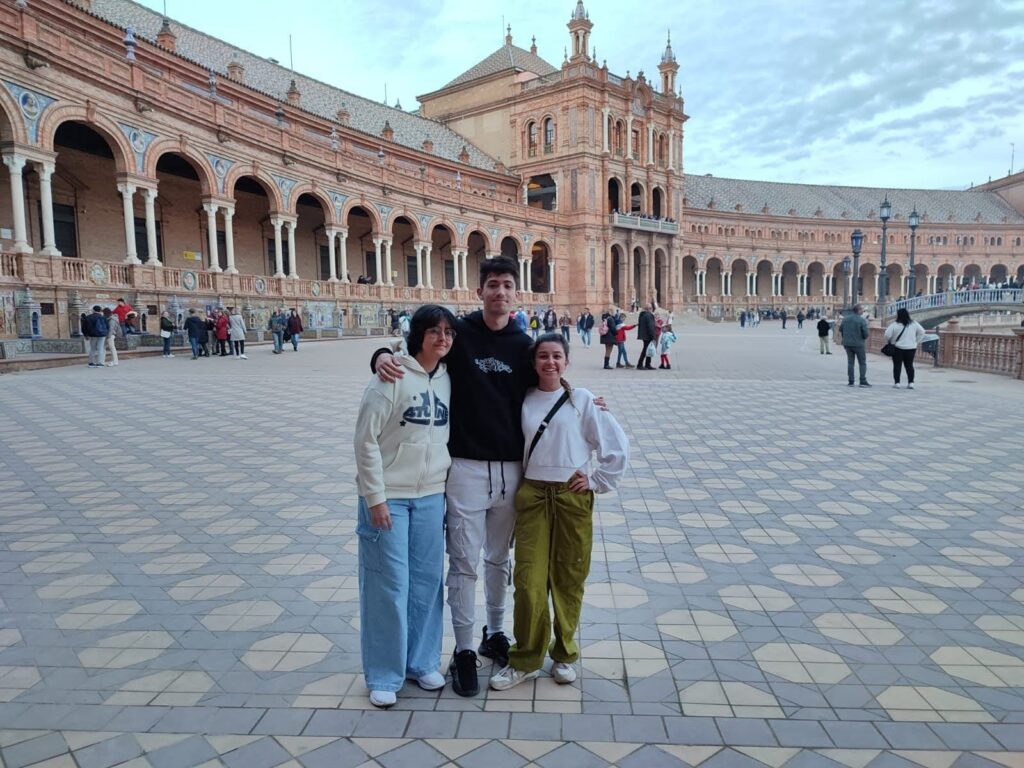

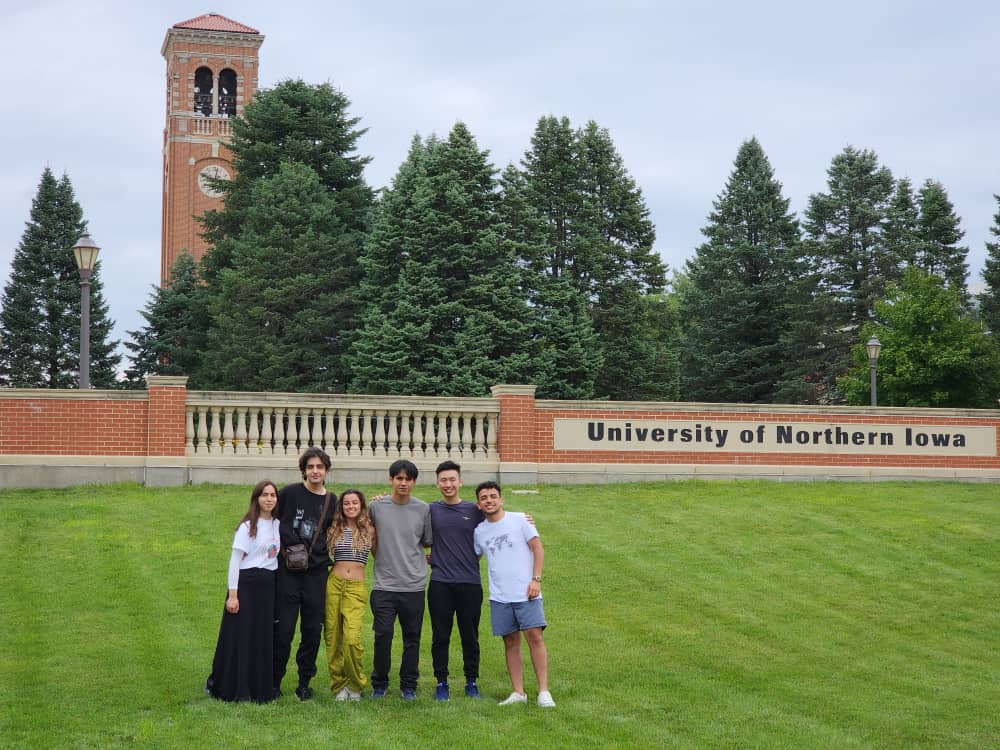
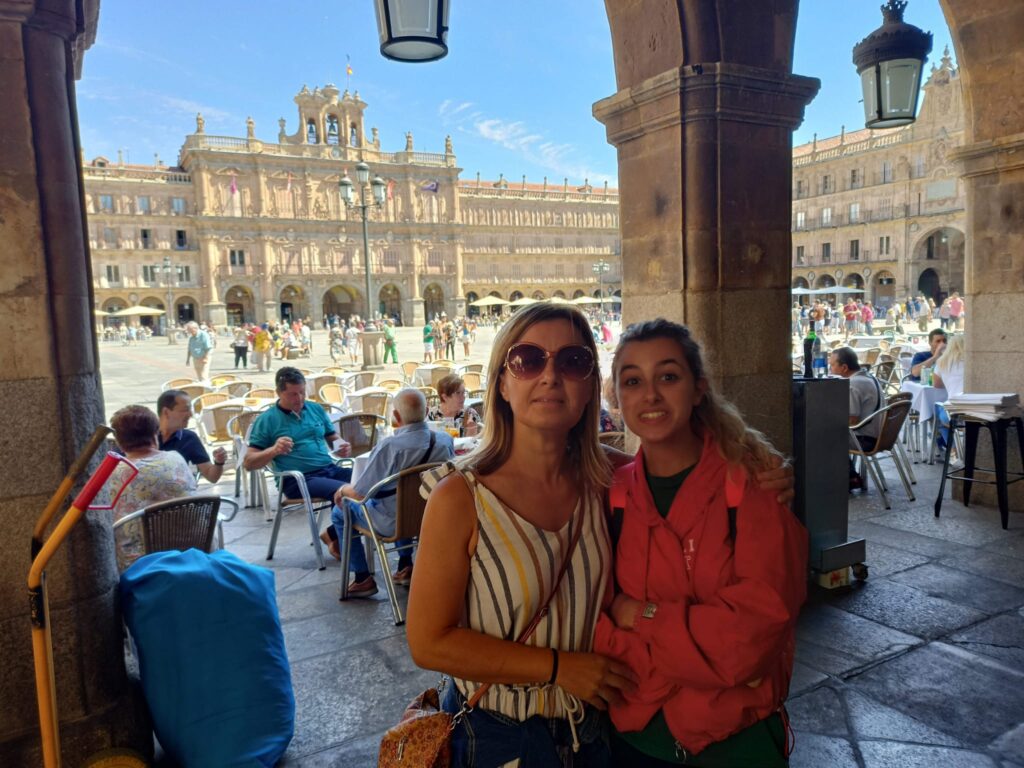
Where is Spain?

Spain is a country located in southwestern Europe on the Iberian Peninsula. It shares the Iberian Peninsula with Portugal and is bordered by the Atlantic Ocean and the Bay of Biscay to the northwest, the Mediterranean Sea to the east and southeast, and France and Andorra to the northeast. The capital and largest city of Spain is Madrid.
Places to visit in Spain!
Spain is a country rich in history, culture, and diverse landscapes, offering a wide array of destinations for travelers. Here are some notable places to visit in Spain:
Barcelona
Barcelona is a vibrant and culturally rich city located on the northeastern coast of the Iberian Peninsula in Spain. It is the capital and largest city of the Catalonia region
- Explore the unique architecture of Antoni Gaudí, including the Sagrada Familia and Park Güell.
- Walk along La Rambla, visit the historic Gothic Quarter, and enjoy the vibrant atmosphere of the city.
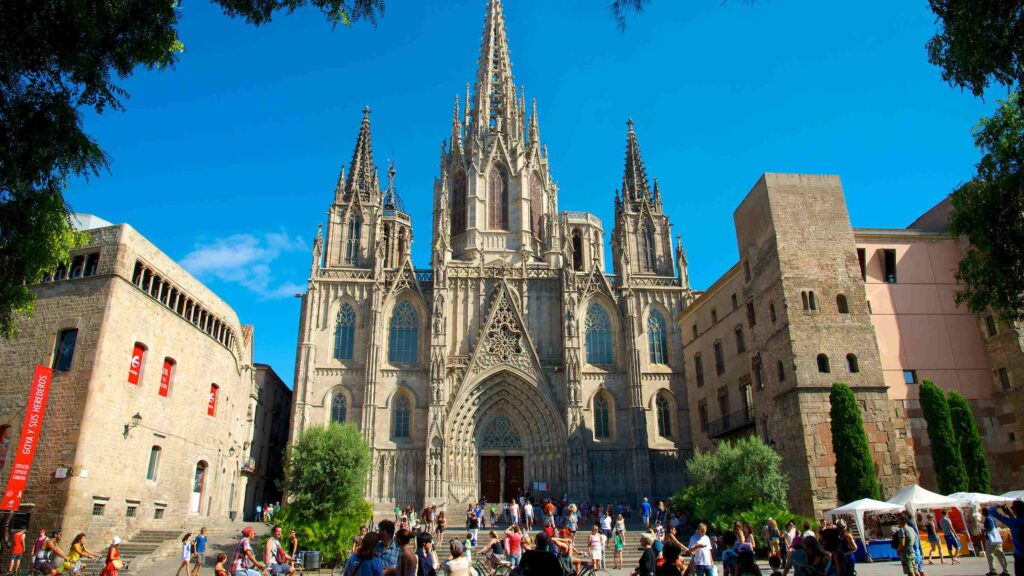
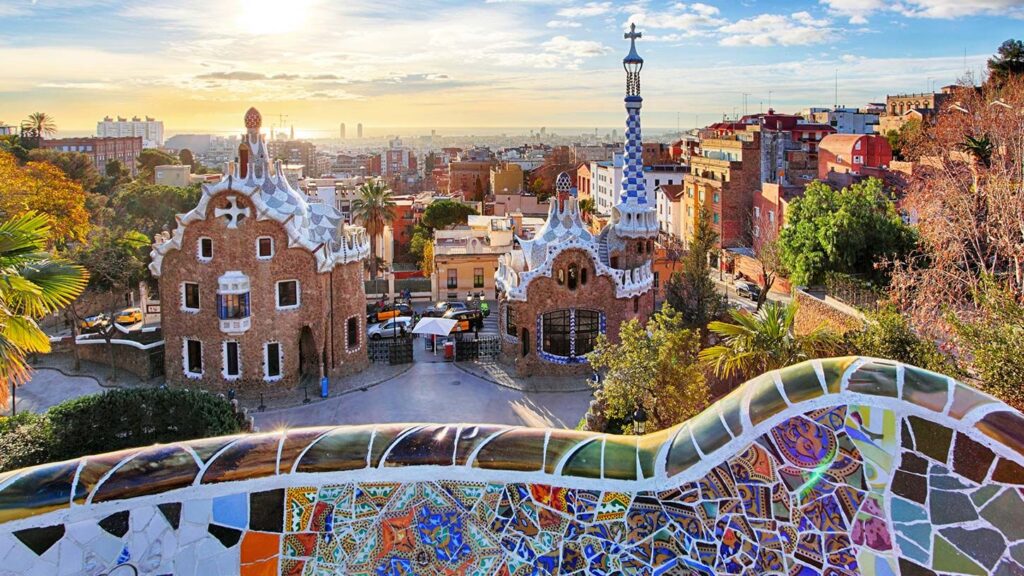
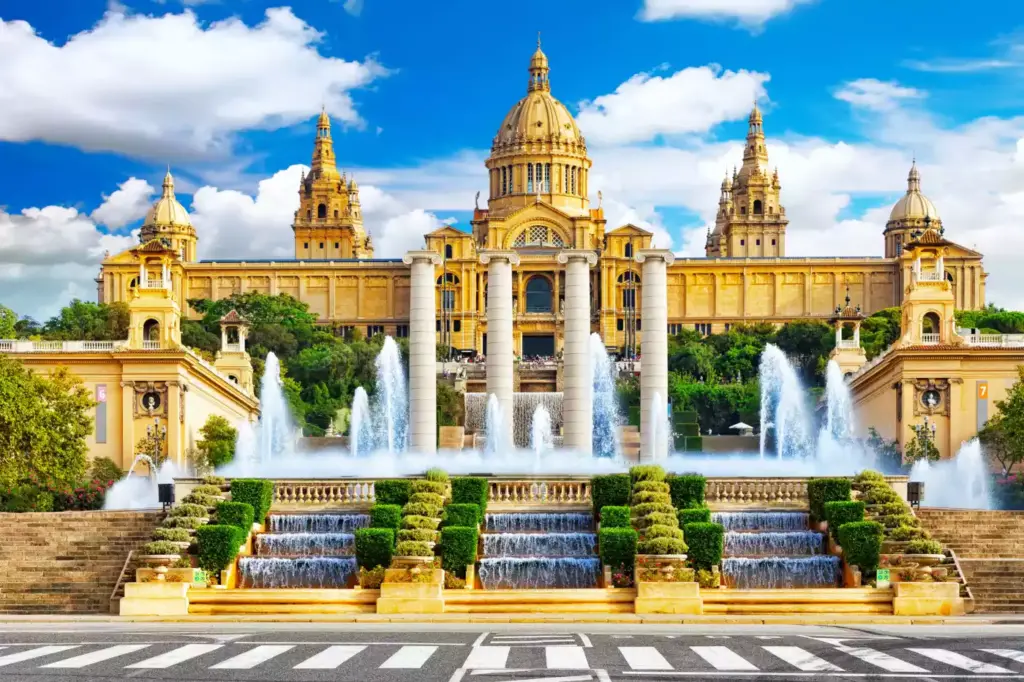
Madrid
Madrid is the capital and largest city of Spain, located in the heart of the country.
- Visit the Prado Museum, Reina Sofia Museum, and Thyssen-Bornemisza Museum for an art-filled experience.
- Explore the historic neighborhoods, like La Latina and Malasaña, and stroll through the Retiro Park.
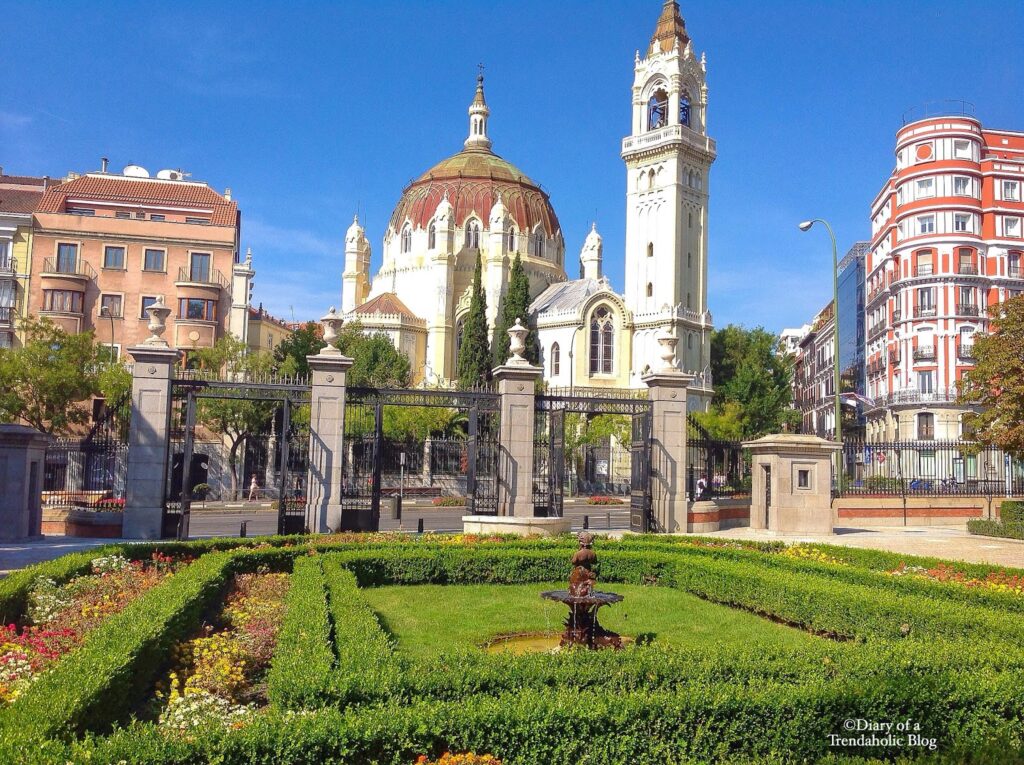

Seville
Seville, located in the southern part of Spain, is the capital and largest city of the autonomous community of Andalusia. It is known for its rich history, cultural heritage, and vibrant atmosphere.
- Marvel at the intricate architecture of the Alcazar of Seville and the Seville Cathedral.
- Enjoy the lively atmosphere of the Barrio Santa Cruz and experience traditional flamenco performances.
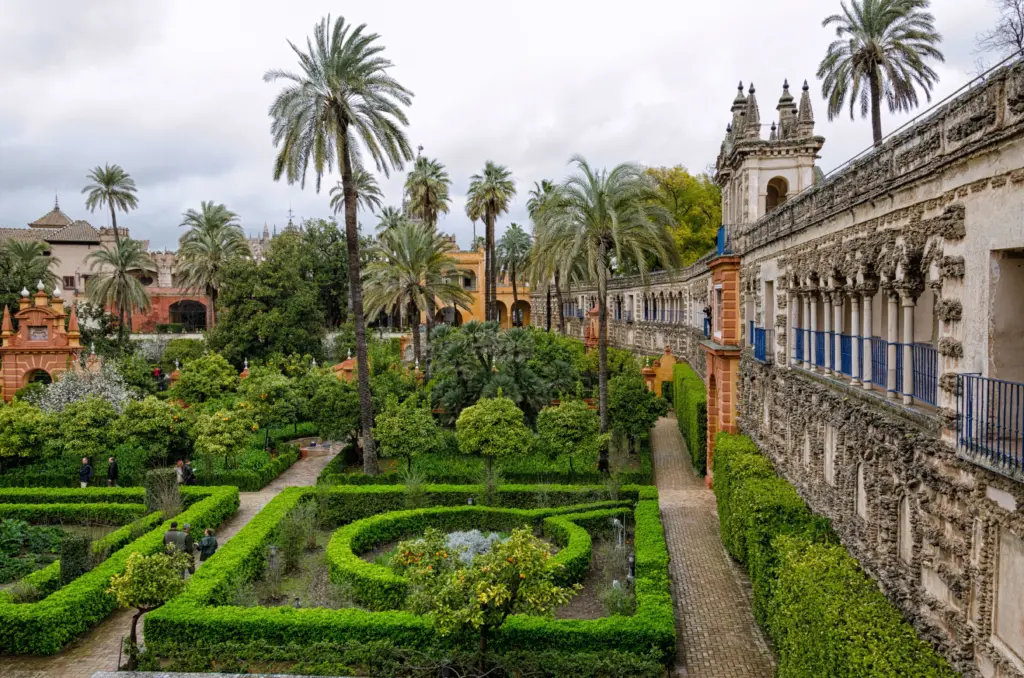
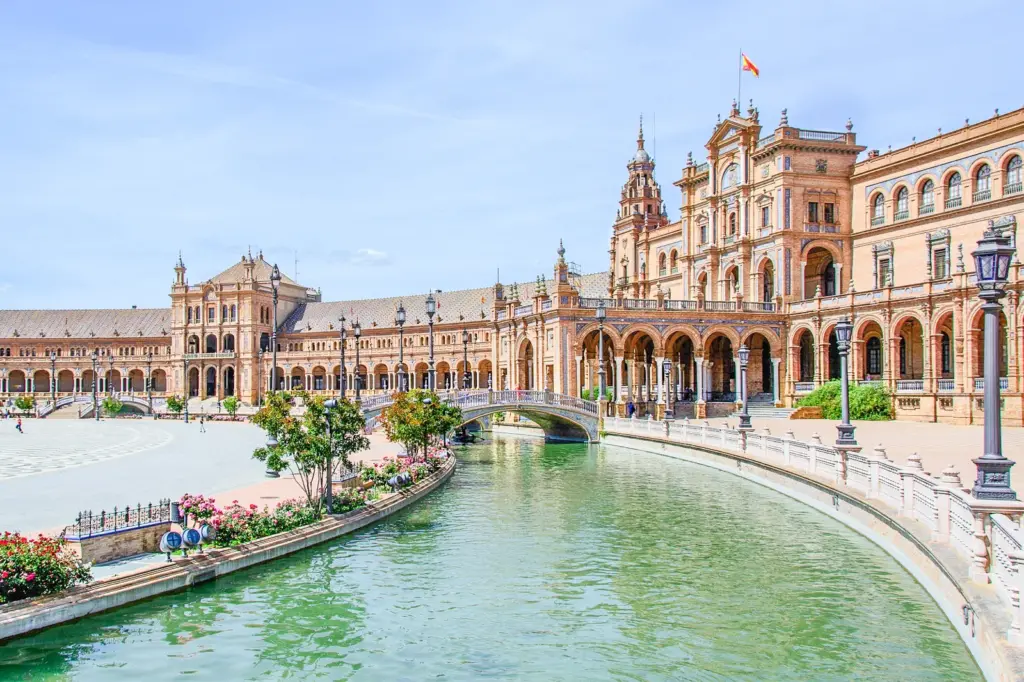
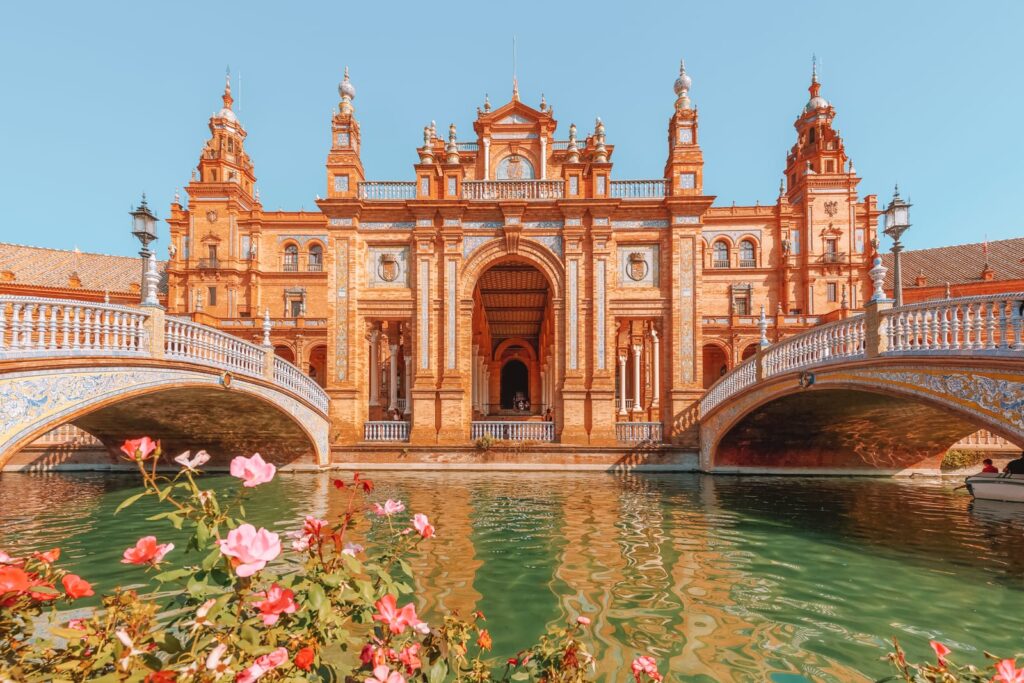
Ibiza
Ibiza is one of the Balearic Islands, which is an archipelago in the Mediterranean Sea. It belongs to Spain and is known for its vibrant nightlife, beautiful beaches, and historical sites.
- Experience the vibrant nightlife, beautiful beaches, and historic sites on this Balearic Island.
- Visit the Dalt Vila (Old Town) and enjoy the picturesque landscapes.
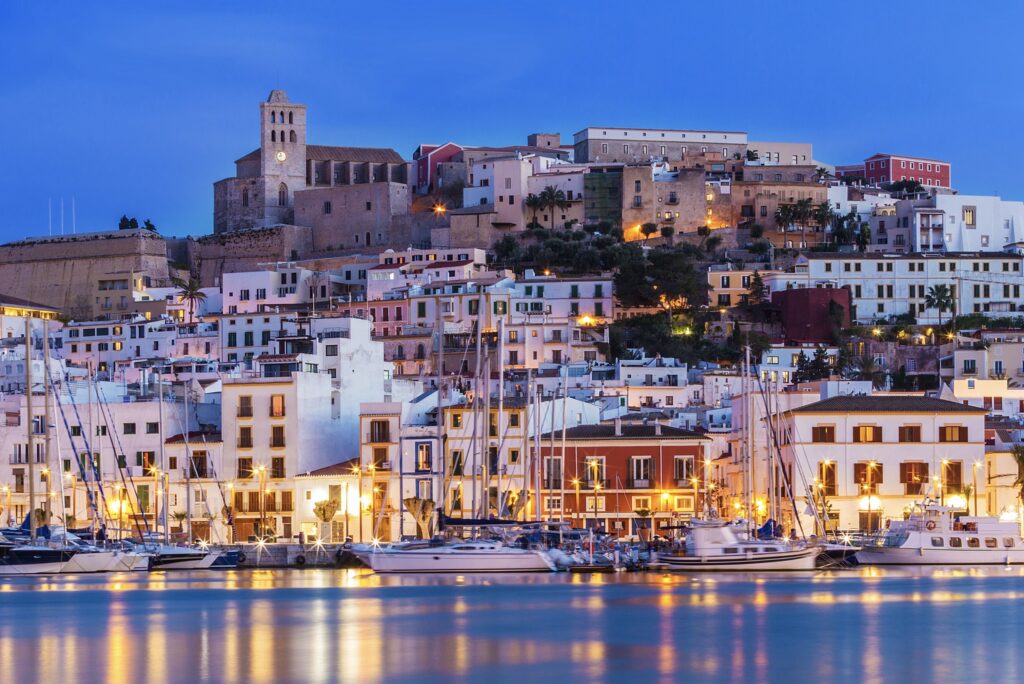
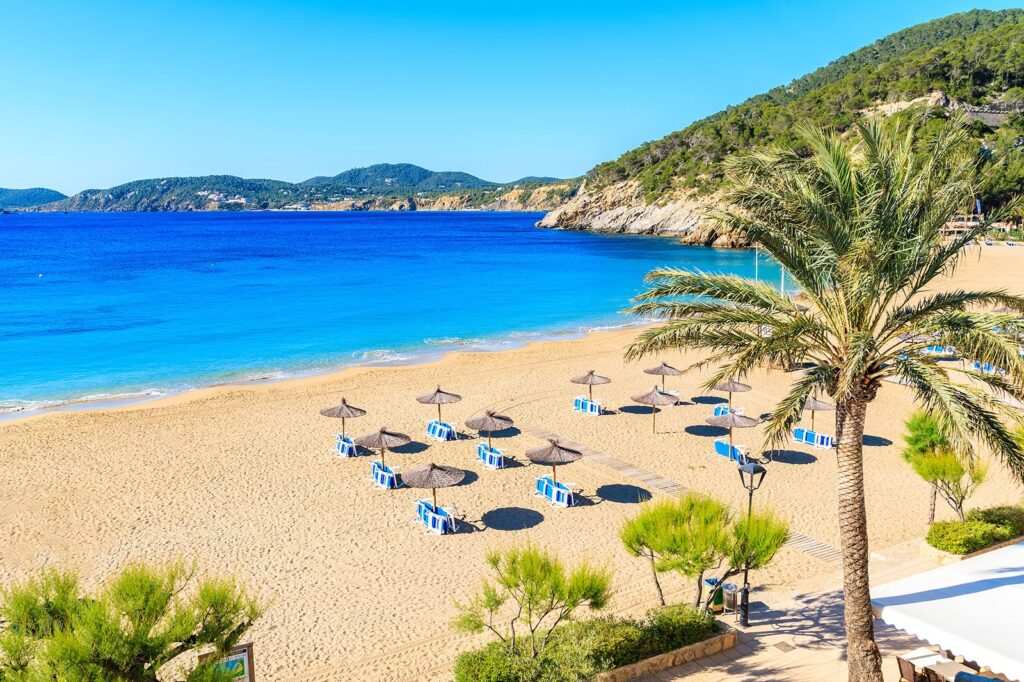
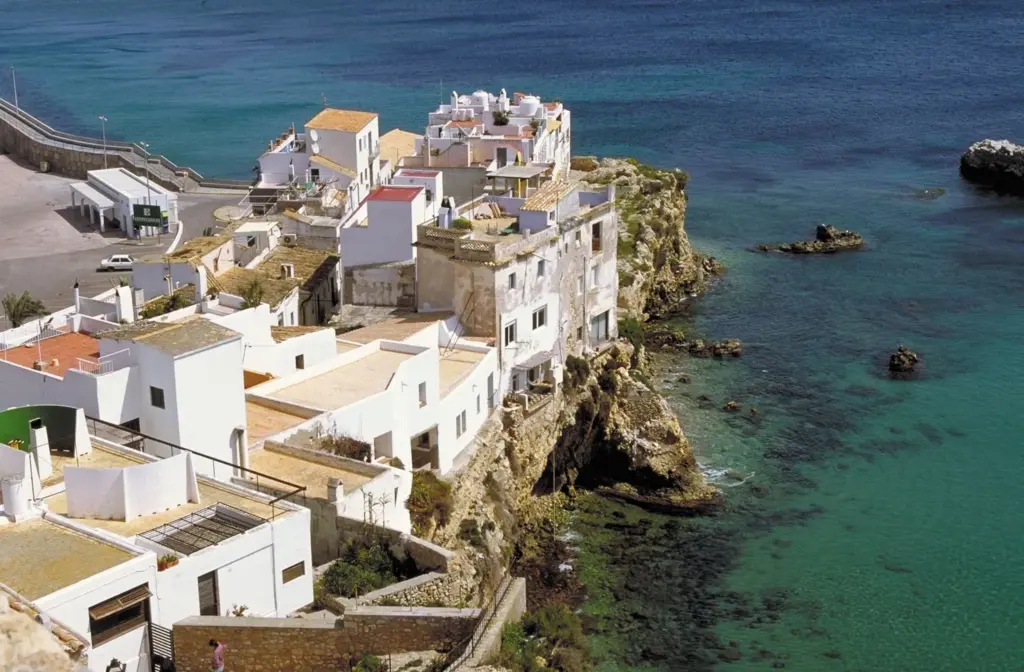
Mallorca
Mallorca, also spelled Majorca, is the largest of the Balearic Islands, an archipelago in the Mediterranean Sea that is part of Spain.
- Relax on the stunning beaches, explore charming villages, and hike in the Tramuntana Mountains.
- Visit the historic Palma Cathedral and Bellver Castle.
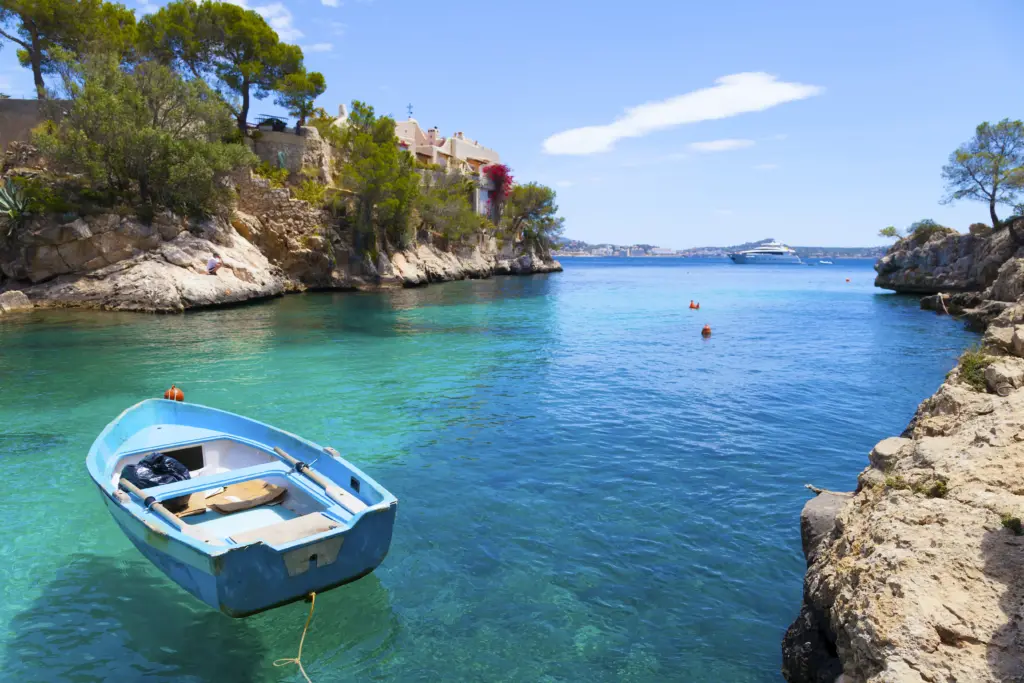
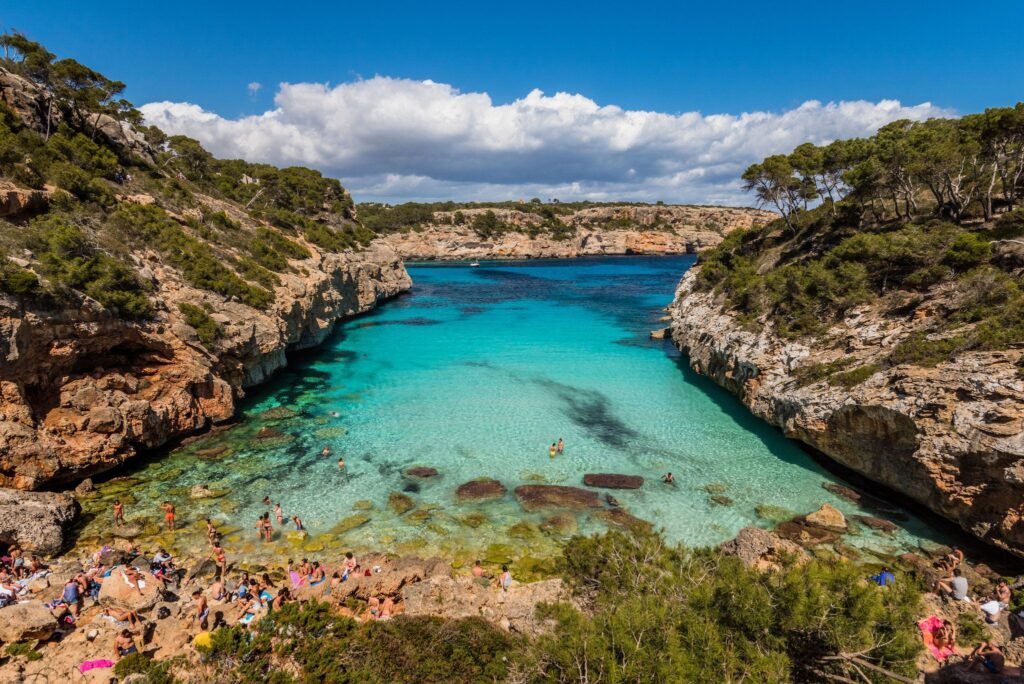
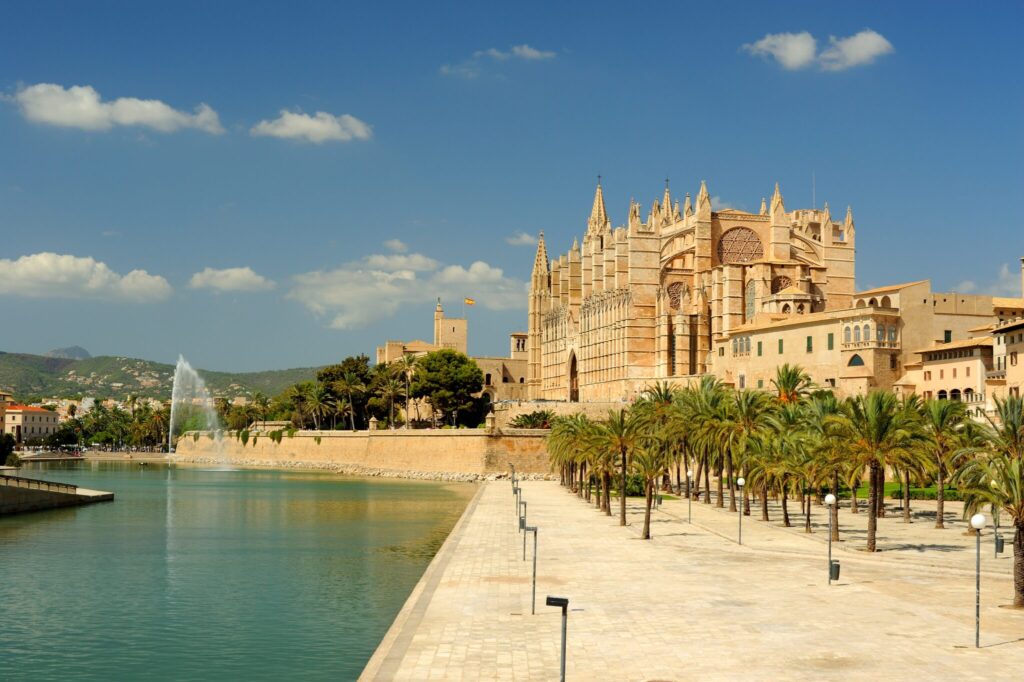
Some of Spain’s traditional food
Paella
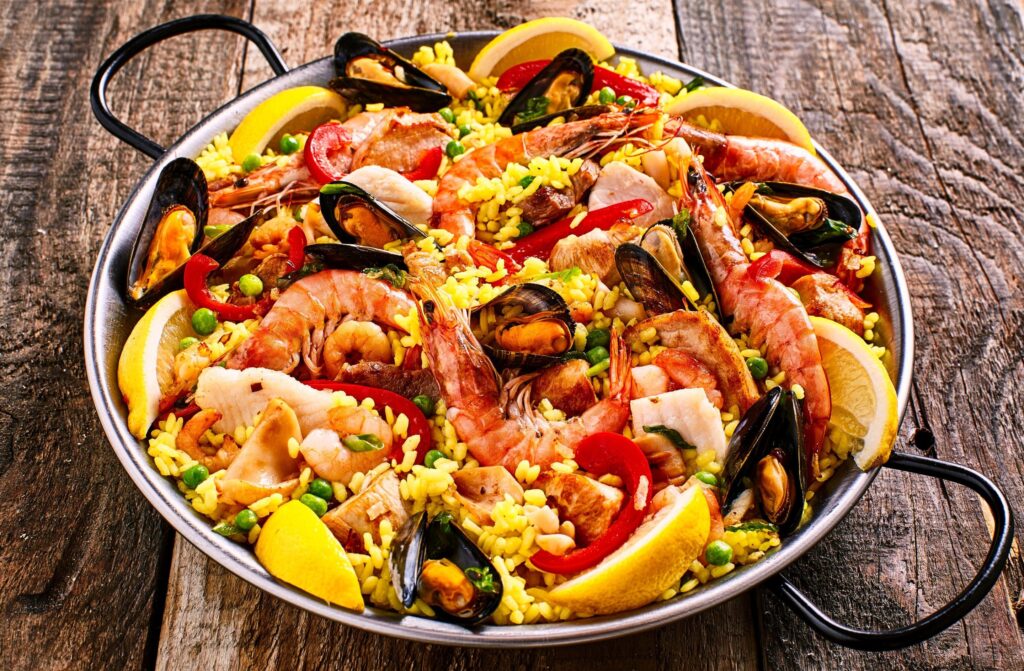
A famous Valencian rice dish cooked with saffron and a variety of ingredients, such as seafood, chicken, rabbit, or vegetables.
Tapas
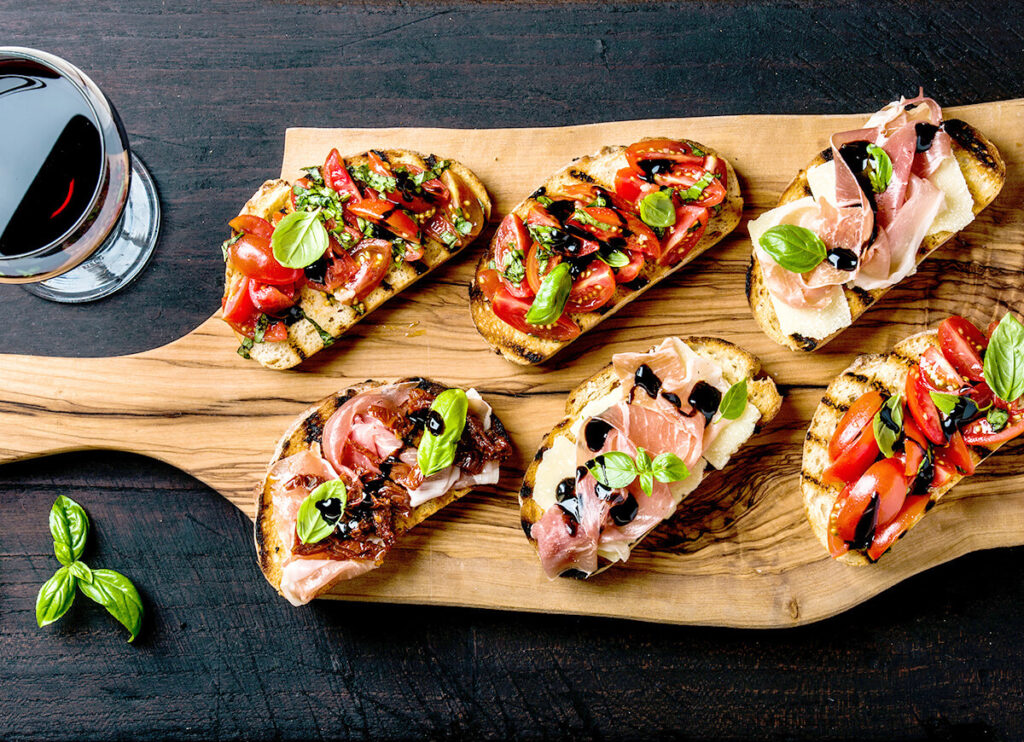
Small, appetizer-sized dishes that can include a wide range of options like patatas bravas (fried potatoes with spicy tomato sauce), gambas al ajillo (garlic shrimp), and albondigas (meatballs).
Churros con Chocolate
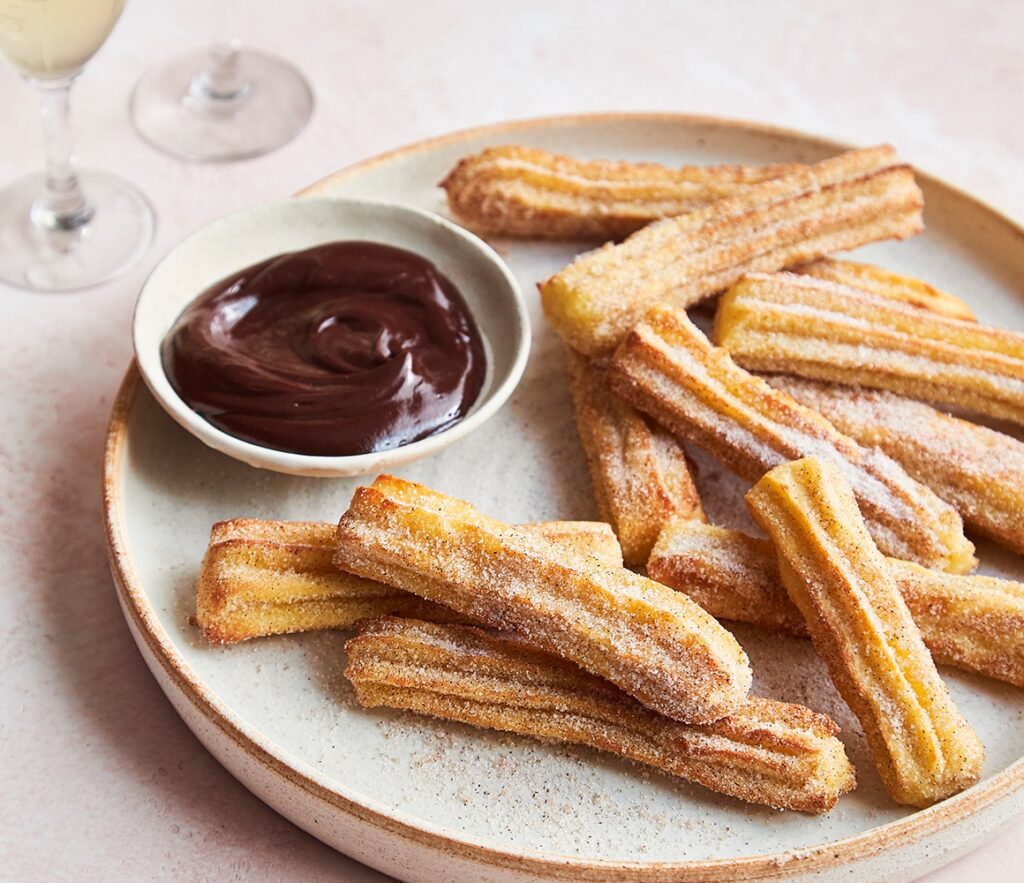 Churros: Churros are a type of fried dough pastry, often enjoyed for breakfast or as a snack. They are made from a simple dough of flour, water, and salt, which is piped through a star-shaped nozzle and then deep-fried until golden brown. The result is a crispy exterior and a soft, doughy interior. Churros are typically dusted with sugar and sometimes cinnamon.
Churros: Churros are a type of fried dough pastry, often enjoyed for breakfast or as a snack. They are made from a simple dough of flour, water, and salt, which is piped through a star-shaped nozzle and then deep-fried until golden brown. The result is a crispy exterior and a soft, doughy interior. Churros are typically dusted with sugar and sometimes cinnamon.
Chocolate: Churros are commonly served with a cup of thick, rich hot chocolate for dipping. This chocolate is not the same as the sweet, sugary chocolate you might find in a candy bar. Spanish hot chocolate is dense and almost pudding-like, making it the perfect companion for the crunchy churros.
Crema Catalana
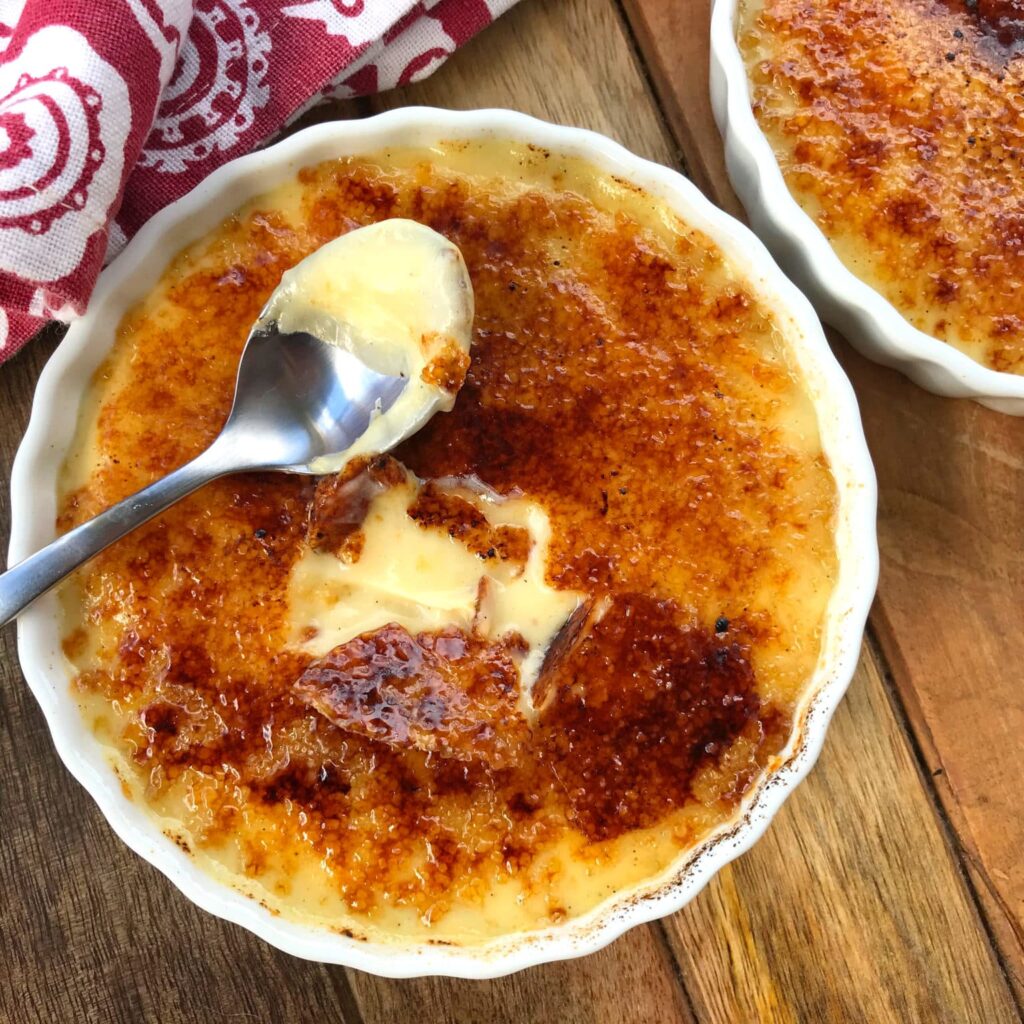
Crema Catalana is a traditional Catalan dessert that is similar to crème brûlée. It’s a creamy and indulgent custard dessert with a smooth texture and a layer of caramelized sugar on top. Here’s more about this delicious dessert:
Ingredients:
- Milk
- Sugar
- Egg yolks
- Cornstarch or flour
- Lemon or orange zest
- Cinnamon
Traditional Costumes in Spain
Spain has a rich tradition of regional diversity, and this is reflected in the variety of traditional costumes worn in different parts of the country. Here are a few examples of traditional Spanish costumes:
Flamenco Dress (Andalusia):
- Andalusia, especially the region of Seville, is famous for its traditional Flamenco dress. Women wear vibrant, ruffled dresses with layers of fabric and intricate patterns. The dress is often paired with a flower in the hair and a fan.
Traje de Fallera (Valencia):
- The traditional costume worn during the Fallas festival in Valencia is called the “Traje de Fallera.” It includes a white, high-waisted gown adorned with colorful embroidery and silk ribbons. Elaborate headpieces known as “tocado” are also worn.
Chulapo and Chulapa (Madrid):
- In Madrid, the traditional attire is known as “Chulapo” for men and “Chulapa” for women. Chulapos wear a flat-brimmed hat, a waistcoat, a shirt, and trousers, while Chulapas wear a printed dress with a matching apron.
Galician Costume (Galicia):
- In Galicia, traditional costumes for women include colorful skirts, blouses, and headscarves, often complemented by gold jewelry. Men may wear a white shirt, black trousers, and a flat hat.
Serrana Dress (Andalusia – Sierra Nevada):
- In the Sierra Nevada region of Andalusia, women traditionally wear the “Serrana” dress. This consists of a long, flowing skirt, a short jacket, and a headscarf.
Islas Canarias Costume (Canary Islands):
- Traditional costumes in the Canary Islands are often bright and colorful. Women may wear long, full skirts with matching blouses, and men might wear white shirts with wide-brimmed hats.
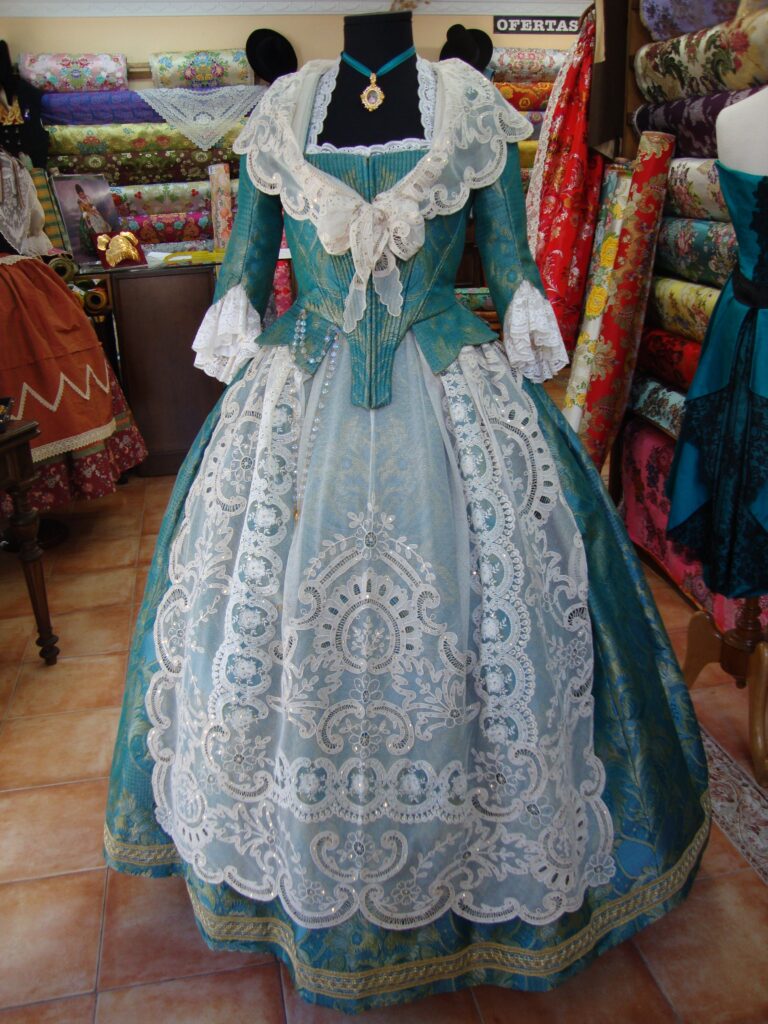
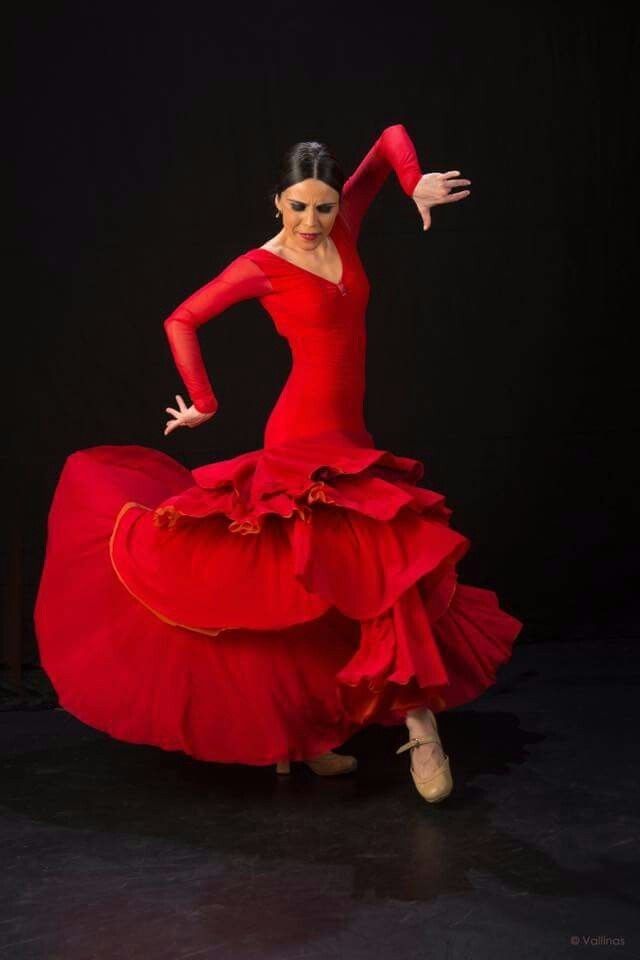
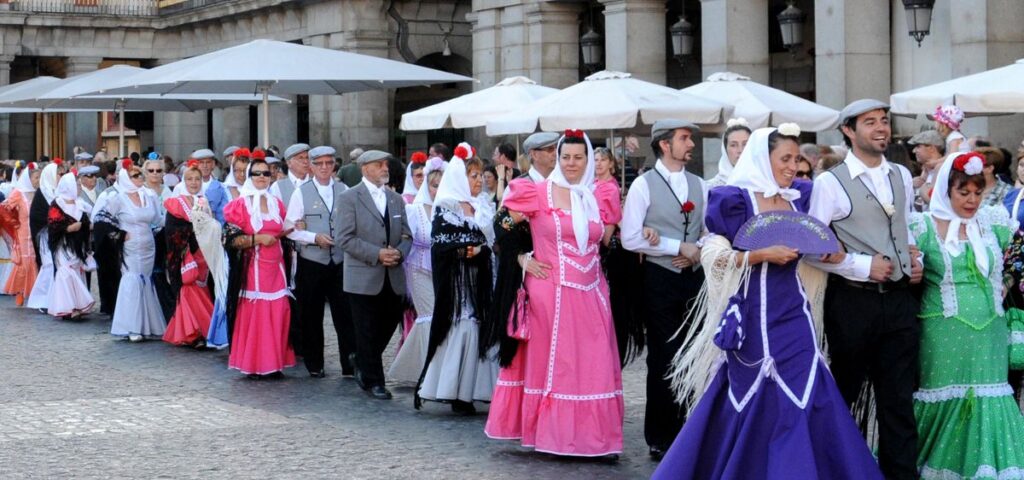
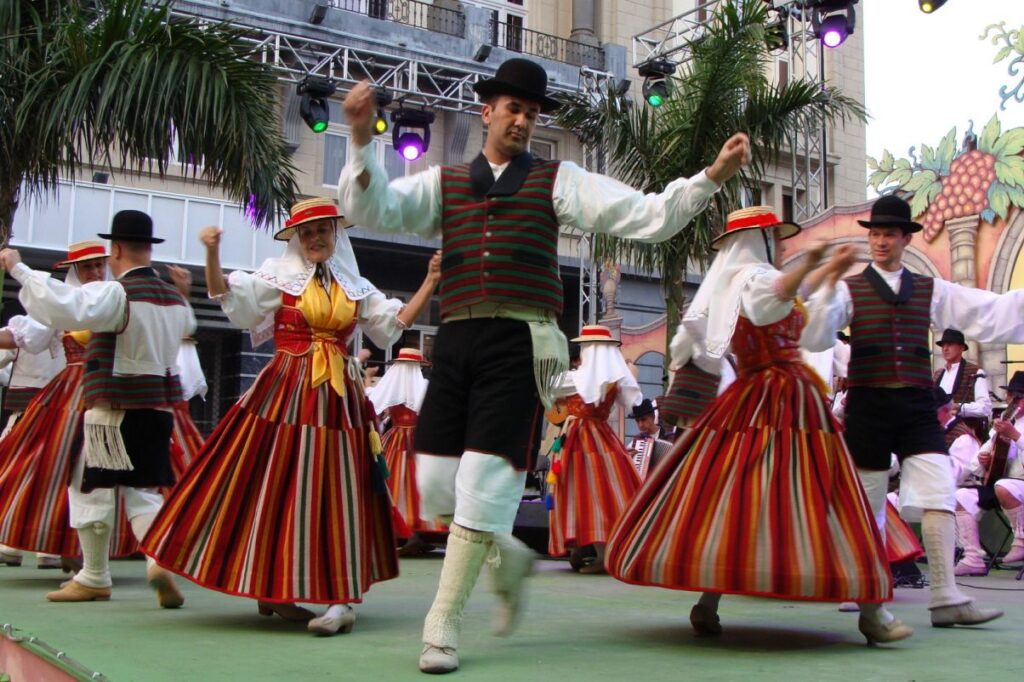

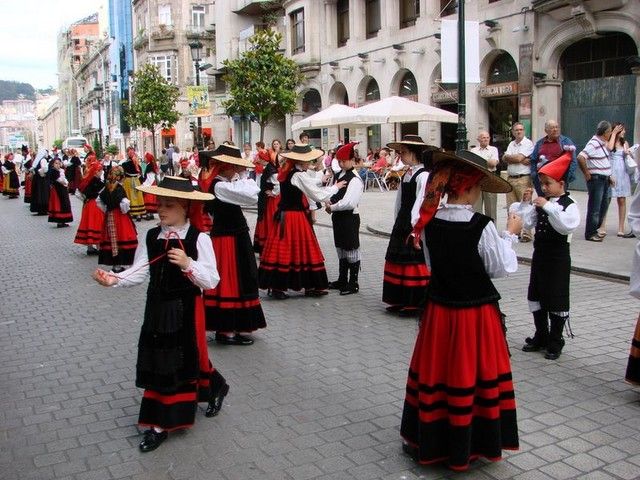
Festivals in Spain
La Mercè (Barcelona):
- La Mercè is the annual festival of Barcelona, celebrated in September. It includes a variety of events, such as processions, concerts, and traditional Catalan activities.
San Isidro (Madrid):
- Celebrated in May, San Isidro is the patron saint festival of Madrid. It features traditional dances, processions, and various cultural events.
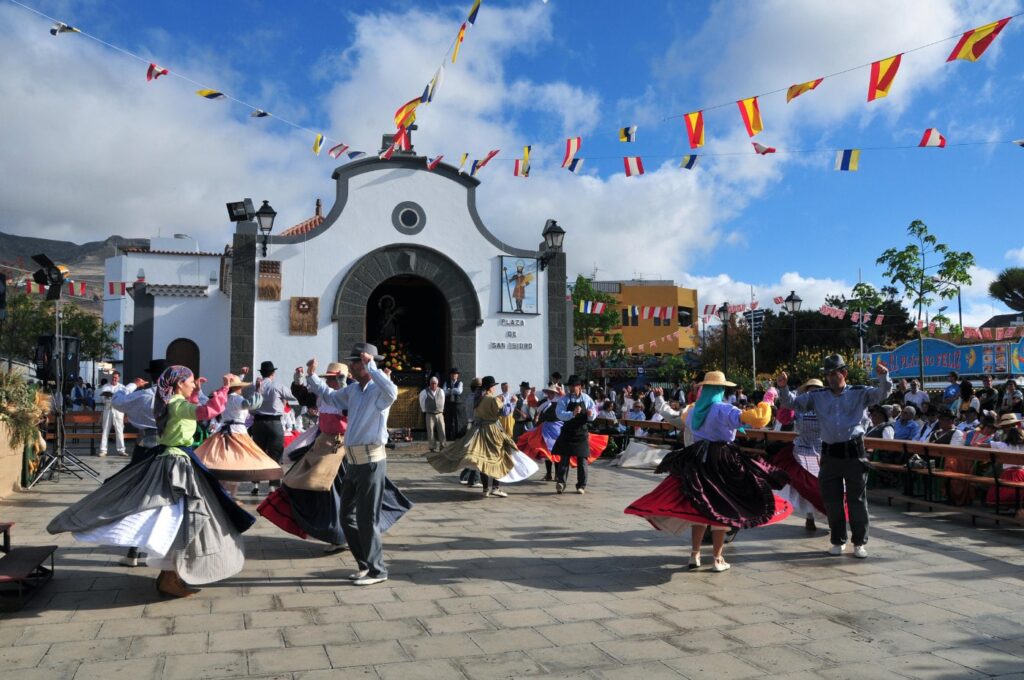
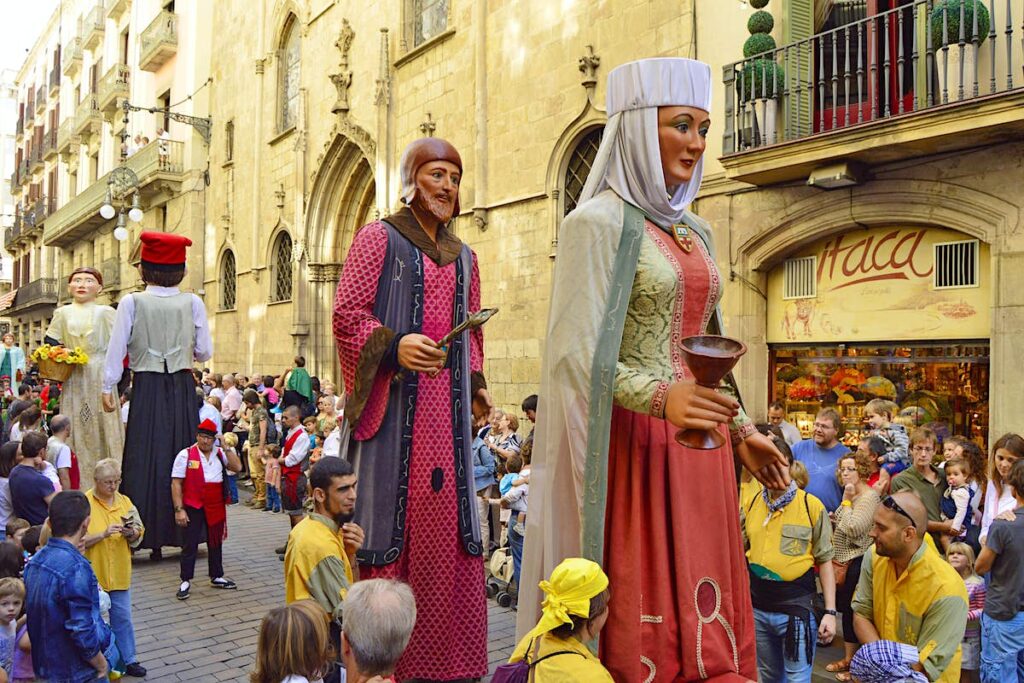
Córdoba Patio Festival (Córdoba):
- The Córdoba Patio Festival, held in May, showcases the beauty of the city’s patios, adorned with colorful flowers. It is part of the May Crosses Festival.
Dia de los Reyes (Three Kings’ Day):
- Celebrated on January 6th, Dia de los Reyes marks the arrival of the Three Wise Men. Parades and festivities take place across the country.
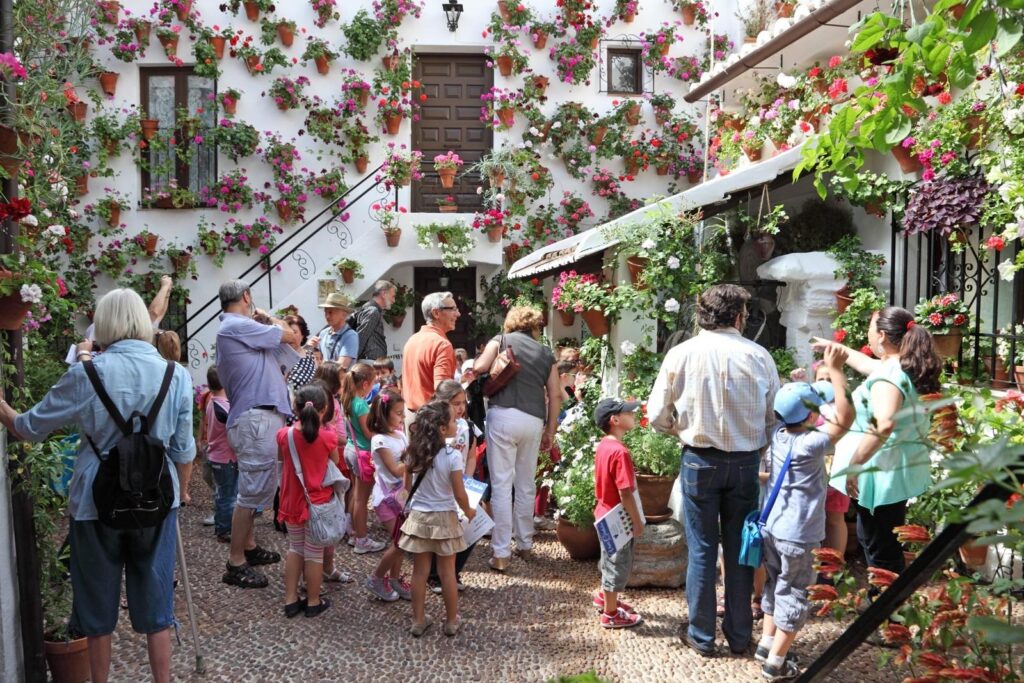
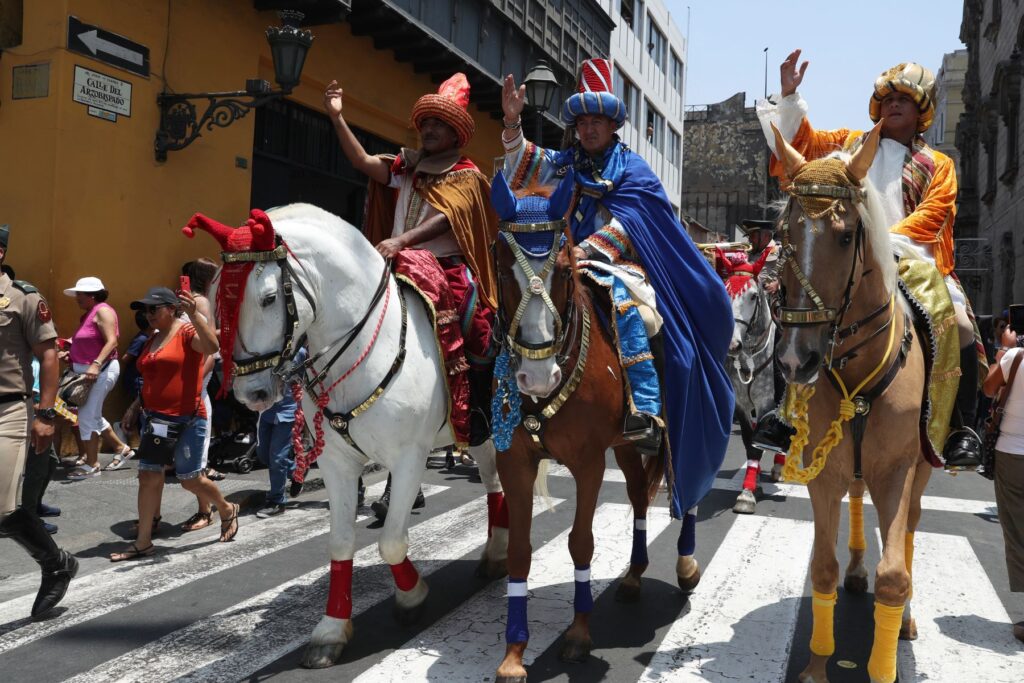
Traditional arts and crafts in Spain
Flamenco Crafts:
- Flamenco, a traditional Spanish art form, has inspired various crafts. Flamenco shawls, fans (abanicos), and castanets (castañuelas) are often intricately crafted and are part of the flamenco dance tradition.
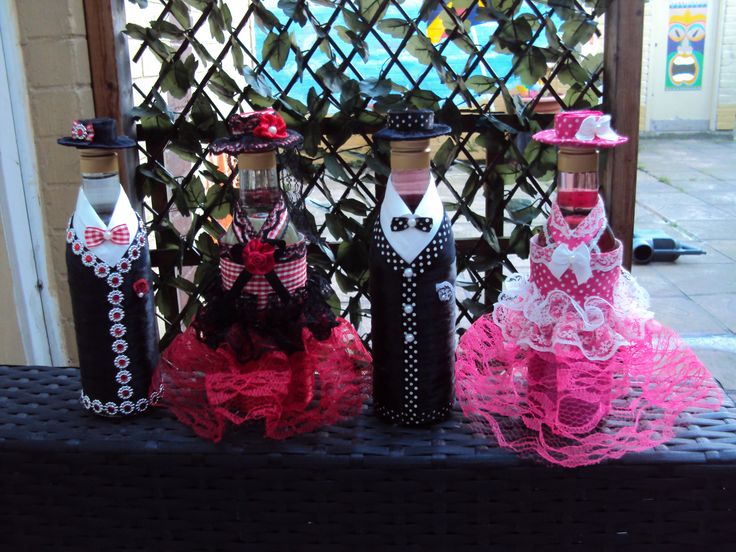
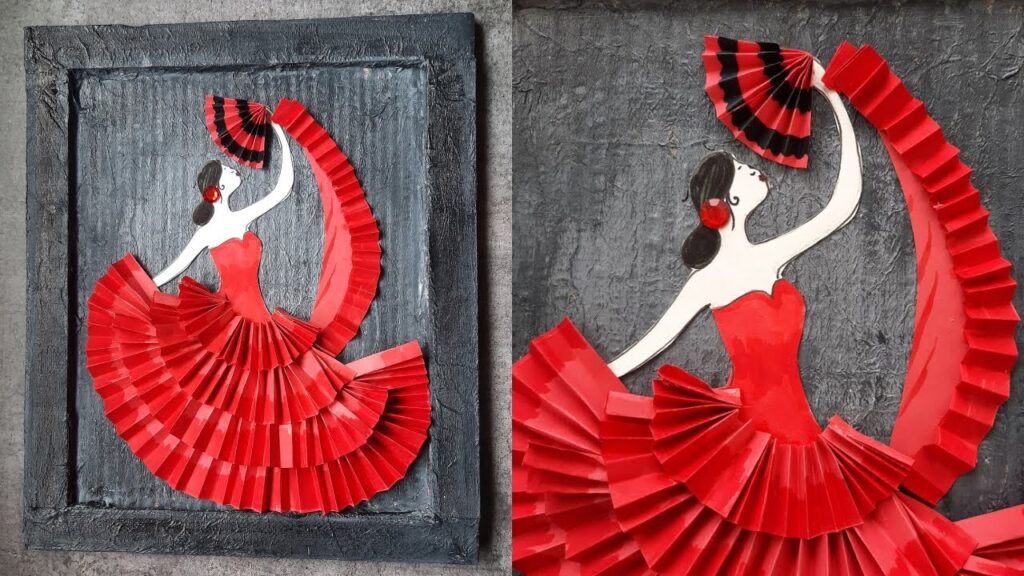
Traditional Embroidery:
- Various regions in Spain have a strong tradition of embroidery. Intricate designs are often found on traditional clothing, including mantillas, shawls, and regional costumes.
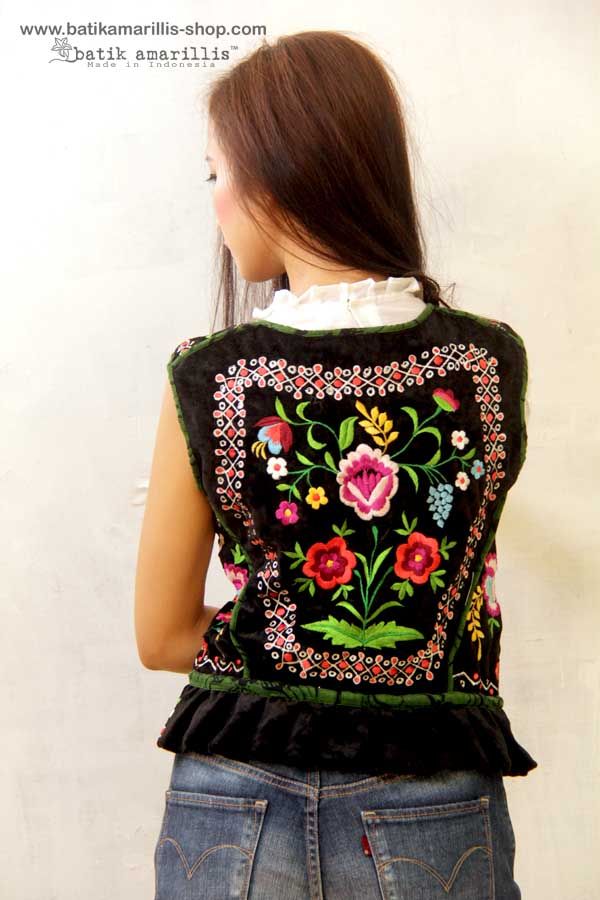
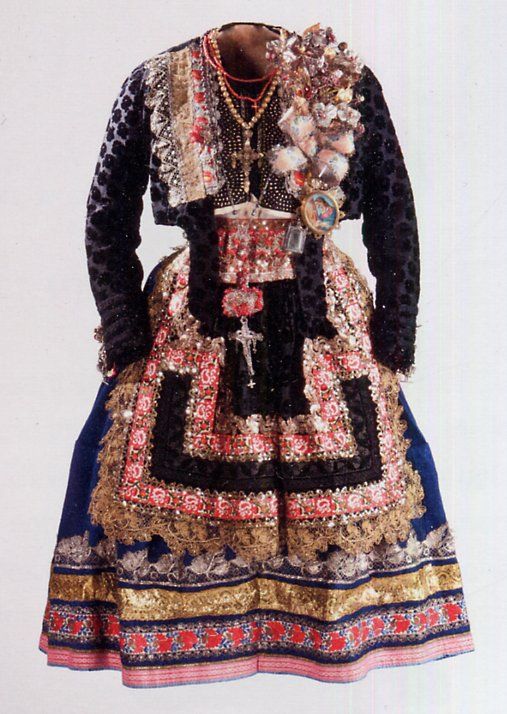
Fun Facts about Spain
Siesta Culture:
- Spain is famous for its siestas, a short nap or break taken in the early afternoon. It’s a tradition in many regions, especially in warmer areas, to escape the heat of the day.
Second-Largest Producer of Wine:
- Spain is the second-largest wine producer in the world, after Italy. The country has a rich wine culture, with various regions known for their unique varieties.
The Invention of the Chupa Chups Lollipop:
- The popular Chupa Chups lollipop was invented by Enric Bernat, a Spaniard, in 1958. The name “Chupa Chups” means “suck, suck” in Spanish.
The World’s Oldest Restaurant:
- Sobrino de Botín, located in Madrid, holds the Guinness World Record for the world’s oldest restaurant. It has been operating since 1725.
Tomato Fight:
- La Tomatina, an annual festival in Buñol, Valencia, involves a massive tomato fight. Thousands of people participate in throwing overripe tomatoes at each other in the streets.
Diverse Languages:
- Spain has several official languages in addition to Spanish. Catalan, Galician, and Basque are recognized as co-official languages in their respective regions.
World’s Largest Olive Oil Producer:
- Spain is the world’s largest producer of olive oil. Olive trees are a significant part of the country’s agriculture, especially in regions like Andalusia.
The “Matter of Spain”:
- In Spanish, the phrase “El asunto de España” (The Matter of Spain) was historically used to refer to complex or confusing matters. It gained prominence during international negotiations in the 17th century.
If you want to learn more about Nepal check here!

Are you ready to explore with us? We’re back with another captivating article, this time delving into the wonders of Spain. Join us as we embark on a fascinating journey with Marina, a genuine enthusiast of his home country.
Meet Marina!

¡Hola! Soy Marina, una chica de 20 años de España, y actualmente estoy viviendo mi sueño estudiando biología en una universidad de Estados Unidos durante este fall semester. Esta es la primera vez que estoy lejos de casa, y déjenme decirles que ¡está siendo una experiencia increíble! Explorar un nuevo país, conocer gente nueva y sumergirme en la cultura estadounidense ha sido emocionante. Estoy realmente disfrutando de mi tiempo aquí. La universidad me está dando la oportunidad de sumergirme en el mundo fascinante de la biología, lo cual me apasiona. Las clases son desafiantes, pero cada día aprendo algo nuevo y emocionante. Lo mejor de todo es la conexión que he establecido con mis amigos. Pasamos mucho tiempo juntos, ya sea en actividades académicas o simplemente divirtiéndonos. La idea de estar lejos de casa inicialmente me asustaba un poco, pero gracias a la amistad y apoyo de mis compañeros, me siento como en casa. Mis días suelen estar llenos de aventuras, desde explorar nuevos lugares hasta sumergirme en eventos universitarios. La experiencia de vivir en Estados Unidos no solo me está enseñando sobre biología, sino también sobre mí misma y sobre la vida en general. Estoy ansiosa por ver qué más me depara este tiempo en la universidad y continuar disfrutando de cada momento.
Hello! I’m Marina, a 20-year-old girl from Spain, and currently, I’m living my dream studying biology at a university in the United States during this fall semester. This is the first time I’m away from home, and let me tell you, it’s been an incredible experience! Exploring a new country, meeting new people, and immersing myself in American culture has been exciting. I’m really enjoying my time here. The university is giving me the opportunity to delve into the fascinating world of biology, which I’m passionate about. The classes are challenging, but every day I learn something new and exciting. The best part is the connection I’ve established with my friends. We spend a lot of time together, whether it’s in academic activities or just having fun. The idea of being far from home initially scared me a bit, but thanks to the friendship and support of my peers, I feel at home. My days are usually filled with adventures, from exploring new places to immersing myself in university events. The experience of living in the United States is not only teaching me about biology but also about myself and life in general. I’m eager to see what else this time at university has in store for me and to continue enjoying every moment.
Marina Giménez Cases – Transfer Student
Before delving deeper into Spain…






Where is Spain?

Spain is a country located in southwestern Europe on the Iberian Peninsula. It shares the Iberian Peninsula with Portugal and is bordered by the Atlantic Ocean and the Bay of Biscay to the northwest, the Mediterranean Sea to the east and southeast, and France and Andorra to the northeast. The capital and largest city of Spain is Madrid.
Places to visit in Spain!
Spain is a country rich in history, culture, and diverse landscapes, offering a wide array of destinations for travelers. Here are some notable places to visit in Spain:
Barcelona
Barcelona is a vibrant and culturally rich city located on the northeastern coast of the Iberian Peninsula in Spain. It is the capital and largest city of the Catalonia region
- Explore the unique architecture of Antoni Gaudí, including the Sagrada Familia and Park Güell.
- Walk along La Rambla, visit the historic Gothic Quarter, and enjoy the vibrant atmosphere of the city.



Madrid
Madrid is the capital and largest city of Spain, located in the heart of the country.
- Visit the Prado Museum, Reina Sofia Museum, and Thyssen-Bornemisza Museum for an art-filled experience.
- Explore the historic neighborhoods, like La Latina and Malasaña, and stroll through the Retiro Park.


Seville
Seville, located in the southern part of Spain, is the capital and largest city of the autonomous community of Andalusia. It is known for its rich history, cultural heritage, and vibrant atmosphere.
- Marvel at the intricate architecture of the Alcazar of Seville and the Seville Cathedral.
- Enjoy the lively atmosphere of the Barrio Santa Cruz and experience traditional flamenco performances.



Ibiza
Ibiza is one of the Balearic Islands, which is an archipelago in the Mediterranean Sea. It belongs to Spain and is known for its vibrant nightlife, beautiful beaches, and historical sites.
- Experience the vibrant nightlife, beautiful beaches, and historic sites on this Balearic Island.
- Visit the Dalt Vila (Old Town) and enjoy the picturesque landscapes.



Mallorca
Mallorca, also spelled Majorca, is the largest of the Balearic Islands, an archipelago in the Mediterranean Sea that is part of Spain.
- Relax on the stunning beaches, explore charming villages, and hike in the Tramuntana Mountains.
- Visit the historic Palma Cathedral and Bellver Castle.



Some of Spain’s traditional food
Paella

A famous Valencian rice dish cooked with saffron and a variety of ingredients, such as seafood, chicken, rabbit, or vegetables.
Tapas

Small, appetizer-sized dishes that can include a wide range of options like patatas bravas (fried potatoes with spicy tomato sauce), gambas al ajillo (garlic shrimp), and albondigas (meatballs).
Churros con Chocolate
 Churros: Churros are a type of fried dough pastry, often enjoyed for breakfast or as a snack. They are made from a simple dough of flour, water, and salt, which is piped through a star-shaped nozzle and then deep-fried until golden brown. The result is a crispy exterior and a soft, doughy interior. Churros are typically dusted with sugar and sometimes cinnamon.
Churros: Churros are a type of fried dough pastry, often enjoyed for breakfast or as a snack. They are made from a simple dough of flour, water, and salt, which is piped through a star-shaped nozzle and then deep-fried until golden brown. The result is a crispy exterior and a soft, doughy interior. Churros are typically dusted with sugar and sometimes cinnamon.
Chocolate: Churros are commonly served with a cup of thick, rich hot chocolate for dipping. This chocolate is not the same as the sweet, sugary chocolate you might find in a candy bar. Spanish hot chocolate is dense and almost pudding-like, making it the perfect companion for the crunchy churros.
Crema Catalana

Crema Catalana is a traditional Catalan dessert that is similar to crème brûlée. It’s a creamy and indulgent custard dessert with a smooth texture and a layer of caramelized sugar on top. Here’s more about this delicious dessert:
Ingredients:
- Milk
- Sugar
- Egg yolks
- Cornstarch or flour
- Lemon or orange zest
- Cinnamon
Traditional Costumes in Spain
Spain has a rich tradition of regional diversity, and this is reflected in the variety of traditional costumes worn in different parts of the country. Here are a few examples of traditional Spanish costumes:
Flamenco Dress (Andalusia):
- Andalusia, especially the region of Seville, is famous for its traditional Flamenco dress. Women wear vibrant, ruffled dresses with layers of fabric and intricate patterns. The dress is often paired with a flower in the hair and a fan.
Traje de Fallera (Valencia):
- The traditional costume worn during the Fallas festival in Valencia is called the “Traje de Fallera.” It includes a white, high-waisted gown adorned with colorful embroidery and silk ribbons. Elaborate headpieces known as “tocado” are also worn.
Chulapo and Chulapa (Madrid):
- In Madrid, the traditional attire is known as “Chulapo” for men and “Chulapa” for women. Chulapos wear a flat-brimmed hat, a waistcoat, a shirt, and trousers, while Chulapas wear a printed dress with a matching apron.
Galician Costume (Galicia):
- In Galicia, traditional costumes for women include colorful skirts, blouses, and headscarves, often complemented by gold jewelry. Men may wear a white shirt, black trousers, and a flat hat.
Serrana Dress (Andalusia – Sierra Nevada):
- In the Sierra Nevada region of Andalusia, women traditionally wear the “Serrana” dress. This consists of a long, flowing skirt, a short jacket, and a headscarf.
Islas Canarias Costume (Canary Islands):
- Traditional costumes in the Canary Islands are often bright and colorful. Women may wear long, full skirts with matching blouses, and men might wear white shirts with wide-brimmed hats.






Festivals in Spain
La Mercè (Barcelona):
- La Mercè is the annual festival of Barcelona, celebrated in September. It includes a variety of events, such as processions, concerts, and traditional Catalan activities.
San Isidro (Madrid):
- Celebrated in May, San Isidro is the patron saint festival of Madrid. It features traditional dances, processions, and various cultural events.


Córdoba Patio Festival (Córdoba):
- The Córdoba Patio Festival, held in May, showcases the beauty of the city’s patios, adorned with colorful flowers. It is part of the May Crosses Festival.
Dia de los Reyes (Three Kings’ Day):
- Celebrated on January 6th, Dia de los Reyes marks the arrival of the Three Wise Men. Parades and festivities take place across the country.


Traditional arts and crafts in Spain
Flamenco Crafts:
- Flamenco, a traditional Spanish art form, has inspired various crafts. Flamenco shawls, fans (abanicos), and castanets (castañuelas) are often intricately crafted and are part of the flamenco dance tradition.


Traditional Embroidery:
- Various regions in Spain have a strong tradition of embroidery. Intricate designs are often found on traditional clothing, including mantillas, shawls, and regional costumes.


Fun Facts about Spain
Siesta Culture:
- Spain is famous for its siestas, a short nap or break taken in the early afternoon. It’s a tradition in many regions, especially in warmer areas, to escape the heat of the day.
Second-Largest Producer of Wine:
- Spain is the second-largest wine producer in the world, after Italy. The country has a rich wine culture, with various regions known for their unique varieties.
The Invention of the Chupa Chups Lollipop:
- The popular Chupa Chups lollipop was invented by Enric Bernat, a Spaniard, in 1958. The name “Chupa Chups” means “suck, suck” in Spanish.
The World’s Oldest Restaurant:
- Sobrino de Botín, located in Madrid, holds the Guinness World Record for the world’s oldest restaurant. It has been operating since 1725.
Tomato Fight:
- La Tomatina, an annual festival in Buñol, Valencia, involves a massive tomato fight. Thousands of people participate in throwing overripe tomatoes at each other in the streets.
Diverse Languages:
- Spain has several official languages in addition to Spanish. Catalan, Galician, and Basque are recognized as co-official languages in their respective regions.
World’s Largest Olive Oil Producer:
- Spain is the world’s largest producer of olive oil. Olive trees are a significant part of the country’s agriculture, especially in regions like Andalusia.
The “Matter of Spain”:
- In Spanish, the phrase “El asunto de España” (The Matter of Spain) was historically used to refer to complex or confusing matters. It gained prominence during international negotiations in the 17th century.
If you want to learn more about Nepal check here!
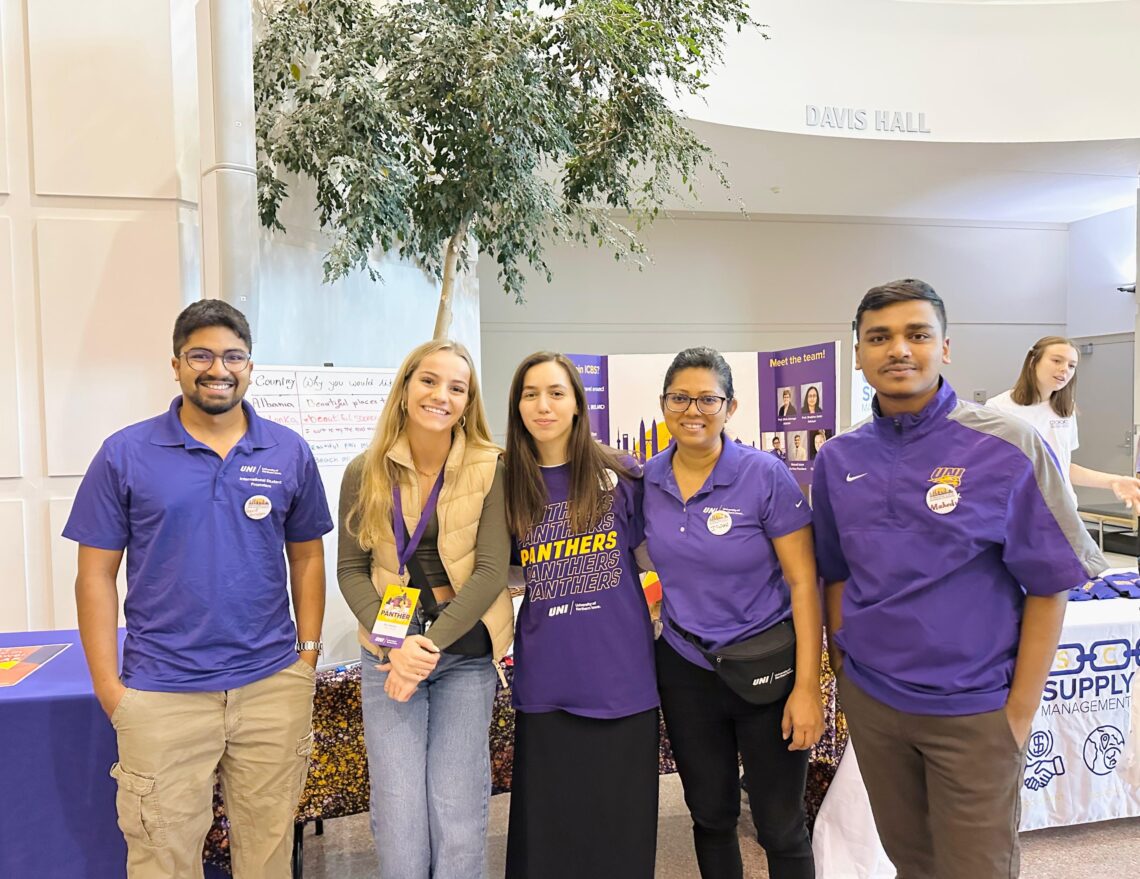
Ever wondered why getting involved on campus is the real deal? Well, buckle up because it’s not just about classes and grades. Getting into the campus scene is like unlocking a whole new level of awesome. Think personal growth, making friends, and having a blast – all part of the deal. From joining clubs to rocking events, it’s about turning your college ride into something unforgettable. So, grab a seat, and let’s spill the tea on why diving into campus life is the coolest thing you’ll do.
Now, let’s explore the top 10 reasons why you should be involved on campus clubs and associations.
01. Cultural Exchange
Student organizations provide a platform for international students to share their cultures and traditions while learning about others, fostering a global community on campus.
02. Friendship and Connections
Involvement in student organizations opens doors to new friendships, helping international students build a supportive network of peers and mentors.
03. Language Improvement
Actively participating in student organizations enhances language skills by encouraging communication and collaboration with native speakers, contributing to both academic and social success.
04. Professional Development
Many student organizations offer workshops, seminars, and networking opportunities that contribute to skill development, preparing international students for future career success.
05. Diverse Perspectives
Being part of different student groups exposes international students to a variety of perspectives, enriching their understanding of global issues and enhancing critical thinking skills.
06. Leadership Opportunities
Student organizations often provide avenues for leadership roles, helping international students develop valuable leadership skills that are transferable to various aspects of life.
07. Enhanced Education
Clubs and organizations may focus on specific academic or interest areas, providing international students with opportunities to deepen their knowledge in a chosen field outside the traditional classroom setting.
08. Community Engagement
Joining student organizations allows international students to engage with the local community, fostering a sense of belonging and connection beyond the campus environment.
09. Personal Growth
Involvement in extracurricular activities helps international students step out of their comfort zones. It helps and contributes to personal growth, increased confidence, and a broader worldview.
10. Fun and Recreation
Student organizations often organize social events, outings, and recreational activities. These events offer international students a chance to relax, unwind, and enjoy their time in a new cultural setting.
Read my next article on the topic ‘Are International Students Welcomed in Student Organizations. It provides valuable insights into the enriching experience of being part of clubs and associations, particularly for international students. These groups not only offer a sense of belonging but also provide crucial support in your journey to becoming the best version of yourself. Joining these organizations becomes a catalyst for personal growth and a pathway to building lasting connections within the vibrant campus community.

Ever wondered why getting involved on campus is the real deal? Well, buckle up because it’s not just about classes and grades. Getting into the campus scene is like unlocking a whole new level of awesome. Think personal growth, making friends, and having a blast – all part of the deal. From joining clubs to rocking events, it’s about turning your college ride into something unforgettable. So, grab a seat, and let’s spill the tea on why diving into campus life is the coolest thing you’ll do.
Now, let’s explore the top 10 reasons why you should be involved on campus clubs and associations.
01. Cultural Exchange
Student organizations provide a platform for international students to share their cultures and traditions while learning about others, fostering a global community on campus.
02. Friendship and Connections
Involvement in student organizations opens doors to new friendships, helping international students build a supportive network of peers and mentors.
03. Language Improvement
Actively participating in student organizations enhances language skills by encouraging communication and collaboration with native speakers, contributing to both academic and social success.
04. Professional Development
Many student organizations offer workshops, seminars, and networking opportunities that contribute to skill development, preparing international students for future career success.
05. Diverse Perspectives
Being part of different student groups exposes international students to a variety of perspectives, enriching their understanding of global issues and enhancing critical thinking skills.
06. Leadership Opportunities
Student organizations often provide avenues for leadership roles, helping international students develop valuable leadership skills that are transferable to various aspects of life.
07. Enhanced Education
Clubs and organizations may focus on specific academic or interest areas, providing international students with opportunities to deepen their knowledge in a chosen field outside the traditional classroom setting.
08. Community Engagement
Joining student organizations allows international students to engage with the local community, fostering a sense of belonging and connection beyond the campus environment.
09. Personal Growth
Involvement in extracurricular activities helps international students step out of their comfort zones. It helps and contributes to personal growth, increased confidence, and a broader worldview.
10. Fun and Recreation
Student organizations often organize social events, outings, and recreational activities. These events offer international students a chance to relax, unwind, and enjoy their time in a new cultural setting.
Read my next article on the topic ‘Are International Students Welcomed in Student Organizations. It provides valuable insights into the enriching experience of being part of clubs and associations, particularly for international students. These groups not only offer a sense of belonging but also provide crucial support in your journey to becoming the best version of yourself. Joining these organizations becomes a catalyst for personal growth and a pathway to building lasting connections within the vibrant campus community.
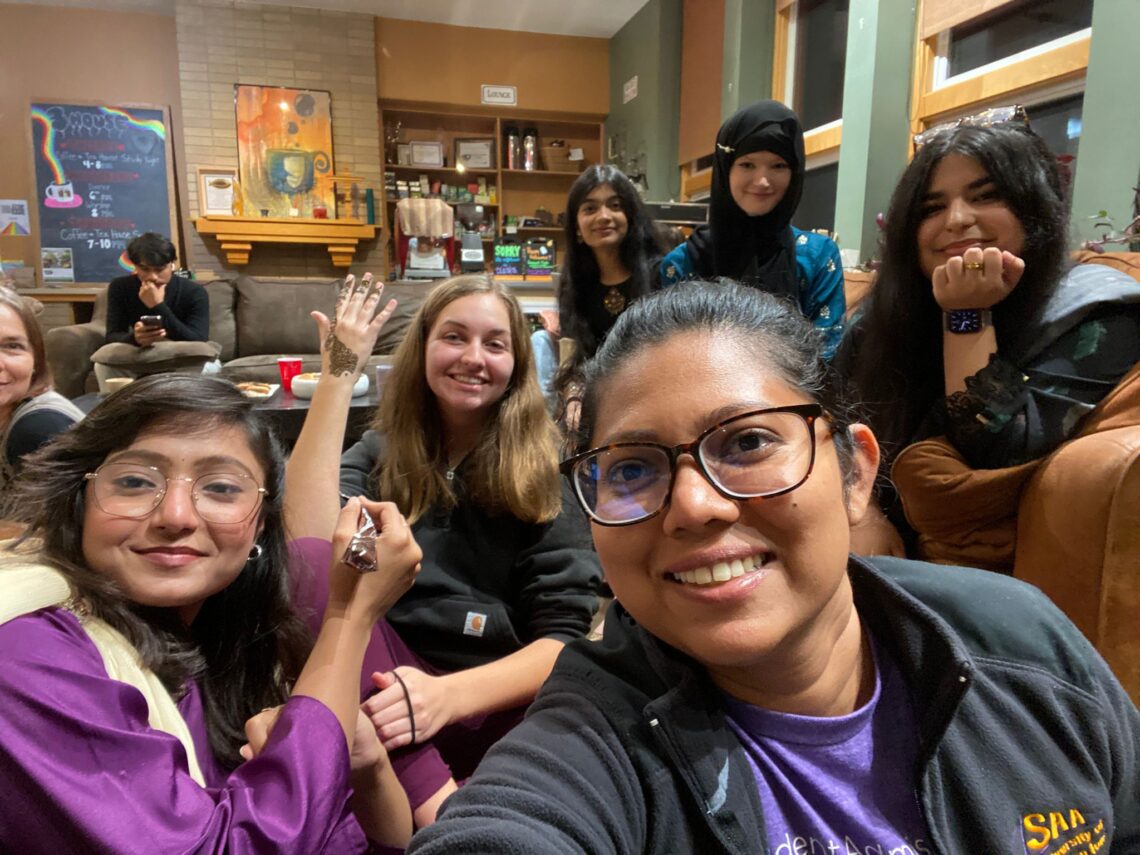
Being an international student, the resonance of cultural and traditional festivals celebrated on campus is nothing short of a comforting embrace that brings a sense of home. In today's article we will learn more about how the campus celebrates various Cultural Holidays & Festivals with our students.
In this post, I am eager to shed light on the commendable initiatives orchestrated by the Office of International Engagement (OIE) at the University of Northern Iowa. The OIE’s dedication to celebrating diversity among international students is truly noteworthy. Through a variety of cultural events and festive gatherings, they create a vibrant tapestry that honors the richness of different cultures and traditions represented within the university community. These initiatives not only foster a sense of belonging for international students; but also serve as a platform for cultural exchange, enhancing the overall university experience.
Celebrating the Festival of Lights – Diwali 🪔

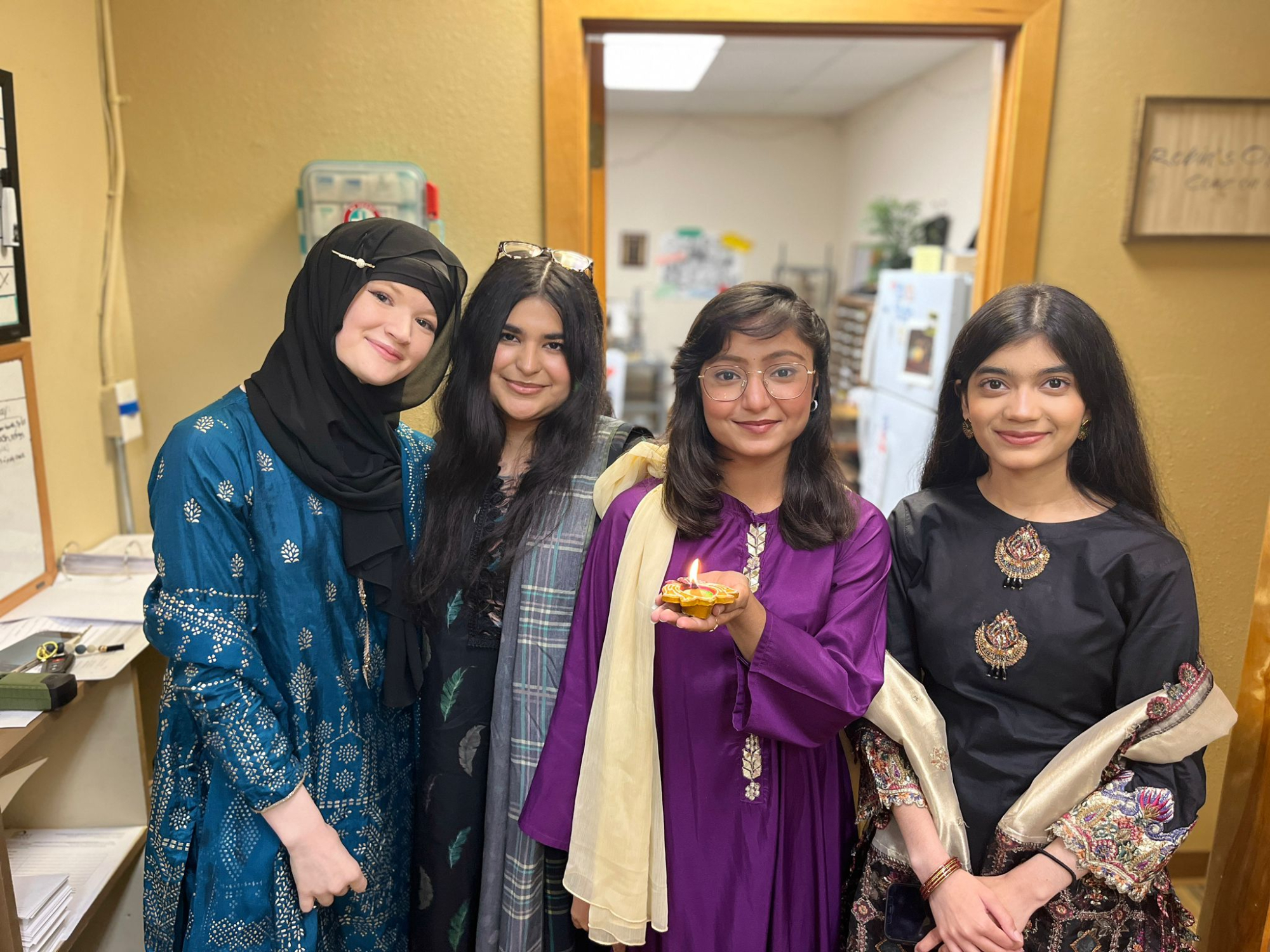
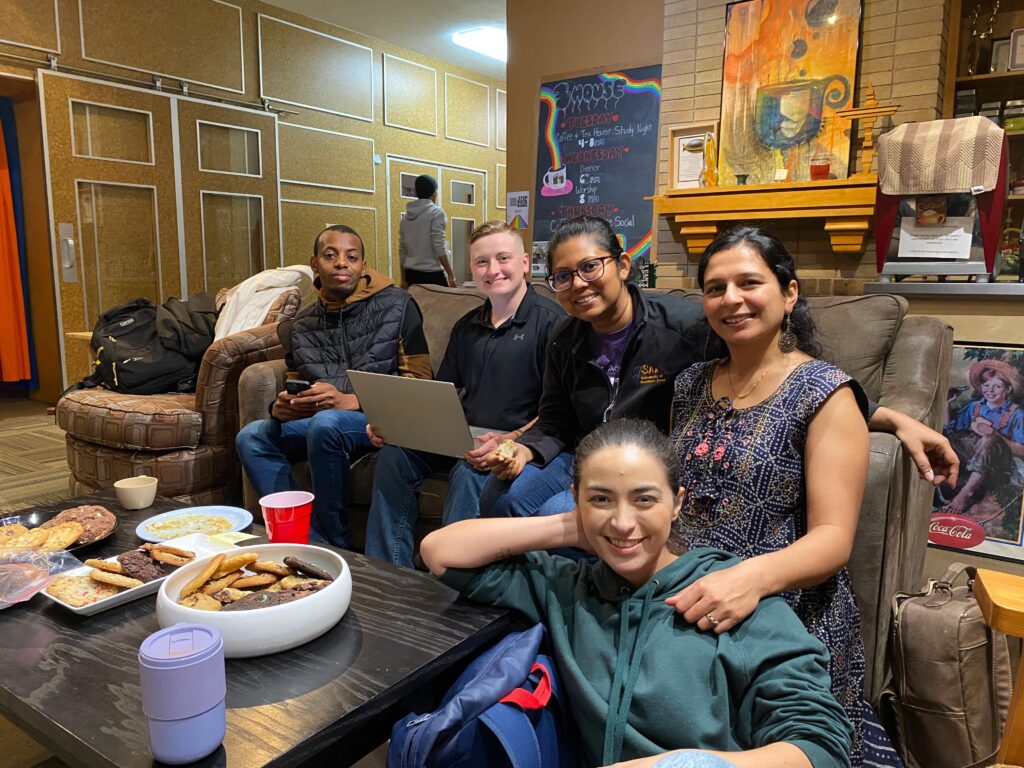
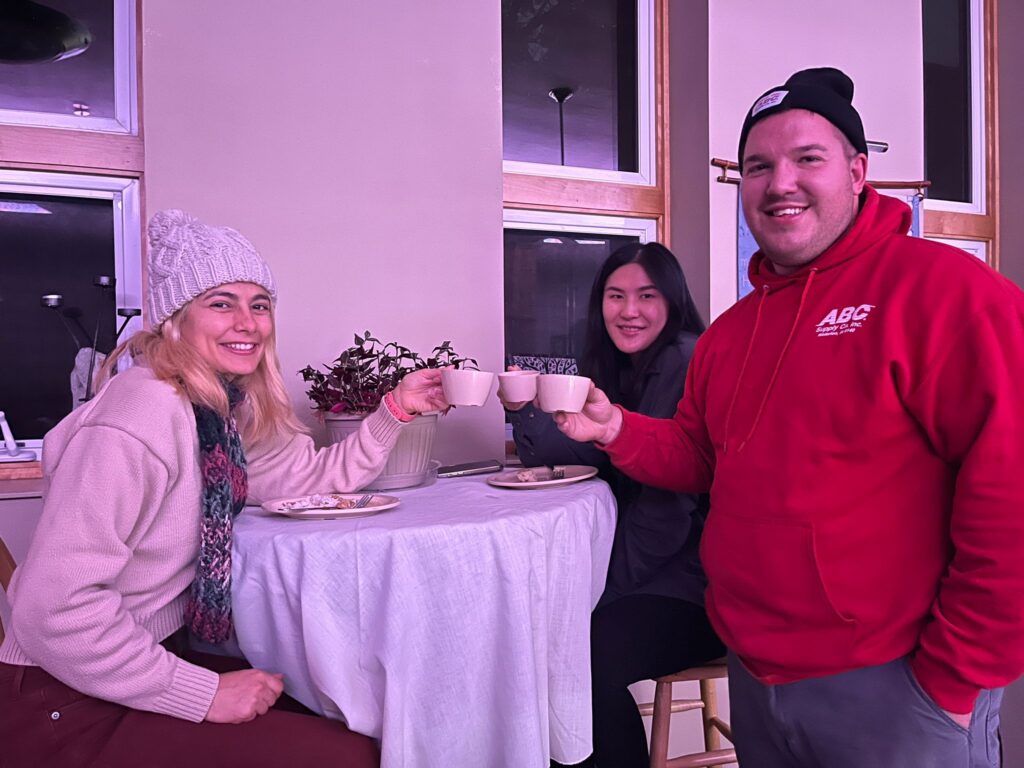
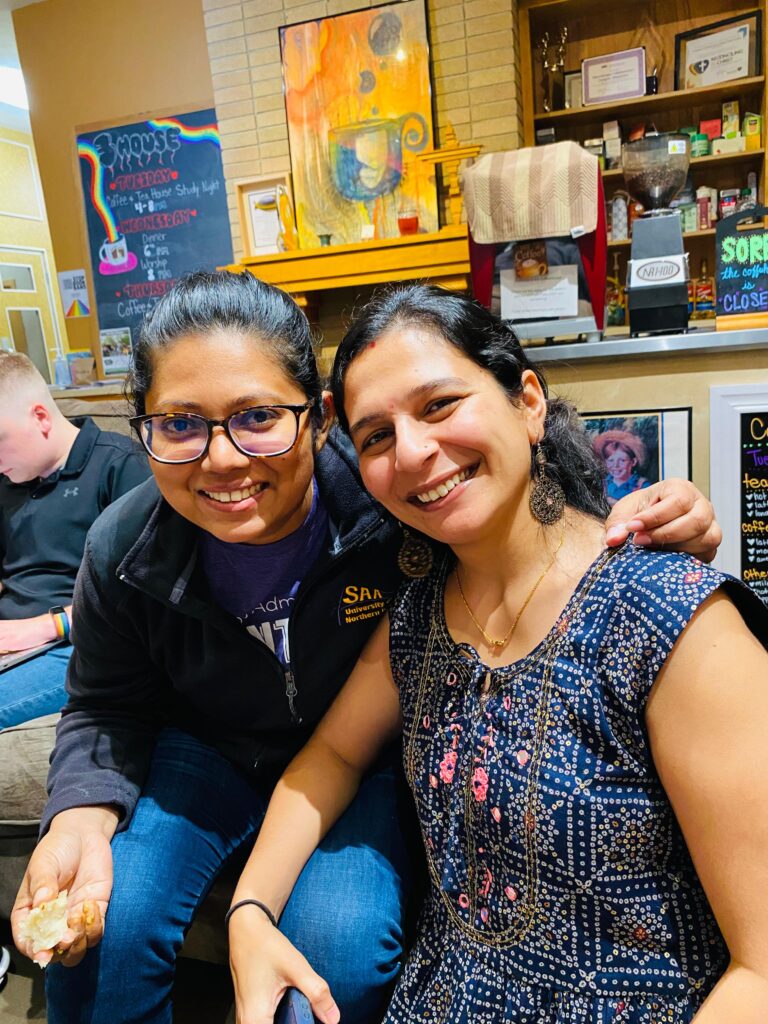
Spooky Celebration Halloween in Fall 🎃
Halloween is not a prominent celebration in my home country. So stepping into the vibrant Halloween culture in the US was a novel experience. The Office of International Engagement (OIE) orchestrated a memorable Halloween party, capturing the essence of this widely cherished American tradition. As fall leaves adorned the campus, international students eagerly joined in the festivities. They also wore amazing costumes that reflected both their cultural backgrounds and the spirit of Halloween.
From spooky decorations to themed treats, the event became a melting pot of diverse cultures coming together to enjoy the thrill of this October celebration. The Halloween party organized by OIE not only brought the joy of the season to international students; but also served as a delightful cultural exchange. The sharing of unique perspectives on the festivities, make it a truly unforgettable experience for everyone involved. Check out how OIE hosted a Halloween party below. You will be amazed to know how international students embraced the festivities. To immerse themselves in the American tradition and adding their unique flair to the spooky celebrations.
Celebrating Mid-Autumn Moon Festival 🥮
OIE also organized the Mid Autumn Moon Festival, another culturally enriching event. Across various Asian cultures, moon festivals are celebrated during the harvest season, featuring the creation, sharing, and consumption of moon cakes—a delicacy. Lanterns play a symbolic role, representing the illumination of a path toward prosperity and good fortune. Although I had never attended one before, the experience was truly amazing. I had the opportunity to learn the art of lantern painting, participate in the making and savoring of moon cakes, and indulge in a variety of delicious treats. The event provided a unique and enjoyable immersion into the traditions and festivities associated with the Mid Autumn Moon Festival. All International students really appreciate for the fact that UNI celebrates Cultural Holidays & Festivals
A Culinary Journey with the African Student Union 🍚
Here’s another event that added a flavorful twist to campus life – the African Student Union’s cultural and culinary extravaganza. International students gathered to share in the vibrant cultures and mouthwatering dishes from various African countries. I had the opportunity to savor the delectable combination of rice and Chicken Curry, along with a tantalizing array of curries prepared in the authentic styles of nations like Nigeria and Ethiopia. Let me tell you, the flavors were absolutely fantastic, offering a unique and delightful taste of Africa right here on campus.

Being an international student, the resonance of cultural and traditional festivals celebrated on campus is nothing short of a comforting embrace that brings a sense of home. In today's article we will learn more about how the campus celebrates various Cultural Holidays & Festivals with our students.
In this post, I am eager to shed light on the commendable initiatives orchestrated by the Office of International Engagement (OIE) at the University of Northern Iowa. The OIE’s dedication to celebrating diversity among international students is truly noteworthy. Through a variety of cultural events and festive gatherings, they create a vibrant tapestry that honors the richness of different cultures and traditions represented within the university community. These initiatives not only foster a sense of belonging for international students; but also serve as a platform for cultural exchange, enhancing the overall university experience.
Celebrating the Festival of Lights – Diwali 🪔





Spooky Celebration Halloween in Fall 🎃
Halloween is not a prominent celebration in my home country. So stepping into the vibrant Halloween culture in the US was a novel experience. The Office of International Engagement (OIE) orchestrated a memorable Halloween party, capturing the essence of this widely cherished American tradition. As fall leaves adorned the campus, international students eagerly joined in the festivities. They also wore amazing costumes that reflected both their cultural backgrounds and the spirit of Halloween.
From spooky decorations to themed treats, the event became a melting pot of diverse cultures coming together to enjoy the thrill of this October celebration. The Halloween party organized by OIE not only brought the joy of the season to international students; but also served as a delightful cultural exchange. The sharing of unique perspectives on the festivities, make it a truly unforgettable experience for everyone involved. Check out how OIE hosted a Halloween party below. You will be amazed to know how international students embraced the festivities. To immerse themselves in the American tradition and adding their unique flair to the spooky celebrations.
Celebrating Mid-Autumn Moon Festival 🥮
OIE also organized the Mid Autumn Moon Festival, another culturally enriching event. Across various Asian cultures, moon festivals are celebrated during the harvest season, featuring the creation, sharing, and consumption of moon cakes—a delicacy. Lanterns play a symbolic role, representing the illumination of a path toward prosperity and good fortune. Although I had never attended one before, the experience was truly amazing. I had the opportunity to learn the art of lantern painting, participate in the making and savoring of moon cakes, and indulge in a variety of delicious treats. The event provided a unique and enjoyable immersion into the traditions and festivities associated with the Mid Autumn Moon Festival. All International students really appreciate for the fact that UNI celebrates Cultural Holidays & Festivals
A Culinary Journey with the African Student Union 🍚
Here’s another event that added a flavorful twist to campus life – the African Student Union’s cultural and culinary extravaganza. International students gathered to share in the vibrant cultures and mouthwatering dishes from various African countries. I had the opportunity to savor the delectable combination of rice and Chicken Curry, along with a tantalizing array of curries prepared in the authentic styles of nations like Nigeria and Ethiopia. Let me tell you, the flavors were absolutely fantastic, offering a unique and delightful taste of Africa right here on campus.
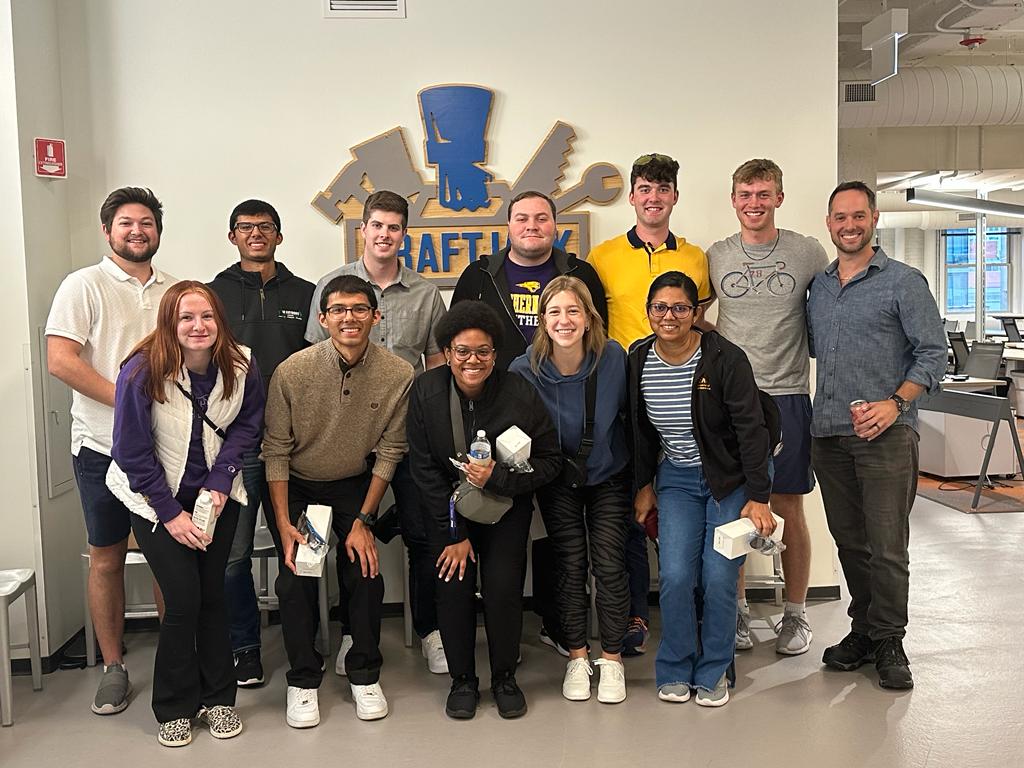
As I considered of joining a club, the initial question that crossed my mind was whether international students are truly welcomed in student organizations in US?
In today’s article, I aim to articulate the significance of being involved in student organizations. Beyond the academic realm, these organizations offer a unique avenue for personal growth, fostering connections, and building a sense of community. Whether aligned with one’s major or centered around personal interests, participation in these groups provides opportunities for skill development, cultural exchange, and the chance to contribute meaningfully to the campus environment. Through involvement in student organizations, individuals not only enhance their college experience but also lay the foundation for lifelong friendships, leadership skills, and a broader understanding of the world around them.
The advice to engage in one club aligned with your major and another reflecting personal interests is golden. The major-related club not only deepens your academic understanding but also connects you with like-minded peers and potential mentors. On the flip side, the club tied to your interests allows you to unwind, explore passions, and foster a more holistic university experience. It’s a dynamic approach that not only broadens your skill set but also ensures a well-rounded and enjoyable journey through your academic years.
My Experience in Clubs & Associations at UNI
I have recently joined the American Advertising Federation (AAF) and the Entrepreneurs Club, both of which align with my business major. Since becoming a part of these clubs, I’ve been exposed to new experiences such as company visits, conferences, and trips. It’s been a fantastic opportunity to connect with like-minded individuals and gain insights into the industry.
American Advertising Federation (AAF)
Upon enrolling for digital advertising course this fall, I discovered the American Advertising Federation (AAF), guided by my professor who serves as the club’s advisor. Attending a conference in Des Moines provided an opportunity to delve into the fascinating world of advertising and creative design. My experience as a member has been truly enjoyable. I look forward to more engaging moments with this amazing club.
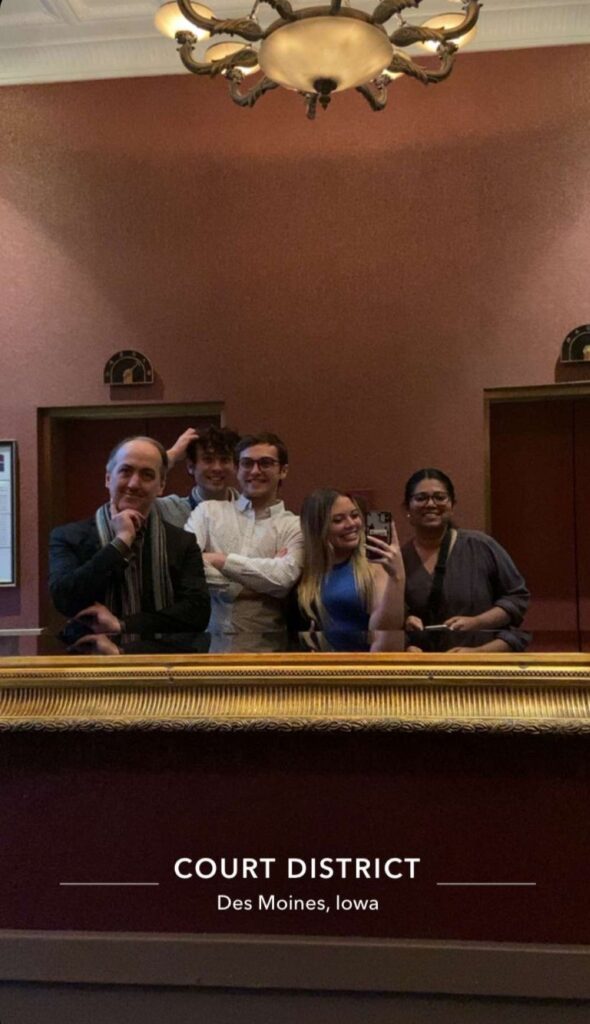
Entrepreneurs Club
Another one of my favorite clubs is the Entrepreneurship Club. One reason is that most of the club members have small businesses, and it’s fascinating to hear their stories. The second reason is that the club organizes visits to various companies and small businesses created by entrepreneurs. We get to listen to their life journeys. We also have the opportunity to engage with these entrepreneurs in person during social events. Isn’t that cool? Additionally, the club arranged a trip to Chicago for its members.
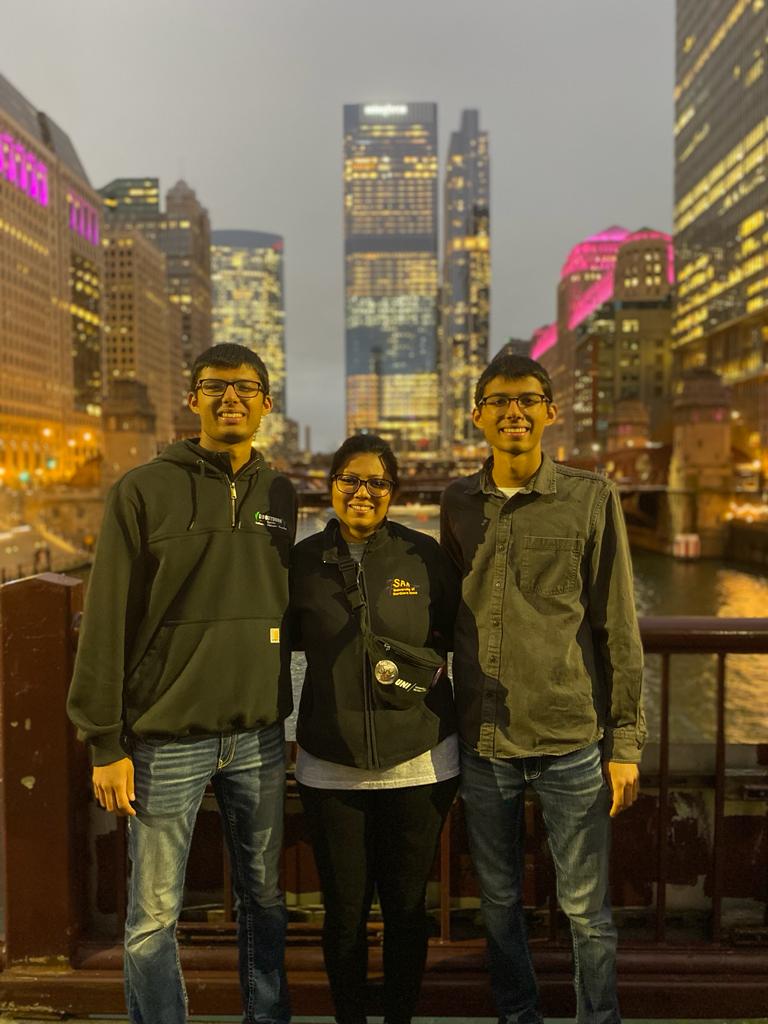
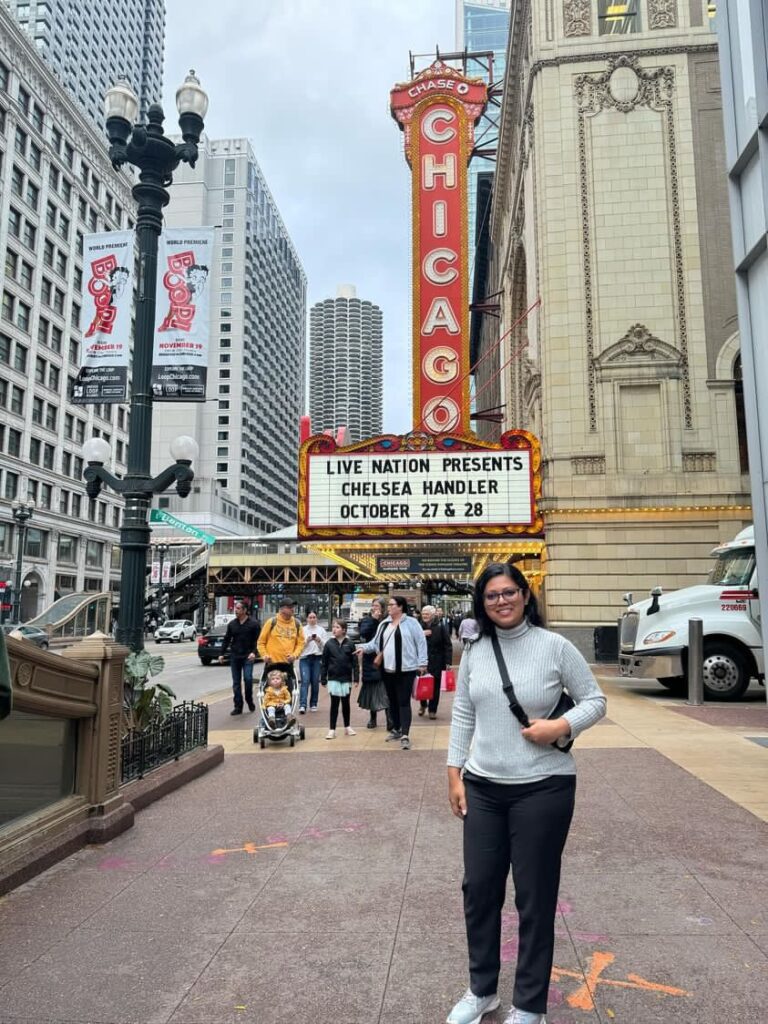
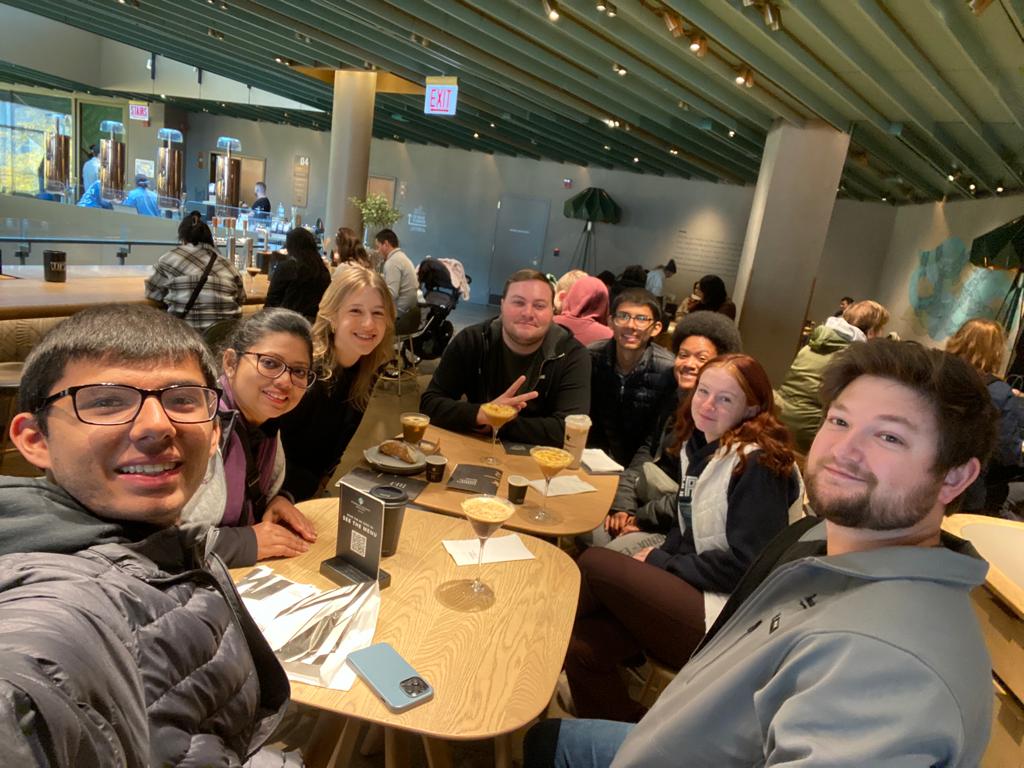
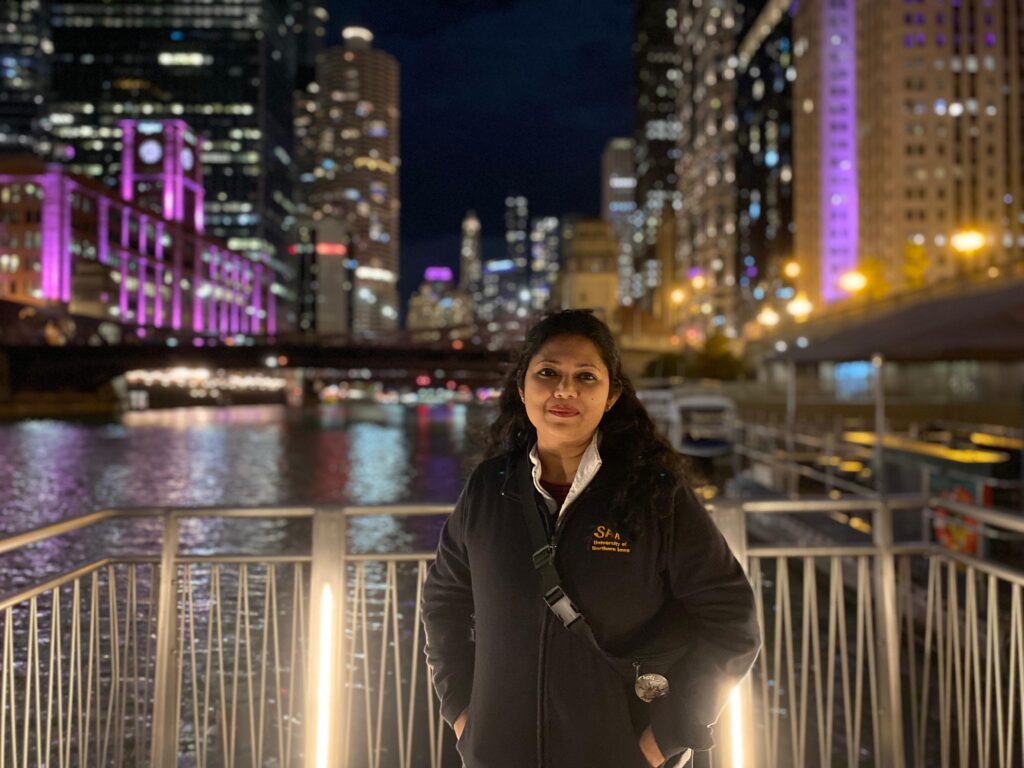
International Student Promoters Club (ISP)
Additionally, I decided to join the International Student Promoters (ISP) club based on my interest. My motivation stems from wanting to assist international students, much like myself, who aspire to study in the US. In this club, we learn valuable tips on how to professionally engage with potential students. We do so by offering campus tours, creating a supportive and informative environment for those considering studying here.
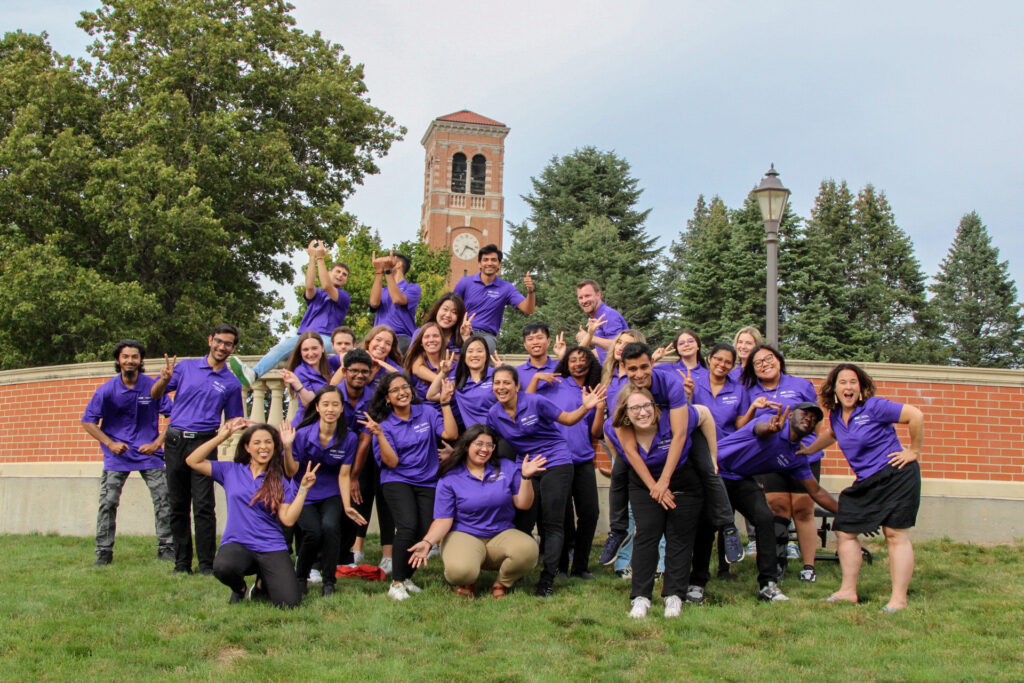
International Student Promoters Club – My Favorite Club and this picture was taken last year
International Club of Business Students (ICBS)
I am proud to serve as the President of the recently formed ‘International Club of Business Students,’ a result of the merger between two former clubs, the Global Trades Club led by Professor Chris Schrage and the International Students in Business group led by Professor Shahina Amin. This club serves as a platform for international students with an interest in international business to connect with U.S. business students, facilitating discussions and idea-sharing about their experiences in the field.
One of the club’s highlights is the opportunity for students to participate in worldwide competitions. A team comprising Jade, Matt, and Hayes (U.S. students) and Gavik (International student from Sri Lanka) will be traveling to Dublin, Ireland, next year to compete in the NIBS – Network of International Business Schools Worldwide Case Competition. Leading this incredible team has been a rewarding journey, and I am excited about the positive impact our club is creating for international business students.
Read my previous article about Celebrating Diverse Cultural Holidays & Festivals at UNI. Witness the astounding diversity within UNI’s international student population. Explore my next article on the Top 10 reasons students should actively engage on campus.

As I considered of joining a club, the initial question that crossed my mind was whether international students are truly welcomed in student organizations in US?
In today’s article, I aim to articulate the significance of being involved in student organizations. Beyond the academic realm, these organizations offer a unique avenue for personal growth, fostering connections, and building a sense of community. Whether aligned with one’s major or centered around personal interests, participation in these groups provides opportunities for skill development, cultural exchange, and the chance to contribute meaningfully to the campus environment. Through involvement in student organizations, individuals not only enhance their college experience but also lay the foundation for lifelong friendships, leadership skills, and a broader understanding of the world around them.
The advice to engage in one club aligned with your major and another reflecting personal interests is golden. The major-related club not only deepens your academic understanding but also connects you with like-minded peers and potential mentors. On the flip side, the club tied to your interests allows you to unwind, explore passions, and foster a more holistic university experience. It’s a dynamic approach that not only broadens your skill set but also ensures a well-rounded and enjoyable journey through your academic years.
My Experience in Clubs & Associations at UNI
I have recently joined the American Advertising Federation (AAF) and the Entrepreneurs Club, both of which align with my business major. Since becoming a part of these clubs, I’ve been exposed to new experiences such as company visits, conferences, and trips. It’s been a fantastic opportunity to connect with like-minded individuals and gain insights into the industry.
American Advertising Federation (AAF)
Upon enrolling for digital advertising course this fall, I discovered the American Advertising Federation (AAF), guided by my professor who serves as the club’s advisor. Attending a conference in Des Moines provided an opportunity to delve into the fascinating world of advertising and creative design. My experience as a member has been truly enjoyable. I look forward to more engaging moments with this amazing club.

Entrepreneurs Club
Another one of my favorite clubs is the Entrepreneurship Club. One reason is that most of the club members have small businesses, and it’s fascinating to hear their stories. The second reason is that the club organizes visits to various companies and small businesses created by entrepreneurs. We get to listen to their life journeys. We also have the opportunity to engage with these entrepreneurs in person during social events. Isn’t that cool? Additionally, the club arranged a trip to Chicago for its members.




International Student Promoters Club (ISP)
Additionally, I decided to join the International Student Promoters (ISP) club based on my interest. My motivation stems from wanting to assist international students, much like myself, who aspire to study in the US. In this club, we learn valuable tips on how to professionally engage with potential students. We do so by offering campus tours, creating a supportive and informative environment for those considering studying here.

International Student Promoters Club – My Favorite Club and this picture was taken last year
International Club of Business Students (ICBS)
I am proud to serve as the President of the recently formed ‘International Club of Business Students,’ a result of the merger between two former clubs, the Global Trades Club led by Professor Chris Schrage and the International Students in Business group led by Professor Shahina Amin. This club serves as a platform for international students with an interest in international business to connect with U.S. business students, facilitating discussions and idea-sharing about their experiences in the field.
One of the club’s highlights is the opportunity for students to participate in worldwide competitions. A team comprising Jade, Matt, and Hayes (U.S. students) and Gavik (International student from Sri Lanka) will be traveling to Dublin, Ireland, next year to compete in the NIBS – Network of International Business Schools Worldwide Case Competition. Leading this incredible team has been a rewarding journey, and I am excited about the positive impact our club is creating for international business students.
Read my previous article about Celebrating Diverse Cultural Holidays & Festivals at UNI. Witness the astounding diversity within UNI’s international student population. Explore my next article on the Top 10 reasons students should actively engage on campus.

Join us on a cultural adventure through Nepal with Shriyash as we dive into the captivating traditions, festivals, art, cuisine, and way of life in this enchanting nation. Explore the heart of Nepal with us and discover the beauty and depth of its culture.
Meet Shriyash
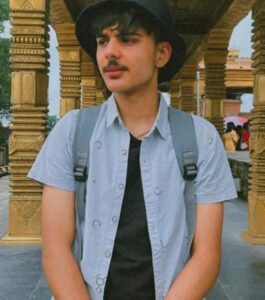
नमस्ते, म श्रीयश घिमिरे हुँ, र म नेपालको सुन्दर सहर काठमाडौंबाट आएको हुँ। हाल, म उत्तरी आयोवा विश्वविद्यालयमा कम्प्युटर विज्ञानमा मेरो स्नातक डिग्री पछ्याउँदै छु। कम्प्यूटर विज्ञान को लागी मेरो जुनून मेरो जीवन मा एक ठूलो ड्राइभिंग बल भएको छ, र म यो मनमोहक क्षेत्र UNI मा अध्ययन गर्ने अवसर पाउँदा म आफैलाई अविश्वसनीय रूप देखि भाग्यशाली मान्छु।
Hello, I’m Shriyash Ghimire, and I come from the beautiful city of Kathmandu, Nepal. Currently, I am pursuing my bachelor’s degree in computer science at University of Northern Iowa. My passion for computer science has been a big driving force in my life, and I consider myself incredibly fortunate to have the opportunity to study this fascinating field at UNI.
Shriyash Ghimire – Undergraduate Student
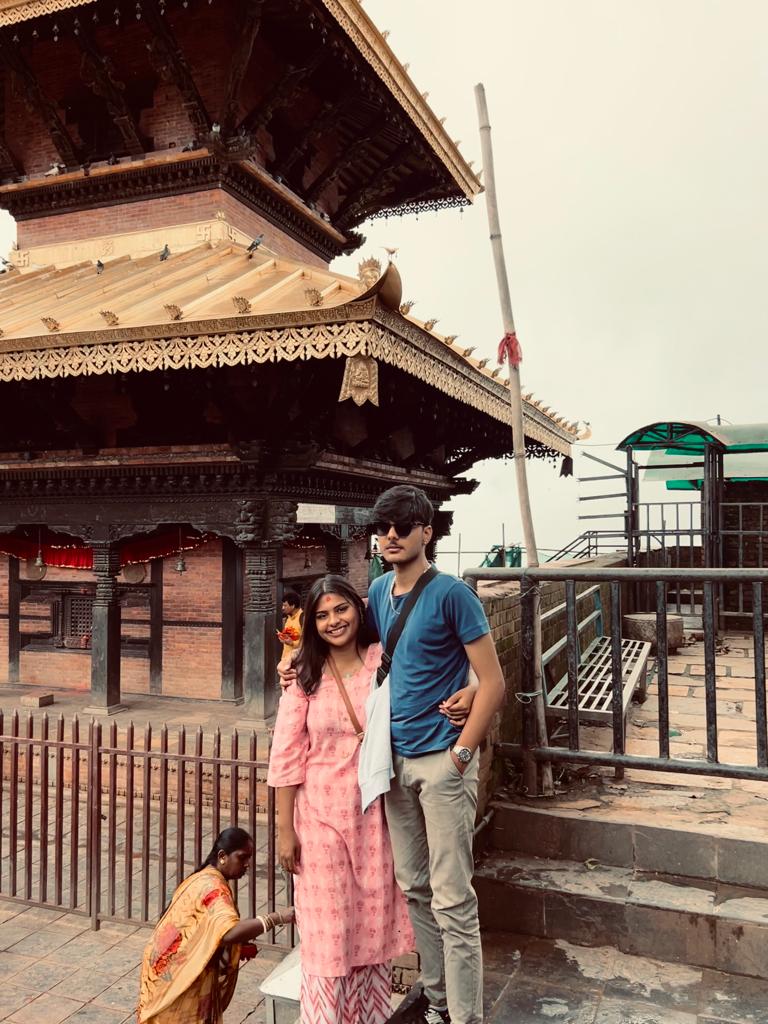
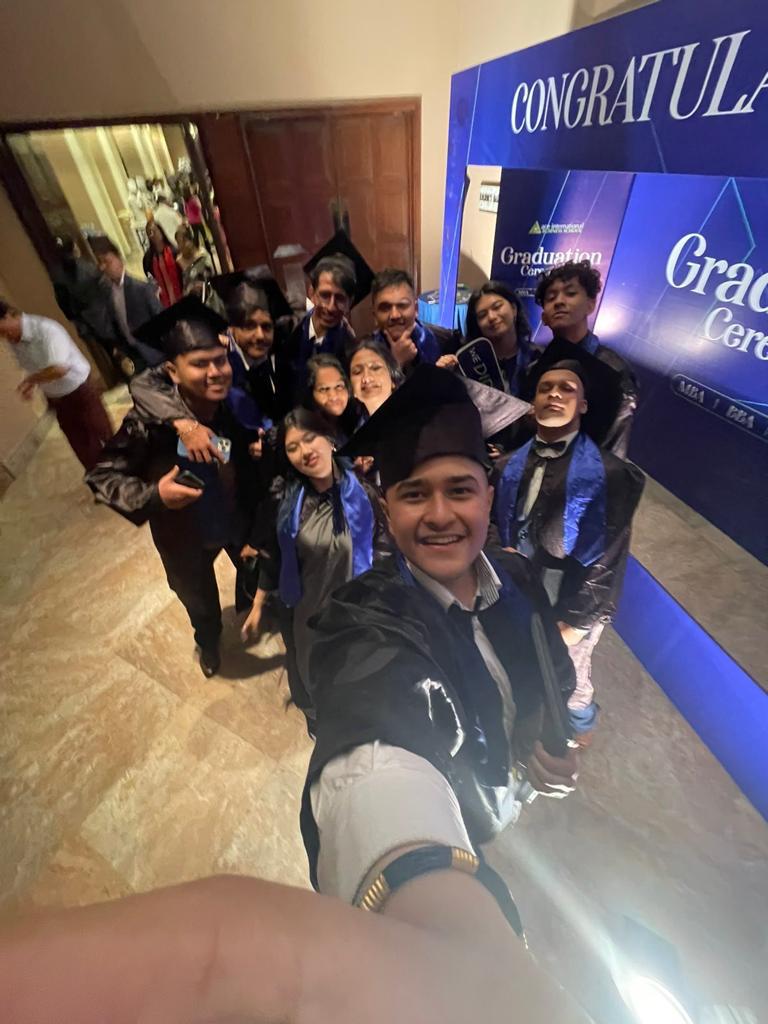
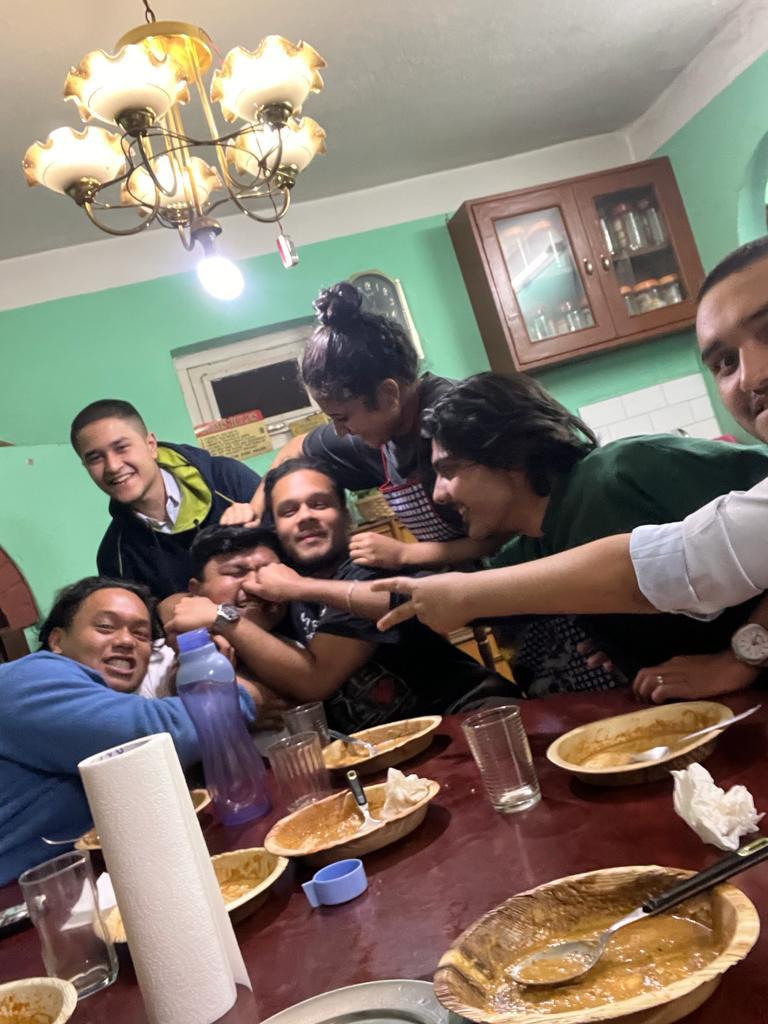
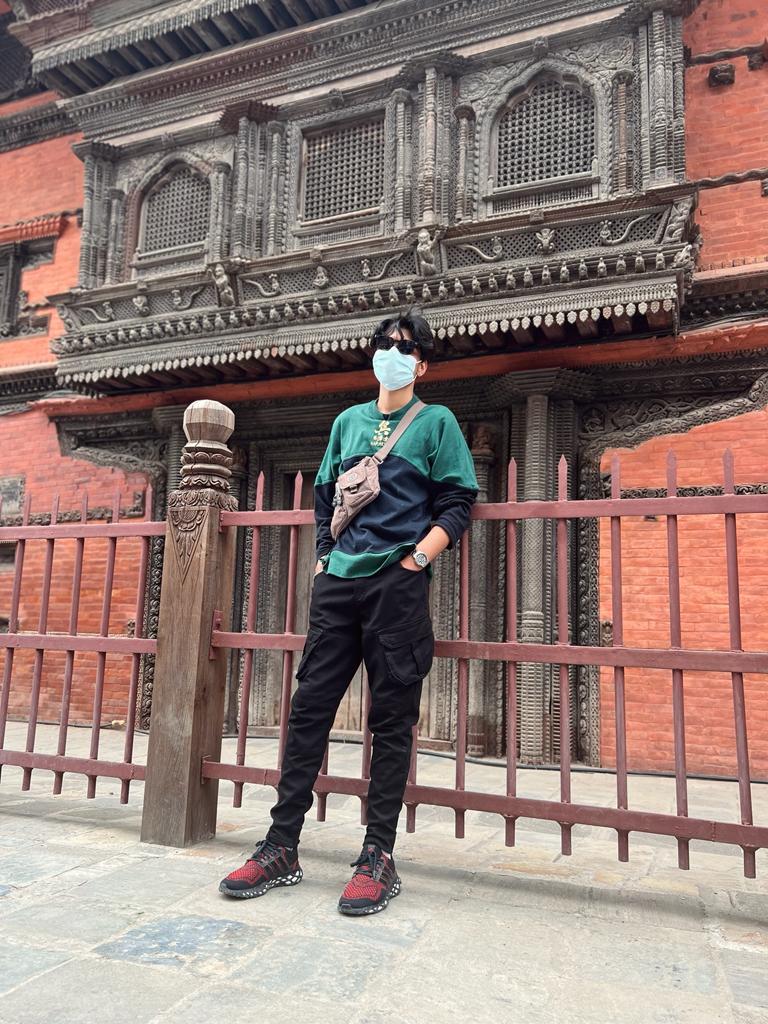
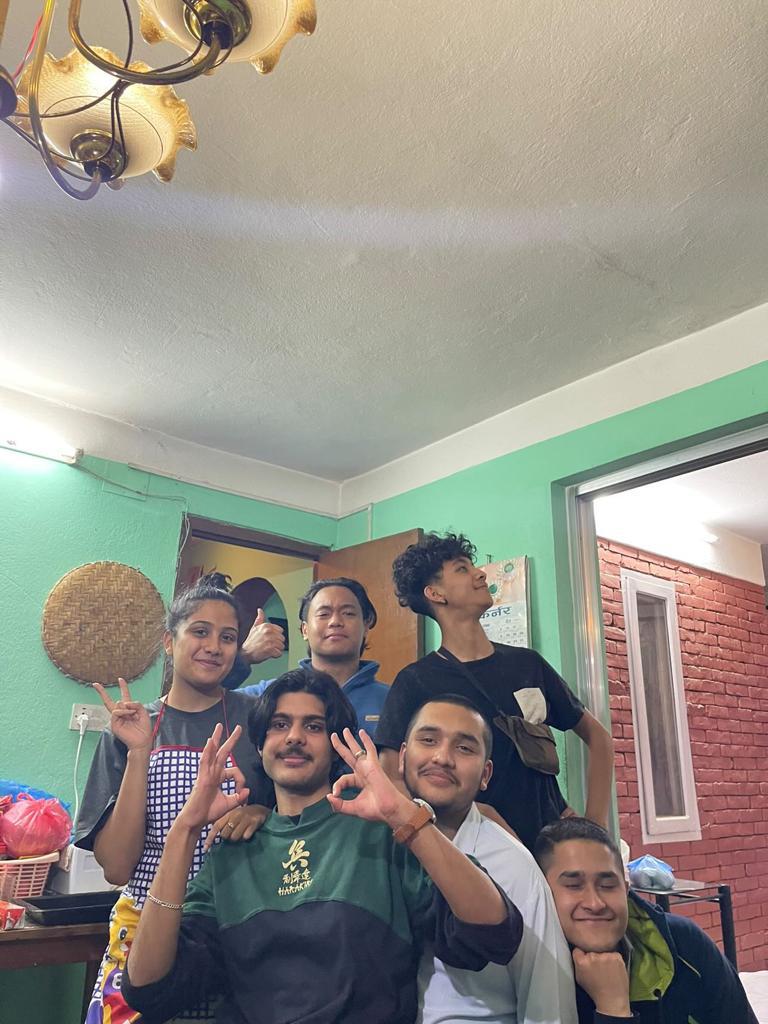
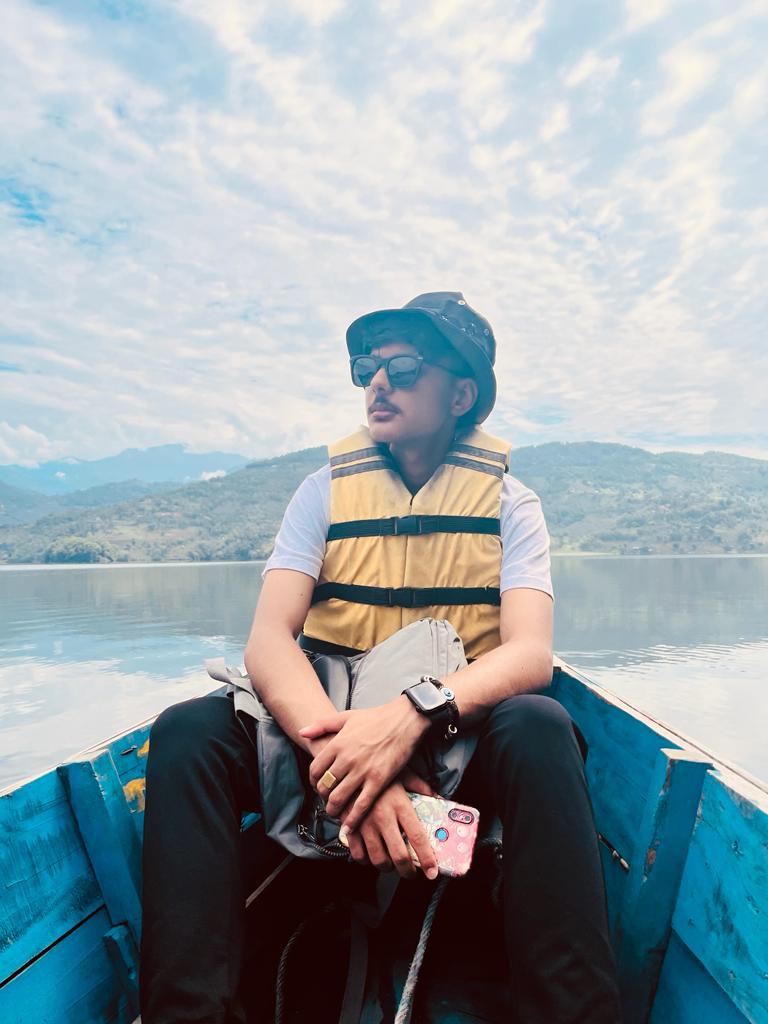
Where is Nepal?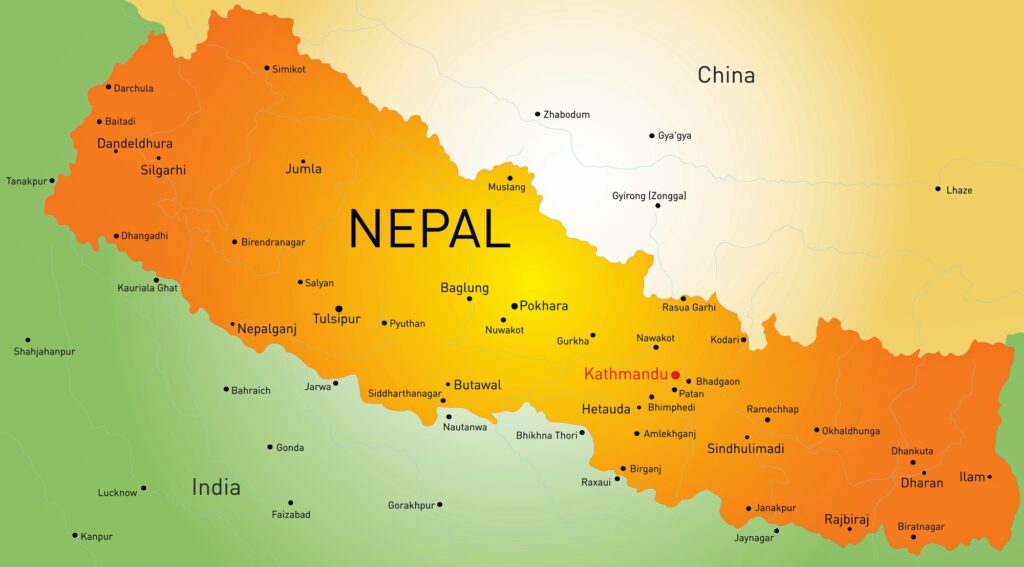
Nepal is a landlocked country located in South Asia. It is situated in the Himalayas and shares borders with India to the south, east, and west, and with China (Tibet) to the north. The capital city of Nepal is Kathmandu.
Places to visit
Nepal is a country with a rich cultural and natural heritage, offering a wide range of attractions for travelers. Here are some popular places to visit in Nepal:
Kathmandu Valley
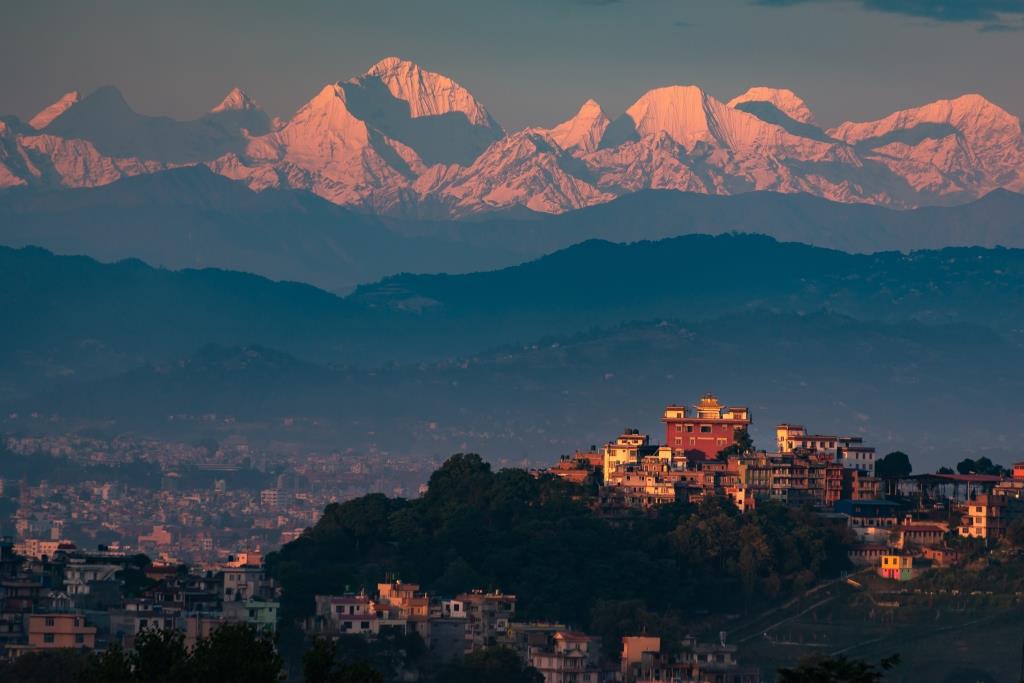
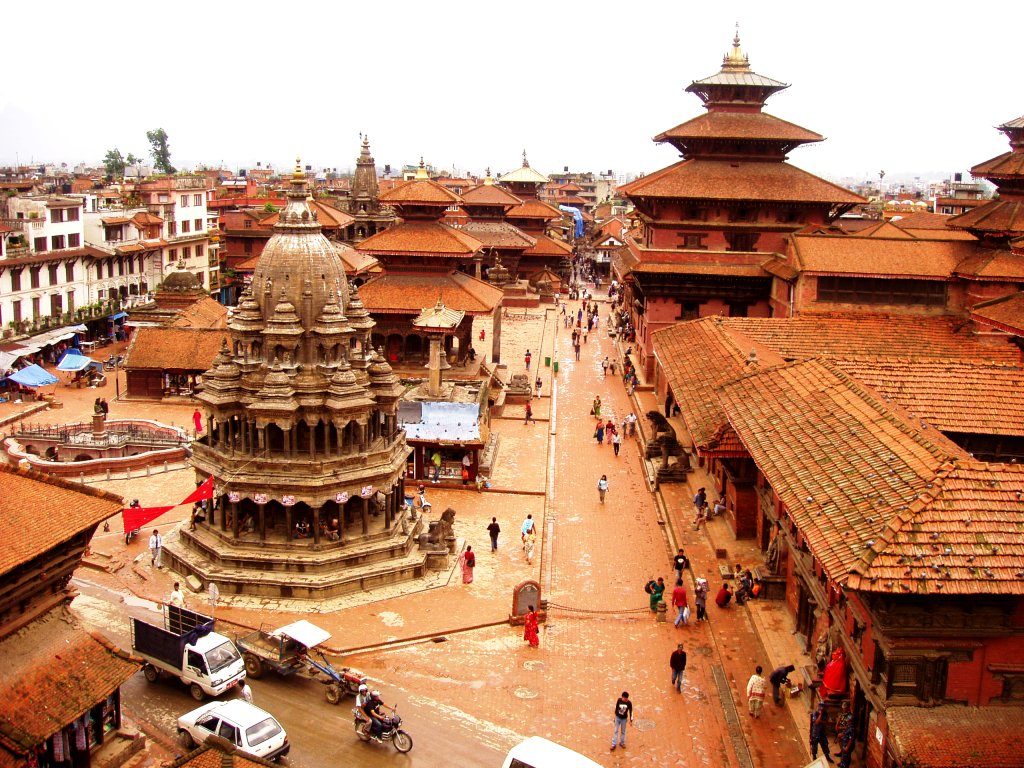
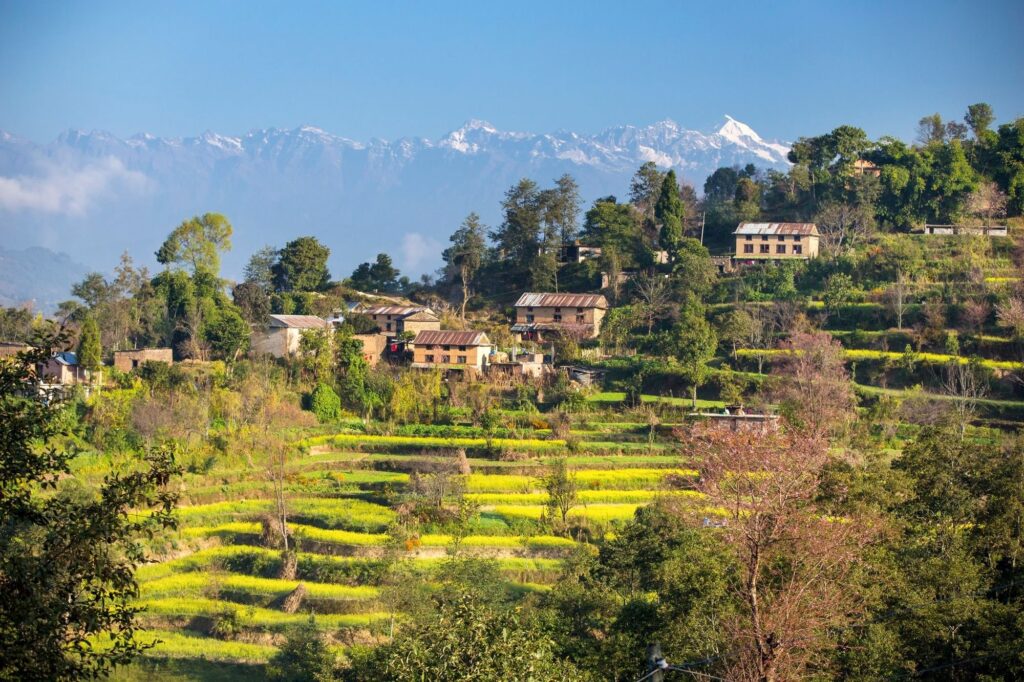
The Kathmandu Valley is the cultural and historical heart of Nepal, and it is home to seven UNESCO World Heritage Sites. These include the Kathmandu Durbar Square, Patan Durbar Square, Bhaktapur Durbar Square, Swayambhunath Stupa (also known as the Monkey Temple), Boudhanath Stupa, Pashupatinath Temple, and Changunarayan Temple.
Mount Everest
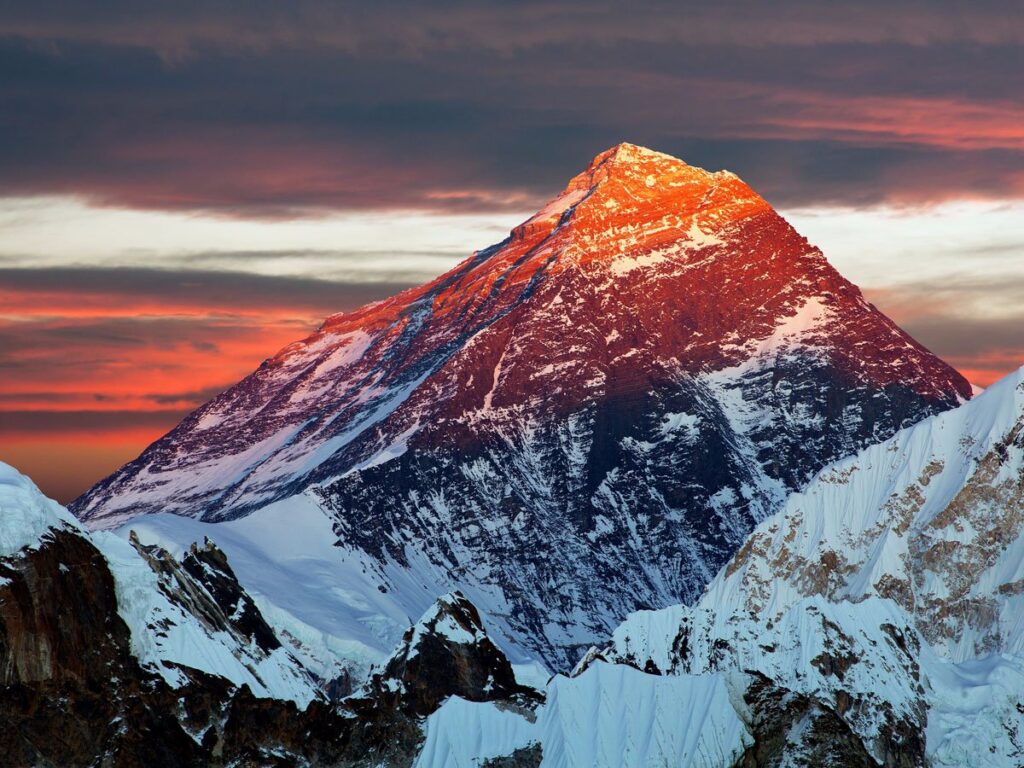
The Everest Base Camp trek is a popular destination for trekkers and climbers who want to get a close look at the world’s highest mountain, Mount Everest.
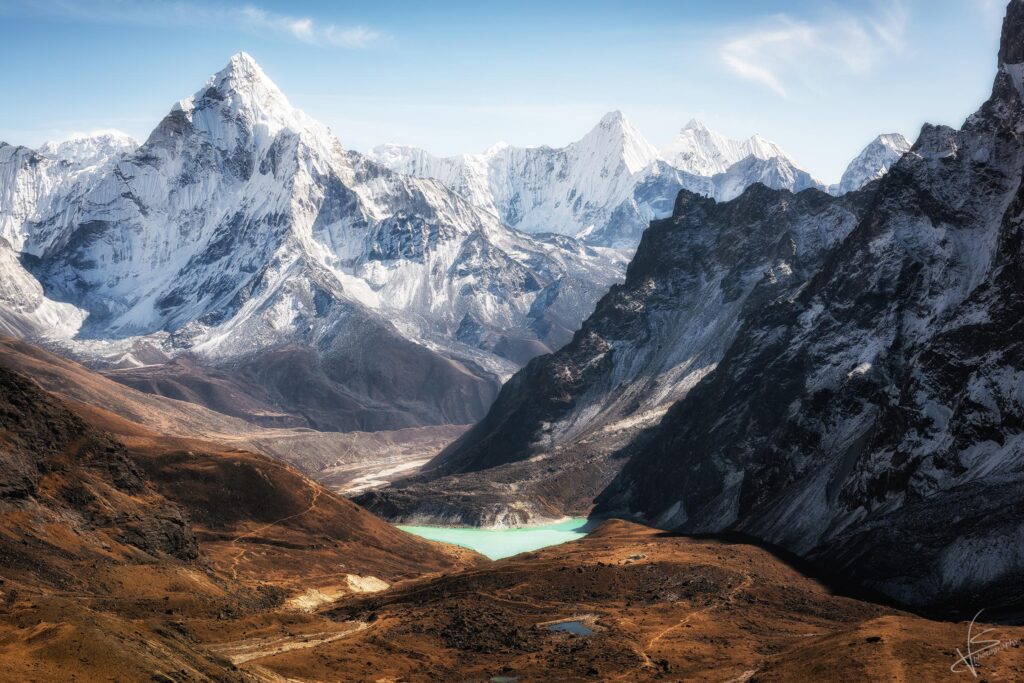
The trek offers breathtaking views and a chance to experience the unique culture of the Sherpa people.
Pokhara

Pokhara is a beautiful city located next to Phewa Lake and surrounded by the Annapurna and Dhaulagiri mountain ranges.

It is a popular destination for adventure activities like paragliding, boating, and trekking.
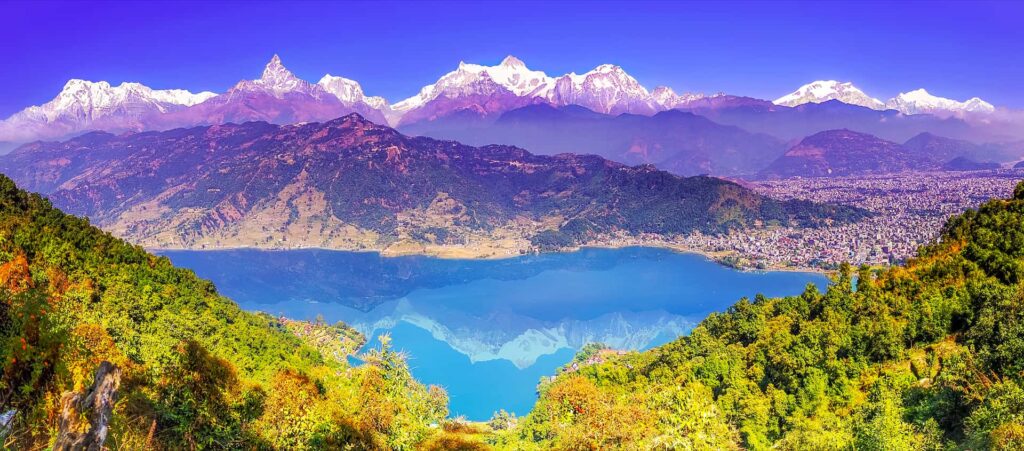
The city also has the World Peace Pagoda and the Gupteshwor Cave.
Rara Lake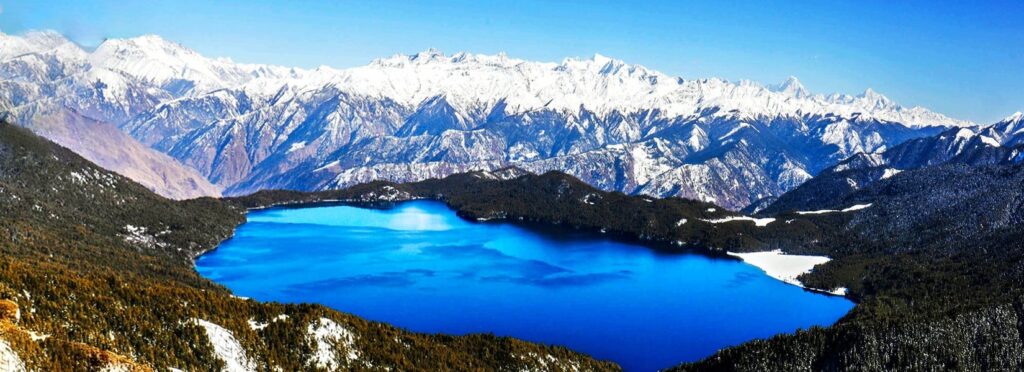
Rara Lake is the largest lake in Nepal and is located in the remote northwestern part of the country. It offers pristine natural beauty and is a less-visited destination, perfect for trekkers seeking solitude and serenity.
Capital
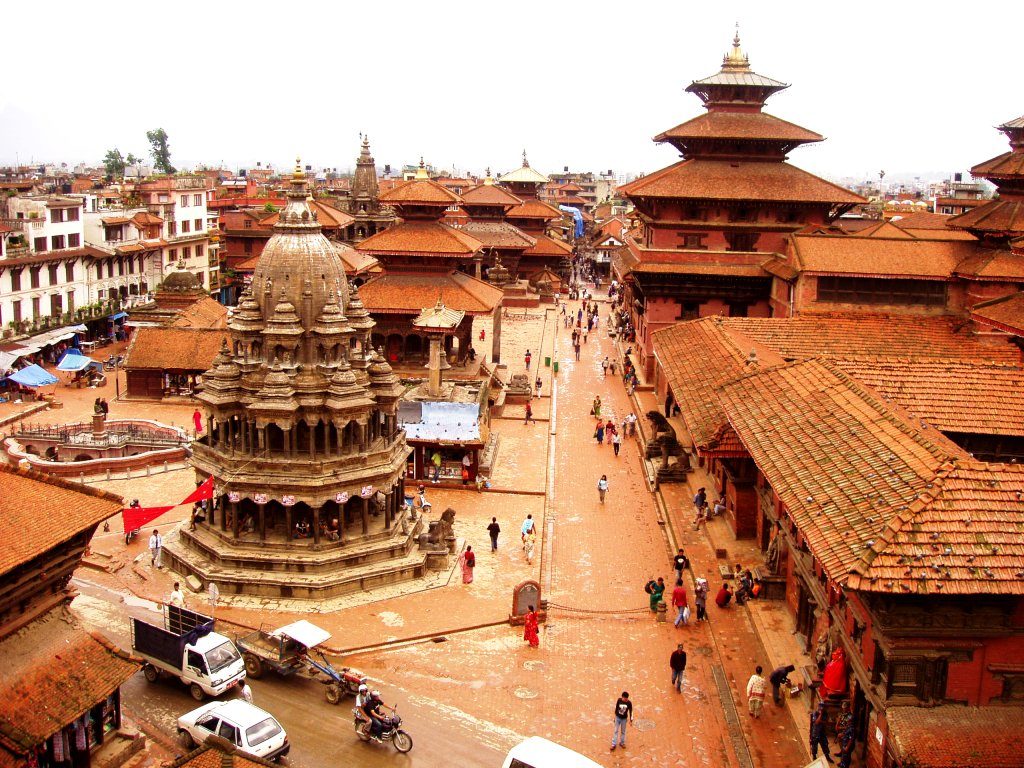
The capital of Nepal is Kathmandu. Kathmandu is the largest city in Nepal and serves as the country’s political, cultural, and economic center. It is located in the Kathmandu Valley in the central part of Nepal and is known for its historical and cultural significance, including numerous temples, palaces, and UNESCO World Heritage Sites.
Traditional food
Nepal has a rich and diverse culinary tradition influenced by its geography and culture. Here are some traditional Nepali dishes and foods:
Dal Bhat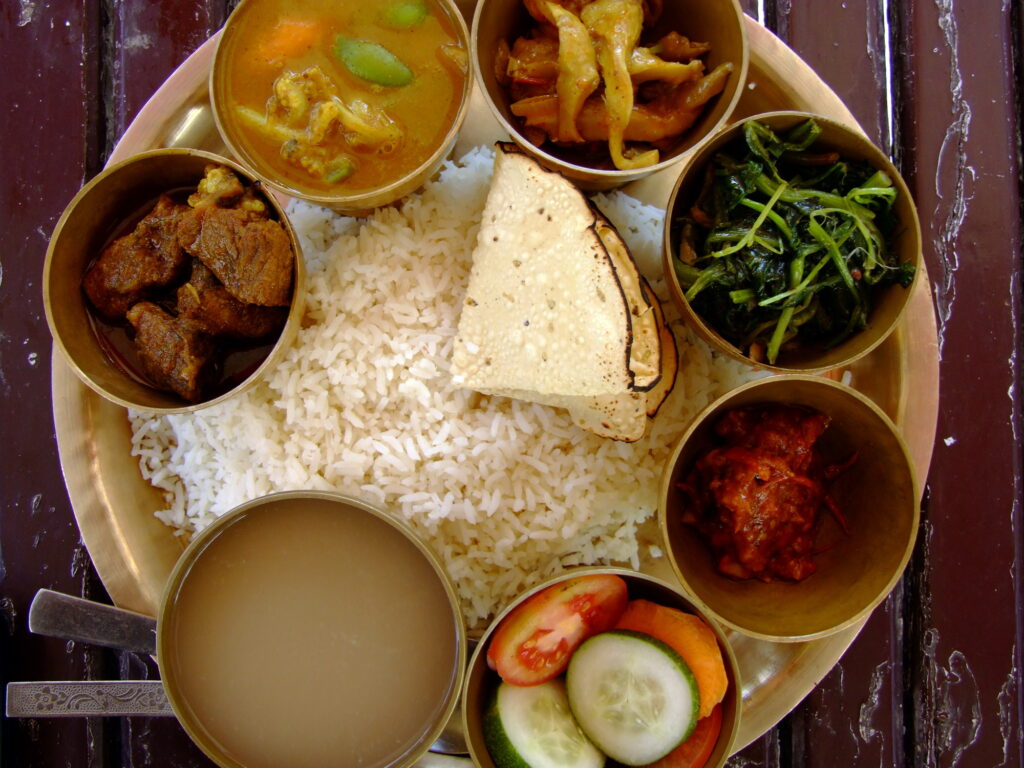
Dal Bhat is a staple and traditional meal in Nepal. It consists of steamed rice (bhat) served with lentil soup (dal) and a variety of side dishes, including vegetables, pickles, and sometimes meat or fish.
Newari Cuisine
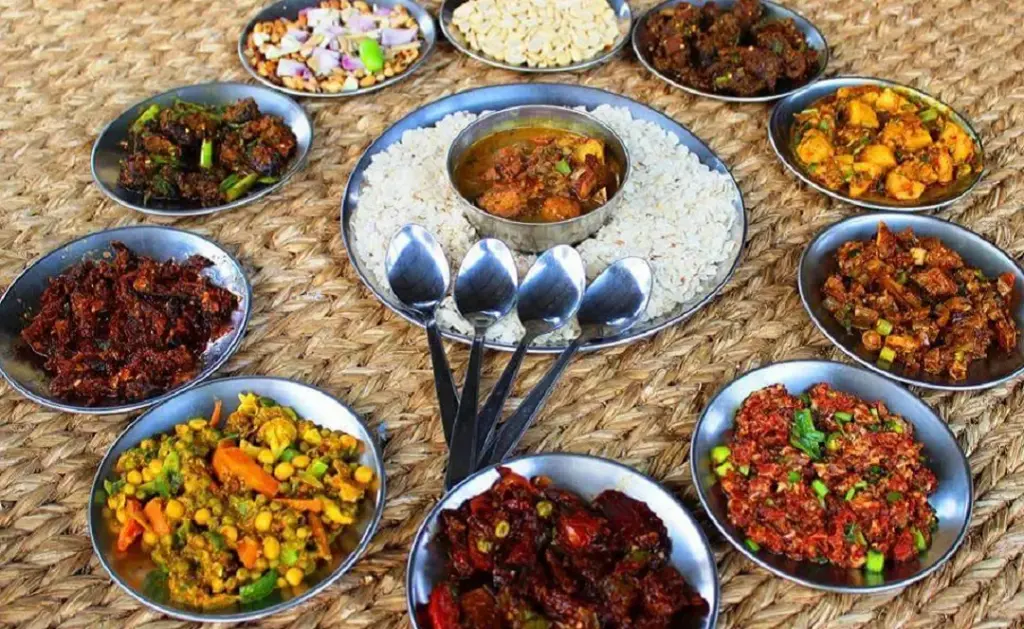
The Newar people of the Kathmandu Valley have a distinct cuisine that includes dishes like “Yomari” (steamed rice flour dumplings filled with jaggery and sesame seeds), “Bara” (fried lentil patties), and various types of “choila” (spiced and grilled meat, often buffalo or chicken).
Traditional Costumes
Nepal is a diverse country with a wide range of ethnic groups, each having its own distinct traditional costumes. These costumes are an important part of Nepali culture and reflect the ethnic, cultural, and regional diversity of the country. Here are some examples of traditional costumes in Nepal:
Dhaka Topi and Gunyu Cholo
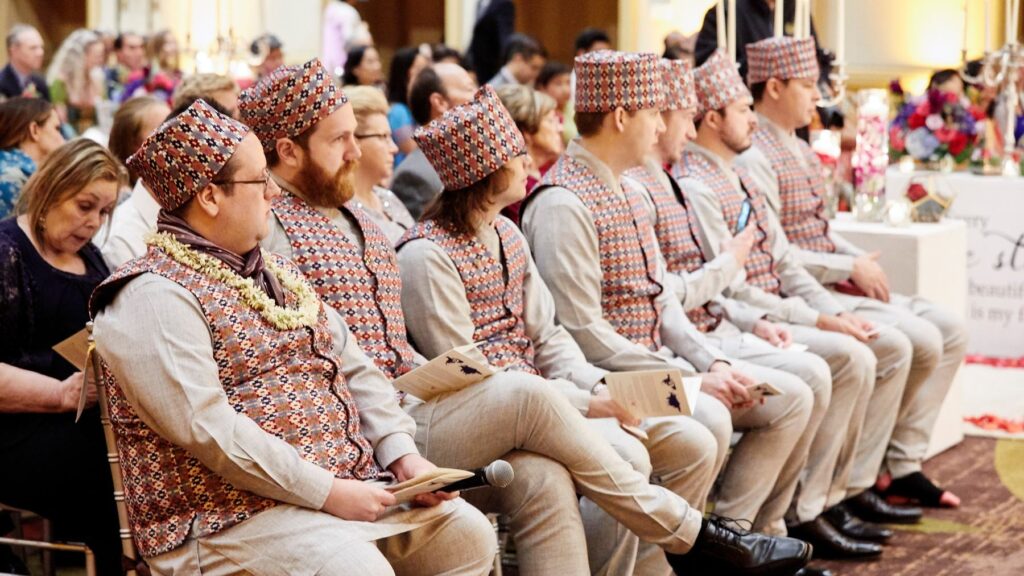
The Dhaka Topi is a traditional Nepali hat worn by men, typically made of a patterned fabric known as “Dhaka.” The Gunyo Cholo is a traditional outfit for women, which includes a colorful sari, blouse, and a gunyo (sari wrapped in a specific way). This ensemble is commonly worn by people of the Gorkha and Newar communities.
Daura Suruwal
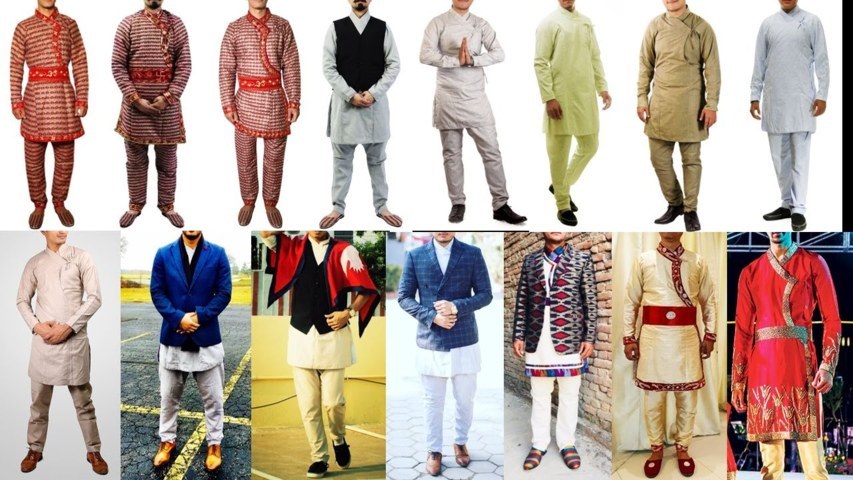
Daura Suruwal is a traditional outfit for Nepali men. It consists of a long shirt (daura) with a closed-neck design and a tapered waist, paired with suruwal, a type of baggy pants. This outfit is popular among various ethnic groups in Nepal.
Newar Women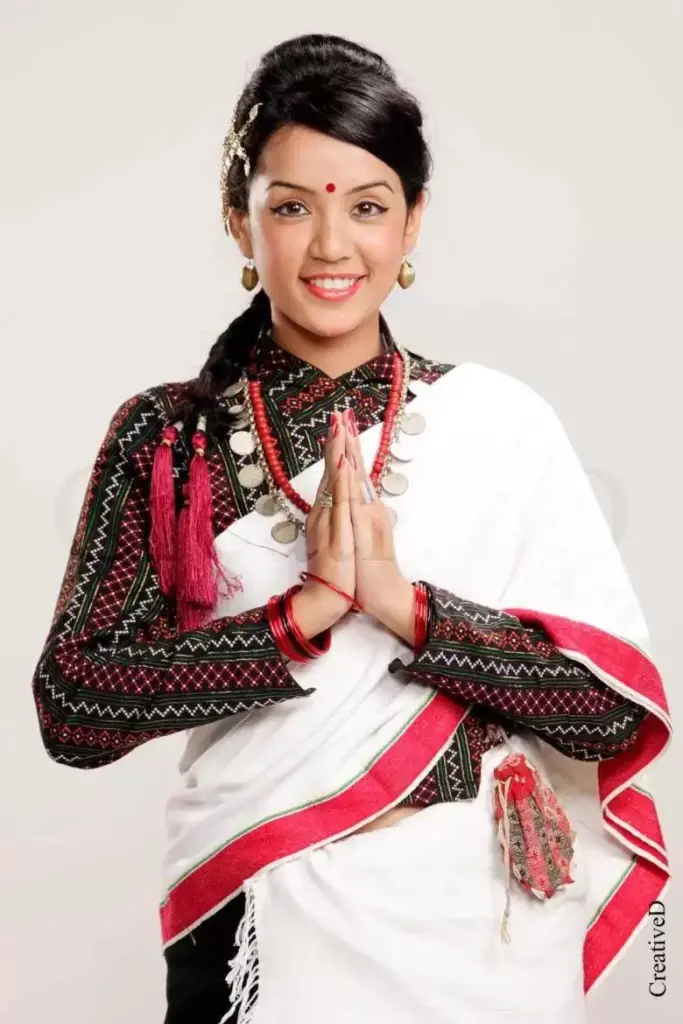
Newar women often wear a Gunyo Cholo set, which includes a colorful sari (gunyo), a matching blouse (cholo), and a headpiece. They may also wear jewelry like necklaces, bangles, and earrings.
Tamang Women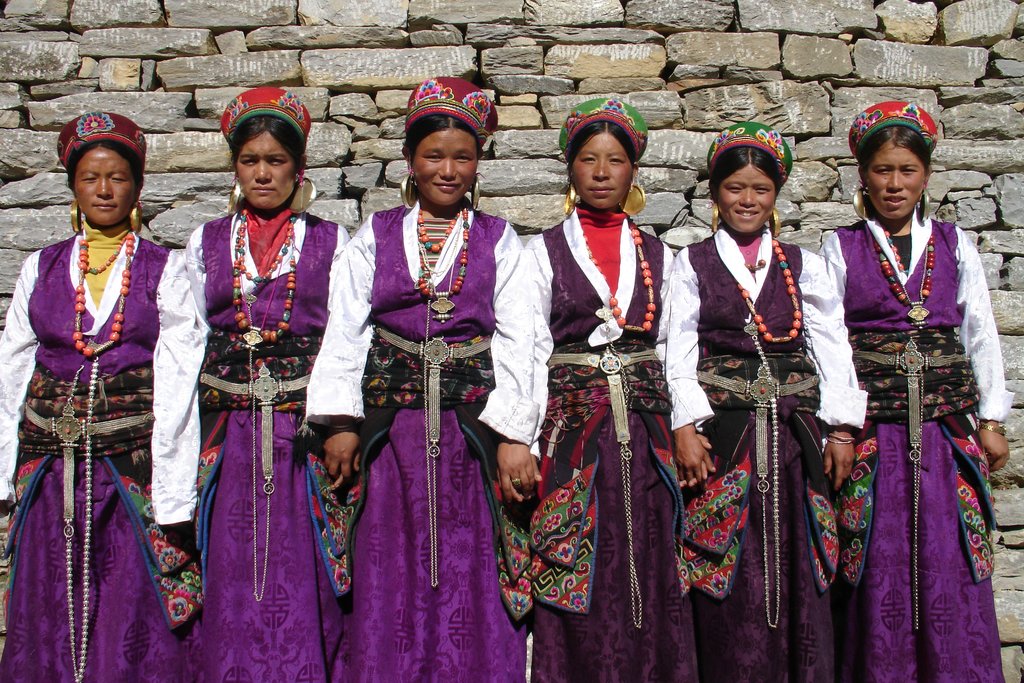
Tamang women traditionally wear a bright and colorful outfit consisting of a “gunyo” (sari), a “fariya” (long, wraparound skirt), and a “har” (necklace). Their attire is adorned with intricate embroidery.
Festivals
Nepal is a country with a diverse cultural and religious heritage, and it celebrates a wide range of festivals throughout the year. Here are some of the major festivals celebrated in Nepal:
Dashain (Vijaya Dashami)
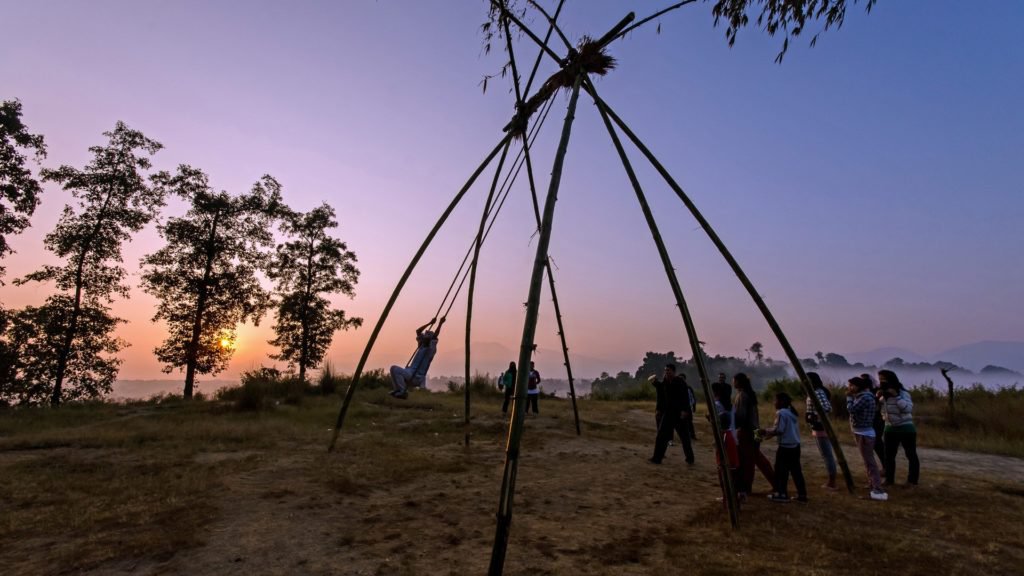
Dashain is the biggest and most important Hindu festival in Nepal, usually occurring in September or October. It spans 15 days and celebrates the victory of the goddess Durga over a demon. Families come together, offer sacrifices, and exchange blessings.
Tihar (Deepawali)

Tihar, also known as the Festival of Lights, is a five-day Hindu festival celebrated in October or November. Each day is dedicated to honoring different animals, including crows, dogs, cows, and oxen. The last day is reserved for celebrating the bond between brothers and sisters.
Fun facts
- Lumbini, in Nepal, is the birthplace of Siddhartha Gautama, who later became known as Buddha. The sacred garden in Lumbini is a UNESCO World Heritage Site.
- Nepal has the world’s only non-quadrilateral national flag. It consists of two overlapping triangles.
- Nepal is famous for its handmade crafts, including intricate Thangka paintings, pottery, and woodcarvings. Visitors often buy these traditional crafts as souvenirs.
- Nepal uses a unique calendar system called the Vikram Samvat, which is about 56 years and 8½ months ahead of the Gregorian calendar.
- Despite its small size, Nepal has a wide range of climates, from tropical in the lowlands to arctic conditions in the high mountain regions.
- Cows are considered sacred in Hinduism, the predominant religion in Nepal. It is illegal to slaughter cows in many regions of the country.
- Nepali cuisine is diverse, with influences from Indian, Tibetan, and Thai culinary traditions. Momos (dumplings) are a popular and delicious street food.
- Nepal has immense hydropower potential, and its rivers are a significant source of electricity generation.
If you want to know more about Peru, check here!

Join us on a cultural adventure through Nepal with Shriyash as we dive into the captivating traditions, festivals, art, cuisine, and way of life in this enchanting nation. Explore the heart of Nepal with us and discover the beauty and depth of its culture.
Meet Shriyash

नमस्ते, म श्रीयश घिमिरे हुँ, र म नेपालको सुन्दर सहर काठमाडौंबाट आएको हुँ। हाल, म उत्तरी आयोवा विश्वविद्यालयमा कम्प्युटर विज्ञानमा मेरो स्नातक डिग्री पछ्याउँदै छु। कम्प्यूटर विज्ञान को लागी मेरो जुनून मेरो जीवन मा एक ठूलो ड्राइभिंग बल भएको छ, र म यो मनमोहक क्षेत्र UNI मा अध्ययन गर्ने अवसर पाउँदा म आफैलाई अविश्वसनीय रूप देखि भाग्यशाली मान्छु।
Hello, I’m Shriyash Ghimire, and I come from the beautiful city of Kathmandu, Nepal. Currently, I am pursuing my bachelor’s degree in computer science at University of Northern Iowa. My passion for computer science has been a big driving force in my life, and I consider myself incredibly fortunate to have the opportunity to study this fascinating field at UNI.
Shriyash Ghimire – Undergraduate Student






Where is Nepal?
Nepal is a landlocked country located in South Asia. It is situated in the Himalayas and shares borders with India to the south, east, and west, and with China (Tibet) to the north. The capital city of Nepal is Kathmandu.
Places to visit
Nepal is a country with a rich cultural and natural heritage, offering a wide range of attractions for travelers. Here are some popular places to visit in Nepal:
Kathmandu Valley



The Kathmandu Valley is the cultural and historical heart of Nepal, and it is home to seven UNESCO World Heritage Sites. These include the Kathmandu Durbar Square, Patan Durbar Square, Bhaktapur Durbar Square, Swayambhunath Stupa (also known as the Monkey Temple), Boudhanath Stupa, Pashupatinath Temple, and Changunarayan Temple.
Mount Everest

The Everest Base Camp trek is a popular destination for trekkers and climbers who want to get a close look at the world’s highest mountain, Mount Everest.

The trek offers breathtaking views and a chance to experience the unique culture of the Sherpa people.
Pokhara

Pokhara is a beautiful city located next to Phewa Lake and surrounded by the Annapurna and Dhaulagiri mountain ranges.

It is a popular destination for adventure activities like paragliding, boating, and trekking.

The city also has the World Peace Pagoda and the Gupteshwor Cave.
Rara Lake
Rara Lake is the largest lake in Nepal and is located in the remote northwestern part of the country. It offers pristine natural beauty and is a less-visited destination, perfect for trekkers seeking solitude and serenity.
Capital

The capital of Nepal is Kathmandu. Kathmandu is the largest city in Nepal and serves as the country’s political, cultural, and economic center. It is located in the Kathmandu Valley in the central part of Nepal and is known for its historical and cultural significance, including numerous temples, palaces, and UNESCO World Heritage Sites.
Traditional food
Nepal has a rich and diverse culinary tradition influenced by its geography and culture. Here are some traditional Nepali dishes and foods:
Dal Bhat
Dal Bhat is a staple and traditional meal in Nepal. It consists of steamed rice (bhat) served with lentil soup (dal) and a variety of side dishes, including vegetables, pickles, and sometimes meat or fish.
Newari Cuisine

The Newar people of the Kathmandu Valley have a distinct cuisine that includes dishes like “Yomari” (steamed rice flour dumplings filled with jaggery and sesame seeds), “Bara” (fried lentil patties), and various types of “choila” (spiced and grilled meat, often buffalo or chicken).
Traditional Costumes
Nepal is a diverse country with a wide range of ethnic groups, each having its own distinct traditional costumes. These costumes are an important part of Nepali culture and reflect the ethnic, cultural, and regional diversity of the country. Here are some examples of traditional costumes in Nepal:
Dhaka Topi and Gunyu Cholo

The Dhaka Topi is a traditional Nepali hat worn by men, typically made of a patterned fabric known as “Dhaka.” The Gunyo Cholo is a traditional outfit for women, which includes a colorful sari, blouse, and a gunyo (sari wrapped in a specific way). This ensemble is commonly worn by people of the Gorkha and Newar communities.
Daura Suruwal

Daura Suruwal is a traditional outfit for Nepali men. It consists of a long shirt (daura) with a closed-neck design and a tapered waist, paired with suruwal, a type of baggy pants. This outfit is popular among various ethnic groups in Nepal.
Newar Women
Newar women often wear a Gunyo Cholo set, which includes a colorful sari (gunyo), a matching blouse (cholo), and a headpiece. They may also wear jewelry like necklaces, bangles, and earrings.
Tamang Women
Tamang women traditionally wear a bright and colorful outfit consisting of a “gunyo” (sari), a “fariya” (long, wraparound skirt), and a “har” (necklace). Their attire is adorned with intricate embroidery.
Festivals
Nepal is a country with a diverse cultural and religious heritage, and it celebrates a wide range of festivals throughout the year. Here are some of the major festivals celebrated in Nepal:
Dashain (Vijaya Dashami)

Dashain is the biggest and most important Hindu festival in Nepal, usually occurring in September or October. It spans 15 days and celebrates the victory of the goddess Durga over a demon. Families come together, offer sacrifices, and exchange blessings.
Tihar (Deepawali)

Tihar, also known as the Festival of Lights, is a five-day Hindu festival celebrated in October or November. Each day is dedicated to honoring different animals, including crows, dogs, cows, and oxen. The last day is reserved for celebrating the bond between brothers and sisters.
Fun facts
- Lumbini, in Nepal, is the birthplace of Siddhartha Gautama, who later became known as Buddha. The sacred garden in Lumbini is a UNESCO World Heritage Site.
- Nepal has the world’s only non-quadrilateral national flag. It consists of two overlapping triangles.
- Nepal is famous for its handmade crafts, including intricate Thangka paintings, pottery, and woodcarvings. Visitors often buy these traditional crafts as souvenirs.
- Nepal uses a unique calendar system called the Vikram Samvat, which is about 56 years and 8½ months ahead of the Gregorian calendar.
- Despite its small size, Nepal has a wide range of climates, from tropical in the lowlands to arctic conditions in the high mountain regions.
- Cows are considered sacred in Hinduism, the predominant religion in Nepal. It is illegal to slaughter cows in many regions of the country.
- Nepali cuisine is diverse, with influences from Indian, Tibetan, and Thai culinary traditions. Momos (dumplings) are a popular and delicious street food.
- Nepal has immense hydropower potential, and its rivers are a significant source of electricity generation.
If you want to know more about Peru, check here!
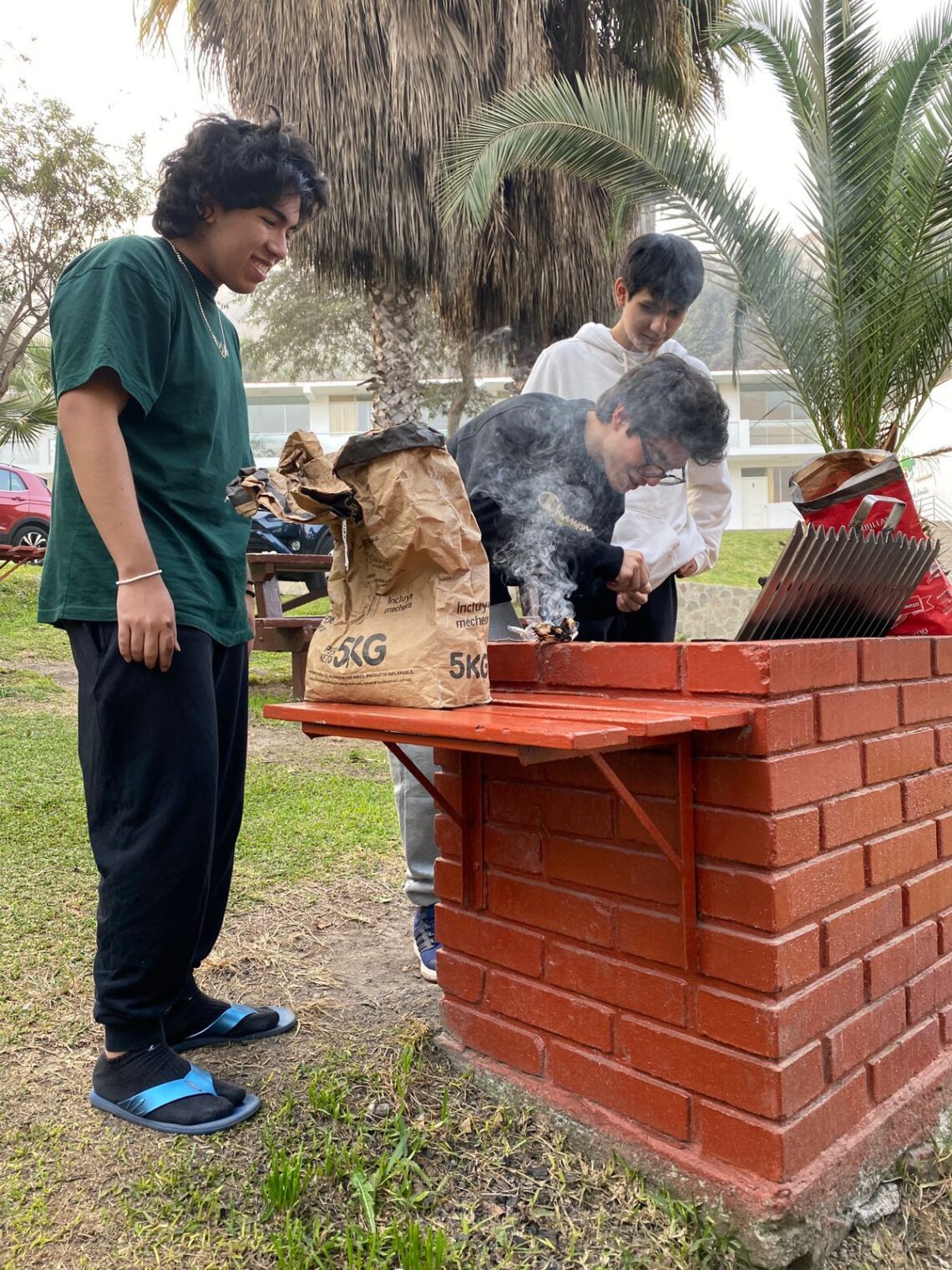
Did you miss us? We certainly missed you, and we’re excited to be back with another captivating article about Peru. Join us as we embark on a journey with Nicolas, a true enthusiast of his homeland.
Meet Nicolas!

Hola, soy Nicolás y vengo de Perú. Soy estudiante de pregrado en UNI, con especialización en Administración y Dirección de Empresas. Me transferí a UNI como estudiante internacional desde Lima, Perú. En general, puedo decir que el proceso de transferencia a UNI fue relativamente sencillo, gracias a la ayuda del personal de UNI. Lo que más aprecio de UNI son las numerosas oportunidades para conectarme con diferentes eventos y personas. Algo que disfruté especialmente fue la semana de orientación, que nos permitió familiarizarnos con el campus. Hoy en día, participo activamente en muchos clubes y eventos organizados por UNI. La universidad me brinda numerosas oportunidades y me apoya de todas las maneras posibles.
Hello, I’m Nicolas, and I come from Peru. I’m an undergraduate student at UNI, majoring in Business Administration and Management. I transferred to UNI as an international student from Lima, Peru. Overall, I can say that the transfer process to UNI was relatively straightforward, thanks to the assistance of UNI staff. What I appreciate the most about UNI is the numerous opportunities to connect with various events and people. One thing I particularly enjoyed was the orientation week, which allowed us to become familiar with the campus. Nowadays, I actively participate in many clubs and events organized by UNI. The university provides me with numerous opportunities and supports me in every way possible.
Nicolas Huiman – Undergraduate Student
Before delving deeper into Peru…
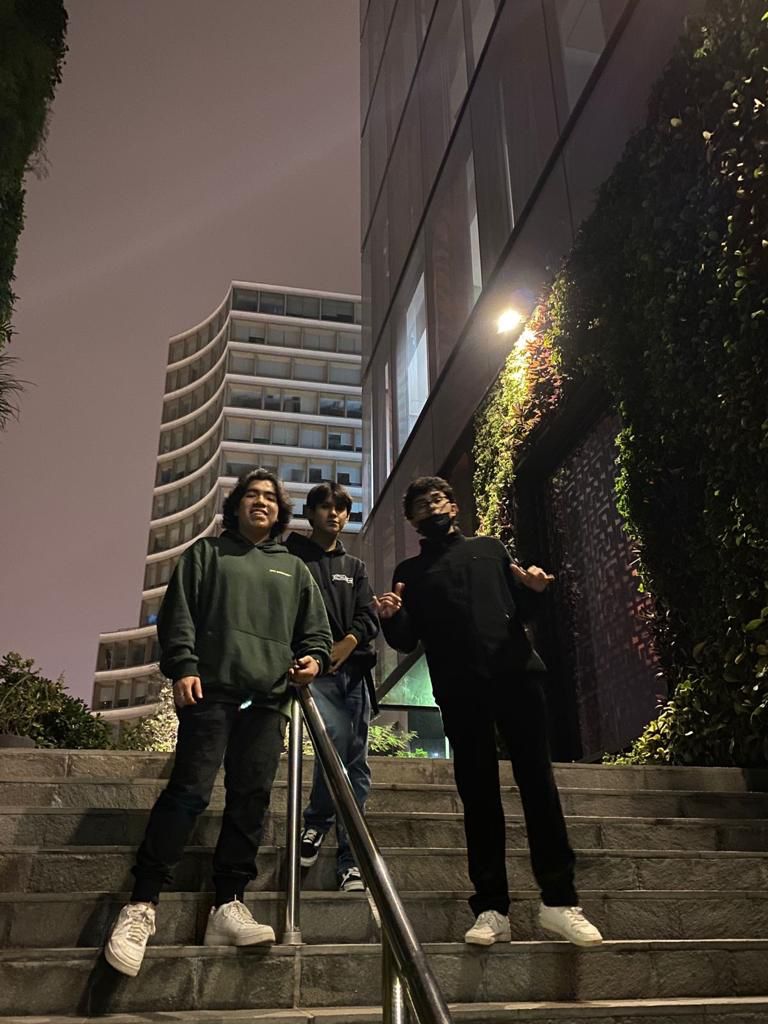
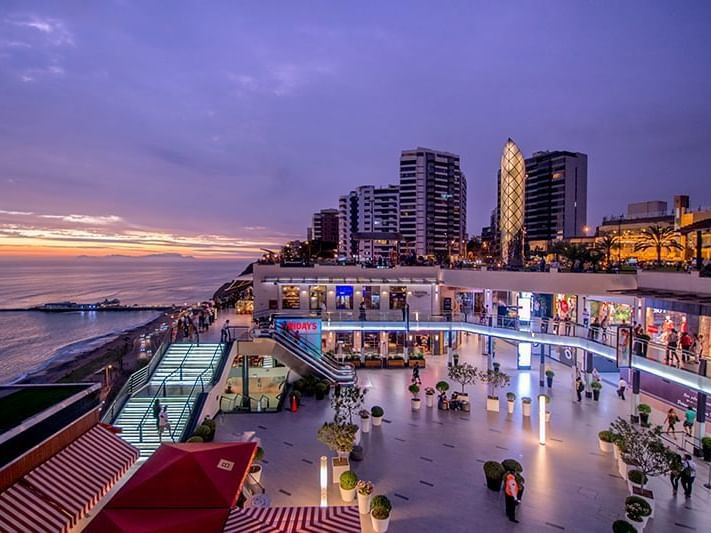
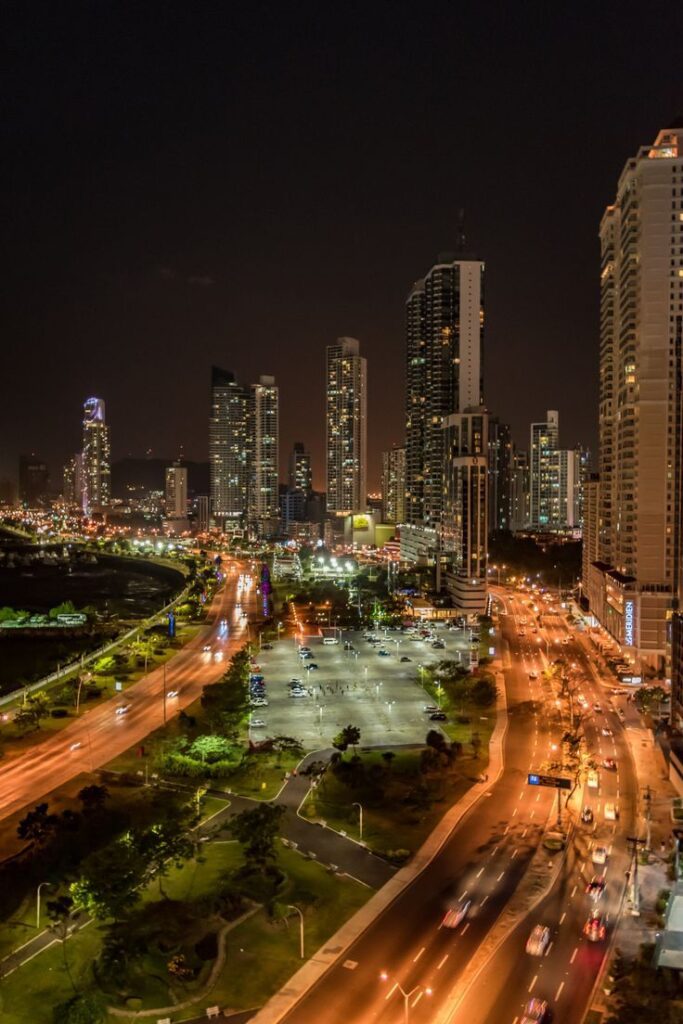


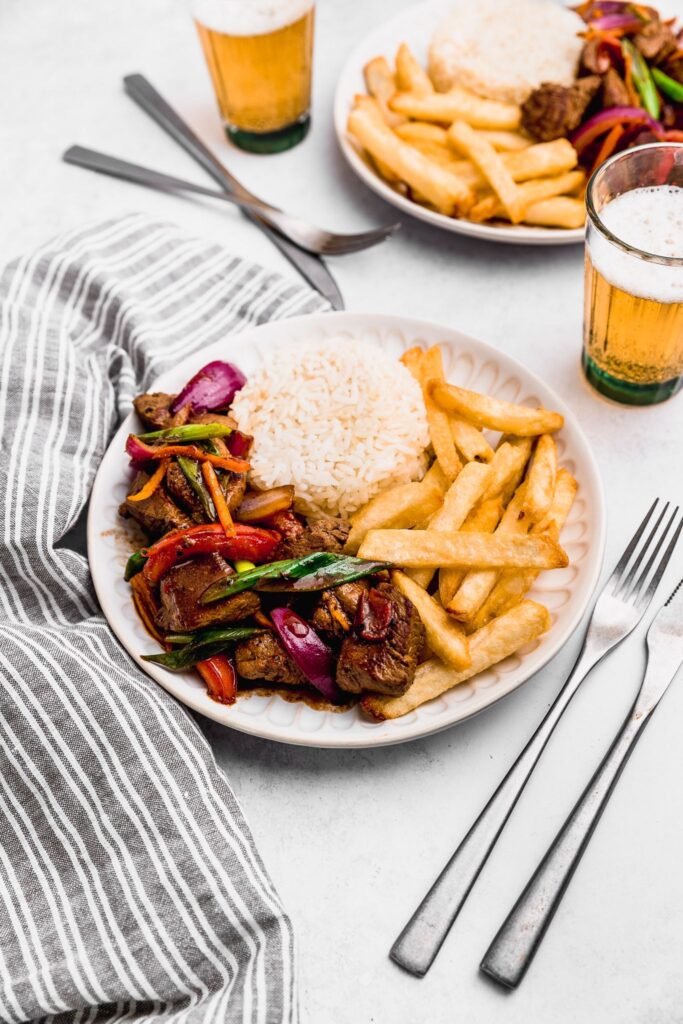
Where is Peru located?
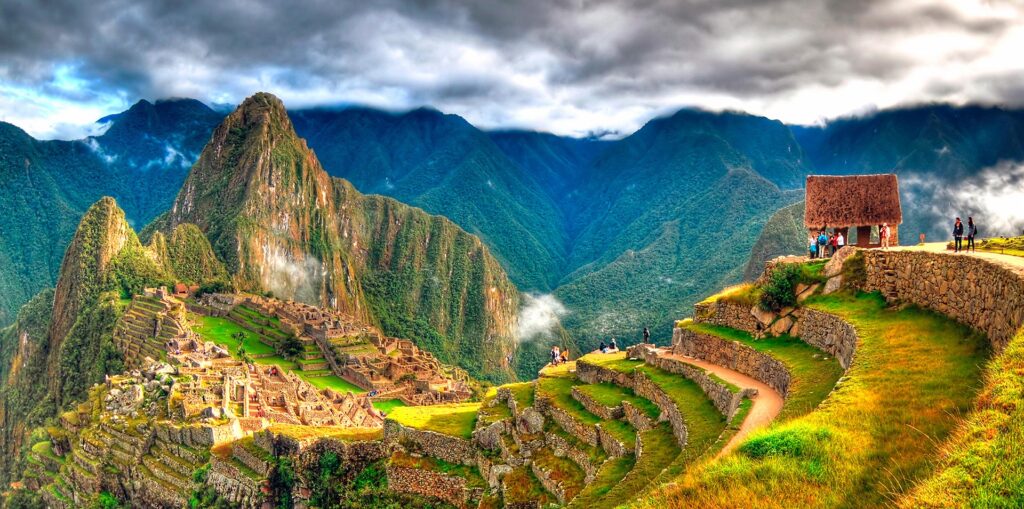
Peru is located in western South America. It is a country that shares borders with several countries, including Ecuador and Colombia to the north, Brazil to the east, Bolivia to the southeast, Chile to the south, and the Pacific Ocean to the west. The capital city of Peru is Lima, which is situated on the country’s western coast along the Pacific Ocean.
Places to visit in Peru
Machu Picchu
This ancient Inca citadel is one of the most iconic archaeological sites in the world. It’s located high in the Andes Mountains and offers breathtaking views. Visiting Machu Picchu is a must for anyone traveling to Peru.
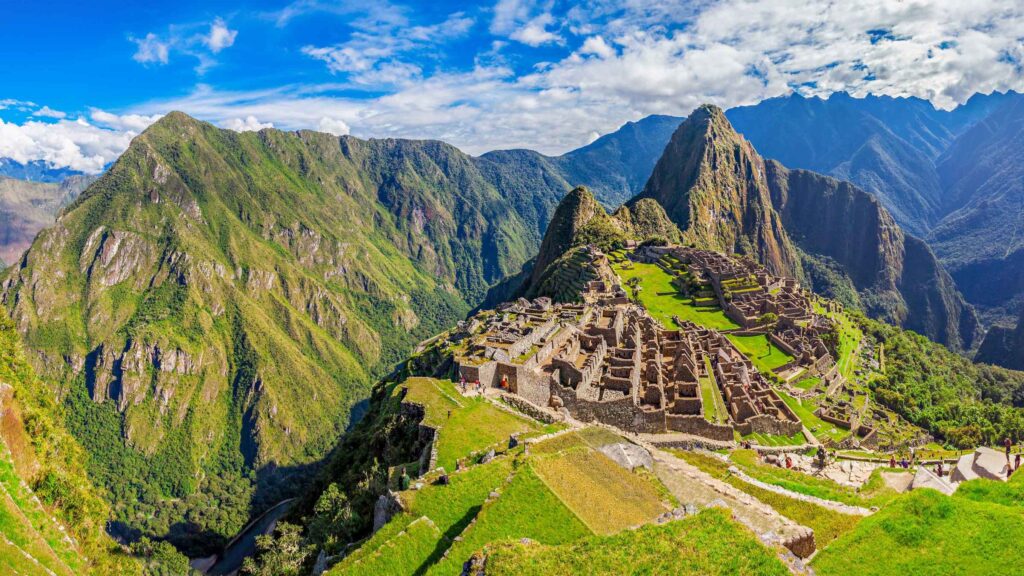
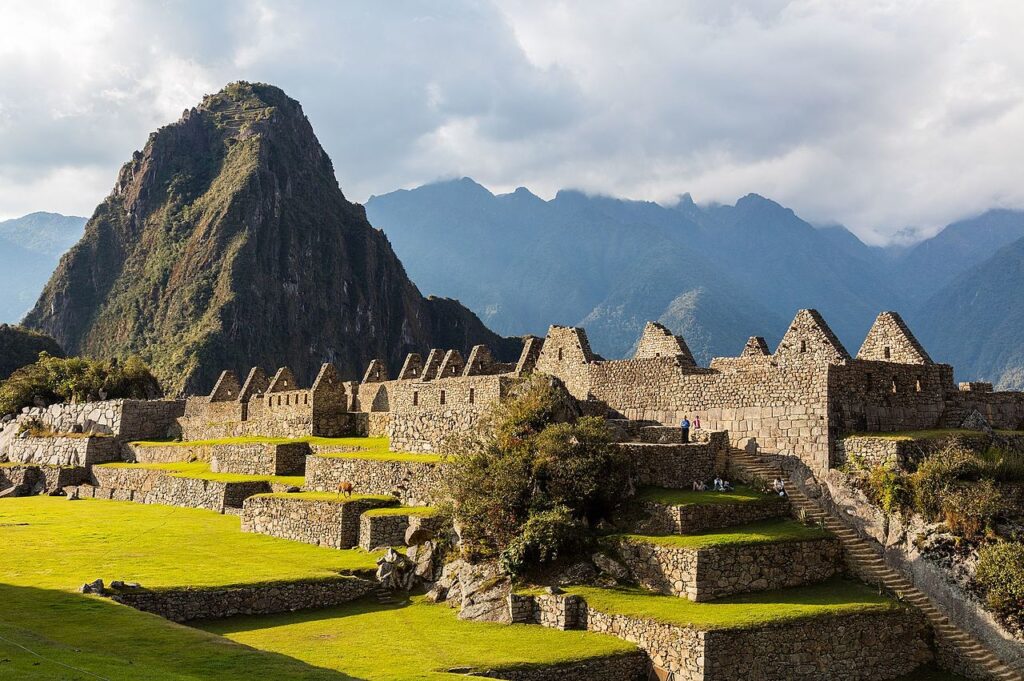

Cusco
Known as the historic capital of Peru, a city in southeastern Peru near the Urubamba Valley of the Andes mountain range. Cusco is a beautiful city with well-preserved Inca and colonial architecture. It’s also a great starting point for those planning to visit Machu Picchu.

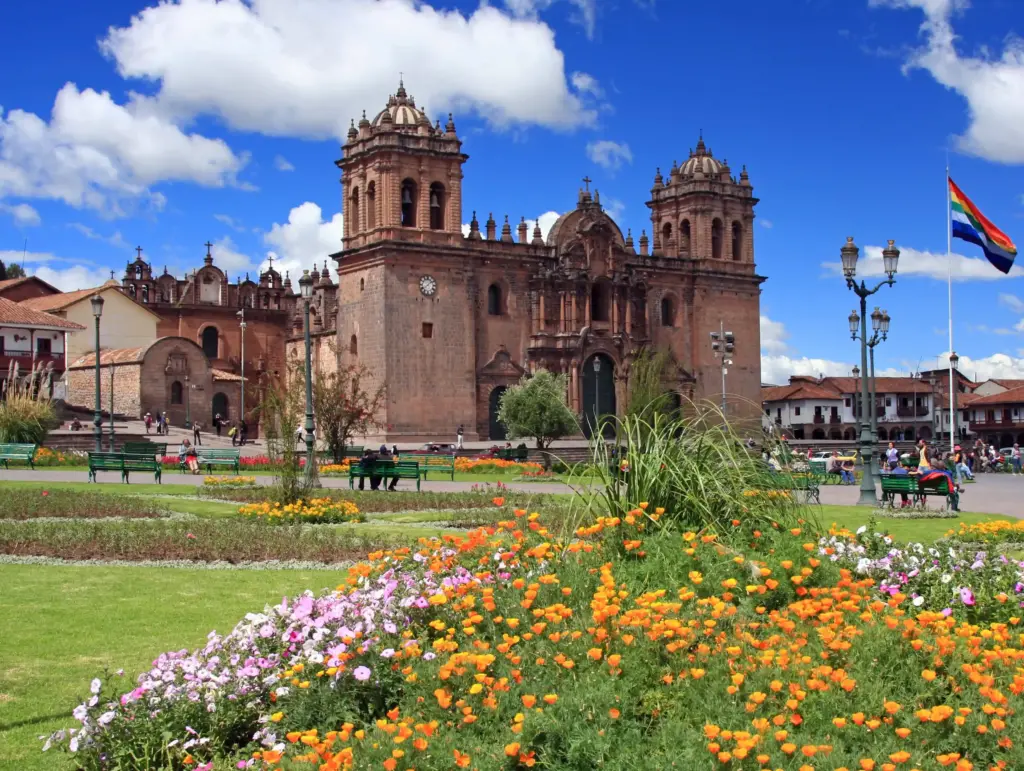
The Sacred Valley
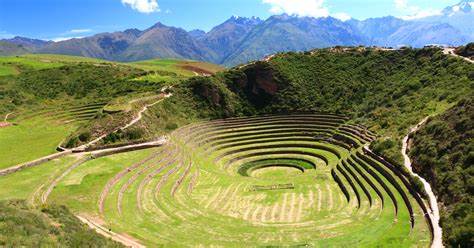
This region is located between Cusco and Machu Picchu and is famous for its stunning landscapes, Inca ruins, and indigenous markets. It’s a great place to explore the local culture and enjoy the scenic beauty.
Amazon Rainforest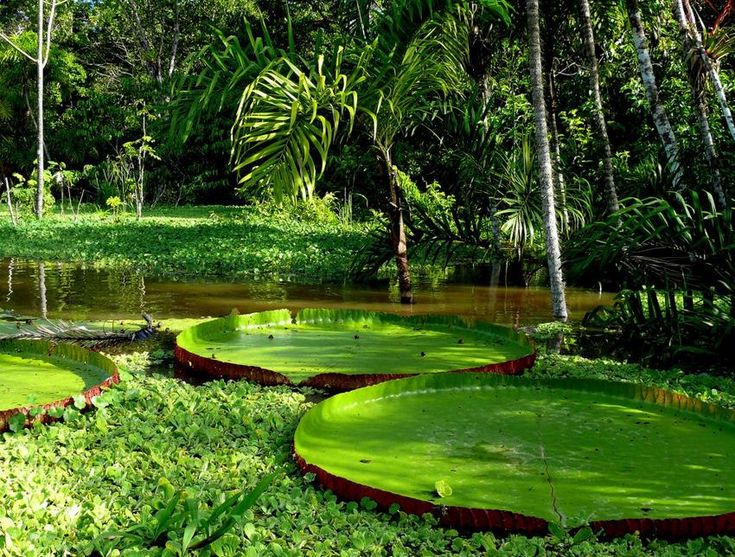
Explore the Amazon jungle by visiting the Peruvian Amazon, which is home to a vast array of biodiversity. You can take guided tours to experience the unique flora and fauna of this region.
Lima, Peru
Lima, the capital city of Peru, is a vibrant and culturally rich destination with a lot to offer to travelers. Here are some reasons why you should visit Lima and what to explore in the city:
- Historical and Colonial Sites: Lima’s historic center is a UNESCO World Heritage Site and is home to beautifully preserved colonial architecture. Don’t miss the Plaza de Armas, where you can see the Government Palace, the Cathedral of Lima, and the Archbishop’s Palace.
- Museums: Lima boasts numerous world-class museums. The Larco Museum is famous for its pre-Columbian art and artifacts. The National Museum of Archaeology, Anthropology, and History of Peru provides a deep insight into the country’s history.
- Culinary Capital: Lima is renowned for its culinary scene and is often considered the gastronomic capital of South America. You can try a wide range of Peruvian dishes, including ceviche, causa, and lomo saltado, in some of the finest restaurants in the city.
- Miraflores and Barranco: These districts in Lima offer a more modern and bohemian atmosphere. You can stroll along the Malecón in Miraflores, visit the Bridge of Sighs in Barranco, and enjoy the beautiful coastal views.
- Parque de la Reserva: This park is home to the Magic Water Circuit, a stunning display of water fountains that come to life with light and music in the evenings. It’s a great place for a family outing or a romantic evening.
- Vibrant Arts and Culture: Lima has a lively arts scene, with numerous theaters, galleries, and cultural centers. You can catch a play, visit art exhibitions, or enjoy live music performances throughout the city.
- Day Trips: From Lima, you can easily take day trips to nearby attractions. The ancient ruins of Pachacamac, the Palomino Islands for wildlife watching, and the pre-Inca city of Caral are all within reach.
- Festivals and Events: Lima hosts numerous festivals and events throughout the year, such as the Mistura Food Festival and the Virgen de la Candelaria procession, which showcase the country’s diverse culture.

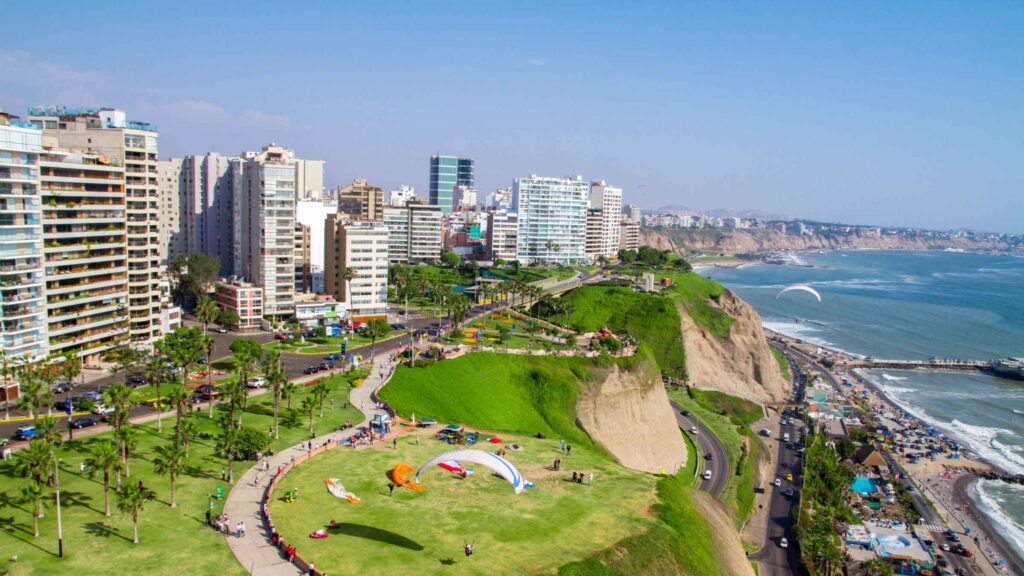
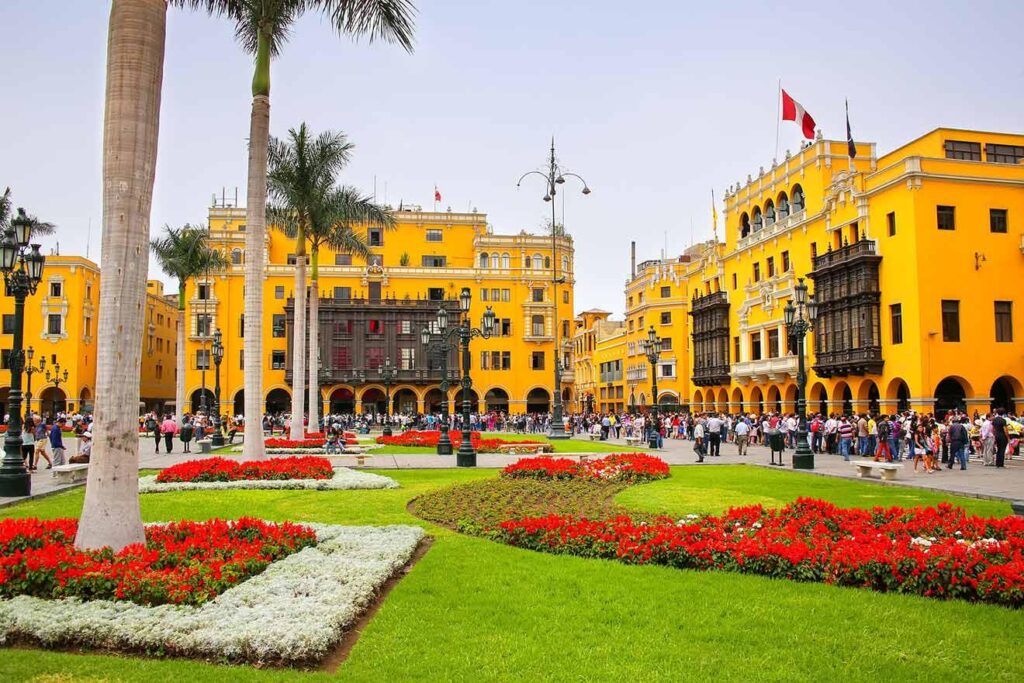
Some of Peru’s traditional food
Ceviche
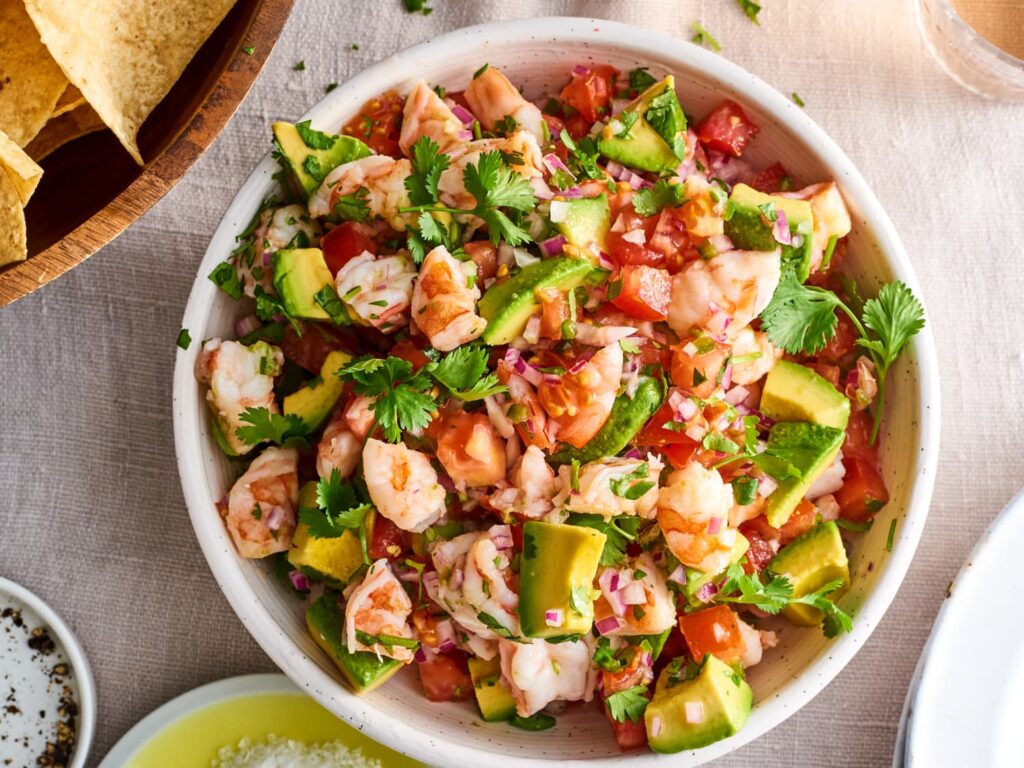
Ceviche is a popular Peruvian dish made from fresh raw fish or seafood that is “cooked” in citrus juices, typically with lime or lemon. It is usually seasoned with red onions, cilantro, and aji peppers, and served with sweet potato and corn.
Lomo Saltado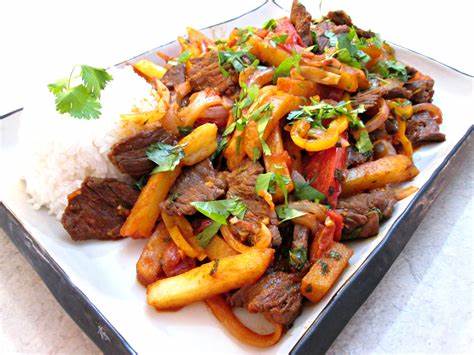
This is a flavorful stir-fry dish made with marinated strips of beef, onions, tomatoes, and peppers, typically served over French fries and rice. It’s a fusion of Peruvian and Chinese flavors.
Why Peruvian Cuisine Stands Out?
- Culinary Diversity: Peru’s cuisine is incredibly diverse, thanks to its geographical features, including coast, highlands, and rainforests. Each region has its own unique ingredients and culinary traditions, resulting in a wide range of flavors and dishes.
- Fusion of Cultures: Peru’s cuisine is a true fusion of cultures, blending indigenous ingredients and techniques with Spanish, African, and Asian influences. This cultural diversity has led to the creation of unique and flavorful dishes.
- Abundance of Ingredients: Peru is blessed with a wide variety of ingredients due to its diverse ecosystems. It offers a vast selection of fresh seafood, native potatoes, quinoa, aji peppers, tropical fruits, and a wide array of herbs and spices.
- Unique Ingredients: Peru is the birthplace of a number of ingredients that have become popular worldwide, including quinoa, amaranth, and purple corn. These ingredients are not only nutritious but also add distinct flavors and textures to Peruvian dishes.
- Traditional Cooking Techniques: Many Peruvian dishes are prepared using traditional cooking techniques that have been passed down through generations. These techniques often involve slow cooking, marinating, and grilling, resulting in rich and complex flavors.
Traditional Costumes in Peru

Chullo and Poncho
In the highlands of the Andes, you’ll often see people wearing chullos, which are knitted, ear-flap hats, and ponchos. These warm and colorful garments are essential for protection against the cold mountain climate.
Pollera and Montera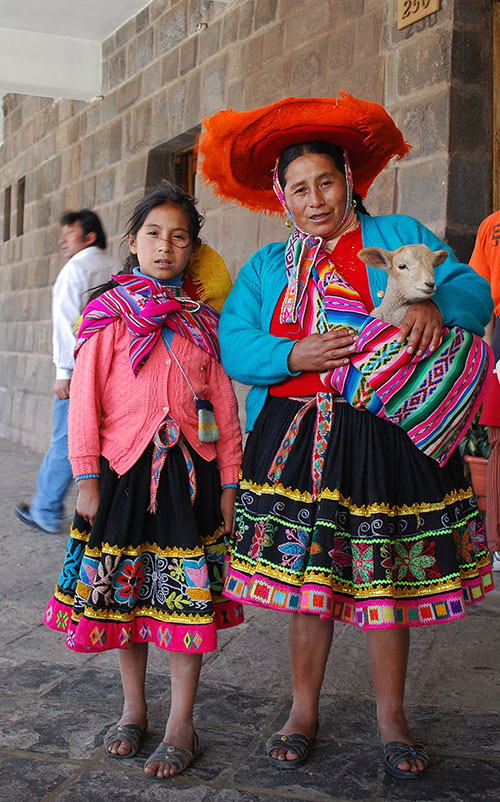
The women in the Andean region, particularly in Cusco, wear polleras, which are vibrant, multi-layered skirts, and monteras, which are decorative headpieces. These outfits are adorned with intricate patterns and embroidery, representing their indigenous heritage.
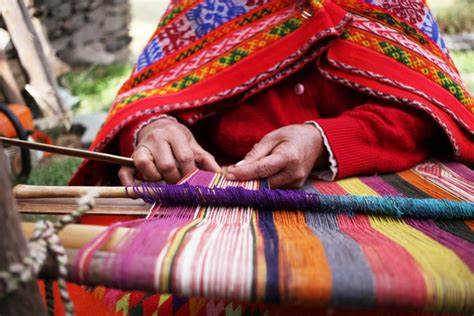
Vicuña and Alpaca Wool Garments
In the southern highlands of Peru, traditional clothing often incorporates garments made from the wool of vicuñas and alpacas. These animals provide high-quality and soft fibers that are used to make various clothing items, such as sweaters and shawls.
Festivals in Peru
Peru is a country with a rich cultural heritage, and it hosts a wide variety of traditional festivals throughout the year, celebrating indigenous traditions, historical events, and religious observances.
Here are some of the traditional festivals in Peru:
Inti Raymi
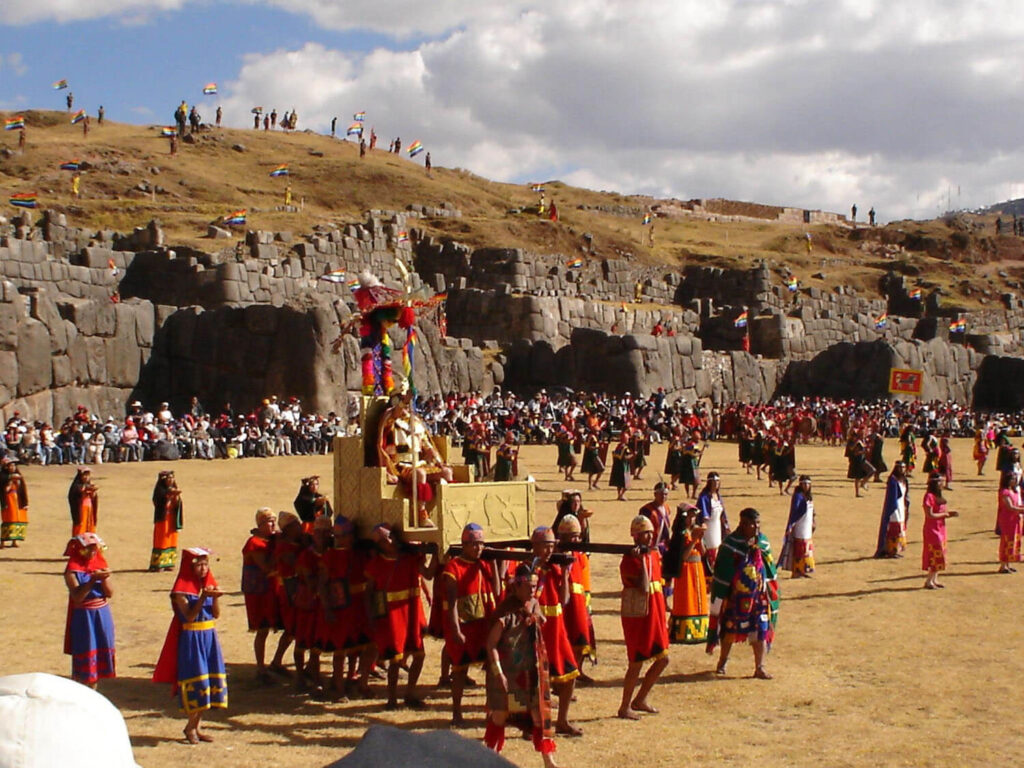

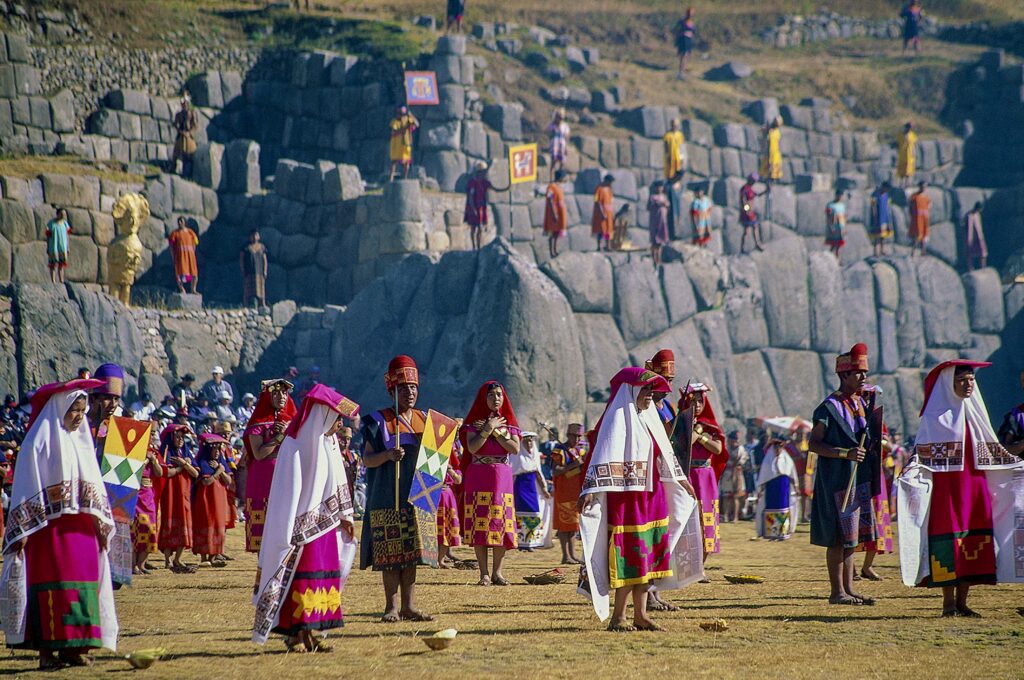
Held in Cusco on June 24th, Inti Raymi is the Inca Festival of the Sun. It is a grand celebration that reenacts ancient Inca rituals and ceremonies to honor the sun god, Inti. The main event takes place at the Sacsayhuaman archaeological site and features colorful processions and traditional attire.
Fiesta de la Cruz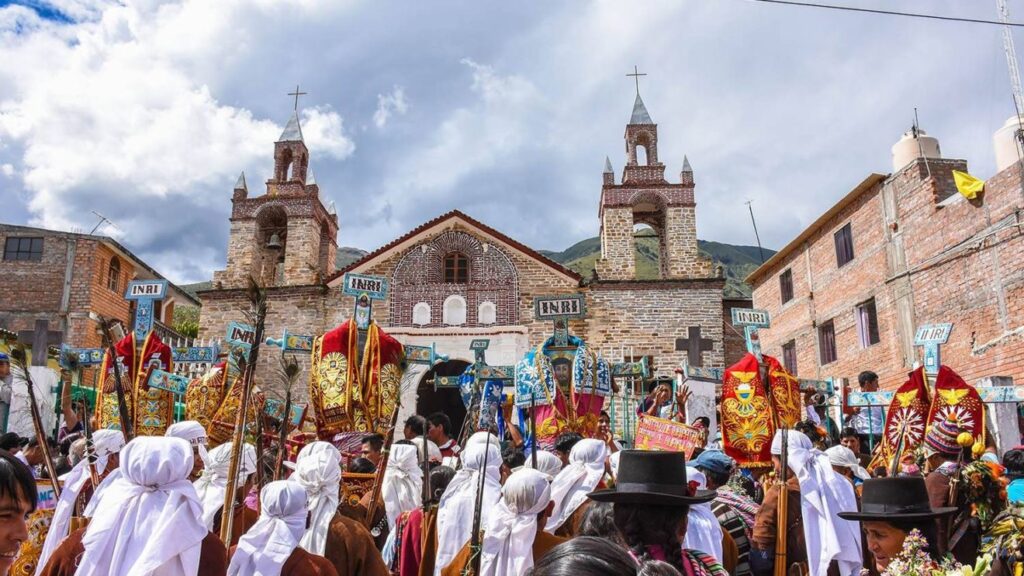
Observed in many parts of Peru, this festival takes place on May 3rd and combines indigenous Andean and Catholic traditions. It involves the decoration of crosses with flowers, colorful fabrics, and traditional dances.
Fiesta de la Marinera
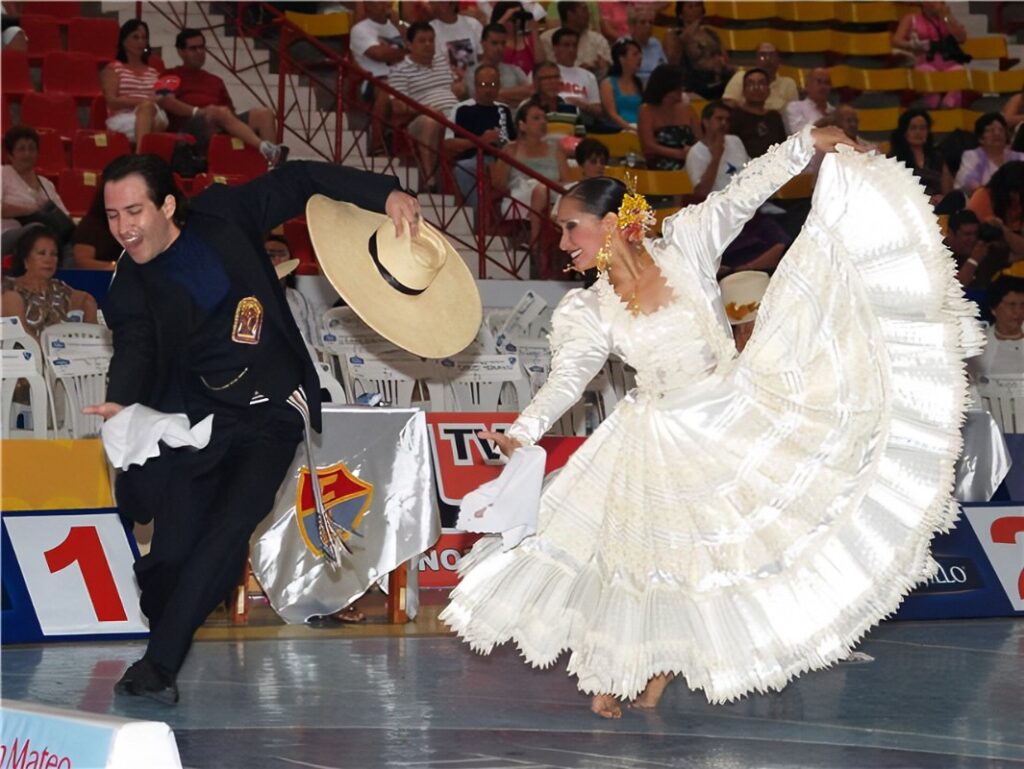
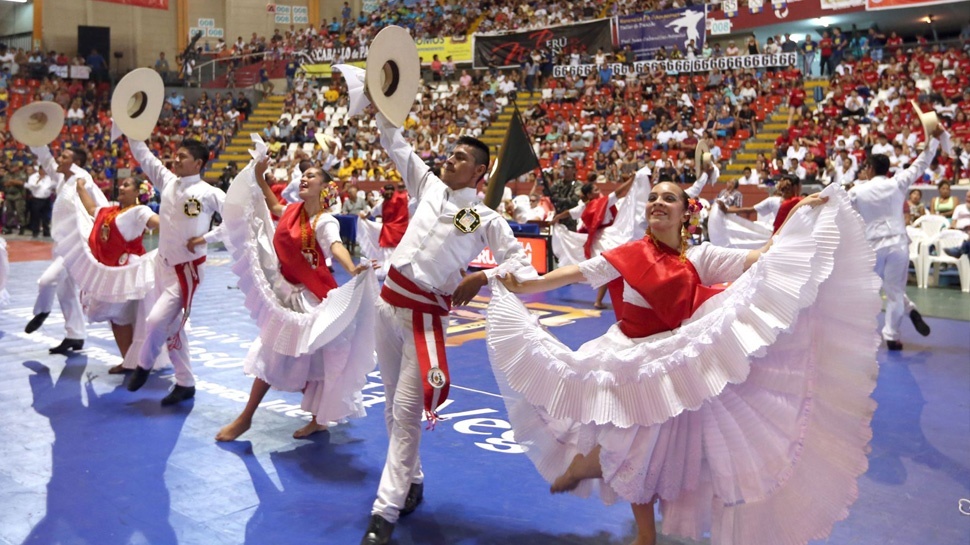
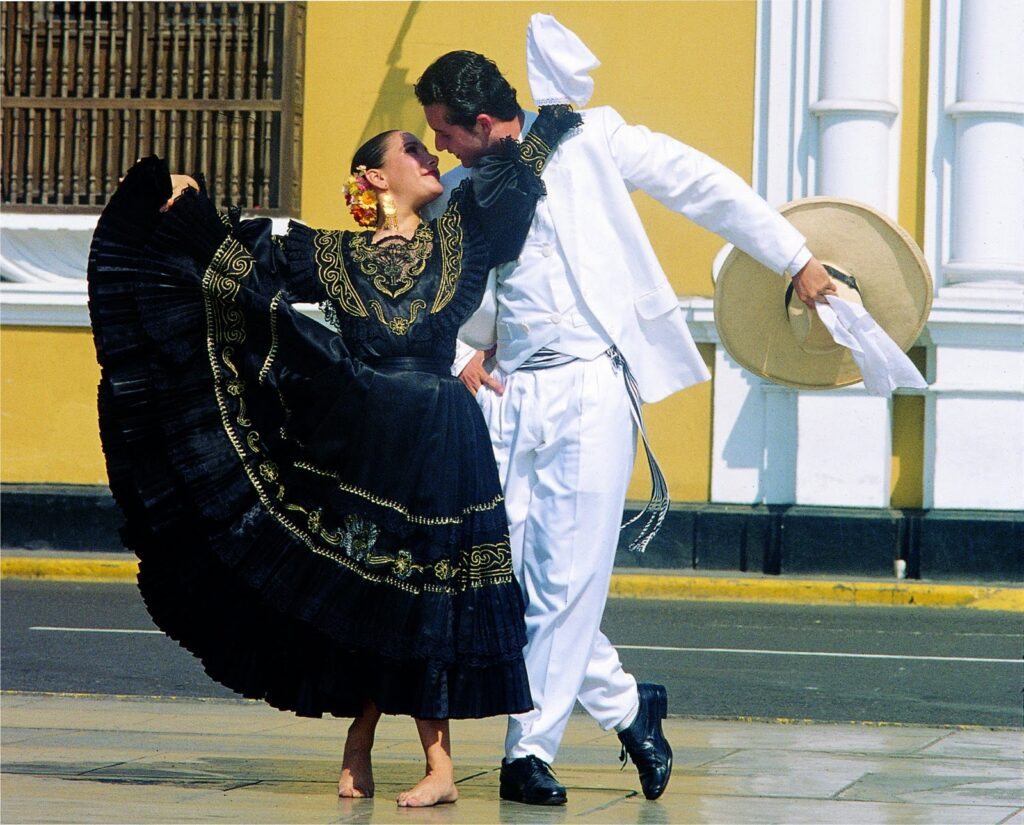
Held in Trujillo in January, this festival celebrates the Marinera, a traditional Peruvian dance. The event includes dance competitions, colorful costumes, and music.
Traditional arts and crafts
Peru has a rich tradition of art and craftsmanship that reflects its diverse cultural heritage, including influences from indigenous, Spanish, African, and Asian cultures.
Here are some traditional art and craft forms in Peru:
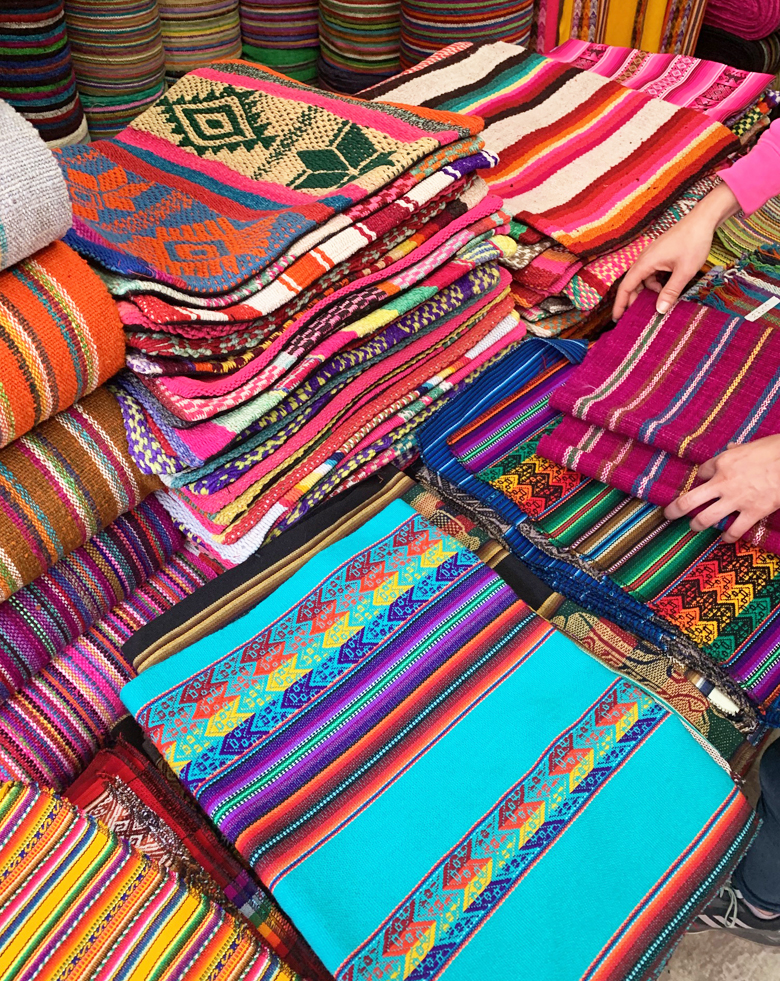
Textiles
Peruvian textiles are renowned for their intricate designs, vibrant colors, and high-quality materials. Indigenous communities, especially in the Andean region, produce a wide variety of textiles, including weavings, blankets, ponchos, and tapestries. Alpaca and vicuña wool are commonly used in the creation of these textiles.
Retablos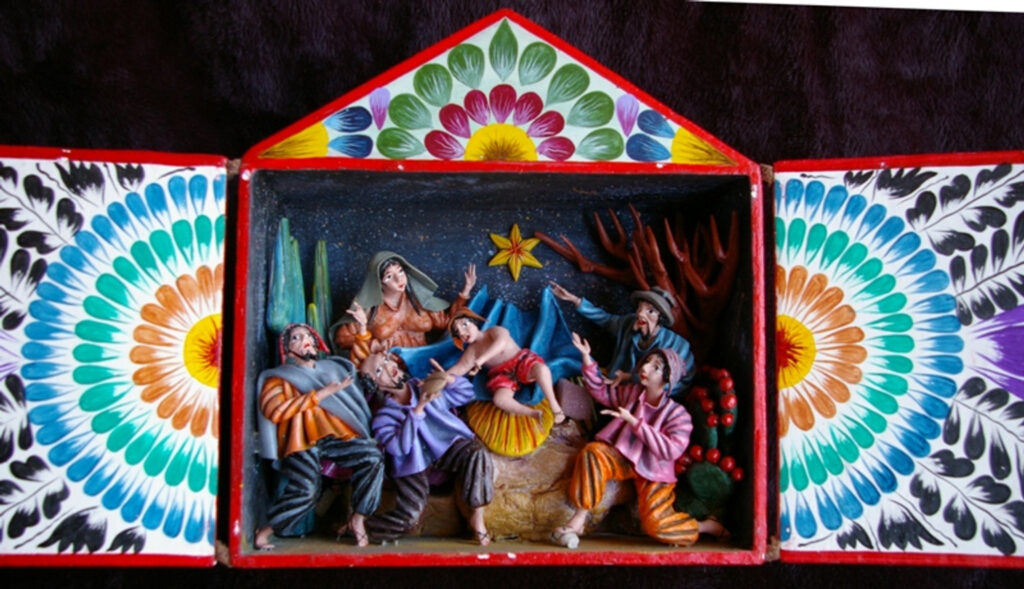
Retablos are three-dimensional, portable wooden shrines with carved and painted scenes depicting various aspects of Peruvian life and culture. The town of Ayacucho is well-known for its retablo craftsmanship.
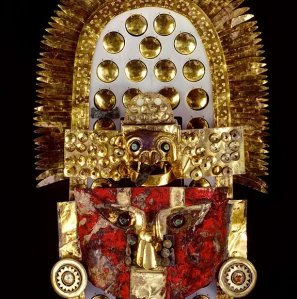
Gold and Metalwork
In northern Peru, you can find gold and metalwork, including filigree jewelry and ornate gold artifacts. The city of Trujillo, in particular, is known for its skilled metalworkers.
Fun Facts about Peru
- World Heritage Sites: Peru boasts numerous UNESCO World Heritage Sites, including Machu Picchu, the historic centers of Lima and Arequipa, and the Nasca Lines.
- Languages: In addition to Spanish, Peru recognizes Quechua and Aymara as official languages, reflecting the country’s indigenous heritage.
- Indigenous Cultures: Peru is home to over 50 distinct indigenous cultures, each with its own traditions, languages, and art forms.
- Pisco: Peru is famous for its grape brandy, Pisco, which is used to make the traditional cocktail known as the Pisco Sour.

Did you miss us? We certainly missed you, and we’re excited to be back with another captivating article about Peru. Join us as we embark on a journey with Nicolas, a true enthusiast of his homeland.
Meet Nicolas!

Hola, soy Nicolás y vengo de Perú. Soy estudiante de pregrado en UNI, con especialización en Administración y Dirección de Empresas. Me transferí a UNI como estudiante internacional desde Lima, Perú. En general, puedo decir que el proceso de transferencia a UNI fue relativamente sencillo, gracias a la ayuda del personal de UNI. Lo que más aprecio de UNI son las numerosas oportunidades para conectarme con diferentes eventos y personas. Algo que disfruté especialmente fue la semana de orientación, que nos permitió familiarizarnos con el campus. Hoy en día, participo activamente en muchos clubes y eventos organizados por UNI. La universidad me brinda numerosas oportunidades y me apoya de todas las maneras posibles.
Hello, I’m Nicolas, and I come from Peru. I’m an undergraduate student at UNI, majoring in Business Administration and Management. I transferred to UNI as an international student from Lima, Peru. Overall, I can say that the transfer process to UNI was relatively straightforward, thanks to the assistance of UNI staff. What I appreciate the most about UNI is the numerous opportunities to connect with various events and people. One thing I particularly enjoyed was the orientation week, which allowed us to become familiar with the campus. Nowadays, I actively participate in many clubs and events organized by UNI. The university provides me with numerous opportunities and supports me in every way possible.
Nicolas Huiman – Undergraduate Student
Before delving deeper into Peru…






Where is Peru located?

Peru is located in western South America. It is a country that shares borders with several countries, including Ecuador and Colombia to the north, Brazil to the east, Bolivia to the southeast, Chile to the south, and the Pacific Ocean to the west. The capital city of Peru is Lima, which is situated on the country’s western coast along the Pacific Ocean.
Places to visit in Peru
Machu Picchu
This ancient Inca citadel is one of the most iconic archaeological sites in the world. It’s located high in the Andes Mountains and offers breathtaking views. Visiting Machu Picchu is a must for anyone traveling to Peru.



Cusco
Known as the historic capital of Peru, a city in southeastern Peru near the Urubamba Valley of the Andes mountain range. Cusco is a beautiful city with well-preserved Inca and colonial architecture. It’s also a great starting point for those planning to visit Machu Picchu.


The Sacred Valley

This region is located between Cusco and Machu Picchu and is famous for its stunning landscapes, Inca ruins, and indigenous markets. It’s a great place to explore the local culture and enjoy the scenic beauty.
Amazon Rainforest
Explore the Amazon jungle by visiting the Peruvian Amazon, which is home to a vast array of biodiversity. You can take guided tours to experience the unique flora and fauna of this region.
Lima, Peru
Lima, the capital city of Peru, is a vibrant and culturally rich destination with a lot to offer to travelers. Here are some reasons why you should visit Lima and what to explore in the city:
- Historical and Colonial Sites: Lima’s historic center is a UNESCO World Heritage Site and is home to beautifully preserved colonial architecture. Don’t miss the Plaza de Armas, where you can see the Government Palace, the Cathedral of Lima, and the Archbishop’s Palace.
- Museums: Lima boasts numerous world-class museums. The Larco Museum is famous for its pre-Columbian art and artifacts. The National Museum of Archaeology, Anthropology, and History of Peru provides a deep insight into the country’s history.
- Culinary Capital: Lima is renowned for its culinary scene and is often considered the gastronomic capital of South America. You can try a wide range of Peruvian dishes, including ceviche, causa, and lomo saltado, in some of the finest restaurants in the city.
- Miraflores and Barranco: These districts in Lima offer a more modern and bohemian atmosphere. You can stroll along the Malecón in Miraflores, visit the Bridge of Sighs in Barranco, and enjoy the beautiful coastal views.
- Parque de la Reserva: This park is home to the Magic Water Circuit, a stunning display of water fountains that come to life with light and music in the evenings. It’s a great place for a family outing or a romantic evening.
- Vibrant Arts and Culture: Lima has a lively arts scene, with numerous theaters, galleries, and cultural centers. You can catch a play, visit art exhibitions, or enjoy live music performances throughout the city.
- Day Trips: From Lima, you can easily take day trips to nearby attractions. The ancient ruins of Pachacamac, the Palomino Islands for wildlife watching, and the pre-Inca city of Caral are all within reach.
- Festivals and Events: Lima hosts numerous festivals and events throughout the year, such as the Mistura Food Festival and the Virgen de la Candelaria procession, which showcase the country’s diverse culture.



Some of Peru’s traditional food
Ceviche

Ceviche is a popular Peruvian dish made from fresh raw fish or seafood that is “cooked” in citrus juices, typically with lime or lemon. It is usually seasoned with red onions, cilantro, and aji peppers, and served with sweet potato and corn.
Lomo Saltado
This is a flavorful stir-fry dish made with marinated strips of beef, onions, tomatoes, and peppers, typically served over French fries and rice. It’s a fusion of Peruvian and Chinese flavors.
Why Peruvian Cuisine Stands Out?
- Culinary Diversity: Peru’s cuisine is incredibly diverse, thanks to its geographical features, including coast, highlands, and rainforests. Each region has its own unique ingredients and culinary traditions, resulting in a wide range of flavors and dishes.
- Fusion of Cultures: Peru’s cuisine is a true fusion of cultures, blending indigenous ingredients and techniques with Spanish, African, and Asian influences. This cultural diversity has led to the creation of unique and flavorful dishes.
- Abundance of Ingredients: Peru is blessed with a wide variety of ingredients due to its diverse ecosystems. It offers a vast selection of fresh seafood, native potatoes, quinoa, aji peppers, tropical fruits, and a wide array of herbs and spices.
- Unique Ingredients: Peru is the birthplace of a number of ingredients that have become popular worldwide, including quinoa, amaranth, and purple corn. These ingredients are not only nutritious but also add distinct flavors and textures to Peruvian dishes.
- Traditional Cooking Techniques: Many Peruvian dishes are prepared using traditional cooking techniques that have been passed down through generations. These techniques often involve slow cooking, marinating, and grilling, resulting in rich and complex flavors.
Traditional Costumes in Peru

Chullo and Poncho
In the highlands of the Andes, you’ll often see people wearing chullos, which are knitted, ear-flap hats, and ponchos. These warm and colorful garments are essential for protection against the cold mountain climate.
Pollera and Montera
The women in the Andean region, particularly in Cusco, wear polleras, which are vibrant, multi-layered skirts, and monteras, which are decorative headpieces. These outfits are adorned with intricate patterns and embroidery, representing their indigenous heritage.

Vicuña and Alpaca Wool Garments
In the southern highlands of Peru, traditional clothing often incorporates garments made from the wool of vicuñas and alpacas. These animals provide high-quality and soft fibers that are used to make various clothing items, such as sweaters and shawls.
Festivals in Peru
Peru is a country with a rich cultural heritage, and it hosts a wide variety of traditional festivals throughout the year, celebrating indigenous traditions, historical events, and religious observances.
Here are some of the traditional festivals in Peru:
Inti Raymi



Held in Cusco on June 24th, Inti Raymi is the Inca Festival of the Sun. It is a grand celebration that reenacts ancient Inca rituals and ceremonies to honor the sun god, Inti. The main event takes place at the Sacsayhuaman archaeological site and features colorful processions and traditional attire.
Fiesta de la Cruz
Observed in many parts of Peru, this festival takes place on May 3rd and combines indigenous Andean and Catholic traditions. It involves the decoration of crosses with flowers, colorful fabrics, and traditional dances.
Fiesta de la Marinera



Held in Trujillo in January, this festival celebrates the Marinera, a traditional Peruvian dance. The event includes dance competitions, colorful costumes, and music.
Traditional arts and crafts
Peru has a rich tradition of art and craftsmanship that reflects its diverse cultural heritage, including influences from indigenous, Spanish, African, and Asian cultures.
Here are some traditional art and craft forms in Peru:

Textiles
Peruvian textiles are renowned for their intricate designs, vibrant colors, and high-quality materials. Indigenous communities, especially in the Andean region, produce a wide variety of textiles, including weavings, blankets, ponchos, and tapestries. Alpaca and vicuña wool are commonly used in the creation of these textiles.
Retablos
Retablos are three-dimensional, portable wooden shrines with carved and painted scenes depicting various aspects of Peruvian life and culture. The town of Ayacucho is well-known for its retablo craftsmanship.

Gold and Metalwork
In northern Peru, you can find gold and metalwork, including filigree jewelry and ornate gold artifacts. The city of Trujillo, in particular, is known for its skilled metalworkers.
Fun Facts about Peru
- World Heritage Sites: Peru boasts numerous UNESCO World Heritage Sites, including Machu Picchu, the historic centers of Lima and Arequipa, and the Nasca Lines.
- Languages: In addition to Spanish, Peru recognizes Quechua and Aymara as official languages, reflecting the country’s indigenous heritage.
- Indigenous Cultures: Peru is home to over 50 distinct indigenous cultures, each with its own traditions, languages, and art forms.
- Pisco: Peru is famous for its grape brandy, Pisco, which is used to make the traditional cocktail known as the Pisco Sour.

